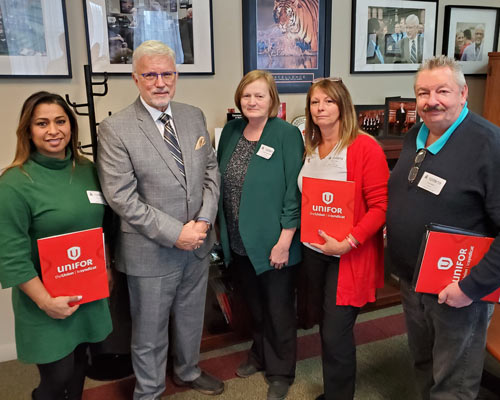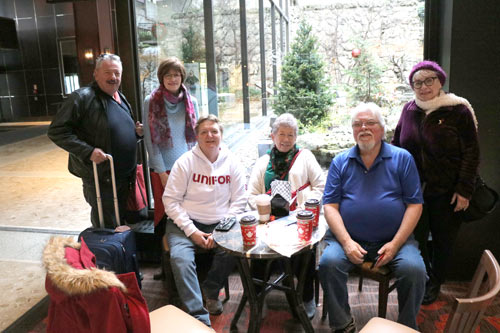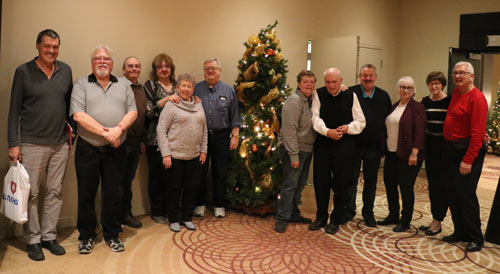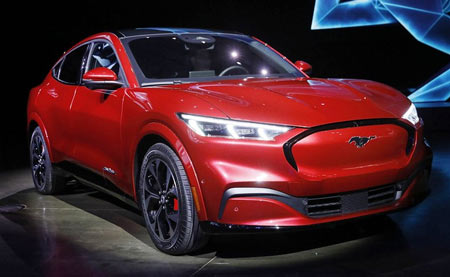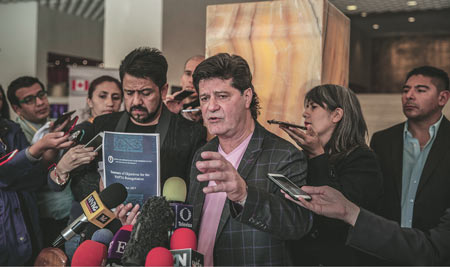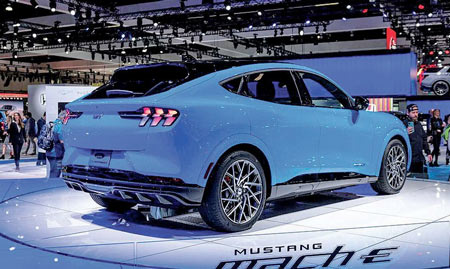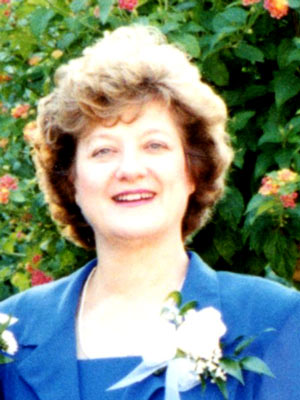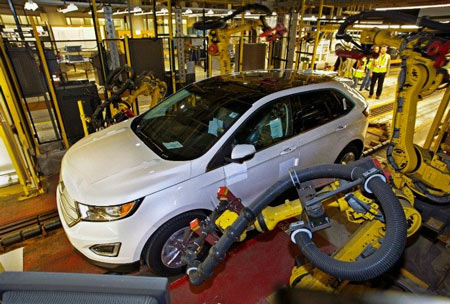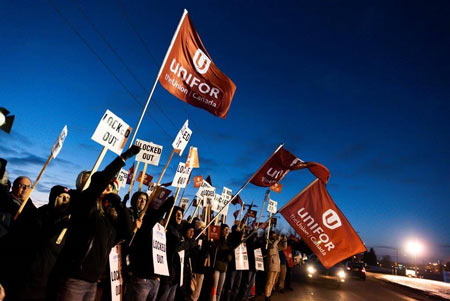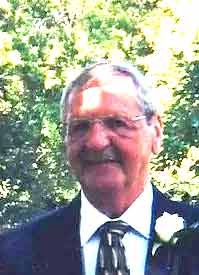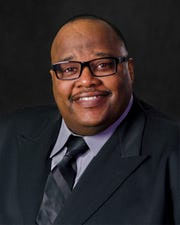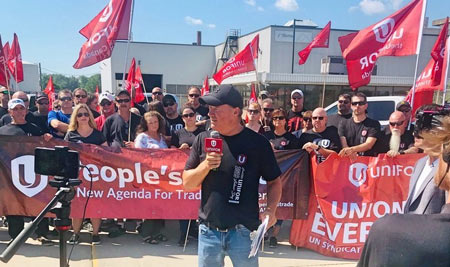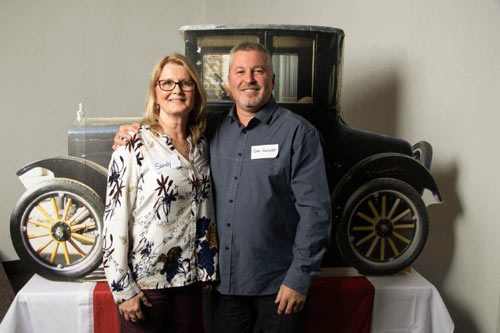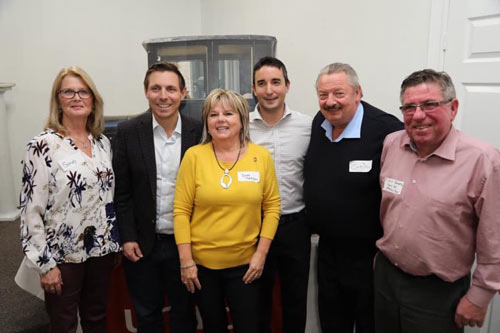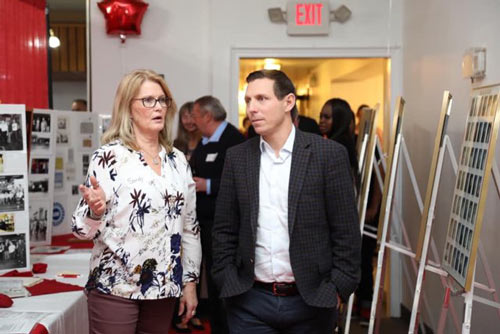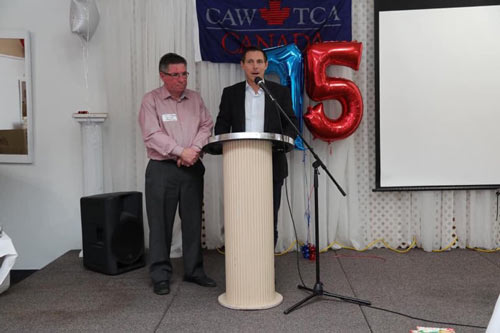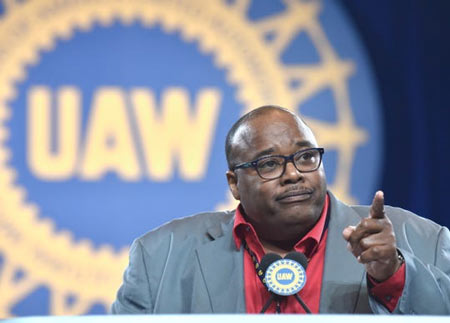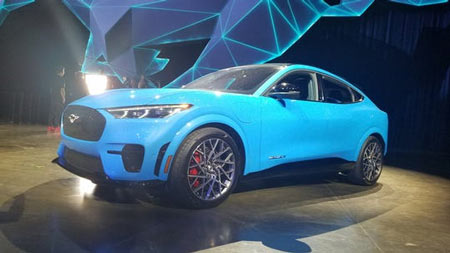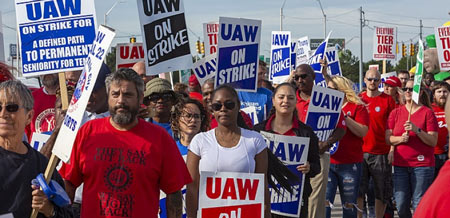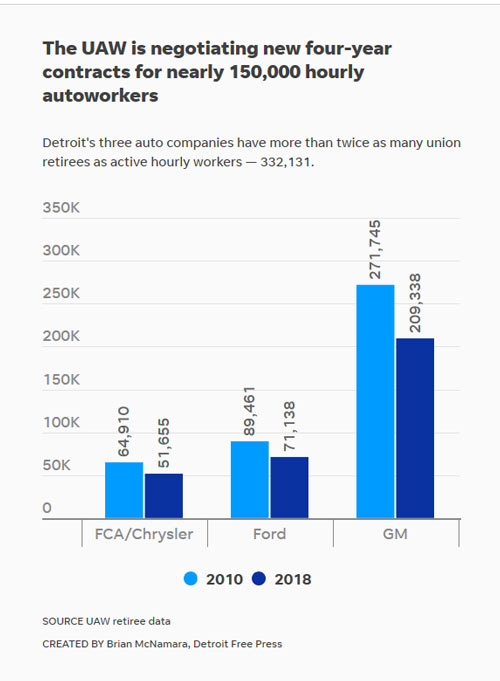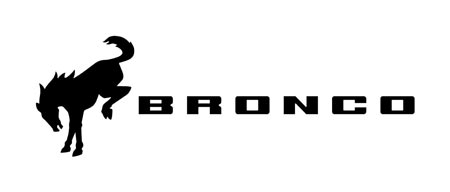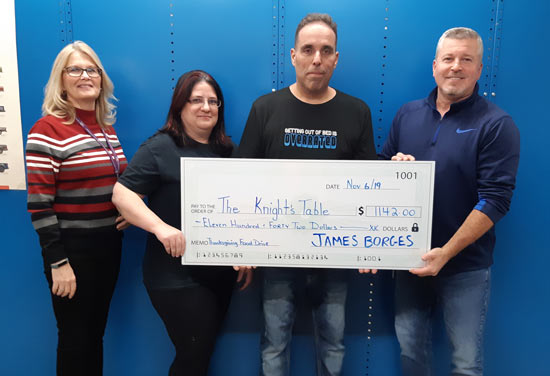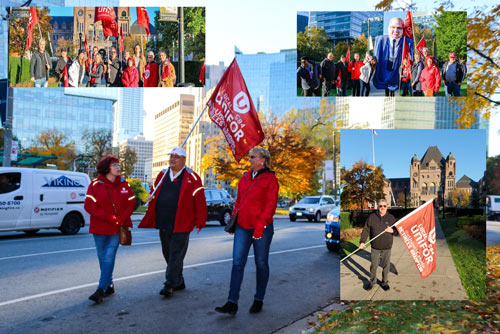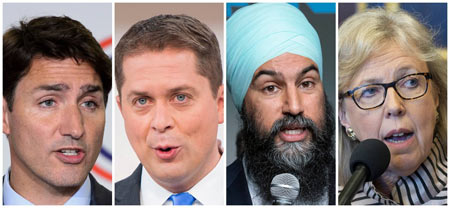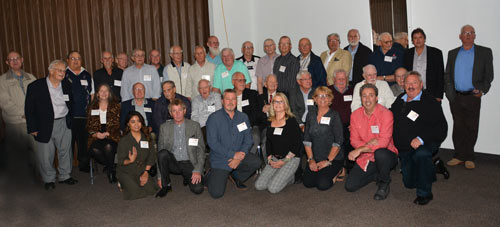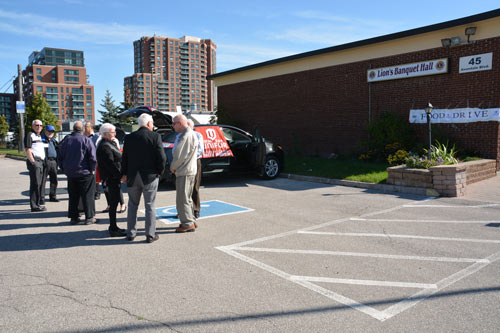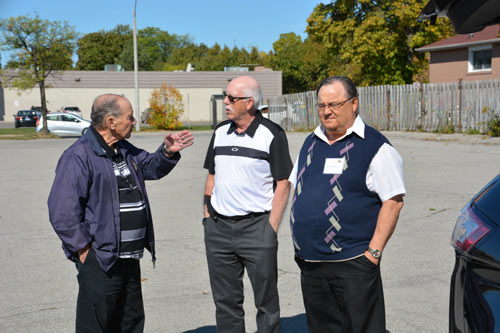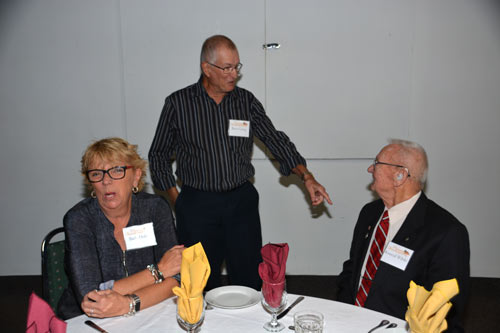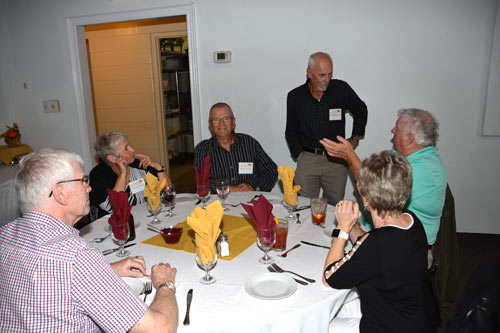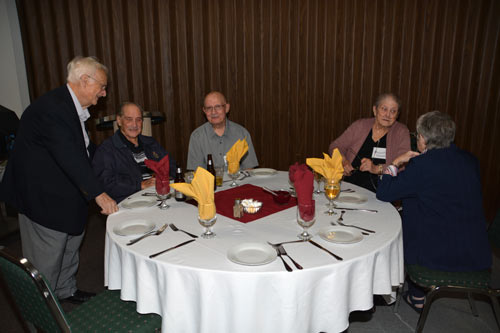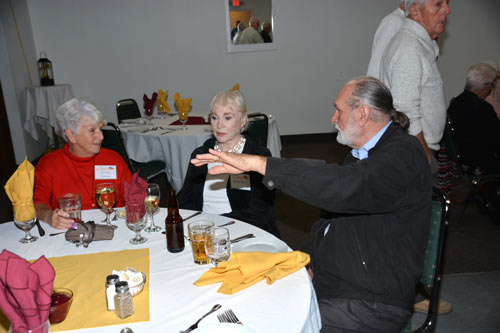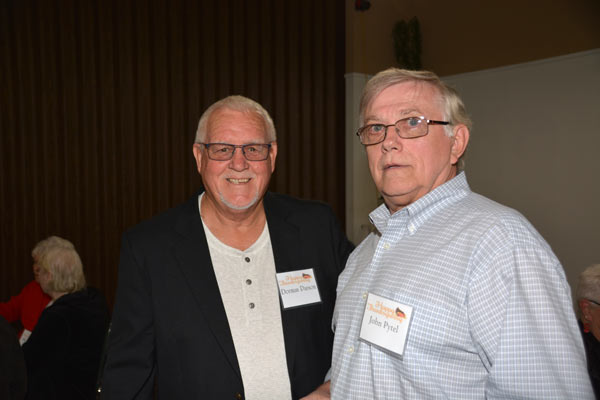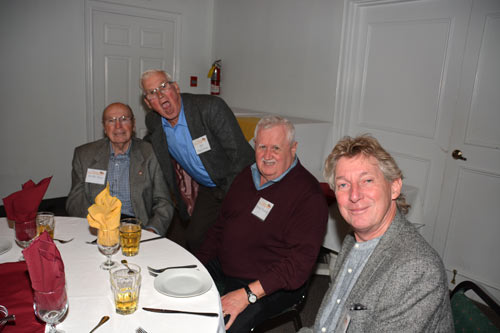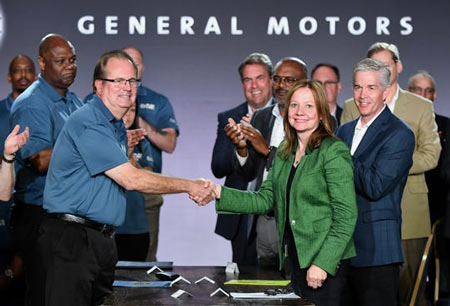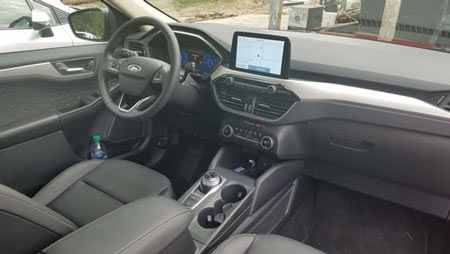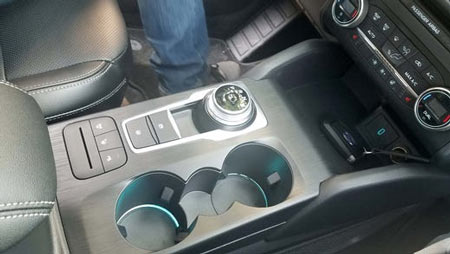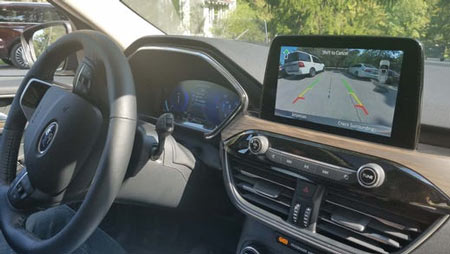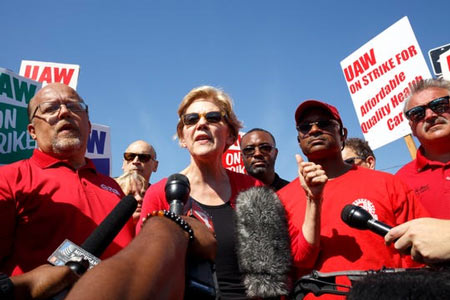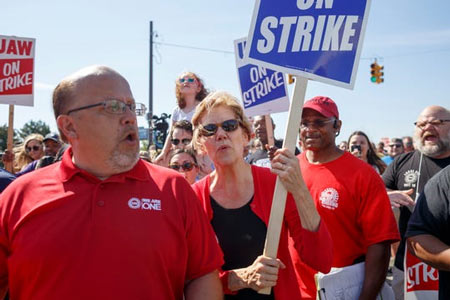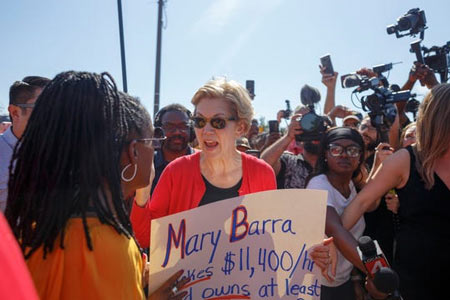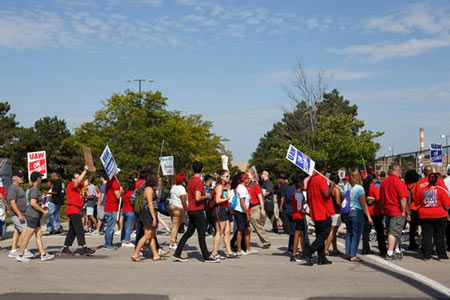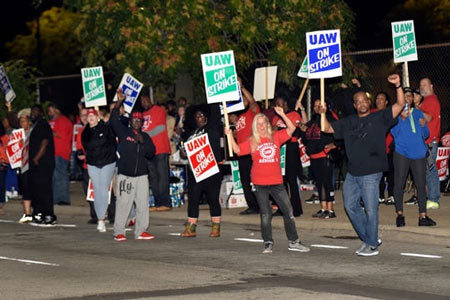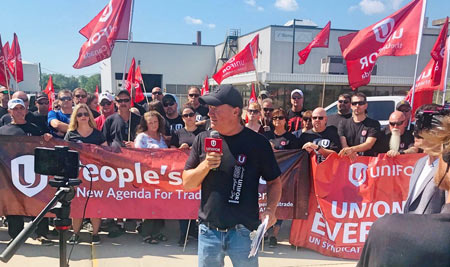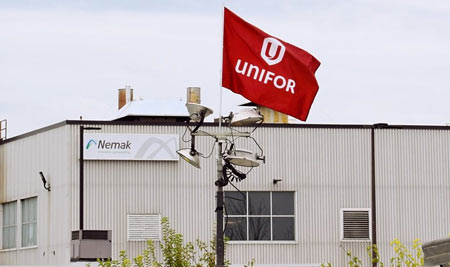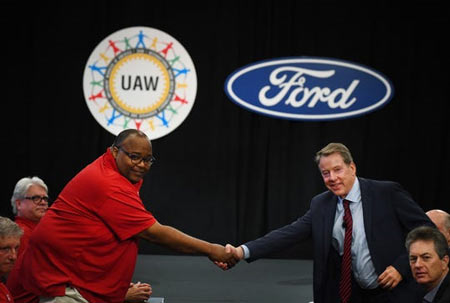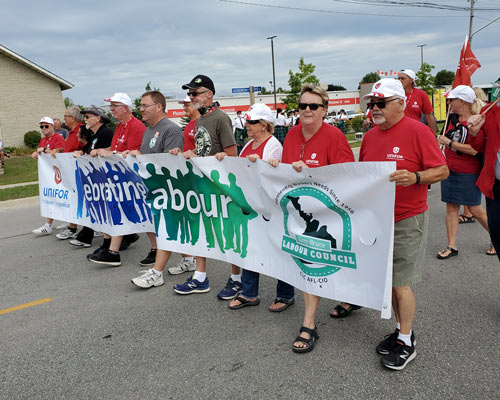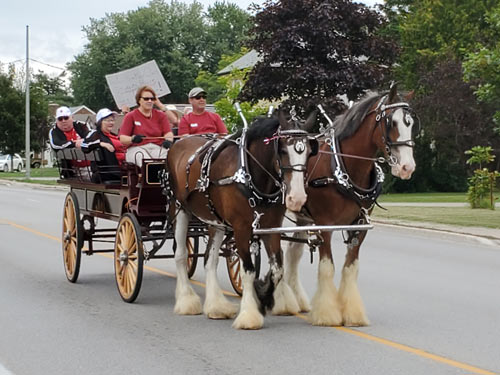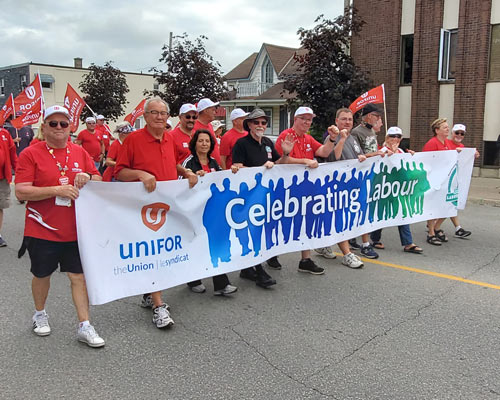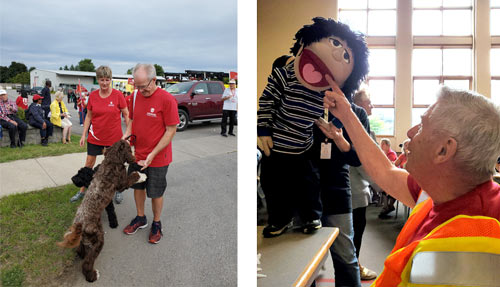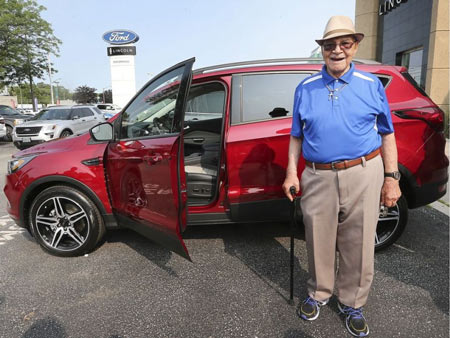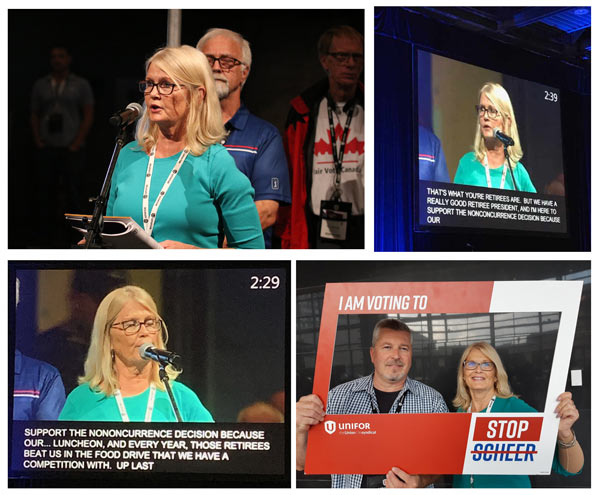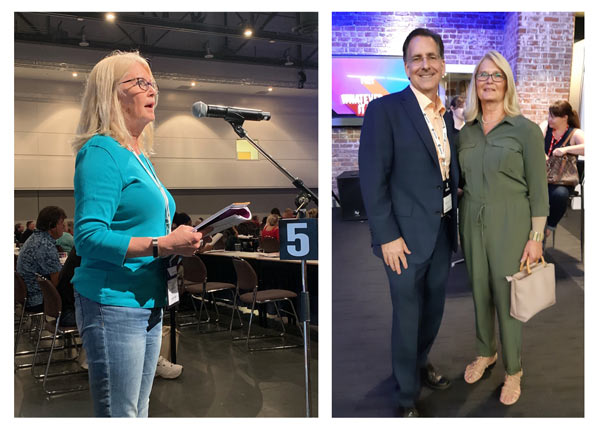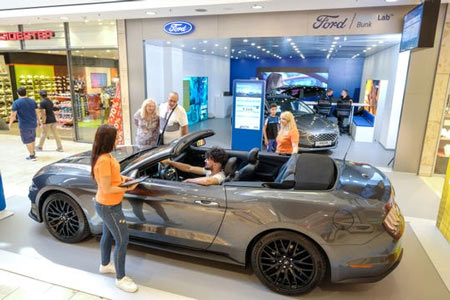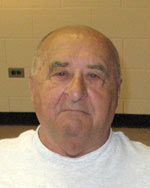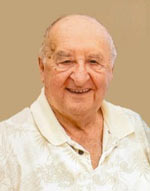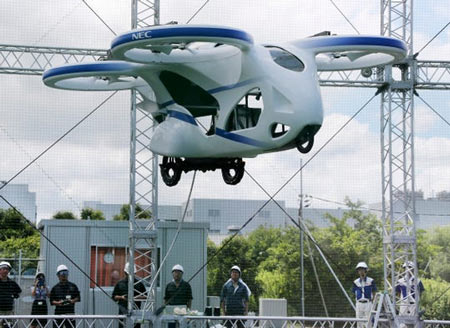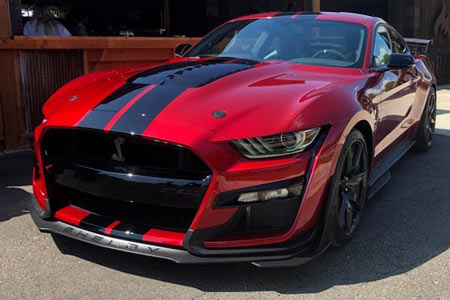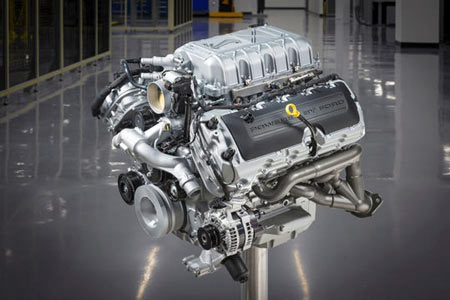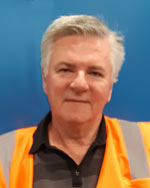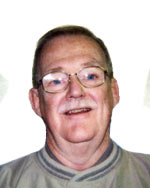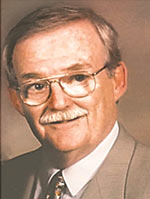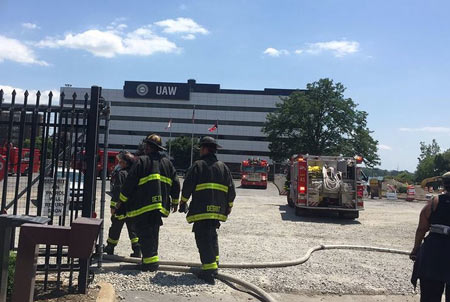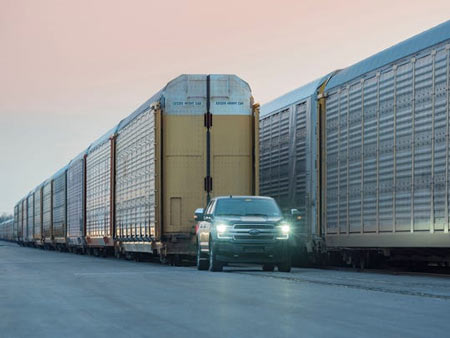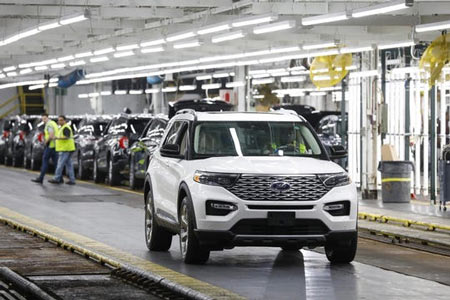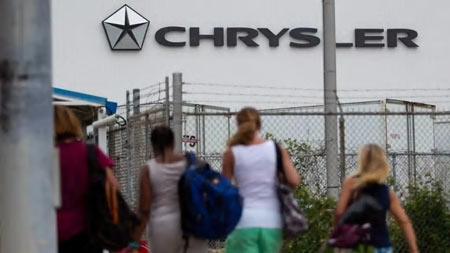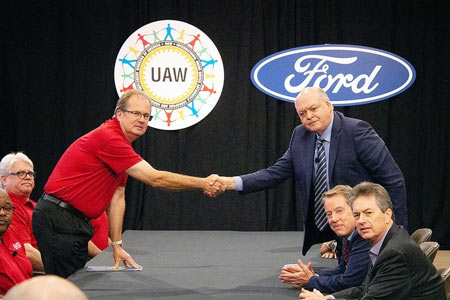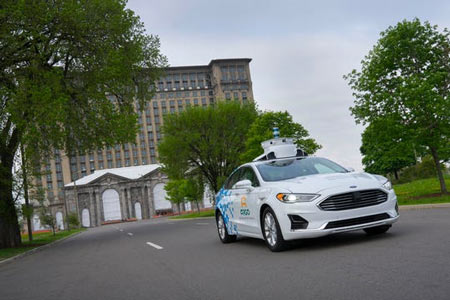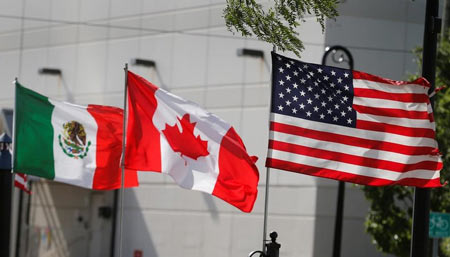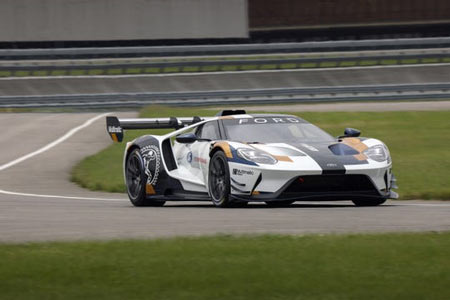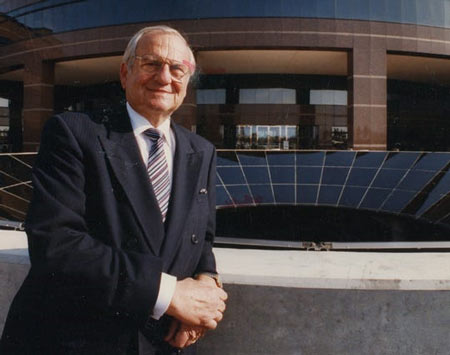
 |

July 1, 2019 to December 31, 2019
Unifor Queens Park
Paul Miller - NDP - Hamilton East
|
Ford says reservations full for
BEN KLAYMAN Ford Motor Co. said on Monday reservations were full for the high-end Mustang Mach-E First Edition electric crossover vehicle. The No. 2 U.S. automaker unveiled the electric Mustang on Nov. 17, and began taking reservations with a refundable deposit of $500. There will be four other versions of the Mach-E in addition to the First Edition. Ford did not provide details on how many reservations it took for the First Edition, which will be priced at about $60,000, but has said global production in the first 12 months for all versions of the Mach-E is limited to 50,000 vehicles. The Mach-E has become a high-profile test for a restructuring at Ford that has been marred by profit warnings, costly quality problems and the troubled launch this year of another important vehicle, the Ford Explorer utility vehicle. The Mach-E was unveiled in Los Angeles in November. It will be built in Mexico, the first of more than a dozen all-electric vehicles Ford plans to launch by 2022 with an investment of $11.5 billion. The Mach-E's design was inspired by the classic 1960s Mustang sports car and is meant to challenge electric carmaker Tesla Inc. More than 80 percent of U.S. customers are reserving Mach-E with an extended range battery, while about 55 percent opted for an all-wheel drive, Ford said in a statement released Monday. More than 25 percent of the reservations are from California, with nearly 30 percent of U.S. customers choosing Mach-E GT, the company said. |
Driven by greed: Alliance of FCA, By Daniel Howes and Dennis Williams requested the meeting with General Motors Co. CEO Mary Barra because the United Auto Workers president wanted to deliver a message: He would support a merger of GM with Fiat Chrysler Automobiles NV. All GM needed to do in the spring of 2015 was agree to the blockbuster combination to realize ambitions FCA’s then-CEO, Sergio Marchionne, openly touted, even if a prospective deal imperiled plants, products and thousands of union jobs Williams was obliged to protect. The union leader's position defied projections of job losses, reinforcing rank-and-file suspicions their leadership had grown too close to management — and too willing to plunder union resources for their own benefit. "The UAW's done its own research, and we think it's more favorable than you guys do," Williams told GM's leaders of Marchionne's latest proposal, according to two sources familiar with details of the meeting. "I think it's worthy of some study." The suggestion essentially culminated Marchionne’s evolving strategy to gain control of old Chrysler assets from bankruptcy and to buy union support for his vision to create a global American auto colossus the Italian-born executive would control. Marchionne dismissed skeptics, instead insisting such a tie-up would not result in the plant closings and rank-and-file job losses GM said it would after its own board-level study of a potential combination. In his second-floor president’s office adorned with football helmets and portraits of Mahatma Gandhi and Martin Luther King Jr., Williams parroted Marchionne's rationale to Barra, President Dan Ammann and CFO Chuck Stevens, according to a civil racketeering lawsuit GM filed against FCA in November. For at least the fourth time in three years, GM said no deal. The $85 billion government bailout that 10 years ago rescued GM, delivered Chrysler Group to Marchionne's Fiat SpA for no cash down and gave the United Auto Workers large stakes in both automakers also fueled a decade-long corruption conspiracy that has tarnished FCA's revival, undermined the UAW's credibility and exposed the labor union to federal takeover. Thousands of pages of federal court records, dozens of interviews with auto industry figures, lawyers and federal officials, as well as on-the-ground reporting in three states, help define the origins of the country’s largest union corruption scandal in 40 years and highlight the multimillion-dollar cost of a scheme hatched in the auto industry’s darkest hour. "This is an ugly story," said Erik Gordon, a professor at the University of Michigan's Ross School of Business. "Pots of money from the government can be irresistible to people. It suggests that there is a culture of corruption and sort of a cozy collusion between the company and union brass" — a culture that an automaker could exploit. Frank Hammer, 76, of Detroit is a retired UAW international representative and self-described dissident. He traces the roots of corruption to the “extremely hazardous cultural change” that happened after the union and the automakers began jointly operated programs and opened training centers in the 1980s, a move he saw as a threat to the union. Fiat Chrysler executives, armed with $12.5 billion in taxpayer funds, started funneling bribes and illegal payments to UAW officials within days of the automaker emerging from bankruptcy in June 2009, The Detroit News has learned, partially squandering a second chance financed by American taxpayers. Prosecutors allege the money was part of a broad attempt by Fiat Chrysler executives to secure labor concessions from the UAW by keeping labor leaders “fat, dumb and happy.” The government’s four-year investigation has revealed how labor leaders misused the bailout’s historic second chance by embezzling money from worker paychecks, shaking down union contractors and scheming with auto executives. The conspiracy stretched from the California desert and a union town on the banks of the Missouri River to the woods of Northern Michigan and the Jersey Shore. "When the UAW goes on strike and the workers are making — I think it was $275 per week ... And what does the leadership get? Bottles of booze worth $1,300. Lavish steak dinners," U.S. Attorney Matthew Schneider, the Justice Department's top prosecutor in Detroit, told The News. In all, UAW officials and auto executives are accused of misappropriating nearly $34 million since the bailout 10 years ago, according to an analysis by The News. That money includes embezzled member dues and funds siphoned from facilities that train roughly 150,000 of the union's nearly 400,000 members. The timing of illegal payments within days of attaining control of Chrysler signals the importance Marchionne appeared to place on buying influence within the UAW, one of the nation's largest and most powerful labor unions. When the remnants of Chrysler emerged from bankruptcy, its UAW retiree health care trust owned a majority stake in the Auburn Hills automaker, and a close relationship with the union could buttress Marchionne's hope of one day acquiring GM, sources familiar with the investigation said. So far, 13 people tied to the UAW and Fiat Chrysler have been charged in federal court, and prosecutors have implicated at least seven others in the conspiracy. Those include Williams, the union's president emeritus, and recently resigned President Gary Jones, who is accused of stealing as much as $700,000 from workers and trying to cover up crimes. William's attorneys did not respond to requests for comment, and Jones' attorney declined comment. Before the UAW scandal erupted two years ago, public officials in Metro Detroit went to prison for receiving bribes that amounted to as little as a used purple Lexus and $10,025 worth of hair plugs. The auto industry corruption crackdown, centered in America's Motor City, is establishing new benchmarks. Union leaders and auto executives have been accused of receiving an average of $422,000 in illegal benefits — twice as much as regional politicians and municipal employees convicted in the last decade. "I do think it’s based on greed," Schneider said. "The instant that you decide to put your interests ahead of somebody else’s and serve your greedy or selfish interests, that’s it." The corruption spanned at least four generations of UAW leaders, a mix of presidents, vice presidents and the union’s junior varsity. According to the government, there was a band of thieves at the UAW’s Solidarity House headquarters along the Detroit River, swindlers in regional offices in the heartland and shakedown artists on the East Coast. UAW Vice President Joe Ashton headed an Atlantic City crew that strong-armed union contractors into paying kickbacks. The embezzlement squad in St. Louis was led by the late Region 5 Director Jim Wells, a hot-headed gambler who, until now, has not been publicly linked to the scandal, according to sources familiar with the investigation. Colleagues describe Wells as a Svengali who taught subordinates how to skim member dues, including one bespectacled accountant named Gary Jones who last year took control of the UAW while continuing to skim money, according to prosecutors. The crews committed crimes on their own and as a team, creating a national network of corruption connected most directly by three letters: UAW. Every December, the crews united in Palm Springs, where member dues and Fiat Chrysler cash financed a more than $1 million spending spree. Labor leaders spent freely on poolside villas, five-figure filet dinners and vodka poured from crystal skulls. From 2014-15, UAW bosses spent member dues on 107 rounds of golf at the nation’s premier courses. With union money, they bought new golf clothes, rainbow-colored golf balls made in South Korea and golf equipment, including a $1,955 set of Titleist golf clubs. UAW officials were in Palm Springs for a five-day conference but rented the home for President Dennis Williams for 105 days, prosecutors said. Federal agents seized a matching set of clubs from the suburban Detroit garage of Jones, right next to where they seized more than $32,000 in cash during an August raid. The raid, as well as allegations Jones embezzled member dues, elevated the four-year investigation from a focus on comparatively minor labor law crimes to what legal experts describe as outright thievery. The pots of money prosecutors say were tapped by UAW officials are dwindling as the investigation approaches its fifth year. GM and the UAW have agreed to shutter a training center financed with money that ended up in labor leaders’ pockets, and bargainers for FCA and Ford Motor Co. are dissolving their joint centers; union officials have mothballed nonprofit charities since investigators started questioning whether the UAW leaders personally benefited from donations; and federal agents are questioning whether union bosses drained accounts that were established to buy flowers for auto worker funerals. The corruption scandal has proven costly for the UAW. Eight people linked to the union have been convicted so far. The UAW lost its seat on the GM board last year, a seat awarded during the Detroit automaker’s bankruptcy that was occupied by a retired vice president later accused of demanding $550,000 in bribes and kickbacks from a union contractor. A sitting UAW president implicated in the scandal resigned as the union initiated steps to remove him, and his predecessor has been implicated, too. The scandal also has tarnished the UAW’s historic reputation as a clean union, a legacy of its longest-serving president, Walter Reuther. The UAW lost 35,000 members last year, and the ongoing investigation is expected to all but doom the union’s ability to lure new members in southern plants owned by foreign automakers. And the four-year corruption investigation has exposed FCA to civil racketeering charges by crosstown rival GM, a target of Marchionne's quest to consolidate the two automakers into a global powerhouse Marchionne planned to lead. GM alleges the FCA CEO, who died two summers ago, masterminded a scheme to buy UAW influence to raise costs on GM, weaken it and engineer a merger. In response, FCA pointed to a previous statement labeling GM's lawsuit a "meritless attempt to divert attention from that company’s own challenges." The Italian-American automaker said it "will deal with this extraordinary attempt at distraction through the appropriate channels and will stay focused on continuing to deliver record results." The allegations against the UAW and ongoing investigation also have heightened the possibility federal prosecutors will file civil racketeering charges against the union. The move could result in the federal government taking control of one of the nation’s largest and most powerful unions, instituting broad reforms and removing current leaders. "Fat, dumb and happy" was in full flower by spring 2017. That's when an interior decorator dropped off a basket of white birch sticks at a cabin in northern Michigan. UAW President Dennis Williams redecorated this cabin while awaiting completion of a larger retirement home the union was building for him nearby at the UAW Black Lake Conference Center in Onaway. The lakefront, wood-paneled cabin was being renovated by Williams, then UAW president, as part of a $10 million upgrade to the union’s Black Lake Conference Center, a 1,000-acre retreat near Cheboygan. The project was bankrolled after the first hike in membership dues in almost 50 years. The increased dues, one answer to the union's worsening financial predicament, helped to replenish a depleted UAW strike fund. Besides paying for wages and medical and prescription drug benefits for striking workers, the $750 million fund also finances operations for the conference center dating back to the Reuther era. Flush with cash for the renovations, Williams outfitted the cabin with a humidor and wine cooler, according to a source. He also commissioned a larger retirement home for himself on an adjacent property that would soon draw the interest of FBI agents. And it eventually would be built with nonunion labor. But first, Williams needed a few final decorations. He arranged for an interior decorator to bring baubles and decorative pieces, including the basket of white birch sticks that carried a $150 price tag. The expense struck UAW officials familiar with the cabin project as frivolous because a few feet from the cabin's front door stood a forest of white birches, their branches free for the taking. Such spending ran counter to the mandate Williams inherited from his election in June 2014: repair the UAW's finances and boost membership. That included raising member dues 25%, even as corruption fueled by those same dollars flourished. By spring 2017, life within the upper echelon of the UAW was far removed from the Great Recession that threatened the union's existence and the U.S. auto industry just eight years earlier. UAW membership was up more than 21%, automakers were booking fat profits and more membership dues were flowing into UAW coffers. Williams cut costs and increased revenue. But the way he did it would soon draw attention from a team of federal agents from the FBI, Internal Revenue Service and Labor Department. They were told by a top aide to Williams that he had saved the union money by offloading travel and entertainment expenses to Fiat Chrysler, the No. 3 Detroit automaker run by his old friend, Marchionne. Fiat Chrysler executives poured more than $100 million into the Detroit joint-training center it operated with senior officers from the UAW, according to court records and tax filings. Fiat Chrysler Vice President Alphons Iacobelli — a Harvard-trained executive with exotic hobbies that included collecting solid-gold fountain pens and Italian-made, cherry red roadsters — handed those labor leaders credit cards paid for by the automaker and encouraged them to swipe liberally. "If you see something you want," Iacobelli told UAW officer Nancy Adams Johnson in July 2014, according to federal court records that recount the conversation, "feel free to buy it." How it started Iacobelli was the automaker's top labor negotiator when what's now called Fiat Chrysler exited Chapter 11 bankruptcy in June 2009 with $12.5 billion in federal aid and a new leader, Marchionne. That's when Iacobelli, his company's point man with the UAW, admitted to opening the financial spigot. Starting that month, authorities say, Iacobelli and Fiat Chrysler made more than $9 million in illegal payments over eight years to the UAW to cover salaries and benefits of union officials assigned to the training center. Some of those officials worked at the center, but for a large number of UAW officials these were no-show jobs, prosecutors said in a sentencing memo. Iacobelli and Fiat Chrysler viewed the payments as "a political gift" to the UAW. "It was merely a corrupt mechanism whereby FCA money could be used by the UAW to keep the UAW’s costs down," Assistant U.S. Attorney David Gardey said in court filings. The payments violated a federal law — the Taft-Hartley Act of 1947 — barring company officials from giving money or things of value to labor leaders. The UAW also collected a 7% fee in addition to the $9 million paid for the no-show jobs, according to prosecutors. Starting in June 2009, that fee pumped an additional $2.9 million into the UAW's bank account, ostensibly to cover administrative costs. "FCA viewed the 7 (percent fee) as simply another cost of doing business with the UAW in terms of keeping labor peace," Gardey said. On Sept. 29, three months after Fiat Chrysler left bankruptcy court, Iacobelli met with the automaker's financial analyst, Jerome Durden. At the time, Durden controlled the books of the UAW-Chrysler training center and was a close friend of UAW Vice President General Holiefield, the burly labor leader assigned to the union's Fiat Chrysler department. Jerome Durden, 61, of Rochester stood mute in federal court on charges of conspiracy to defraud the U.S., which carries up to five years in prison and/or a $250,000 fine. During the meeting, Iacobelli talked about restarting an internal Fiat Chrysler plan to funnel money to "high value/high leverage programs," according to a Durden email summarizing the meeting. The email referenced one such program: the nonprofit "Leave the Light On Foundation," a charity for poor children headed by Holiefield. Durden served as the charity's treasurer. "The overall tone of the meeting," Durden wrote in the emails, "was a desire to deliver some good news to the UAW for a change." The meeting transformed the foundation from a purported charity into a Trojan horse used by Iacobelli, Durden and others to hide illegal payments. The payments were designed to keep Holiefield happy and to extract favorable labor concessions for Fiat Chrysler, prosecutors said. Durden pleaded guilty in 2017 to making illegal payments to Holiefield and others. Between 2009 and 2015, Iacobelli and others steered more than $1.2 million in illegal payments to Holiefield, wife Monica Morgan-Holiefield and others. The payments included first-class airfare, clothing, jewelry, furniture; $13,300 to pay for the Holiefields' pool; and $262,219 to pay off the mortgage on their home in suburban Detroit. Iacobelli was not a rogue auto executive breaking labor laws that bar management from giving labor officials money and things of value, his lawyer, David DuMouchel, said: "Mr. Iacobelli joined an already ongoing conspiracy. The practices and corruption that are the focus of this case started long before Mr. Iacobelli." And prosecutors say Iacobelli answered to one person on UAW matters: Fiat Chrysler CEO Sergio Marchionne. The sweater-clad CEO forged a close relationship with Holiefield, who headed the UAW-FCA Department and led national contract talks with the automaker. Keeping Holiefield happy was a priority for Marchionne and his executive team. As his team funneled bribes to Holiefield, Marchionne seduced him with gold — a mustard-yellow, limited-edition watch in February 2010, eight months after the Fiat Chrysler bankruptcy concluded. The Terra Cielo Mare, part of the Italian watchmaker's line of custom-made timepieces, featured the Fiat logo and retailed for $2,245. At that price, the average UAW member would need to work two weeks on the assembly line to afford one. The watch came with a hand-written note: “Dear General, I declared the goods at less than fifty bucks. That should remove any potential conflict. Best regards, and see you soon,” according to federal court records obtained by The News. Federal investigators later asked Marchionne whether he had given UAW leaders valuable items when he was questioned during a secret meeting at the U.S. Attorney's Office in downtown Detroit in July 2016, sources told The News. Nope, Marchionne said. Investigators then confronted the CEO with evidence about the timepiece. The meeting ended with Marchionne exposed to federal charges. But the 66-year-old, accused in GM's civil racketeering lawsuit of masterminding the decade-long bribery conspiracy, was never charged with a crime before he died in July 2018 in a Zurich hospital. Prosecutors have labeled the auto company a co-conspirator, along with the UAW and the training center, in a conspiracy to violate federal labor laws. Fiat Chrysler is negotiating a settlement that could cost the company less than $50 million. How the feds got wise The federal crackdown on auto industry corruption started with a right-hand man and a cherry red roadster. In September 2013, Holiefield’s top aide, James Hardy, abruptly left the UAW amid allegations he was selling jobs at Chrysler plants. Hardy cooperated with federal investigators and was never criminally charged. But he gave federal investigators a window into the UAW’s internal affairs, as well as a deeper understanding of how the union’s Fiat Chrysler department was plagued by corruption. A few months later, on May 15, 2014, Iacobelli walked past palm trees and into the exotic car dealership, Naples Motorsports, in southwest Florida. He zoomed out with a red 2013 Ferrari 458 Spider convertible and installed an “IACOBLI” vanity plate on the $365,482 exotic car. The conspicuous purchase drew attention from federal investigators who analyzed financial records and determined the Ferrari was purchased with money that was supposed to pay for UAW blue-collar worker training. The Ferrari and Hardy led to a sprawling investigation that would push the UAW to the brink of federal oversight, reshuffle the top ranks of the U.S. auto industry and expose Fiat Chrysler executives as schemers bent on warping the collective bargaining process. It also would form the basis for the civil racketeering lawsuit from arch-rival GM alleging that FCA, led by its CEO, systematically bribed union leaders in a conspiracy to raise GM's labor costs to force a merger. While Marchionne was handing out watches in Italy, a separate scheme was underway 7,614 miles from Turin at a UAW regional office in a suburban St. Louis. And corruption big and small flourished in one of America's most iconic auto towns, Flint, the home of the sit-down strikes, the vast Buick City complex and the stress of GM's decades-long retreat. The Hotspot Flint Corruption infiltrates lower levels of UAW leadership, too, said Kathy Otto, former president of UAW Local 326 and 1292. “Each director in Region 1-C-D had their club that you were encouraged to donate to, although it wasn’t required," she said, confirming she was approached by regional staff about paying into these clubs when she was elected. She describes a system of political patronage. Members in good standing would get preferential treatment in conflict resolutions, to speed their ascension through the leadership ranks, to burnish their standing among union brothers and sisters. “I felt that if you're not part of the club, you're not going to get the help," Otto said. "My thought was that I was elected just like they were, and I shouldn't have to donate to some slush fund. Some think that they're privileged. They're not. They're servants.” The groups sported quirky names that rhymed, an apparent union tradition. Norwood Jewell, the former regional director in Flint who abruptly resigned as vice president and director of the FCA department before his conviction on federal charges, had one, too, confirmed Otto and John Gleason, Genesee County clerk and a former member employee at GM Flint Truck Assembly. “When you try to do the right thing, it’s constant harassment,” said Gleason, who added he found about 50 spikes thrown in his driveway three times in 2016 after supporting a county politician the UAW wasn’t backing. An investigation into the incidents is ongoing. He has organized rallies calling for the removal of Jewell’s name from all union property, especially the memorial honoring sit-down strikers in front of the UAW Region 1-D office in Flint. Gleason’s grandfather was one of them. “If the corporation wasn’t abusing its employees, we would never have had a union,” Gleason said. “What they started to end, they have since joined. It’s disgusting. I’m absolutely disgusted.” Jewell, sentenced in August to 15 months in federal prison for accepting bribes, is not the only product of the Flint culture swept up in the federal crackdown. Mike Grimes, 65, of Fort Myers, Florida, pleaded guilty in September to federal charges of wire fraud conspiracy and money laundering. The government said Grimes received $1.5 million in bribes and kickbacks from union vendors. People who worked with Grimes, both in the union and at GM, expressed shock that he could be implicated in the federal crackdown. He was administrative assistant to UAW Vice President Cindy Estrada when she headed the union's GM Department, and Estrada says Grimes "would have been the last person I ever thought would do that. I've never been more shocked in my life — and hurt and angry. "He was one of the guys I thought that was on the higher end of the spectrum in terms of doing his job and so on," Hammer said. "He has fallen and succumbed to the temptations." Hammer blames the alleged partnership between union leaders and management, epitomized by joint training centers like the UAW-GM Center for Human Resources on the Detroit River known derisively as "the palace." "The idea was they were going to build on this cooperative relationship. It would be a whole system from the shop floor to the top leadership where this partnership was fertilized and grown.” And that partnership, Hammer believes, led to corruption. “UAW officials began to view themselves as co-managers, and they got to the point where they said, ‘we ought to get the perks, too.’ In this new era of managerial partnership, I think some of them convinced themselves they deserved what their managerial co-partners had. I think some of them really began to think that way.” The scam back east In the fall of 2012, a bribery and kickback scheme involving different UAW officials was intensifying along the East Coast. Like the St. Louis crew long headed by the late Jim Wells, the East Coast ring involved a UAW power broker poised to reach the union's governing International Executive Board. His name was Joe Ashton, a regional UAW director in Atlantic City who celebrated his 40th anniversary in the union when GM was in bankruptcy court a decade ago. His job included organizing blackjack dealers and other casino workers — until he moved on to bigger things in Detroit. Ashton was named a UAW vice president and director of its GM Department in June 2010. His new duties included helping to operate the UAW-GM Center for Human Resources, an impressive training facility financed by GM. The CHR, also known in some UAW-GM circles as the "Center for Hidden Relatives," survived GM's 2009 bankruptcy in part because the automaker received a taxpayer bailout totaling nearly $50 billion. "The UAW played a key role in GM's comeback story," Ashton said in 2012, "and the game has really just begun." So had a multimillion-dollar bribery and kickback game involving money from post-bankrupt GM. In 2012, Ashton conspired with top aide Jeff Pietrzyk and Grimes to demand bribes and kickbacks from training center contractors. In return, Ashton and the aides steered more than $15.8 million worth of contracts for UAW-branded clothes and trinkets, including jackets, backpacks and watches. The contracts were paid with money from GM that was supposed to train blue-collar workers. Grimes pleaded guilty in October after being accused of helping steer contracts to vendors, including a family-operated business that sold American-made custom logo clothes and accessories — and paid more than $1 million in kickbacks and bribes to Grimes. The criminal case offered insight into a merchandise industry colloquially called "trinkets and trash." The market includes a collection of companies vying for a share of the more than $29 million spent by the UAW and related groups in the last five years on promotion, advertising and union-branded items. Ashton, meanwhile, chose a more intimate target for a shakedown. In 2012, he devised a plan to give every union worker at GM plants a watch, a gift meant to symbolize the quality vehicles and the strong partnership between GM and the UAW. Ashton contacted his Philadelphia-based chiropractor, Marc Cohen, and told him to create a company that could win the contract and supply the watches, according to the government. After Cohen won the $3.97 million watch contract, according to court records, Ashton demanded a $250,000 kickback in spring 2013. The 58,000 watches were delivered Jan. 31, 2014, a date that proved to be unfortunate. Six days later, GM started to recall about 800,000 vehicles due to a faulty ignition switch, the first public indication of a fatal flaw blamed for the deaths of 124 people. The watches were never distributed. Yet Ashton's career kept rising thanks, in large part, to the GM bankruptcy. In August 2014, Ashton joined GM's board of directors, replacing Vice Chairman Steve Girsky as representative of the UAW Retiree Medical Benefits Trust. The UAW acquired the board seat during the 2009 bankruptcy in part because its health care trust was, at the time, GM's largest shareholder. Ashton's career fared better than the watches — temporarily, anyway. As recently as August, the timepieces were languishing in boxes on pallets in a Detroit warehouse. And earlier this month, Ashton pleaded guilty in federal court to charges of wire fraud and money laundering in the corruption scandal. California, here we come Once a year, the East Coast kickback crew, the union leaders from Flint and the UAW's Detroit power structure converged on the desert oasis of Palm Springs with what prosecutors described in a Sept. 12 criminal complaint as an embezzlement gang from St. Louis. The Region 5 group included several generations of UAW officers assigned to the union's largest geographic territory. They worked out of an industrial office in suburban St. Louis. Among them was Wells' successor, Gary Jones, the future UAW president who once served as the union's chief accountant back at Solidarity House. As Region 5 boss, Jones hosted annual regional conventions in the California desert from 2014 to 2018. The events drew the union president, vice presidents, regional directors and local officers with unofficial titles — including, sources say, the bubble wrapper tasked with packing bottles of leftover booze in luggage and shipping the liquor back home. Palm Springs continues to play a central role in the ongoing investigation targeting Jones and Williams, the union's two most recent presidents. Prosecutors say the two CEOs conspired with others to embezzle more than $1 million in union funds spent in Palm Springs and Missouri on poolside private villas, top-shelf liquor, cigars, golf and more. Region 5 conferences in Palm Springs lasted as long as five days. Yet UAW leaders stayed for months, prosecutors said, turning the five-story Renaissance Palm Springs Hotel on East Tahquitz Canyon Way into Solidarity House West, far from cold Michigan winters. “They came out here for years,” said Steve Fitzharris, the club professional at Desert Princess Country Club, where Labor Department filings show the UAW spent $96,806 in 2014 to rent private villas lining the course. “They were a bunch of nice guys. Normally" their golf events "were very well run." The expenses, hidden from regulatory scrutiny under a master billing scheme devised by senior union leaders, included more than $6,599.87 for a New Year's Eve meal in December 2016 — $1,942 on liquor, $1,440 on wine, a $1,100 tip and the purchase of four bottles of Louis Roederer Cristal Champagne for $1,760. When it was time to leave, a UAW vendor loaded luggage, new golf clubs and leftover booze into a tractor-trailer and drove back to Detroit. Union leaders left nothing behind, except evidence of fancy goods bought with someone else's money. "The vendor also transported the luggage back to Detroit as well as any luxury items that were purchased in and around Palm Springs by the UAW officials," Labor Department Special Agent Andrew Donohue wrote in a court filing, describing a "culture of alcohol" within the senior union ranks. Sergio's endgame By 2015, Marchionne wouldn't quit. Three years earlier, in 2012, his proposed merger with GM received scrutiny from the automaker's top three executives — all Wall Street deal-makers before coming to Detroit. Led by then-CEO Dan Akerson, Girsky and President Dan Ammann conducted an extensive review of a potential combination between GM, Fiat SpA and Chrysler. They evaluated multiple combinations ranging from joint powertrain ventures and brand acquisitions to a complete merger of what were then three entities. Potential impediments included anti-trust concerns, political backlash, the likelihood that promised "synergies" would not be realized. Most of all, GM's leaders concluded such a combination would require cutting jobs, brands, products and plants. They worried the cuts would be especially damaging for a metro Detroit region just beginning to recover from the Great Recession and the bankruptcies of GM and Chrysler — worries Marchionne routinely dismissed in favor of his industrial logic and repeated pledge to not endanger "the blue collars." "By 2014, FCA Group had been rejected repeatedly by GM regarding a merger between the two companies," GM alleges in its civil racketeering lawsuit against FCA. "But in early 2015, having successfully consolidated control over Chrysler and positioned FCA NV for merger, FCA believed it was in a much stronger position to force a GM merger." In a nearly four-page letter dated March 9, 2015, that was reviewed by The News, Marchionne wrote Barra and then-Chairman Theodore Solso to once again propose a merger between the two companies. The FCA boss said the combined company would stake a "formidable position" in North America and would create a "solid platform" in Europe, among other things justifying his take on the deal. What he didn't say: the combination would be greased by the support of UAW President Dennis Williams, who could invoke Document 13 of the national UAW-FCA contract to block a merger — or let one proceed. Additionally, the union president wielded practical control over the UAW Retiree Medical Benefits Trust, whose stake in GM could be materially affected should a multibillion-dollar GM-FCA transaction raise the value of its holdings. Under GM's 2009 agreement with the U.S. Treasury Department, the UAW's shares must be voted proportionately with the remaining shareholders. That makes it nearly impossible for the union health care trust to support or block a proposed merger, despite then having a representative on GM's board — namely, Ashton, convicted earlier this month of wire fraud and money laundering. But the union itself could support a deal. On April 14, 2015, GM again rejected Marchionne's proposal. Two weeks later, he used FCA's five-year markets presentation in Auburn Hills to unveil "Confessions of a Capital Junkie," Marchionne's manifesto for industry consolidation doubling as a public appeal to GM. The message was clear: He wouldn't quit. The next gambit came two months later, delivered by Williams on June 18, the same day he told the media the UAW would "not support anything that would hurt our members." Barra, Ammann, Stevens and Cathy Clegg, GM's lead labor negotiator, joined Williams and Estrada, head of the union's GM Department, in Williams' office, according to the GM lawsuit. The UAW president outlined the inevitability of industry consolidation, according to two sources briefed on the meeting, and warned that GM risked being left behind if the automaker failed to seriously consider Marchionne's latest proposal. But a team of outside lawyers, bankers, financial advisers and crisis communications consultants assembled earlier in the year by GM to fend off Harry Wilson, an activist investor, had studied the proposal — and reached a conclusion similar to the one three years ago. No deal, in part because doing one with a crosstown rival would lead to plant closures that could devastate the UAW membership. Why Williams would even suggest such a combination mystified GM's leadership, and it would take at least two more years before an explanation began to emerge in the outline of a federal crackdown on union corruption. "I can't imagine it ever happening," Estrada told The News, adding she "would have remembered" Williams backing a merger. "It's just insanity. Why would we ever be for a merger that had product overlap and plant closings?" A potential answer came just a month later when FCA and the UAW held their ceremonial handshake to open 2015 national contract talks. Marchionne and Williams embraced, violating decades of protocol designed to depict the two sides as adversaries, not friends. UAW-FCA members rejected their first tentative agreement, called "transformational" by Marchionne, even as Williams hailed the next and final contract as the UAW's "richest" ever. In its lawsuit, GM effectively says the 2015 UAW-FCA contract terms served as the culminating payoff in a Marchionne's years-long scheme to buy the support of UAW leadership at the expense of its largest U.S. competitor. It's a charge GM likely will be challenged to prove in its civil racketeering lawsuit against rival FCA. The corruption exposed by the federal crackdown extends far beyond the UAW-FCA joint-training center in Detroit, or whatever the friendship between Williams and Marchionne may have portended. The continuing investigation is revealing a pervasive culture of self-dealing that also festered outside the orbit FCA began to create a decade ago. Marchionne carried to the grave his bid to persuade an American partner to build a next-generation industry automotive giant, potentially with the help of the UAW. But the high price for corrupt practices begun soon after the automaker's taxpayer-funded bailout in 2009 continues to be paid — mounting costs for a culture of corruption inside the union Reuther built. |
Unifor dealt blow as labour
Regina, SK, Canada A Regina judge has ruled Unifor members picketing outside the Co-Op refinery will have to abide by rules as they deal with traffic coming in and out of the facility. Justice Janet McMurtry heard from both Unifor and Federated Co-Op this week before deciding “the restriction of access to or exit from the said premises, shall only last as long as necessary to provide information, to a maximum of 10 minutes, or until the recipient of the information indicates a desire to proceed, whichever comes first.” Shortly after receiving strike notice from Unifor, Federated Co-Op served a 48-hour lockout notice on December 5 affecting an estimated 700 workers. The situation has been nasty at times with lengthy lineups of trucks waiting to get into the refinery and the union calling for a boycott of Co-Op stores across Western Canada. Pension is the main issue. It is not known when the two sides will get back to the bargaining table. |
Unifor won't 'throw in the towel'
John Irwin The final pickup left General Motors’ Oshawa, Ont., assembly plant on the afternoon of Dec. 18, ending an era in a city that has built vehicles for 112 years. But hope remains among key stakeholders that the plant will continue to play a role in a changing auto industry. “Whatever you do, do not count us out,” said Oshawa Mayor Dan Carter. “We have a rich history of over 100 years being a part of the automobile and transportation business. And at every major event, challenge, hurdle, this city of Oshawa and General Motors have answered the call. “The excitement is that I truly believe that we will rise above and that we will continue to be a part of the automobile and transportation business as we move forward.” More than 2,000 workers at Oshawa have built Cadillac XTS and Chevrolet Impala sedans alongside final assembly of Chevrolet Silverado and GMC Sierra pickups. Roughly 2,300 people will lose their jobs, though about 300 will remain to get an aftermarket-parts operation going at the factory. A test track is also being built on the site, allowing GM’s Canadian engineers to test new safety systems and autonomous-vehicle technology. Oshawa, then, could be seen as a microcosm of the Canadian auto industry as a whole. As manufacturing comes into question, engineering and r&d appear to be stepping into its place. That, in turn, could lead to new opportunities and jobs in Canada as automakers spend money developing new technologies. JOBS GONE FOR GOOD But the fact remains that about 2,300 workers will lose their jobs as auto assembly ceases in Oshawa, where GM once employed more than 23,000 people. Another 2,000 workers at parts plants represented by Unifor also will lose their jobs, the union said, and it appears unlikely that those jobs will return. “I think that Canada is going to continue to see a whirling out of its vehicle-assembly sector, and we will fall down to about 10 per cent or less of North American vehicle production,” said industry analyst Dennis DesRosiers. At its peak, Canada accounted for about 18 per cent, he said. David Paterson, GM Canada vice-president of corporate and environmental affairs, said Oshawa Assembly had ended sedan production by November but was continuing final assembly of pickups at a fast pace into mid-December. The plant was operating on weekends to make up for lost production during the recent United Auto Workers’ 40-day strike in the United States, which halted production at Oshawa. GM said the plant was expected to end assembly operations the week of Dec. 16. Paterson said work was already being done to prepare the plant for its new business supplying parts for GM vehicles that are out of production, including the XTS and Impala sedans the Oshawa plant used to make. GM has said it has plans to expand the parts operation to other models and could even take on business from suppliers. ”It’s proving to be a real asset for General Motors to have this capability,” Paterson said. NEW PRODUCT? Unifor President Jerry Dias holds out hope that the plant could eventually receive a new product mandate and that it could one day build vehicles again. GM and Unifor will negotiate a new contract for workers at Oshawa during 2020 bargaining, which could prove to be contentious after the union’s months-long campaign in late 2018 an early 2019 to get GM to reverse course on ending Oshawa vehicle assembly “Do I look like the type of guy that throws in the towel on investment? Our frustration level hasn’t changed,” Dias said. “GM, frankly, doesn’t need another dust-up; and frankly, neither do we. I want a solution. I don’t want to fight. “There has to be a meeting of the minds here, and the meeting of the minds can’t include the status quo.” Dias took to Twitter to deliver a message about the future on the day the plant officially stopped production. "There's always hope we'll have another vehicle to assemble in that plant," Dias said. "We haven't thrown in the towel." Carter, Oshawa’s mayor, said the city has been in contact with the federal and provincial governments as well as GM executives and Unifor officials during the wind-down to make sure the transition to retirement or to new jobs for GM workers goes smoothly. He said that the senior levels of government will continue to work with GM to try to attract new investment and that the municipality would be looking to stay ahead of the curve on the industry’s transition to r&d and engineering. Asked whether Oshawa could receive a new vehicle mandate, Paterson said there would be “capability to do all sorts of different things in the future.” But focusing on anything beyond the new parts business and test track, he said, would be “speculation that wouldn’t make much sense.” “Right now, we’re focused on what we can take care of, which is to get the new business up and going and the new test track up and going.”
|
Mustang Mach-E's arrival places
Automotive News The new Ford Mustang Mach-E is the first electric vehicle Ford Motor Co. expects to sell in large numbers. To service the SUV, Ford dealers are installing charging stations, buying new tools and assigning technicians to specialized training. Ford says the Mach-E's redesigned battery will make that service easier, safer and faster. Shawn Barry, general manager of Red McCombs Ford in San Antonio, says his dealership is undergoing "the full certification program" for Mach-E service. That includes sending his eight EV-certified techs to a Ford center for training specific to the Mach-E; they also are receiving online instruction. They are trained to work on the Ford Focus BEV, Ford's only other battery-electric vehicle. Barry says he will have to buy special tools for Mach-E service. Ford will define those requirements next spring, he adds, and the Mach-E is scheduled to arrive at dealerships in late 2020. More than 2,100 dealers have signed up to be certified for the Mach-E and subsequent EVs, says George Goddu, the lead for aftersales strategy on Team Edison, Ford's division of EV planning. That's up from the 900 dealers who had been previously certified to service EVs. An important element of Mach-E training is removing and replacing the SUV's battery modules. The battery, supplied by LG Chem, has modules that can be independently diagnosed, removed and repaired or replaced. That design makes the battery "easier to service," Goddu says, since it enables dealerships to store and ship individual modules. The battery in the Focus BEV can only be serviced as a single unit, he says. The modules will improve repair times for the Mach-E, Goddu says. There also is a safety element, since an entire battery can release toxic chemicals and even catch fire. Barry says he plans to add a charging station in front of his dealership, along with two stations in the service department. Even in truck-loving Texas, he says, he thinks there will be brisk demand for the Mach-E. Yet he laments that Ford has allocated only a few Mach-E EVs to his dealership. "We can't prove we have demand," he says, "because we can't get the inventory." |
Our Deepest condolences go out to Retiree Ted Von Zuben and Family who lost his wife Margaret on December 22, 2019
|
8 UAW locals urge convention Breana Noble, Eight United Auto Workers locals in five states are demanding a special convention to address corruption within the union, even as its new president is enacting sweeping reforms. Most of the locals are backing a member-driven movement to institute direct elections of international union leaders, a change that likely would break the Reuther Administrative Caucus' decades-long monopoly on selecting candidates for top officer positions in a union that prides itself on its democratic heritage. Growing rank-and-file support for reform is increasing pressure on UAW leaders to consider amending the UAW constitution to allow direct election of officers by rank-and-file members. According to members, the move aims to impose more accountability, to restore the integrity of the union and to avoid government oversight, a possibility U.S. Attorney Matthew Schneider recently told The Detroit News remains an option as a four-year federal investigation into the UAW corruption continues. "We need to show the public we the members are doing everything we can to right the ship," said Kenneth Larew, a 23-year UAW member working the line at General Motors Co.'s Spring Hill Assembly in Tennessee. "What I don’t want to see is the public looking on, especially now, and saying, 'The people that work there don’t care. They’re just sitting back; they’re going to let more corruption take place and let the government takeover and do their dirty work for them and clean house.' "We need to make a strong push now that we, the members of the union, are not going to stand for this. The only way to correct it is to make those leaders directly accountable to the people on the floor." Larew says a majority of members at his amalgamated Local 1853 voted on Dec. 8 to support a resolution from the Unite All Workers for Democracy movement calling for a special convention under Article 8 Section 4 of the UAW constitution to amend the document. The change would require the "direct referendum elections" of the international union's leaders and increase fiscal transparency. Local 1853 President Tim Stannard did not return a request for comment. One of the latest union halls to support the resolution on Wednesday is in Michigan — amalgamated Local 167 in Wyoming that represents General Motors Co.'s components holdings and Caravan Facilities Management LLC janitorial employees. Others who have tried in the UAW's home state have struggled to gain ground. "It’s going to be a hard sell in Michigan; it was a hard sell at my local, as well," said Travis Watkins, a founder of the democratic coalition and Local 167 Caravan bargaining chair who introduced the resolution at his local where it garnered about two-thirds of members' support. "I hope it gives that momentum for others to say, 'If they can do it, maybe we can give it a shot here.'" Time, however, is running short to support the resolution. The constitution requires majorities of 15 locals in five states that represent at least 20% of the membership to support a resolution before the union must hold a referendum vote on whether to have a special convention. The UAW has 400,000 active members. The resolution written by Scott Houldieson, a 30-year UAW member at Ford Motor Co.'s Chicago Assembly Plant, calls for referendum ballots to be mailed to local unions by Feb. 21 to hold the special convention in May. "That's going to be problematic," Houldieson said. "We have a short time frame to work with, but we hope it encourages activists to have the Article 8 be brought up in their local union meetings." Chris Budnick, a seven-year UAW member at Ford's Kentucky Truck Plant who also is helping to lead efforts, estimates locals representing more than 10,000 members have voiced support for a convention. That, however, does include Local 838 in Waterloo, Iowa, which voted to support its own resolution to hold a special convention to address corruption but does not demand the "one-member, one-vote" provision, Houldieson said. Local 838 President Tim Frickson declined to comment. The other locals are backing Houldieson's write-up. A majority of voting members at New York City-based Local 1981, also known as the National Writers Union, approved it, said Brian Schneck, president of Local 259 in Hicksville, New York, who witnessed the vote Dec. 7 by video conference. Schneck's own local, which represents 1,400 dealership technicians, unanimously approved the resolution Dec. 12, he When asked if the writers union had supported the resolution, President Larry Goldbetter in an email replied: "Are you saying that The Detroit News is interested in the struggle of rank and file union members to build a stronger, more militant union? Well, that would be a story in itself." He did not respond to follow-up emails and calls. Local 1097 in Rochester, New York, and 2075 in Lima, Ohio, also have joined the movement, Budnick said. Representatives at the locals did not respond to request for comment. The unions follow Local 774 in Buffalo, New York, that The News last month reported was the first to back Houldieson's resolution. The organizers behind the movement are the same ones who pushed for the removal from the union of President Gary Jones, who resigned the day the article on their efforts appeared in The News, and Region 5 Director Vance Pearson, who resigned shortly later. The same day Jones resigned, the UAW's executive board brought charges under Article 30 of the UAW constitution against the officials, though Jones has not been charged by the government. Federal prosecutors charged Pearson in September with embezzlement of union funds, mail and wire fraud and money laundering. An affidavit included in his criminal complaint implicates Jones as an unnamed official who helped orchestrate a conspiracy to embezzle more than $1.5 million in union dues and spend them on cigars, alcohol, private villas and other luxuries. The executive board is "trying to make it look like they're doing something," said Raymond Jensen Jr., a 20-year UAW member at GM's Tonawanda plant who put forth Houldieson's resolution at the Buffalo local. "They want to steal our thunder. These are things that should have been done months, if not years, ago." Houldieson's resolution also calls for the secretary-treasurer to publish the minutes of the executive board's meetings and a detailed quarterly financial report on the UAW's website. The resolution seeks to disconnect the salaries of international officers from the salaries of international representatives after doing so in June 2018 resulted in a 31% increase to the president's pay. “The UAW is committed to continuing to make reforms that provide increased controls and policies to protect member dues," UAW spokesman Brian Rothenberg said in a statement. "Issues that require UAW Constitutional change would have to go through the process provided in the Constitution itself. Ultimately, the membership body makes these changes under the prescribed process for initiating, reviewing and voting on proposed changes.” The executive board's efforts do come as Rory Gamble, officially named UAW president earlier this month after Jones resigned, announced a series of reform efforts ranging from hiring an independent ethics officer to issuing audits on the union's finances. "We've got a lot of work ahead of us," Schneck said. "What I like about Rory is that he is set to retire in three years no matter what. He can be the guy to break the eggs and to leave the union better than he found it. On Article 8, I think it will help him while he is working with the international. It keeps him on his toes, too." Additionally, the executive board is disbanding Region 5, which is ensnared in the federal probe. The region's dissolution avoids a special election for delegates to select a new leader of the 17-state region in the western United States. "President Gamble has given it his best shot," Houldieson said. "It falls short as far as involving the members." That is the problem he and other UAW members say they have with the current system electing international union leaders. The rank-and-file every four years elect delegates to represent them at a constitutional convention. The delegates vote for the leaders of the executive board and constitutional changes. For more than 70 years, a majority of those delegates have elected the slate of candidates recommended by the Reuther Administrative Caucus. The Reuther caucus has hundreds of members and currently includes all members of the UAW's executive board. "They don’t want to release their grip on that control," Houldieson said. "What we're pushing in our Article 8 resolution is designed to release the grip of that control and give it to the membership." Houldieson has tried to gather support at his own Local 551, but votes on the resolution have failed to garner a quorum, the number of which is established by each local. Recent attempts at Local 723 in Monroe and Budnick's Local 862 in Louisville, Kentucky, which represents 14,000 members, also have failed to gather quorums. "Some of the local leadership is concerned about challenging the administration," Houldieson said. "I think the effort, even if it falls short, is worthwhile. It’ll show that there is a reform movement afoot in the UAW. It may inform the U.S. attorney when they are seeking a consent decree." Although Houldieson would rather see the UAW call a special convention and enact its own reforms, the government could implement direct elections like it did when it took control of the International Brotherhood of Teamsters 30 years ago. But the government's threat might also help to enable the workers' efforts to reform their union, Spring Hill's Larew said. In the past, there was fear of what the international union could do if members and local leaders pushed against them. "We have the space and time right now where we can make these actions without that fear," Larew said. "With the government watching and a lot of attention focused on them now, they wouldn’t dare fault. |
Ford recalls 600,000 midsize cars Associated Press Dearborn – Ford is recalling more than 600,000 midsize sedans in the U.S. to fix a problem with the brakes that can increase stopping distance and possibly cause a crash. The recall covers certain 2006 through 2010 Ford Fusion, Mercury Milan and Lincoln MKZ cars. Ford says a valve inside the hydraulic brake control unit can stick open, resulting in extended brake pedal travel. The company says there have been 15 reports of crashes related to the problem. Two people were hurt. The cars were built at a plant in Hermosillo, Mexico from Feb. 22, 2006 to July 15, 2009. Dealers will inspect the control unit for signs of a stuck valve and replace it if necessary. They’ll also flush the system and replace the brake fluid and reservoir cap. Owners will be notified starting the week of Jan 13. |
House approves NAFTA Keith Laing, Washington — Automakers moved closer to a measure of certainty on trade that they have long sought, after the U.S. House of Representatives on Thursday approved President Donald Trump’s replacement for the North American Free Trade Agreement. But it remains to be seen if the pact will force enough changes to shift production of vehicles from Mexico to the United States. A day after taking a divisive impeachment vote, the U.S. House approved the U.S.-Canada-Mexico Agreement 385-41. The two hours of debate lacked the partisan rancor that defined Wednesday's impeachment vote. Thirty-eight Democrats, as well as two Republicans and independent U.S. Rep. Justin Amash of Cascade Township, voted "no" on the measure. The U.S. Senate is expected to take up the trade measure early next year. Under the USMCA, automakers will have to produce cars with 75% of parts originating from the U.S., Canada or Mexico to qualify for duty-free treatment. The requirement, referred to as “rules of origin,” would be an increase from 62.5% under current NAFTA rules. In addition, 40-45% of an auto's content must be made by workers earning at least $16 per hour. Vehicles not meeting the requirements would be subject to a 2.5% duty. Automakers and groups that lobby for the industry in Washington hailed the House’s passage of the USMCA, saying free trade with Canada and Mexico are vital to Detroit manufacturers' ability to compete in the international market. General Motors Co. said it viewed the agreement as vital to the success of the North American auto industry, and indicated it would beef up U.S. operations as a result: "GM has invested $23 billion in its American manufacturing operations over the last 10 years and has accounted for 26% of all U.S. automotive manufacturing investment since 2010. In order to meet the provisions of the new agreement, we will continue to enhance manufacturing and sourcing opportunities in the United States." Ford Motor Co. said the agreement “allows the U.S. auto industry to be globally competitive, encourages U.S. research and development in this new era of mobility, and provides a framework for good-paying U.S. jobs." Fiat Chrysler Automobiles declined to comment. The American Automotive Policy Council, which lobbies for Ford, GM and Fiat Chrysler, has noted government estimates that the USMCA will incentivize a $23 billion increase in U.S. annual parts sales alone. “This modernized trade deal between our North American trading partners will strengthen the U.S. auto industry and the auto manufacturing supply chain,” the AAPC said. “With its provisions addressing currency and acceptance of U.S. standards, the USMCA should serve as a blueprint for future trade agreements between the U.S. and our trading partners." Despite that optimism, some expressed skepticism the pact would result in major shifts in auto production. "It will not stem the continental outsourcing of U.S. jobs," said U.S. Rep. Marcy Kaptur, D-Ohio, co-chair of the House Congressional Automotive Caucus. "And sadly, and most importantly, it will not achieve the real enforcement by the governments of Mexico or the United States." The labor provisions are an attempt to boost U.S. jobs, but it remains to be seen if automakers that have gravitated to lower wages in Mexico will decide if they can profitably return more production stateside. Mexico says that about 30% of its current auto production would not conform to the new rules, but the country has not specified which rules would not be met. Industry observers expect some models that have low domestic sales volume or are too costly to bring into compliance will be withdrawn from the U.S. market. The vast majority of U.S. and Canadian production is expected to conform to the rules within a three- to five-year transition period, the Ann Arbor-based Center for Automotive Research forecasts. Democratic leaders in the House hailed the USMCA agreement on Thursday as a pact that could serve as a model for future trade deals. "I’m proud to join my colleagues on this day, as the House passes a historic trade agreement that is truly worthy of the American people, a new and dramatically improved U.S.-Mexico-Canada Agreement," House Speaker Nancy Pelosi, D-Calif., said. "This was a priority and time was important. We were trying to get it done as soon it met the standards that we share." Republicans also celebrated the bipartisan nature of the USMCA vote, citing the potential impact to the auto sector. "We are always looking to create more U.S. jobs, and this will create more than 176,000 jobs here in America, including 76,000 in our auto sector," said U.S. Rep. Kevin Brady, of Texas, the top-ranking Republican on the House Ways and Means Committee. Michigan lawmakers also extolled the merits of the bipartisan agreement. "Today we rise to strengthen the protections for the workers," U.S. Rep. Haley Stevens, D-Rochester Hills, said. "Today is a great day, for today we are standing up for our manufacturers and manufacturing economy." "The stakes for Michigan are extremely high," U.S. Rep. Bill Huizenga, R-Zeeland, said. "One estimate is 38.9% of Michigan's total GDP depends on trade, the highest in the nation. A staggering 65% of the state's exports are bound for Canada and Mexico. Trade with our nation's neighbors support more than 338,000 Michigan jobs. Ratifying the USMCA will lead to more than $30 billion of new investment in new automotive manufacturing in the U.S. and create more than 75,000 jobs for American autoworkers." U.S. Rep. Paul Mitchell, R-Dryden, who is retiring from Congress at the end of 2020, called the USMCA "a massive improvement over NAFTA." "I saw the impact of NAFTA on my state of Michigan, on my community and my family," he said. "Jobs disappeared at an astounding rate, including my dad's job working the assembly line in an auto plant." Amash, the lone independent in the U.S. House, took a shot at the president's rhetoric on the pact before voting "no." He tweeted: "President Trump on trade deals: NAFTA: 'the worst Trade Deal ever made.' TPP: 'even worse' than NAFTA. USMCA (mostly NAFTA with elements of TPP): 'the best and most important trade deal ever made.” |
Is Ford Oakville OK? That's
John Irwin OAKVILLE, ONT. — Ford Motor Co.’s sole Canadian assembly plant will build just a single model by 2022, down from four this year, according to a top automotive forecasting company. Joe McCabe, the CEO of AutoForecast Solutions LLC, said he forecasts that Lincoln Nautilus crossover assembly would move from Oakville to China in 2022, following the end of Ford Flex and Lincoln MKT production at the suburban Toronto plant this year. With no product readily apparent to replace Nautilus production, that could put more jobs at risk in Oakville, which will have shed about 650 jobs, or roughly 14 per cent of its workforce, by early 2020 to adjust to the end of Flex and MKT production and a declining new-vehicle market. “Without a replacement product to backfill, we don’t see an uptick in Edge that’s going to [replace] any of the lost volume,” McCabe said. According to McCabe, Ford would build about 160,000 vehicles in 2023 should Nautilus production move overseas, well short of the 260,000 vehicles the plant could build at full capacity. Oakville workers assembled 237,446 crossovers in 2018, according to the Automotive News Data Center in Detroit. MAJOR ROLE The job cuts and falling production figures are set to play a major role in Ford’s 2020 labour negotiations with Unifor, which represents the 4,600 or so workers at the plant. Unifor President Jerry Dias said the union would be seeking clarity from Ford about its plans for the plant ahead of 2020 contract talks so that the two sides can figure out how to “put people back to work” at Oakville. “Ultimately, it’s all about capacity,” Dias said. “We have excess capacity at the plant, so the question is, what are they going to do about that?” In an October interview with Automotive News Canada, Ford of Canada CEO Dean Stoneley said the Oakville plant is “a real success” for the company and said it would remain a “vital part” of the Michigan automaker’s manufacturing footprint. (Note: The interview took place before Ford confirmed the end of Flex and MKT production later that month.) “Like any plant, we take the long view,” Stoneley said. “When we look at a plant, we’re looking at what we’re building today and looking at what the next generation of products are. We’re always taking the long view on things.” Kristin Dziczek, vice-president of industry, labour and economics at the Center for Automotive Research, said product options for Oakville during 2020 talks would likely come down to what shakes out in the United States In a deal with the United Auto Workers reached on Oct. 30, Ford agreed to invest US $6 billion ($7.89 billion) in its American plants through 2023, potentially limiting options for Oakville. POLITICS AT PLAY Politics could also come into play, as 2020 Ford-Unifor talks are set to take place in the weeks leading up to the United States’ November presidential election. “It’s not a great time to try to secure investment announcements in a country that isn’t the U.S.,” Dziczek said. “But I think it’s likely to get lost in some of the noise in what will probably be a very heated campaign. And Ford does have the largest share of U.S. autoworkers and the largest share of their production in the U.S., so I wouldn’t know if they would get dinged for that. But forecasters don’t see any product out there.” McCabe said Ford is unlikely to agree to a major investment in Oakville during 2020 talks, though he said the plant is not in significant danger of closing. “No one’s going to talk about investing outside of the United States until we get through our next election cycle,” he said. “Negotiations next time with Unifor are going to be solid. [Ford will] say, ‘We’re humming along. We have Edge and we have the Nautilus, so we’re good here.’ But the next one is going to be cloudier because we see the Nautilus exiting.” He said the most likely product for Oakville at that point could be an electrified Edge or a new electric vehicle based on the Edge, but Stoneley declined to say if Ford plans on introducing such a model to the lineup. |
General Motors winding down The Canadian Press OSHAWA, Ont. – General Motors is winding down production at its Oshawa assembly plant as an era of vehicle production comes to a close for the Ontario city. Some of the roughly 2,600 direct employees at the plant are expected to produce the final vehicles today, though the company cautions that the exact timeline could still shift. GM announced in November of last year that it would effectively shut down the plant along with four others in the U.S. as part of a wider restructuring. In May, the company committed $170 million to convert the plant to a stamping and sub-assembly operation and keep about 300 jobs, as well as convert part of the complex into an advanced technology test track. The end of production will have a ripple effect among the many workers and suppliers who rely on the plant, as well as the wider community. GM started producing cars in the city in 1918 and opened the Oshawa assembly plant in 1953. At its peak in the 1980s it employed some 23,000 people and could produce as many as 730,000 cars and trucks a year. |
Fiat Chrysler and PSA Peugeot Alan Derringer, Milan – Fiat Chrysler Automobiles and PSA Peugeot are planning to announce a binding memorandum of understanding that will merge the two carmakers, a person briefed on the announcement said Monday. A prepared statement on the agreement will be released early Wednesday in Europe, according to the person who requested anonymity due to a lack of authorization to speak before the announcement. The two companies announced a merger in October that would create the world’s fourth-largest auto company worth $50 billion and producing 8.7 million cars a year – just behind Toyota, Volkswagen and the Renault-Nissan alliance. While the deal has been touted as a 50-50 merger, French carmaker PSA is expected to have the upper hand, with its cost-cutting CEO Carlos Tavares in charge and PSA controlling the new company’s board. Fiat Chrysler chairman John Elkann, whose family founded Italian carmaker Fiat in 1899, is expected to remain chairman of the merged company. The role of Fiat Chrysler CEO Mike Manley remains unclear. Fiat Chrysler has long been looking for an industrial partner to shoulder investment costs as the industry faces a transition to electrified power trains and autonomous driving. A previous deal with French rival Renault last spring fell apart over French government concerns over the role of Renault’s Japanese partner, Nissan. PSA has secured the backing of one of its major shareholders, the French government, for its plan to merge, according to people familiar with the matter. The French state, which owns roughly 12% of PSA and has board representation, is supporting a binding memorandum of understanding that reflects minor changes to an accord unveiled on Oct. 31, said the people, who asked not to be named because the deliberations are private. The combination “makes sense in order to build a new champion with global scale to take on the challenges of sustainable mobility,” a French finance ministry official said in a statement Monday. Representatives at PSA and Fiat declined to comment. The French government remains concerned about job cuts following any deal, as there is considerable overlap between the Fiat brand’s small cars and Peugeot’s product lineup. But it has not shown resistance to a merger. Both companies have promised not to close any plants. Tavares, who used to run Nissan in the Americas and knows the U.S. market well, will not shy away from trimming unprofitable models and brands. He’s credited with turning around the Opel and Vauxhall brands in Europe, perennial money losers which PSA acquired from General Motors two years ago. Both companies had promised a deal by the end of the year. |
‘Greedy Co-op’: Unifor
By Mickey Djuric Unifor is calling for a nationwide boycott of all Co-op businesses and services as nearly 800 Regina Co-op Refinery workers remain locked out by Federated Co-operative Ltd. (FCL). “If Co-op wants to hit refinery workers with a lockout, it’s time to hit Co-op where it hurts,” said Unifor national president Jerry Dias. FCL is owned by more than 200 Co-op retailers across the country. From Victoria to Winnipeg, Unifor says they will picket “anywhere you see a Co-op logo.” “Boycott greedy Co-op groceries, greedy Co-op gas and greedy Co-op hardware,” said Scott Doherty, lead negotiator for Unifor Local 595 which represents the workers. On Sunday, Unifor launched a boycott campaign at Hotel Saskatchewan in downtown Regina that will place ads, billboards and picketers at retail locations across Canada. “Local Co-ops must speak out to the FCL board and use their power to end this lockout and get refinery workers a fair contract and the pension they were promised by FCL just two years ago,” Dias said. The Co-op Refinery maintains they’re offering workers a fair deal which includes an 11.75 per cent wage increase over four years, a performance bonus plan and pension choice. “What they fail to mention is the proposal that they’re offering eliminates a savings plan that takes 6.5 per cent out of every worker’s pocket,” said Kevin Bittman, president of Local 594. Bittman said members would have to pay 11 per cent into the defined benefit plan and there’d be a change to the formula which would take “hundreds of thousands of dollars out of our pension plans.” Their other option is to choose the defined benefit contribution plan by paying four per cent, but that option leaves them with half the benefits workers have now, he said. “Retirement planning doesn’t happen overnight, and these changes would be a massive blow to everyone that works out there and their retirement plans,” Bittman said. “This dispute isn’t about wages. It’s about respect.” In a statement to Global News, Co-op Refinery said it’s the union who is lacking respect. “Unifor has demonstrated that they have no respect for the hardworking truck drivers who haul fuel from our refinery and no respect for western Canadian farmers who need fuel to dry and haul their grain during a very difficult crop year.” The refinery said Unifor’s lack of respect is now translating to Co-op members across Canada. While they weren’t surprised by the boycott, the refinery said it is disappointed as the union is losing touch with Western Canada. The union feels otherwise. “In the polling that we’ve done, the community and consumers are going to support that they don’t want to be shopping at a [company] that locks out their workers 20 days before Christmas,” said Doherty, who referred to the Co-op as the “Grinch.” The refinery continues to urge the union to get back to the bargaining table where they can have “meaningful talks.” However, the union says they refuse to budge. They’re hoping the boycott will pressure FCL to bargain a fair deal. Unifor Local 594 members have been locked out since Dec. 5. |
Ford Canada recalls more Automotive News DETROIT — Ford Motor Co. on Friday issued a recall for more than half a million 2017-19 Super Duty SuperCrew pickups in the United States and more than 56,000 in Canada because a faulty seat belt pretensioner that could spark the interior carpet and cause a fire if the vehicle crashes. The automaker said it's aware of one report of a fire in the U.S. related to this issue, although it's not aware of any accidents or injuries. Ford said 490,574 pickups are affected in the United States and federal territories, while 56,112 are in Canada and 852 are in Mexico. The vehicles were built at its Kentucky Truck Plant from Oct. 8, 2015, to Oct. 29, 2019. "As needed, dealers will apply foil tape to the carpet and carpet insulation and modify the sound deadener on the back side of the B-pillar trim panel," Ford said in a statement.
|
Feds scrutinize UAW Robert Snell and Daniel Howes, Detroit — Federal corruption investigators have subpoenaed security camera footage and visitor logs from the United Auto Workers' Solidarity House for the day a fire damaged the union's headquarters amid a widespread bribery and embezzlement probe targeting labor leaders. A team of federal agents from the FBI, Internal Revenue Service and Labor Department served the grand jury subpoena on the UAW within days of the July 13 fire at the UAW's riverfront headquarters along East Jefferson Avenue, according to two sources familiar with the investigation. The grand jury subpoena reveals a new thread of the sprawling investigation into union officials receiving kickbacks and bribes, embezzling member dues and committing labor law crimes. The corruption investigation has implicated several former UAW officials, including former Presidents Gary Jones and Dennis Williams, and exposed the union to possible takeover by the federal government. The UAW responded by Aug. 1, one source told The Detroit News, turning over surveillance footage and visitor logs for a period of several days surrounding the fire. Details about the subpoena surfaced two weeks after U.S. Attorney Matthew Schneider faulted the UAW for failing to cooperate with investigators and accused union leaders of withholding information. “The Department of Justice is very suspicious about that fire if they’re asking for video and visitor logs. They’re concerned records may have been destroyed in the fire, and God forbid if it was arson,” said Peter Henning, a Wayne State University law professor and former federal prosecutor. “If evidence was destroyed, that’s obstruction of justice." The status of the federal investigation is unclear. A U.S. Attorney's Office spokeswoman declined comment. “The UAW continues to cooperate and respond to all requests made by the prosecutor, including any relevant material regarding the fire,” UAW spokesman Brian Rothenberg told The News. “The fire marshal has determined it was not arson and that it was related to an equipment malfunction.” Fire officials determined that the blaze started in a storage area with unused electronics and was not suspicious, Detroit Deputy Fire Commissioner David Fornell said in October. "We do not think it's arson." On Tuesday, Fornell said the fire remained under investigation: “The cause is still undetermined, and there is still an open investigation." The fire happened two years into a federal prosecution that has produced 11 convictions and charges against 13 people. The investigation is ongoing, and the UAW says it has produced produced "hundreds of thousands of documents and other materials to the government." Yet the government has accused UAW leaders of trying to obstruct the investigation. In October, prosecutors charged UAW officer Edward "Nick" Robinson with embezzling as much as $700,000 and splitting the money with Jones. In charging Robinson, prosecutors suggested they had secret recordings of Jones and others discussing crimes and obstructing the investigation. Jones, who is referred to in court filings as "UAW Official A," has not been charged with a crime. But prosecutors have implicated him in an alleged scheme to embezzle more than $1.5 million. In January 2019, seven months after Jones became president, he met with Robinson and UAW Region 5 Director Vance Pearson and attempted to cover-up the alleged embezzlement scheme, prosecutors said. "'UAW Official A' promised to provide a sham job to a relative of (Robinson) in order to 'take care of' the relative if Robinson agreed to falsely take sole responsibility for the ... cash embezzlement portion of the conspiracy, thereby attempting to protect 'UAW Official A' from federal criminal prosecution," prosecutors wrote. The Solidarity House subpoena illustrates the government's thoroughness, said Erik Gordon, a professor at the University of Michigan’s Ross School of Business. "It shows that the government is still putting large resources into learning more or bolstering its case," he said. "There are three possibilities of what's going on with this subpoena: they're just fishing, they want to confirm something or they're just being thorough." |
Trump, Pelosi seal revised
Bloomberg WASHINGTON -- House Democrats embraced the U.S.-Mexico-Canada trade agreement after securing key revisions and announced plans to vote on the deal next week, putting President Donald Trump closer to a political win as he heads into the 2020 election. Speaker Nancy Pelosi praised the changes her House Democats were able to negotiate, saying the revised deal is better for American workers. She said the new version of the accord, known as the USMCA, will be a model for other trade agreements going forward. “This is the day we have been waiting for,” Pelosi told reporters. “It is infinitely better than what was initially proposed by the administration.” Trump welcomed the finalized NAFTA overhaul, which has been languishing for more than a year and could resolve some of the uncertainty weighing on the economy as he heads into his re-election campaign. But it is also a win for House Democrats who are eager to prove that they can do more than investigate and impeach Trump. The timing on Tuesday was extraordinary, with Pelosi flanked by more than 30 of her colleagues announcing the long-awaited trade deal just minutes after chairmen of House committees investigating Trump unveiled the two articles of impeachment they plan to bring against the president. She said the back-to-back announcements were not a coincidence. The changes that Democrats demanded on provisions regarding the environment, pharmaceuticals, labour and overall enforcement were the subject of intense negotiations between U.S. Trade Representative Robert Lighthizer and House Democrats led by Ways and Means Chairman Richard Neal. “Every once in a while you get to participate in a will-it-ever-happen moment,” Neal said Tuesday. ”This is a triumph for workers across America.” Lighthizer called the agreement “historic” and said the accord “will be the model for American trade deals going forward.” “After working with Republicans, Democrats, and many other stakeholders for the past two years we have created a deal that will benefit American workers, farmers, and ranchers for years to come,” Lighthizer said in a statement. GM, FORD PRAISE DEAL “General Motors is pleased to see the USMCA agreement moving forward on a path towards approval," the automaker said in a statement. "We view the agreement as vital to the success of the North American auto industry and have long supported efforts to modernize it in a way that strengthens the industry and positions it to be a global leader. "GM has invested US$23 billion in its American manufacturing operations over the last ten years and has accounted for 26 per cent of all U.S. manufacturing investment since 2010. We will continue to do our part to enhance manufacturing and sourcing opportunities in the United States. The certainty that comes from having a trade agreement like USMCA in place allows our company to invest and source with confidence and therefore encourage swift passage of the agreement in Congress.” Ford Moto Co., in its statement, said it has long supported the USMCA. "It allows the U.S. auto industry to be globally competitive, encourages U.S. r&d in this new era of mobility, and provides a framework for good-paying U.S. jobs," Ford said. "This benefits our customers, the workers and families who depend on a strong Ford, and the suppliers who help fuel our success. We look forward to reviewing the details of this final bipartisan agreement and urge Congress to take advantage of today’s progress and momentum by passing the USMCA without delay." 'ROCK AND ROLL’ Pelosi told her Democratic members earlier Tuesday that she expects a vote next week, according to Representative Henry Cuellar, a Democrat from Texas. Neal also confirmed that timing. “We are ready to rock and roll,” Cuellar said after a closed-door meeting of Democratic representatives in Washington. “We’re very confident. We have the numbers” to pass the deal. Pelosi later told reporters she hopes to vote on the deal, known as the USMCA, “before the end of the session,” which would be before Congress recesses for the holidays Dec. 20. Representatives from Canada, Mexico and the Trump administration will meet in Mexico City later Tuesday to sign the amendments to the trade agreement. Mexican President Andres Manuel Lopez Obrador said the new version will be ratified by the legislatures of all three countries. REVISED PROVISIONS The revised trade agreement removes a loophole in NAFTA that allowed any country to object to the formation of enforcement panels, and it updates rules governing how evidence can be presented at arbitration panels, according to a summary of the agreement. The major sticking point in talks for months has been labour-rights enforcement. The deal creates a new labour-specific dispute panel system covering all goods and services, and labour violations can lead to “penalties on goods and services.” Instead of U.S. labour inspectors in Mexico, which Mexican negotiators opposed, the deal creates an inter-agency committee to monitor labour rights in Mexico and allow labour attachés to monitor labour reforms. The agreement establishes benchmarks for Mexico’s implementation of its new labour law. If the deadline is not met, that leads to “enforcement action,” according to the summary. Democrats also managed to remove a provision that would have guaranteed 10 years of data protection for biologic drugs, which pharmaceutical companies lobbied to preserve in the deal. “We now have a new and improved, renegotiated NAFTA that prevents Big Pharma from raising prices,” said Representative Jan Schakowsky, an Illinois Democrat. The Biotechnology Innovation Organization, a drug industry group, said removing protections for biologic drugs “surrendered one of the most important tools” that would help Trump keep his promise to “end foreign free-riding on American medical innovation.” Pelosi said that she was not able to remove a provision granting legal liability protections for internet companies from the deal. Trump tweeted his support for the revised agreement Tuesday before Pelosi’s announcement. Republicans in the U.S. Congress have been relentlessly pressuring Democrats to put the trade agreement up for a vote. Some Republicans on Monday said they were concerned that the changes to the trade agreement, negotiated in close consultation with labour unions, would stray too far from the original deal. MOVING TO U.S. SENATE Senate Finance Chairman Chuck Grassley, the Republican who will shepherd the deal through the GOP-led Senate after House passage, said Tuesday he expects “good news” from Democrats about the deal and isn’t worried that the revised deal would slow its passage. ”I don’t think it’s going to be big enough to stop us from getting it passed,” Grassley said. Louisiana Representative Steve Scalise, the Republican responsible for counting his party’s votes in the House, praised the deal and said Congress should continue working on other “outdated trade deals.” “I predict an overwhelming vote for this agreement,” Scalise said in a statement. “Republican support for President Trump’s hard-negotiated trade deal will be strong.” One of the most important endorsements for the deal came from the AFL-CIO, the largest labour federation in the U.S. Richard Trumka, the group’s president worked closely with Democrats on the negotiations. “We demanded a trade deal that benefits workers and fought every single day to negotiate that deal; and now we have secured an agreement that working people can proudly support,” Trumka said in a statement. “Trade rules in America will now be fairer because of our hard work and perseverance. Working people have created a new standard for future trade negotiations.” CANADA REACTION In Canada, the revised trade deal won the support of Unifor President Jerry Dias, who presides over Canada's unionized autoworkers. “I'm glad they'll be signing the deal," Dias told Automotive News on Tuesday before the formal announcement. "They finally rolled up their sleeves and got the job done." Dias is still waiting to see the fine print on the revised deal, particularly on how it could impact steel and aluminum producers. He said he believes the new deal ultimately will level the playing field between Canada and Mexico. He added: “There'll be some things I don't like, but I want the clock to start ticking so we can level the playing field with Mexico.”
|
Canadian research allows Ford
Greg Layson Ford is using coffee-bean remnants from McDonald's to make headlight housings for the Lincoln Continental. DETROIT — Canadian research and an Ontario biomaterials company have allowed Ford Motor Co. and McDonald’s to brew up a way to make some vehicle parts lighter and more sustainable while reducing waste. The automaker is using coffee-bean remnants from McDonald's to make headlight housings for the Lincoln Continental. Ford plans to use the composite material in a number of vehicles, including the Mustang. McDonald's said it would donate "a significant portion" of its North American coffee chaff to the cause. "McDonald's commitment to innovation was impressive to us and matched our own forward-thinking vision and action for sustainability," Debbie Mielewski, senior technical leader of Ford's sustainability and emerging materials research team, said in a statement. "This has been a priority for Ford for over 20 years, and this is an example of jump-starting the closed-loop economy, where different industries work together and exchange materials that otherwise would be side or waste products." The idea was born — and patented — out of the University of Guelph, where researchers were looking for organic alternatives for polymers used in plastics. Coffee bean skins, like they do during the roasting process, rose to the top and were identified as one of the most useful and scalable materials. That’s where Competitive Green Technologies, which is headquartered in nearby Waterloo but has a manufacturing plant in Leamington, Ont., stepped in, providing the technology to turn the coffee bean skins into resin that can be used in the auto industry. Prior to the Canadian breakthrough, coffee chaff was either thrown on fields or burned. “It was really a nuisance for coffee-roasting companies,” Competitive Green Technologies CEO Atul Bali told Automotive News Canada. “In fact, people were being paid to take it away.” Ford convinced McDonalds to divert their coffee waste to Competitive Green Technologies, which manufactures the resin in Leamington. “This is truly a Canadian invention,” Atul said. “We’re the only company in the whole world that is licensed to do this.” The headlight housings are then molded by Varroc Lighting Systems, which is based in nearby Plymouth Michigan. Atul said it takes the skins of 392,000 coffee beans to make one housing unit. McDonalds throws away 1.2 million pounds of coffee bean skins each week. Ford has a long history of using sustainable materials to build vehicles. Company founder Henry Ford used soybean-based plastics in his products. In recent years, Mielewski's team has used agave plants, dandelions, tomato skins and shredded money, among other materials. Many of the materials come from partners including Jose Cuervo, Coca-Cola and Nike. |
Obituary for Lois Florence Barclay (Thompson)
Barclay, Lois Florence (nee Thompson) Service DetailsDods & McNair Funeral Home, Chapel & Reception Centre
21 First St
Orangeville, On
Sunday, December 15th, 2019
1:00pm - 4:00pm
|
UAW names Rory Gamble Breana Noble,
Rory Gamble is the new president of the United Auto Workers. Gamble had been acting president of the union since Gary Jones resigned from the top position in November. The UAW's International Executive Board on Thursday officially named him president, making him the first African American to lead the union. He will serve out the remainder of Jones' four-year term until the UAW's June 2022 constitutional convention. Gamble, 64, takes leadership at a critical moment for the union as it faces distrust among some members amid an ongoing years-long federal corruption probe that could result in government oversight. “This wasn’t planned and it is a tall order," Gamble said in a statement. "There are difficult decisions that will need to be made in the coming months for our members. But I promise one thing, when I retire and turn over this office, we will deliver a clean union on solid footing.” Gamble's selection follows nearly completed labor talks with the Detroit Three. After he reached a tentative agreement with Ford Motor Co. in three days and the contract was ratified, the UAW council of leaders from locals representing Fiat Chrysler Automobiles employees on Wednesday voted to send their tentative agreement to the membership. Is it fair for the boss to send an email that ruins your weekend? It depends The two deals done under Gamble demonstrate stability and could help provide the momentum to implement reforms he has suggested to prevent further corruption in the union, said Art Wheaton, an automotive industry specialist at Cornell University's Industrial and Labor Relations School "I think this is a crisis in terms of any times of police investigation and several people of your bad or leaders get in trouble," Wheaton said. "I think Rory is up to the challenge. He's saying, 'We can’t do things the old ways. We need to make changes.'" For 12 years, Gamble was director of Taylor-based Region 1A, which covers part of Wayne County and Michigan's Thumb region. In 2018, Gamble was elected vice president and appointed to head of the union's Ford Department. The executive board in January plans to fill the role he leaves behind. Gamble took over from Jones on Nov. 3 when the former president went on paid leave following accusations that he embezzled and pocketed $700,000 in member dues with an aide. Jones, who has not been charged by the federal government, later resigned as the executive board brought charges under the UAW constitution against him in an effort to revoke his membership. The charges are just one example of the steps the union under Gamble has taken to clean up the UAW. Gamble has announced a number of ethics reforms, including an independent ethics officer, an ethics hotline, provisions to recover misspent money and stricter financial controls including audits. "We like that he communicates with us," said Meoshee Edwards, a 23-year General Motors Co. employee who is a team leader at Detroit-Hamtramck Assembly. "He is on social media and puts out letters. He seems like he's very open and honest. We need somebody who is trustworthy." The announcement of the audits came a day after The Detroit News reported U.S. Attorney Matthew Schneider said he was unimpressed with the reform efforts announced in mid-November and that government oversight remains a possibility. Schneider also suggested the corruption investigation is only halfway done with 11 convictions, 13 people charged and two former UAW presidents implicated. Some UAW members aren't impressed either: "He was around when the culture was foul," said Jonathan Mason, a five-year production employee at Ford Motor Co.'s Dearborn Truck Plant. "You can't tell me that he didn't or didn't hear what was going on. Until he enacts one member, one vote to the leaders, he doesn't want no change. If he was there during all the corruption and didn't speak on it then, what makes me think he will speak now?" With the acting title removed from his name, Gamble will have greater pressure to act even more quickly and regain the members' trust, said Kristin Dziczek, vice president of industry, labor and economics for the Center for Automotive Research in Ann Arbor. "Once he became the acting president, he began acting," Dziczek said. "Some have said it wasn't fast or good enough, but we can't go back because he wasn't in the position to do it then." The union also must replace Region 5 Director Vance Pearson, who has been charged with embezzlement, mail and wire fraud and money laundering. He resigned last week after the executive board also brought charges against him. Region 5 will call a meeting of delegates that were elected by members in the coming weeks to fill that vacancy. “Together, our members, local leaders and our Board have an opportunity to set the UAW on a course for generations," Gamble said. "We are in this together as we work through these changes and challenges." |
Ex-UAW President Gary Breana Noble, Gary Jones, the former president of the United Auto Workers, has resigned his membership from the union, the UAW said Friday. The resignation of his membership comes after Jones stepped down as president of the UAW in an unprecedented move last week. His resignation from the presidency came shortly after the union's executive board filed charges under Article 30 of the UAW constitution against him in an effort to remove Jones, claiming he misused union funds on luxuries in California. Dropping his UAW membership allows Jones to avoid a trial before UAW members next week, union spokesman Brian Rothenberg confirmed. Some UAW members celebrated the news: “I say, ‘Good riddance,’” said John Barbosa, 49, of Clinton, a team leader at Fiat Chrysler's Dundee Engine Plant. “I’m glad he’s resigned and not a part of the UAW anymore. What he did was an absolute disgrace. Because of his actions, he’s called into question the integrity of our organization.” The action to oust Jones, 62, of Canton Township, came in the middle of a federal corruption investigation that has produced 10 convictions and charges against 13 people. Jones has not been charged, but he has been implicated as an unnamed UAW official in the federal probe. Jones went on paid leave Nov. 3 after The Detroit News identified Jones as "UAW Official A" who embezzled, split and pocketed $700,000 in member dues with a top aide, according to prosecutors. The union's International Executive Board sought to oust Jones and Vance Pearson, the UAW's Region 5 director and a former aide to Jones. Pearson resigned his position and UAW membership Sunday. He was charged in September with embezzlement of union funds, mail and wire fraud, and money laundering. He was later put on paid leaveafter advising UAW negotiators on labor talks with General Motors Co. Pearson, Jones and former UAW President Dennis Williams are accused of embezzling more than $1.5 million in member dues that were spent on private villas, liquor, golf and cigars. Williams also has not been charged. Jones and Pearson "directed the submission of false, misleading and inaccurate expense records to the UAW Accounting Department and further concealed the true information concerning those expenses, in violation of the UAW’s Ethical Practices Code and applicable federal labor laws," according to the union's press release after its board filed charges against the officers last week. Under Article 30, Jones and Pearson would have had until Thursday to prepare a defense. On Saturday, the UAW would have had to begin selecting jury members for a trial. Jury members are selected from elected delegates to the UAW's most recent convention — many of whom would have elected Jones and Pearson to their positions in June 2018. Rory Gamble, former UAW vice president and Ford Department director, is the acting UAW president. The union's executive board is expected to vote next week on an official replacement for Jones' four-year term that ends June 2022. Resigning from the union does not affect the pensions of Jones and Pearson. The UAW has referred to a 1990 Supreme Court decision that an employer cannot withhold an employee's pension. The government through restitution can. When Jones went on paid leave, however, he agreed to reimburse the union for pay received while on leave should he be convicted in connection with the federal corruption investigation, a source familiar with the situation previously told The News. Jones and Williams have been removed from the 11-member governing committee of the independently operated UAW Retiree Medical Benefits Trust fund to remove Jones and Williams from its 11-member governing committee, representatives from the trust and the UAW said. The UAW has not determined who will replace them. The trust is the caretaker for 650,000 UAW retirees' health care benefits. Jones also is listed as one of 35 members of the board of directors for Blue Cross Blue Shield of Michigan. The state's largest health insurer has more than 6 million customers, including thousands of autoworkers. Jones joined the board May 22, and directors serve three-year terms. Jones and Pearson both come from the union's Region 5 office in St. Louis, Missouri. Jones was previously director of the 17-state region from 2012 until 2018 when he became president of the union for 17 months. Pearson took over his leadership of the region after serving as Jones' assistant Region 5 director since January 2016.
|
UAW, Fiat Chrysler Breana Noble, The United Auto Workers and Fiat Chrysler Automobiles NV have reached a tentative labor contract agreement, the parties said Saturday. The company has committed to an additional $4.5 billion in investments over the next four years on top of $4.5 billion announced earlier this year, which in total would add 7,900 jobs, according to the UAW. Fiat Chrysler's national council will meet Wednesday to vote to send the deal for hourly production and skilled trades employees to the 37,200 UAW-FCA members. If it does, ratification votes will begin Friday. “The pattern bargaining strategy has been a very effective approach for the UAW and its members to negotiate economic gains around salary, benefits and job security," Cindy Estrada, UAW vice president, said in a statement. "Out of respect for our members, we will refrain from commenting any further or releasing full details of the agreement until the UAW-FCA Council leaders meet and review the details." The labor agreement is expected to include at least a $9,000 ratification bonus — the same as what Ford Motor Co. employees received, two sources previously told The Detroit News. No assembly plants will close and no additional components plant closures are expected to be announced. "FCA confirms that the Company and the UAW have reached a tentative agreement on a new four-year contract," the automaker said in a statement. "Further details will be provided at a later date." Negotiations intensified last week with Fiat Chrysler after UAW-Ford members ratified their contract Nov. 15. The deal with FCA came after an update Monday from Estrada saying the parties still had some "difficult issues to resolve." UAW-FCA members in 2015 turned down an initial tentative agreement, setting up what could be another battle for ratification this year, experts say. Lower-paid production employees represent a greater percentage of Fiat Chrysler's workforce than at its crosstown rivals. Full-time employees with less than eight years of seniority represent 49% of the Italian American automaker's hourly U.S. manufacturing workforce, which does not include skilled trades. Temporary workers represent an additional 13%. The contracts at Ford and General Motors Co. provide pathways for all employees, both full-time and temporary, hired prior to the contract's ratification date to reach the top of the pay scale within the contracts' four years. The agreements also include hefty ratification bonuses, do not increase health care costs and promise billions of dollars in investments in U.S. facilities. GM, however, is closing an assembly plant in Lordstown, Ohio, and two transmission plants in Baltimore, Maryland, and Warren. Ford is closing an engine plant in Romeo. Fiat Chrysler, meanwhile, is expanding its U.S. footprint with a new assembly plant on Detroit's east side, which is part of the $4.5 billion investment into five Michigan plants the company announced in February. Those investments are expected to create 6,500 jobs. During UAW-FCA talks, there had been "a few outside distractions," as Estrada in Monday's update called recent events pertaining to a four-year federal corruption investigation into the UAW that has produced 10 convictions and charges against 13 people, implicating two former UAW presidents. GM sued Fiat Chrysler last week in a racketeering lawsuit alleging late-CEO Sergio Marchionne orchestrated a multimillion-dollar conspiracy, including bribes, that corrupted three rounds of bargaining with the union and harmed GM. Fiat Chrysler has called the claims "groundless." The UAW is not a defendant listed in the lawsuit. The same day GM filed the suit, the UAW's executive board moved to revoke the memberships of UAW President Gary Jones and Vance Pearson, his former aide and the union's Region 5 director. Jones, who was on paid leave at the time, resigned and on Friday retired his UAW membership, though he has not been charged in the federal probe. Pearson, who also was on paid leave and has been charged in the probe, resigned Sunday. Rory Gamble, former UAW vice president and Ford Department director, has been the acting UAW president since Jones went on leave Nov. 3. In a meeting expected to be held next week, the union's executive board must vote to determine a permanent replacement to finish Jones' four-year term that ends June 2022. "FCA has been a great American success story thanks to the hard work of our members," Gamble said in a statement Saturday. "We have achieved substantial gains and job security provisions for the fastest growing auto company in the United States."
|
Arbitrator rules Nemak plant
Automotive News Auto supplier Nemak’s wind-down plan for its Windsor, Ont., engine-block plants does not violate the collective bargaining agreement it has with Unifor members, according to an arbitrator. Nemak and Unifor both confirmed the ruling Friday but neither provided a full transcript. Nemak employees build engine blocks for a Cadillac vehicle assembled in China, the I-6 engine blocks for the Chevrolet Silverado assembled in Flint, Mich., and the Corvette engine block and bedplate. Nemak announced the pending closure in July. It said the decision came on the back of “the expected withdrawal from an export program by a client in China,” which would lead the plant to use less than 10 per cent of its installed capacity by 2020. Nemak previously said the Windsor plant is now too small and too inefficient to remain open as the company expands elsewhere in the world. The company says it recently purchased larger businesses outside of Canada that came with existing plants and capacity. The union claims Nemak always knew the contract in China would expire and that the supplier promised a replacement product in Windsor. Unifor also says it and Nemak "agreed that the Windsor plant would be the sole source for General Motors I-6 engine blocks and engine blocks and bedplates for the Corvette." As a result of under-utilization in Windsor, that work is being moved to Mexico. “In fact, both parties made a good faith effort to create conditions that would allow the plant to operate even beyond 2022,” Nemak said. Unifor still disagrees. In its grievance, Unifor insisted Nemak must keep the plant open until the current labour contract expires in 2022. Nemak wants to shutter the plant in mid-2020. The binding arbitration came after Unifor staged a 13-day blockade at the Windsor plant, defied an Ontario Labour Relations Board (OLRB) order to remove the blockade and ignored Superior Court Justice Terry Patterson’s ruling to end the standoff. In a statement Friday, Nemak, which is owned by Mexico-based Alfa, said arbitrator Norm Jesin concluded the union “has not established that the Employer violated the collective agreement, and that the grievance of Unifor regarding the closure of the Nemak Windsor Aluminum Plant must be dismissed.” According to Nemak’s statement, Jesin noted that he did not find any bad faith from either party. The company said Jesin wrote: “Unfortunately, through no fault of any of the parties the contract did not deliver the amount of work expected.” Unifor Local 200 Vice President Tim Little, who represents the roughly 270 workers at the plant, said the union is “extremely disappointed” in the ruling. “What’s a contract worth anymore in this province?” he asked. “I don’t know what to say. We’re standing here startled. We thought we had a good case. We didn’t think they could up and leave.” Little believes Nemak could end production as early as February, leaving his members unpaid for the duration of the contract and with only the government-regulated severance as they walk out the door. Supplier contracts, such the one between Nemak and Unifor, often don’t include special severance packages surrounding plant closures. “Our agreement [with Nemak] is strong. We’re stunned,” Little said. “I don’t think it’s a very good precedent-setting ruling.” Nemak said it will honour the arbitration decision. “At this time, Nemak will continue operations as usual and working with Unifor leadership to support employees. A plant closure date will be announced soon,” the company statement said. Nemak officials weren’t immediately available for comment.
|
LOCAL 584
Message from Unifor President On behalf of Unifor and our 315,000 members, I extend my heartfelt congratulations on the 75th anniversary of UAW, CAW, and now Unifor Local 584. This is an incredible milestone and an important day for the entire Unifor family. The leadership and membership of Local 584, both past and present, have an earned legacy of committed labour and social activism. You are a local union who has always punched above your weight at the bargaining table. Your participation at the master bargaining table and in the collective bargaining process has helped produce significant gains not just for Ford workers and their families, but for all workers in Canada. |
Is Ford Oakville OK? John Irwin OAKVILLE, ONT. — Ford Motor Co.’s sole Canadian assembly plant will build just a single model by 2022, down from four this year, according to a top automotive forecasting company. Joe McCabe, the CEO of AutoForecast Solutions LLC, said he forecasts that Lincoln Nautilus crossover assembly would move from Oakville to China in 2022, following the end of Ford Flex and Lincoln MKT production at the suburban Toronto plant this year. With no product readily apparent to replace Nautilus production, that could put more jobs at risk in Oakville, which will have shed about 650 jobs, or roughly 14 per cent of its workforce, by early 2020 to adjust to the end of Flex and MKT production and a declining new-vehicle market. “Without a replacement product to backfill, we don’t see an uptick in Edge that’s going to [replace] any of the lost volume,” McCabe said. According to McCabe, Ford would build about 160,000 vehicles in 2023 should Nautilus production move overseas, well short of the 260,000 vehicles the plant could build at full capacity. Oakville workers assembled 237,446 crossovers in 2018, according to the Automotive News Data Center in Detroit. MAJOR ROLE The job cuts and falling production figures are set to play a major role in Ford’s 2020 labour negotiations with Unifor, which represents the 4,600 or so workers at the plant. Unifor President Jerry Dias said the union would be seeking clarity from Ford about its plans for the plant ahead of 2020 contract talks so that the two sides can figure out how to “put people back to work” at Oakville. “Ultimately, it’s all about capacity,” Dias said. “We have excess capacity at the plant, so the question is, what are they going to do about that?” In an October interview with Automotive News Canada, Ford of Canada CEO Dean Stoneley said the Oakville plant is “a real success” for the company and said it would remain a “vital part” of the Michigan automaker’s manufacturing footprint. (Note: The interview took place before Ford confirmed the end of Flex and MKT production later that month.) “Like any plant, we take the long view,” Stoneley said. “When we look at a plant, we’re looking at what we’re building today and looking at what the next generation of products are. We’re always taking the long view on things.” Kristin Dziczek, vice-president of industry, labour and economics at the Center for Automotive Research, said product options for Oakville during 2020 talks would likely come down to what shakes out in the United States. In a deal with the United Auto Workers reached on Oct. 30, Ford agreed to invest US $6 billion ($7.89 billion) in its American plants through 2023, potentially limiting options for Oakville. POLITICS AT PLAY Politics could also come into play, as 2020 Ford-Unifor talks are set to take place in the weeks leading up to the United States’ November presidential election. “It’s not a great time to try to secure investment announcements in a country that isn’t the U.S.,” Dziczek said. “But I think it’s likely to get lost in some of the noise in what will probably be a very heated campaign. And Ford does have the largest share of U.S. autoworkers and the largest share of their production in the U.S., so I wouldn’t know if they would get dinged for that. But forecasters don’t see any product out there.” McCabe said Ford is unlikely to agree to a major investment in Oakville during 2020 talks, though he said the plant is not in significant danger of closing. “No one’s going to talk about investing outside of the United States until we get through our next election cycle,” he said. “Negotiations next time with Unifor are going to be solid. [Ford will] say, ‘We’re humming along. We have Edge and we have the Nautilus, so we’re good here.’ But the next one is going to be cloudier because we see the Nautilus exiting.” He said the most likely product for Oakville at that point could be an electrified Edge or a new electric vehicle based on the Edge, but Stoneley declined to say if Ford plans on introducing such a model to the lineup. |
UAW's Gamble 'fighting
Daniel Howes, Rory Gamble has one of the toughest jobs in Detroit — and he sounds like a man who knows it. He says the United Auto Workers has been shamed and betrayed by “a whole lot of bad actors” whose corruption is the target of a continuing federal investigation. He says government oversight of the union is a real threat, a key reason he is pushing a reform agenda that chafes inside the union even as it underwhelms federal authorities. “I’m fighting to save my union,” Gamble, acting president of the UAW, told The Detroit News. “My union has suffered great shame and great betrayal, and I feel that personally.” “We have to be very precise and have zero tolerance going forward in how we manage our union. Which means we’ve got to be honest with ourselves and recognize that there was a problem, that there’s a need for great change, and we have to show that we can self-govern.” That won't be easy, judging by the challenges ahead. The longest serving member of the union’s governing International Executive Board, Gamble, 64, is trying to manage an existential reckoning for the union that so far has produced 10 convictions, 13 people charged, implicated the past two presidents in financial corruption schemes and raised the possibility that a union long considered "clean" will submit to federal monitoring. A racketeering lawsuit by General Motors Co. against rival Fiat Chrysler Automobiles NV, filed last week, accuses its late CEO, Sergio Marchionne, of masterminding a decade-long bribery scheme. It would use union officials — particularly former President Dennis Williams — to skew collective-bargaining agreements, GM alleges, financially weaken GM and force a merger that would install Marchionne as CEO of the combined company. And Gamble must negotiate a two-day meeting next week of the executive board to choose a permanent replacement for Gary Jones, the union president who resigned last week in reaction to the union’s effort to remove him under Article 30 of the UAW constitution. “I expect to go forward,” Gamble said, referring to dropping “acting” from his job title. “I want to go forward and continue and finish the job I started with the board.” Before agreeing to become acting president, he insisted he be “able to go where I had to go and do what I had to do to fix this issue and we left the politics out of it. I made a commitment to myself, and I made a commitment to my union, that if I went to the next convention, I would hand the president a very clean and uncorrupted union.” To get there, he’s pushing to set the right tone — to champion transparency, to “craft our narrative” because “we’ve been silent too long,” to recognize that leadership’s credibility with some 400,000 members is shattered, to cooperate fully with a federal investigation he says is “in the fourth quarter.” Matthew Schneider, U.S. Attorney for the Eastern District of Michigan, doesn’t share that assessment. In an interview with The News, he said the years-long investigation into UAW corruption is “maybe” the “end of the middle. We don’t know. It’s an ongoing investigation.” “It would be nice if they really wanted to cooperate with us to actually cooperate. That would be helpful,” he added, waving the union’s list of Article 30 charges against Jones and saying his office first learned of the alleged crimes from a news report. “It’s lengthy. It’s eight pages long, single-spaced, basically. We can’t get to the bottom of — and fully return the UAW to the workers — unless everyone’s on board. And that includes the leadership.” Still, Gamble sounds like a president who understands the gravity of the UAW's predicament, the damage to the leadership's credibility among the rank-and-file, the need to jettison the cults-of-personality that too often served the whims of the sitting president and often left fellow executive board members on the outside looking in. His first set of reforms, however inadequate they may be to federal prosecutors, nonetheless were designed to send a stern internal message: no more business as usual. Gamble ordered the sale of a posh lakehouse built for Williams at the union's Black Lake resort. He plans to implement "stringent monetary controls" and to increase oversight by the UAW accounting department, including "reviewing every financial ... transaction that goes on in the UAW." He ordered an end to all charitable contributions from joint-training centers, vendors or employers to charities run or controlled by UAW officials. He is enacting accountability measures for joint programs. And he's moving to "permanently" ban "purchases of promotional items using joint program funds." Also, two days into his tenure as acting president, he ordered what he calls a “complete legal review” of the union’s predicament and directed that it be shared by the executive board. The briefing took hours, a symbol of just how complicated — and how fraught — the union’s legal exposure is. Wherever the feds are in their crackdown on union corruption, this much is certain: it's not over, and legal peril for the UAW is not, either. A director of Region 5, Vance Pearson, appeared Tuesday in federal court to answer for corruption charges, and two past presidents — Jones and Williams — are likely to be charged, adding yet more details of betrayal to the lengthening list. Is Gamble the guy to lead the UAW through a crisis of corruption largely of its own making? The mess culminates at least a decade (and probably more, if the off-the-record calls and emails from members are remotely accurate) of embezzling, self-dealing, even outright theft — largely fueled by the dues of hard-working members, if not corporate dollars funneled through joint-training centers. A native of southwest Detroit, Gamble is highly regarded by auto executives who've worked closely with him. A long-time director of Region 1A, he rose to vice president and director of the UAW-Ford Department and earned a reputation for deep knowledge of the contract, professionalism and a willingness to study all sides of tough issues. "He's always been a straight shooter," said Joe Hinrichs, Ford Motor Co.'s president of automotive, who's maintained extensive ties to ranking UAW leaders for at least the past decade. "He's also very trusting of people around him, and they feel empowered." That's a start for a union that's proven to be increasingly poorly led since former President Ron Gettelfinger shepherded the UAW through the trials of bailout and bankruptcy a decade ago. Barring a challenge to his nascent presidency at next week's board meeting, however, Gamble can't do it all alone — he'll need help from folks committed to being part of the solution. "We're behind the eight ball here in our reform agenda," he said. "We've had this constant drip drip of things coming out which have put us in a very bad light. We don't have time to procrastinate on big things, on what needs to be corrected in our union. We've got to move fast." |
How the UAW’s gains Plenty at stake for Canada’s auto industry during upcoming contract talks John Irwin New United Auto Workers (UAW) contracts with the Detroit Three appear to make things more difficult for Unifor in its attempts to secure long-term investments and production at Canadian plants in 2020. The UAW deal with General Motors, which was ratified following a 40-day strike in the United States, includes several provisions Unifor is likely to model in 2020 talks with GM, including a shortening of the 10-year pay grid and bonuses for workers. “But it didn’t move the needle at all on job security,” said Kristin Dziczek, vice-president of industry, labour and economics at the Center for Automotive Research. “That’s a huge deal for GM and what remains at Oshawa.” Contracts between the UAW and the Detroit Three in large part set the stage for Unifor negotiations the following year. They can foreshadow which areas automakers might be willing to concede ground to the union and those they will not. They also can limit production options for plants, should Unifor seek additional product mandates from automakers. Committing, say, $6 billion to plants in the United States as Ford Motor Co. did in its negotiations with the UAW, limits options for Unifor should it seek additional production mandates at Ford’s Oakville, Ont., assembly plant. Ford and the UAW reached a tentative agreement in the days following the ratification of the GM-UAW contract and workers ratified the deal not long after. Negotiations between the UAW and Fiat Chrysler are ongoing. Negotiations between Unifor and the Detroit Three were set to begin next year ahead of the current contracts expiring in September 2020. Here is a look at what’s at stake for each automaker and the more than 17,000 hourly workers at their Canadian assembly plants. FORD: Unifor-Ford negotiations will likely centre around the future of the Oakville plant, which will have shed about 650 jobs, or about 14 per cent of its work force, by early 2020. The job losses come as production of the Ford Flex and Lincoln MKT crossovers end, leaving the plant with the Ford Edge and Lincoln Nautilus crossovers. Unifor President Jerry Dias said the union would seek clarity from Ford on its long-term plans for the plant ahead of negotiations as the union seeks investments there to get laid-off members back to work. He said the union was willing to work with the automaker on retirement incentives for senior members as part of a solution. “We have some senior people at the plant that we need to talk to Ford about ways of maybe trying to entice our senior members to retire while preserving jobs for our most junior.” Negotiations will also cover the automaker’s Windsor, Ont., engine operations, which Ford committed $600 million in investments to during 2016 bargaining. Ford in May said it would cut one of three shifts at one of the engine plants due to falling demand for the 5.0-litre engines it makes, though affected workers had the opportunity to move to the Windsor engine plant that builds 7.3-litre engines. FIAT CHRYSLER: Like 2016 negotiations, 2020 talks could hinge in large part on the future of FCA’s Brampton, Ont., assembly plant. The factory builds the Dodge Charger, Dodge Challenger and Chrysler 300, the latter of which is on the chopping block in the coming years, according to Joe McCabe, CEO of AutoForecast Solutions LLC. The Charger and Challenger, while profitable for FCA, sit on aging platforms, and it was unclear what the automaker’s long-term plans were for the cars. “We have no other product there other than the Charger and Challenger,” he said. “If they do decide to get out of that business, which we don’t think they will, then obviously Brampton will be in the crosshairs.” He said the plant could become an option in the long term for a new electric vehicle based on the Charger or Challenger, similar to Ford’s plans to launch an EV based on its Mustang. FCA’s Windsor, Ont., plant will also receive attention. FCA plans to cut one of three shifts next year at the plant amid slowing North American demand for the minivans it builds. Unifor has had discussions with FCA and the federal government about ways to prevent 1,500 workers from being laid off, including a potential work-sharing program. Unifor Local 444 said Nov. 13 it had been notified by the company that the third shift will be extended until the end of the first quarter of 2020. That gives Unifor more time to find a solution, though FCA has said it still plans to end the shift. “We just don’t see the necessity of maintaining the three shifts there in the long term,” McCabe said. GENERAL MOTORS: Unifor will bargain on behalf of much fewer GM Canada workers in 2020 than it did in 2016. Vehicle assembly at GM’s Oshawa, Ont., factory will stop by the end of 2019, leaving only about 300 workers there when the plant becomes an aftermarket parts and stamping operation in 2020.Discussions with GM are sure to focus in large part on the Oshawa plant, especially after Unifor’s high-profile campaign against the automaker in the wake of the 2018 decision to end production there. Unifor is likely to seek new product mandates at the plant in the hopes of raising the number of workers, as Dias has said he expects that figure to rise over time. Negotiations, as usual, will also cover workers at the St. Catharines, Ont., propulsion plant and GM’s Woodstock, Ont., parts distribution centre. They do not cover workers at GM’s CAMI factory in Ingersoll, Ont., which is on a separate contract that lasts until 2021. Dziczek said that could change. “If [Dias] wanted to move them onto the same agreement, I think he could,” she said. “It wouldn’t be that hard.” Much like GM and the UAW, there appeared to be little love lost between Unifor and GM. CAMI was the site of a monthlong strike in 2017, when Unifor demanded that the plant become the lead producer for the Chevrolet Equinox crossover after some production was shifted to Mexico. GM, in response, threatened to close the plant, and Unifor shortly thereafter agreed to a deal without lead producer language. |
UAW director Vance Pearson George Hunter, Another high-ranking United Auto Workers official has stepped down amid a federal investigation into corruption in the union. UAW Region 5 Director Vance Pearson has resigned, according to a statement released by the union released Sunday. Pearson, 58, has been on paid leave since early October. He was charged in September with embezzlement of union funds, mail and wire fraud and money laundering. "Pearson has informed the UAW that he was resigning as director of UAW Region 5, effective immediately, and retiring," the statement said. "He is also resigning his UAW membership, effective immediately." The resignation marks the second high-ranking UAW official to step down amid a wide-ranging scandal involving the improper use of union funds. UAW President Gary Jones announced his resignation last week. Pearson, Jones and former UAW President Dennis Williams are accused of embezzling more than $1 million in member dues that were spent on luxuries, including private villas, liquor, golf and cigars. Neither Jones nor Williams have been charged. When asked about Pearson's resignation, his attorney Scott Rosenblum said in an email: "We wanted to focus on Mr. Pearson’s defense." Pearson met with prosecutors Nov. 12 in St. Louis "in order to determine whether any pre-indictment resolution could be reached," according to a filing Nov. 19 signed by Pearson's lawyer and Assistant U.S. Attorney David Gardey. The union's International Executive Board on Wednesday filed union charges against Jones and Pearson, which could have potentially removed them office following a union trial. Both men "directed the submission of false, misleading and inaccurate expense records to the UAW Accounting Department and further concealed the true information concerning those expenses, in violation of the UAW’s Ethical Practices Code and applicable federal labor laws," according to the board press release sent Wednesday. Jones announced his resignation that same day. Pearson and Jones both come from the union's Region 5 office in St. Louis, Missouri. Jones was previously director of the 17-state region from 2012 until 2018 when he became president of the union, leading Pearson to take over leadership of the region after serving as Jones' assistant Region 5 director since January 2016. Pearson was previously a Region 5 servicing representative responsible for collective bargaining, arbitrations and organizing. He also had been a retiree representative, Community Action Program representative and the office manager of the region’s sub-regional office in Pico Rivera, California, according to his union biography. |
General Motors declares CHRIS BRYANT The racketeering lawsuit brought by General Motors against Fiat Chrysler Automobiles is a legal bombshell for the U.S. car industry. GM’s broadside lays out in forensic detail how FCA allegedly conspired over many years to funnel payments to UAW officials, corrupt the collective bargaining process on wages and thus secure a competitive advantage. In essence, it’s trying to rewrite the American auto industry’s past decade of history, which saw both GM and Chrysler bounce back dramatically from Chapter 11 bankruptcy. In GM’s telling, the merger of Italy’s Fiat with Michigan’s Chrysler and their subsequent renaissance under the leadership of Sergio Marchionne was built on corruption. It may have a hard time proving parts of its case, particularly its assertion that the goal of the alleged conspiracy was to weaken GM and force it into a merger with Fiat. The Italian company says the lawsuit is groundless, implying that any bribe-paying would have been a case of a few bad apples. This is an awkward defense, though: Federal prosecutors have accused FCA managers of trying to keep union officials “fat, dumb and happy” and three of the company’s executives have pleaded guilty to various charges. Regardless of whether GM succeeds in extracting billions of dollars compensation from its rival, the lawsuit seems calculated to punish Fiat and destabilize its recovery. Fiat’s proposed merger with France’s Peugeot SA, a prospective labour deal with the UAW and the reputation of the deceased Marchionne are in the balance. Relations between the two carmakers and with America’s trade unions will never be the same again. GM’s lawsuit contains plenty of salacious claims, but this goes far beyond the accusations of fancy meals, trips and gifts to UAW officials to secure lower and more flexible labour costs. In GM’s allegations, the original sin goes all the way back to 2009 when the Italian company “managed to win the support of the U.S. government in obtaining operational control, for no cash, over an iconic U.S. auto company”. And GM leaves little doubt about where the buck stops for the alleged orgy of trade union bribery that ensued: former Fiat boss Marchionne. This is shocking because for many investors Marchionne was a hero who created huge value. Doubtless this grated with GM, whose own remarkable post-crisis recovery allowed it to fend off FCA's merger overtures. CASTING A CLOUD There are other things that cast a cloud over the Marchionne era. Last year the U.S. Securities and Exchange Commission found that during his tenure FCA fraudulently misled investors about how many new vehicles it and its dealers sold each month. Furthermore, the U.S. brought criminal charges against FCA this year related to alleged diesel emissions cheating between 2011 and 2017. The automaker agreed to pay $800 million (all figures in USD) in January to settle diesel lawsuits brought by states, car owners and the U.S. Department of Justice, which labeled it a “bad actor.” While Marchionne isn’t alive to defend himself, the mantle of savior of the auto industry has passed to Peugeot’s boss Carlos Tavares. He acquired GM’s Opel/Vauxhall European subsidiary in 2017 and turned it around in record time, an embarrassment for GM which achieved nothing but losses there. The GM lawsuit will be a big test for him, and may encourage him to rethink the terms of the Peugeot-Fiat merger, which clearly favor the Italian side. GM’s move also puts the screws on the UAW to bargain particularly hard with FCA over a new labor deal. If the union fails to emerge with good terms from those talks, it will look beholden to a carmaker from whom former officials allegedly accepted bribes. These scorched-earth tactics could yet backfire for GM. The technological and regulatory upheaval that’s upended the auto industry probably needs cooperation, not feuds. GM has already secured a new labor deal with the UAW, but re-airing the union’s dirty linen won’t help its own employee relations, which have been scarred by 40 days of strikes this year. GM says the timing is coincidental but nothing about this lawsuit feels haphazard. It’s a precision-guided declaration of corporate war. |
GM accuses Fiat Chrysler of Kalea Hall, Robert Snell and Daniel Howes, Detroit — Fiat Chrysler Automobiles NV's late CEO Sergio Marchionne orchestrated a multimillion-dollar racketeering conspiracy — including bribes — that corrupted three rounds of bargaining with the United Auto Workers and harmed General Motors Co., according to a lawsuit filed Wednesday by GM. In the federal racketeering lawsuit filed Wednesday against the Italian American automaker, GM says "clear admissions of wrongdoing" by FCA executives amid a continuing federal investigation into the union exposed a multi-year pattern of corruption that FCA used to cause GM "massive monetary damage." "GM was chosen as a target by FCA,” said Craig Glidden, GM's executive vice president and general counsel. "We were denied benefits that FCA received. They were in a position to obtain benefits through those labor relationships which were procured through fraud and bribery.” He added: "Something's wrong when a foreign company can come to the United States and obtain ownership and control of a key, iconic automaker and say they will abide by the laws of the United States. And then intentionally ... violate those laws. We believe that happened in this case, and we also believe that Sergio Marchionne was aware of it, sponsored it and participated in it." The lawsuit promises an unprecedented public fight between two titans of the U.S. auto industry, each just a decade removed from nearly $82 billion taxpayer-funded bankruptcies that enabled both of them to close plants, cut jobs and winnow brands, especially GM. The legal confrontation comes as FCA is locked in national contract talks with the UAW and is negotiating a transatlantic merger with Groupe PSA of France, maker of Peugeot and Citroën cars. PSA shares slumped 2.2% in Paris, while FCA shares dropped more than 3.7% on the New York Stock Exchange. The lawsuit seeks to put a price tag on damage related to crimes committed by FCA executives who have been convicted in federal court during a years-long corruption crackdown in federal court. The probe has produced 10 convictions, charges against 13 and implicated Marchionne, UAW President Gary Jones and Dennis Williams, Jones's predecessor atop the union. FCA's top leadership, meeting in London for their monthly Global Executive Council, learned of the GM lawsuit from a news headline pushed Wednesday to one of the executive's phones, according to a source who was in the conference room. The headline was then forwarded to CEO Mike Manley, who told the company's top management. In a statement, FCA said: "We are astonished by this filing, both its content and its timing, We can only assume this was intended to disrupt our proposed merger with PSA as well as our ongoing negotiations with the UAW. We intend to vigorously defend against this meritless lawsuit and pursue all legal remedies in response to it." And in a letter to FCA employees, Manley said GM's "complaint rehashes a collage of salacious public allegations from the pending (UAW-FCA joint-training center) matter, and at first review, beyond unsupportable speculation, does not include any new factual allegations. We will not be slowed down by this act." In a statement, the union said: "The UAW is focused on continuing to implement ethics reforms and greater financial controls to make sure the misconduct which has been uncovered will never happen again. Those contracts, which were ultimately ratified by our membership, were negotiated with the involvement of both local and international representatives and the process had multiple layers of checks and balances to ensure their integrity." The scheme’s goal involved Marchionne conspiring with UAW officials in an attempt to take over GM via a merger, according to the lawsuit. The lawsuit portrays Williams, president of the UAW until last year and a longtime friend of Marchionne, as a willing participant in the conspiracy. The attempted takeover dates to 2009 when Fiat SpA acquired the diminished Chrysler Group at the behest of the Obama administration's auto task force during the Great Recession. The effort intensified in fall 2014 when Fiat and Chrysler merged into FCA, leaving Marchionne in control of the combined entity, according to the lawsuit. “In 2014, with certain UAW officials’ cooperation secured through corruption, Marchionne turned for support to the new UAW President, longtime friend and merger ‘wingman,’ Dennis Williams,” according to the lawsuit. “Williams was a willing participant in Marchionne’s bribery and takeover scheme, especially given the UAW’s finances,” the lawsuit added. “In 2013, the UAW’s financial circumstances were so dire that it sold $47 million in assets and “raid(ed) its strike fund to pay operating expenses.” GM alleges FCA was a "clear sponsor of pervasive wrongdoing, paying millions of dollars in bribes to obtain benefits, concessions, and advantages in the negotiation, implementation and administration of labor agreements over time. FCA's manipulation of the collective bargaining process resulted in unfair labor costs and operational advantages, causing harm to GM." Marchionne's role in the federal corruption scheme has been unclear since the scandal emerged in 2017. For the first time, the lawsuit portrays him as a central figure in a conspiracy to weaken GM and expand his control of the global auto industry, including an attempted takeover of the automaker that was repeatedly rebuffed by GM CEO Mary Barra and GM's directors. GM alleges FCA "corrupted the implementation" of UAW collective bargaining agreements in 2009 coming out of their federally induced bankruptcy. GM also says FCA under Marchionne "corrupted the negotiation, implementation, and administration of the 2011 and 2015 agreements." GM says Marchionne “schemed to use the collective bargaining process to harm GM by becoming the lead in negotiations and attempting to force a merger of the companies.” GM rejected Marchionne’s request for a merger with FCA in spring 2015. With the help of Williams, the former UAW president, Marchionne “proceeded to orchestrate a negotiation of the 2015 CBA designed, through the power of pattern bargaining, to cost GM billions,” according to the lawsuit. The alleged end goal: to inflict high, unanticipated labor costs on GM and force the company to merge. Before the UAW selected FCA to lead 2015 negotiations, the union presented demands that cost under $1 billion on the 2015 contract. But it ultimately cost GM more than double that, according to the lawsuit. The lawsuit alleges "Marchionne-directed fraud was not isolated to labor relations." It says FCA "began to systematically overstate its month-end sales figures," setting a "record-breaking 71-month streak" — a scheme in which Marchionne was "intimately involved." The lawsuit seeks unspecified damages that could total in the billions, money that GM says it would reinvest in its U.S. operations. GM sued FCA US LLC and its Netherlands-based parent company along with three executives convicted of federal crimes, most notably Vice President Alphons Iacobelli, the former chief labor negotiator now serving a 5 1/2-year sentence in federal prison. This is not the first time Marchionne has been linked to the corruption scandal. Federal prosecutors have left clues to Marchionne's involvement in hundreds of pages of criminal filings that referenced, but never publicly identified, the chief executive. Instead, the government identified Marchionne only as "FCA-1" as the investigation widened and prosecutors secured convictions against three Fiat Chrysler officials. The Detroit News exclusively identified Marchionne as “FCA-1” in August 2018. Sources revealed to The News that Marchionne gave an expensive Italian watch to UAW Vice President General Holiefield and failed to disclose the gift while being questioned by federal investigators. The sources described a dramatic "gotcha" moment during a secretive July 2016 meeting between Marchionne and investigators. It ended with the auto executive exposed to the possibility of federal charges. Flanked by his white-collar criminal defense lawyer, William Jeffress, at the U.S. Attorney's Office in Detroit, Marchionne was asked by investigators whether he had given UAW leaders valuable items. Marchionne said no, the sources said. Investigators then confronted Marchionne with evidence he had given Holiefield a custom-made Terra Cielo Mare watch in February 2010. The Italian watchmaker has produced custom-made, limited-edition timepieces with the Fiat logo emblazoned on the dial since at least 2006. A 2014 model featuring the Fiat logo and a mustard-yellow dial retailed for $2,245. The watch given to Holiefield came with a hand-written note from what documents identify only as an unnamed FCA executive: “Dear General, I declared the goods at less than fifty bucks. That should remove any potential conflict. Best regards, and see you soon,” according to federal court records obtained by The News. It is unclear whether investigators showed Marchionne the watch and note or just photographs of them, and it is unknown whether federal agents have the watch. Marchionne, 66, was never charged before he died July 25, 2018, in a Zurich hospital. |
Six locals support effort to remove Breana Noble and Kalea Hall, A group of United Auto Workers members making a second mutiny attempt against President Gary Jones has support from more than half of the union locals needed to pursue a trial against the leader to remove him from the union. The members from Massachusetts to Tennessee are pursuing actions outlined in three UAW constitution articles. They are seeking an investigation into officials identified in a four-year federal probe into UAW corruption; removal of Jones and Vance Pearson, a member of the UAW's executive board; and a special convention to amend the constitution for the direct election of union leaders and other reforms. "We see that those who have reportedly put policies in place as corrective actions were actually involved with (the corruption), as well," said Scott Houldieson, a 30-year UAW member at Ford Motor Co.'s Chicago Assembly Plant who is helping to lead the efforts. "That pushed us over. That was what tipped us over the edge to realize if the membership didn’t take action, action was not going to be taken." The union members emphasize that they are not anti-union, but say they are taking the democratic steps enshrined in the constitution and union lore that their leaders won't take. Their hope is to preserve the autonomy and integrity of the UAW and to preempt a potential government takeover. The unprecedented effort is at least the second attempt to remove Jones after a faction of the union's governing board appeared to push to do so in September, four sources told The Detroit News at the time. It came a day after The News identified Jones as "UAW Official A" in an affidavit filed in a criminal complaint charging Pearson, Jones' former aide and director of UAW Region 5 covering the southwestern United States, with embezzling union funds, mail and wire fraud and money laundering. The unnamed official is accused of orchestrating a corruption conspiracy of embezzling $1.5 million in member dues on personal luxuries. Jones has not been charged, though he went on paid leave earlier this month after the federal government accused UAW Official A of splitting and pocketing $700,000 in member dues with an aide. Pearson also is on leave. No UAW president has been ousted before by the members in such a way, according to archivists with Wayne State University's Reuther Library. In the union's early years, however, its board did oust Homer Martin, who was president from 1936-38, after he secretly made deals with automakers. "In the 80-some-year history of the UAW, the current situation at the highest offices is standalone," said Mike Smith, the library's former director. "This is unprecedented." The corruption investigation so far has led to 10 people being convicted and 13 charged. "Once things started becoming apparent that it was more than just a few bad apples, we started researching the constitution, what our options as members are," Houldieson said. Article 30 A majority of members at six local unions so far have voted to support an affidavit written by Christopher Budnick, a UAW member at Ford's Kentucky Truck Plant, charging Jones and Pearson with "conduct unbecoming an officer and member of the UAW." The charges would demand a trial against them that could lead to their removal from the union or other disciplinary actions. "This is a way for us to engage the membership," he said, adding that he wrote the affidavit to show that the membership has the highest authority in the union. "We have ways to fight against this corruption." A majority of members at Budnick's local, Local 862, voted to support the affidavit, but it needs that from 10 others to proceed with charges against Jones, according to Article 30 Section 1 of the constitution. To proceed against Pearson, a majority of locals in Region 5 would have to sign onto the affidavit; none so far have. UAW spokesman Brian Rothenberg declined to comment on members' efforts to oust Jones, emphasizing that a process is in place for both rank-and-file and union leaders to take action. "Article 30 of the UAW Constitution was set up to assure that members have a mechanism to deal with wrongdoing by elected officers; and that those elected officers would also have a fair internal UAW trial process," Rothenberg said in a statement. "The UAW, as we stated in announcing a series of reforms last week, is committed to establishing the right mechanisms and safeguards to protect the union from corruption and misfeasance." In addition to Louisville, Kentucky's Local 862, Budnick's affidavit has won the support of Hicksville's Local 259 representing service technicians at car dealerships; Local 774 in Buffalo, New York, representing General Motors Co. employees at Tonawanda Engine Plant; Local 1596 in Canton, Massachusetts; Local 7770 representing workers at Tiverton Casino and Hotel in Rhode Island; and Local 7902 in New York City representing adjunct teachers at New York University. Getting support from unions across the country is important because "it brings more weight to the issue," said Brian Schneck, Local 259 president. Also adding fuel to their fire: Jones going on paid leave. "Right now legally he is still the president of the UAW," Schneck said. "He needs to be removed … and forever disbanded from being a member. If I had it my way, I would strip him from all our documents." No locals so far from some of the largest auto-producing states of Michigan, Indiana and Ohio have voted to support the measure. Cathy Rayner, Local 7770's president, said in an email that members are "outraged at the abuse of power" but are optimistic about acting UAW president Rory Gamble's reforms that include stricter monetary controls and accountability measure and an ethics hotline and investigator. Officials with Locals 774, 1596 and 7902 did not respond to requests for comment. Article 32 Meanwhile, others are pursuing actions under Article 32 Section 5 to have the executive board investigate the allegations against Jones, Pearson and other UAW officials. Budnick says he knows of more than 100 submitted letters calling for action steps under Article 32. A majority came from Local 1853, which represents workers at GM's Spring Hill Assembly Plant in Tennessee, said Kenneth Larew, a 23-year UAW member there. Larew in early November sent two batches with more than 60 total letters to Solidarity House from members in his union. Those letters were based on Houldieson's Article 32 letter. The Chicago electrician wrote Jones and Pearson violated the union's ethical practices code and that "failure of the UAW International Executive Six locals support effort to remove UAW President Gary Jones Board to deal with these blatant violations of the UAW Constitution leaves it up to the UAW membership to use our authority under the UAW Constitution to seek justice." Houldieson wrote that he requests "appropriate redress," which he defines as "nothing short of a recommendation of revocation of membership in the UAW to all of the officers, former officers and officials involved" in the ethics violations. He sent his letter to Jones on Oct. 30 and said his tracking receipt shows it was received. He has not heard from Solidarity House. Neither has Larew. The executive board must update the independently operated Plymouth-based UAW Public Review Board on an Article 32 investigation. Members may appeal decisions made by the International Executive Board to the four-person Public Review Board consisting of legal and labor scholars. Two Public Review Board members said they had not seen any of the letters. "Some of the behaviors that have been alleged, and to which some people have plead guilty, actually haven’t been going through (the Article 32) process," said Janice Bellace, board co-chair and professor emeritus at The Wharton School at the University of Pennsylvania. "It may be more attention needs to be given to the process to see how that complaint can go upwards." Members have 60 days to file an Article 32 letter once they become aware of any ethics violations. Houldieson's letter is pegged to the complaint against Pearson unsealed Sept. 12. He filed his without the support of his Local 551 after general membership meetings in September and October failed to hold a quorum. Others, however, have been successful in securing the greater support of their local. A majority of Local 259 members last week voted to support a letter last week based on the Oct. 31 criminal case against Edward "Nick" Robinson, a top aide of Jones. "It had to be done," said Michael Digiuseppe, second vice president for Local 259 in Hicksville, New York, and a service technician at a Ford dealership. "How could you not? How can the union be this source of pride for so many years that I should now walk around ashamed to be a member of the UAW? I did something I could be proud of. I didn't bury it. I didn't become an enabler. I don't think history is going to be kind to the people who have allowed this to happen." A majority of members at Buffalo's Local 774 on Sunday also voted to support a similar letter, said Raymond Jensen Jr., a 20-year UAW member at GM's Tonawanda plant. Article 8 Jensen put forth to his local a resolution under Article 8 to request a special convention in May to amend the UAW constitution and to break a 70-year tradition in the selection of its leadership. Local 774 on Sunday became the first to support the resolution. "Hopefully that will get the ball rolling and get the support we need to bring back the integrity of the union and rid it of the corruption," Jensen said. "Hopefully it will help to avoid government oversight. That is the last thing anyone wants." The resolution written by Houldieson calls for international executive board members to be selected by "direct referendum elections" of the UAW membership — a sharp break with tradition. Currently, the rank-and-file elect delegates to represent them at a constitutional convention who vote for the leaders of the 13-member executive board. For more than 70 years, a majority of those delegates have voted for the leaders recommended by the Reuther caucus, also known as the administrative caucus. The Reuther caucus has hundreds of members and currently includes all members of the UAW's executive board. "We need some form of a direct election so that we have the ability to hold our officers accountable when they don’t meet the needs of the membership," Houldieson said. Houldieson's resolution also calls for the Secretary-Treasurer to publish the minutes of the executive board's meetings and a detailed quarterly financial report on the UAW's website. The resolution also seeks to disconnect the salaries of international officers from the salaries of international representatives, after doing so in June 2018 resulted in a 31% increase to the UAW president's pay. Houldieson acknowledged that calling an Article 8 convention is a "heavy lift." The constitution requires majorities of at least 15 locals in at least five states that represent at least 20% of the membership to support the resolution to hold a referendum vote on whether to hold a special convention. "If we're going to be a membership-driven union," Houldieson said, "our membership needs to step up." |
How Ford gave Mach-E
Ian Thibodeau, Dearborn — In one of his first moves as CEO of Ford Motor Co., Jim Hackett placed a big bet: he changed plans for the automaker's first-ever dedicated electric vehicle platform. That's why many — including Executive Chairman Bill Ford and the directors he leads — are staking their credibility and Hackett's reputation as a "change agent" on his ability to chart a new direction for the 116-year-old automaker with the electric Mustang Mach-E SUV, unveiled Sunday in Los Angeles. "The heart of the company is on trial," Hackett told The Detroit News, referring to the Mach-E by its internal code name CX727. "The 727 is at the heart of what the company's been working on." The Mach-E also is a long-awaited signal of the path the Blue Oval intends to pursue to meet the Auto 2.0 challenges of mobility, autonomy and electrification as they converge with the demonstrated market expectation for both emotion and brand cred in the emerging EV space. The Mach-E, Ford's first-ever electric SUV, is a big part of the answer, as is a coming electric version of the Dearborn automaker's best-selling F-150 pickup truck. In the race for advantage in the small, if growing, electrified space, evidence is mounting that Ford intends to leverage the iconic heavyweights of its past and present to navigate the future. The Mach-E is an expansion of the Mustang lineup, now in its 55th year. The new EV is not a coupe like every Mustang before it. And by Hackett's own admission, it's the first vehicle launched under his direction at Ford that he didn't inherit from the CEO he replaced, Mark Fields, in May 2017. That's no accident. Hackett, Ford's president of new business, technology and strategy, Jim Farley, and other senior leaders company scrapped plans to develop and launch a new electric vehicle that was something like an electric Focus compact — another so-called "compliance vehicle" aimed at helping the trucks-and-SUV maker meet rising emissions standards instead of wowing would-be customers. Pieces of that original plan were good, Farley said. The automaker would have launched a futuristic vehicle that planted the Ford flag in the electric vehicle market. It had some new technology. Its build and design might have connected with the comparatively few true electric vehicle fans living in the United States and abroad. But it lacked the right emotion, a message in glass and sheet metal that says battery-electric vehicles can be every bit as sexy, as powerful, as evocative as a traditional Mustang powered by an internal combustion engine. "I see the thing, and it was like a Prius," said Farley, a former Toyota Motor Corp. executive recalling his first impressions in 2017 of the Ford EV's design. The original design prioritized aerodynamics over design: "It's our first BEV! Why did we delegate it to the wind? We're going to delegate our whole future to the wind?" Hackett agreed.
"I said to Jim that it's not good enough," the CEO said. "He already knew that. But then he came back and he goes, 'What if,' long pause, 'it's a Mustang?'" Within months, the Mach-E would be completely redesigned, bucking the long-established industry practice of taking years to design, engineer and launch new vehicles. Hackett and his executives formed Team Edison, a Detroit-based squad working out of new bricky digs in an old Corktown building that focused on the company's electric vehicle strategy and its Mach-E halo product. At least it would be "Mustang-inspired." Just how much would depend on the team toiling over the details. Farley met with Hal Sperlich, the chief architect of the first-ever Mustang and a longtime lieutenant to the legendary Lee Iacocca, to talk about the specific measurements and ratios that gave a Mustang front end and dashboard its iconic look. A team made up largely of people who'd worked on more recent Mustang launches, such as the GT500, battled with each other: which Mustang design cues would the Mach-E use; how, exactly, would they create a new vehicle that looked enough like a Mustang to cue potential buyers to the capabilities of the vehicle; how would Interior teams deliver an interior inspired by a classic, but that was built nothing like it? Meantime, Ford's product development and purchasing chief, Hau Thai-Tang, would develop a new platform for the Mach-E at the same time designers and engineers were devising a new plan and pushing to meet a deadline. That bucked another trend. Automakers typically have a platform for the vehicle designed before moving forward with plans for the body. But Hackett and his team demanded the vehicle be ready for its original launch date, which called for putting the vehicle on roads in 2020. "We had no choice," said Jason Castriota, brand director of Ford's battery electric vehicles. Once the teams had the new design and build, they had to decide what to call it. And when Farley and Team Edison decided they wanted to attach the iconic Mustang badge to the vehicle, they had to talk to Bill Ford, great-grandson of founder Henry Ford. "I've always been very protective of the Mustang," Bill Ford told The News. "I was very skeptical. But people will be really surprised. They'll love this car. It accomplishes so much for one vehicle. This product will end up speaking for itself." Confidence in the product is the result of a gauntlet of quick, determined decision-making, new product development processes, and a new focus on establishing better technology in new vehicles, company officials say. Farley says it was a "hard birthing process" to bring the Mach-E to market. Ultimately, the automaker plans to present potential buyers with a more affordable performance-oriented battery-electric SUV. And while customers will be the ultimate judge of the product, early analyst reviews of the Mustang Mach-E indicate the two-year redesign paid off. "It has a better chance of success than it would have in its original form," said Sam Abuelsamid, an automotive tech analyst for Navigant Research. "Ford has never built anything quite like this." Ford executives know that — and it has the team excited. That's why Farley calls the Mach-E launch the most important of his career. "It was a really important proof point for us as a team of how this new business is going to come to life," Farley said. "There’s so many articles being written that the OEMs can’t compete, but look at this car. Can we beat Tesla? I can’t wait to compare the Model Y and this car. Let’s get going. Let’s get on the damn track and see what happens.” |
UAW ratifies 4-year Breana Noble, Two down. One to go. United Auto Workers members Friday night ratified by 56.3% a new four-year contract with Ford Motor Co. guaranteeing raise increases to nearly 55,500 employees, pathways to top wages for full-time and temporary employees, no increased health-care costs and $6 billion in investments. “Ford’s commitment to job security and assembly in the United States is a model for American manufacturers," acting UAW President Rory Gamble said in a statement. "This is a life changing contract for many and provides a template for all future Ford UAW members to a full-time, top-rate status. There will be no more permanent temporary situations and no more permanent tiers." A cap on temporary employees is an additional victory for the union since the General Motors Co. contract was ratified last month. Such measures could prove a challenge when the union pivots on Monday to focus on Fiat Chrysler Automobiles NV, which employs a larger percentage of lower-paid hourly workers. "It's going to be tough but straightforward because this is the third company in the pattern," said Art Wheaton, an automotive specialist at Cornell University's Industrial and Labor Relations School. "You traditionally make very few changes." A UAW spokesman did not immediately have an overall vote count Friday night. A few of plants posted results on Friday. A majority of workers at Ohio Assembly in Avon Lake approved the agreement, while majorities at Romeo Engine joined those at Chicago Assembly and Ohio's Lima Engine in voting against the agreement. At Ford's Louisville Assembly and Kentucky Truck plants, a majority of production workers voted against the agreement, while a majority of skilled trades employees voted for it. Romeo's results were a lopsided 442 to 48. The plant will close under the agreement, but the 600 hourly employees who work there will be offered jobs at the Van Dyke Transmission Plant about 15 miles away. Full-time employees will receive $9,000 ratification bonuses, and temporary workers will receive $3,500 bonuses. They are expected to cost Ford $700 million in the fourth quarter, the company said in a news release. “We are pleased that we were able to reach an agreement quickly with the UAW without a costly disruption to production,” Joe Hinrichs, Ford’s president of automotive, said in a statement. “This deal helps Ford enhance our competitiveness and protect good-paying manufacturing jobs. Working with the UAW, we have added flexibility to our operations while keeping labor costs in line with projected U.S. manufacturing labor inflation costs and still rewarded our workers for their important contributions to the company.” A highlight for many members was retained health-care benefits at no additional cost. UAW-Ford employees pay on average 3% of total health-care costs compared to 28% for the average American household. The contract included some discounts for retail clinics and telemedicine. "I'm thankful that our health care hasn't been touched," said Jonathon Mason, 43, of Detroit, a production worker at the Dearborn Truck Plant. "That's the best thing going for working at these companies; the health care is great." But Mason ultimately voted against the agreement, he said, because he has little faith in the international UAW after its top leaders, including President Gary Jones, have been implicated in federal corruption investigation. Jones, who is on paid leave, has not been charged. "They had no real bargaining position," Mason said. "They threw the company a bone. Certain people in our membership feel disenfranchised. We’re basically being dragged along." The agreement includes 3% wage increases in the second and fourth years and 4% lump-sum bonuses in the first and third years for eligible permanent employees. Both full-time and temporary employees will be able to receive top wages by the end of the four years of the contract. Some UAW members like Mason, however, are skeptical: "They gave a lot of false hope to temps," he said. "They feel they can get hired and will be hired full-time, but they can be laid off, and the whole cycle starts again." The UAW implemented an 8% cap on the number of temporary employees Ford can hire company-wide and 10% at any given facility unless otherwise approved by the national parties. Currently, temps represent 6% of Ford's UAW workforce. These wage increases and caps could prove costly when the union sits down with Fiat Chrysler next week because lower-paid production workers represent 72% of its hourly manufacturing workforce, which does not include skilled trades. In 2015, UAW-FCA members turned down the first tentative agreement. "It was wise of the UAW to pick GM first, to go on strike and to solve the problem there, knowing they've got money and are hard-headed," Cornell's Wheaton said. "Then onto Ford because they don't expect too much difficulty. Then they could move onto the problem child, which is Fiat Chrysler." Fiat Chrysler is in merger talks with Groupe PSA of the Peugeot brand. The combined company with a CEO and an effective board majority controlled by the French automaker contributes to uncertainty at the negotiations table, experts said. The federal corruption investigation into the UAW has identified Fiat Chrysler as a co-conspirator in the scandal that includes bribes and misused members dues and training center funds, raising questions about the sanctity of labor talks in 2015. Former Fiat Chrysler Vice President Alphons Iacobelli is one of 10 people convicted and 13 people charged in the investigation. UAW Vice President Cindy Estrada on Tuesday did signal that the union is "making progress" with Fiat Chrysler in a letter to local union leaders, but it came with an addendum: "While we intend to press forward to reach an agreement it is impossible to forecast how long this will take." Fiat Chrysler's 2015 agreement has been extended indefinitely, though either party can submit a three-day termination notice, which could signal a strike. "It’s my understanding the parties have been communicating well," said Marick Masters, a management professor at Wayne State University's Mike Ilitch Business School. "If they have been working diligently as possible toward getting an agreement, they shouldn't have too much difficulty once they enter the final stage of negotiations after Ford's ratification. "Both know it's in their best interest at this point to get as good a deal as possible from both sides' perspectives and move onto the next phase, including consummating its announced partnership and positioning itself for the future." |
GM Workers Shocked to Learn
Chris Brooks After six weeks on the picket line, General Motors workers ratified an agreement that left many major areas unchanged, but one provision stood out as a true gain: the time it took to “grow in” to the top wage would be cut from eight years down to four. The eight-year grow-in had been established, amid much controversy, in the 2015 United Auto Workers agreements with the Big 3 automakers, as an improvement over a system where Tier Two workers would never catch up to Tier One wages. But it turns out that the gain is only partial. Tier Two workers on the payroll now will progress to top pay by the end of the four-year pact, but any future hires will still take eight full years to get there. “In 2015, all I heard from the union was that they were going to bridge the gap between second- and first-tier pay, but then they came out with the eight-year progression in a four-year contract,” said Jessie Kelly, an apprentice mold maker at the GM Tech Center near Detroit. “I didn’t even know how you looked at that as a win. “This year I definitely was under the impression that everyone from here on out will be on a four-year progression to the top.” “I’m very surprised,” said Sean Crawford, a second-tier worker at GM’s Flint Truck Assembly. “My impression was that there was a four-year progression for everybody.” The union’s Highlights brochure did not mention the progression for new hires, but rather publicized only the gains for current workers. The eight-year news was confirmed to Labor Notes by a UAW staffer who asked to speak on background. The staffer argued that it is unlikely that GM will be hiring anyone as a permanent employee anyway—instead, any new hires will come in as temps at $16.67 an hour, roughly half of top pay. Auto workers at Ford are now voting on a similar tentative agreement. CARVE-OUTS AND CAVEATS The contract is incredibly convoluted, so there is ample reason for workers to be confused. The many tiers have been further sliced and diced to create more inequalities within the tiers. According to local union leaders and the headquarters staffer, here is how the pathway to top pay will work in practice: Second-tier workers—all those hired since 2007—who were on the payroll when the 2019 contract went into effect are guaranteed to reach the top rate of $32.32 by the end of the agreement, in 2023. But it will take four years to get there, even for second-tier workers who already have more than four years of seniority. If you were hired in 2008, you’ve already put in 11 years at GM, but you’ll have to hit 15 years to reach top pay. If you are a temporary worker with three or more years of continuous employment (meaning you are not laid off for more than 30 consecutive days) with GM by 2020, you will be converted to permanent second-tier status and top out at $32.32 by 2023. Beginning in 2021, any full-time temp with two years of continuous employment will be converted to second-tier status but placed on the eight-year progression, with the time they worked as temps counting towards the progression. TEMP PATH TO EMPLOYMENT Rather than eliminating or lessening GM’s reliance on temps, the new contract simply continues the practice of using temporary workers as the pathway to becoming a permanent employee. “When they offered me a temp position they told me this is the only way to get into GM,” Kelly said. The staffer said that future generations of workers will progress through part-time temporary status to full-time temporary to a permanent job. Even though the contract states GM may hire more temps only with approval of the International, the union staffer who spoke to Labor Notes was not expecting the company to hire anyone permanently in the coming years. If the union wants more people in the plants, it will have to approve more temp hiring. In the past, workers got full benefits and protections and equal pay after a 90-day probation. Today’s temps will earn a flat rate of $16.67 an hour; they can be laid off at any time and have no dental or vision insurance. EQUALITY WAS THE GOAL For many GM workers, the goal of the six-week strike was to re-establish some equality in the union, eliminating the use of temps and bringing the tiers of workers closer together. Only 57 percent voted in favor of the contract. Would more have voted against it if they had known that the temp system will be fully maintained and that any new hires will be on an eight-, not a four-, year progression? Roberta Gainer thinks so. She’s worked at GM’s Tonawanda Engine Plant near Buffalo for 40 years and was part of a push to vote down the contract. Unlike at Crawford’s or Kelly’s plants, Gainer said, “at our plant we definitely knew that future hires are on an eight-year progression. “We voted the contract down because it didn’t speak to the future.” |
UAW expected to ratify Breana Noble, United Auto Workers members employed by Ford Motor Co. are poised Friday to ratify a four-year contract that promises pay raises, pathways to top wages and no health-care cost increases. A majority of members at nearly all local unions representing Ford employees so far have voted in favor of the tentative agreement. The UAW wants vote totals by 7:30 p.m. Friday. If the contract is ratified, UAW leaders will start focusing their bargaining efforts on Fiat Chrysler Automobiles NV Chicago Assembly and Lima Engine in Ohio are the only two plants to have voted down the contract with a majority of production employees casting no ballots. A majority of skilled trades employees at Cleveland Engine voted down the agreement, though production workers voting yes outnumbered them. Chicago turned down the vote by 64%. At this point, in order for ratification vote to fail, ballots cast against the agreement would have to be greater than that percentage, said Kristin Dziczek, vice president of industry, labor and economics at the Center for Automotive Research in Ann Arbor. "It's going to have to be profoundly negative for it to not pass," she said. Ford's agreement includes more specifics than the contract with General Motors Co. on where it would invest its $6 billion commitment and how. The Chicago and Lima plants that voted down the agreement have some of the smallest investment commitments compared to their counterparts. So does Louisville Assembly in Kentucky, which is expected to wrap up voting on Friday, with just $100 million in planned upgrades Louisville is one of Ford's largest locals with nearly 13,000 members. Also finishing up on Friday are Dearborn's Local 600 and Romeo Engine Plant, which would close under the proposed agreement. The 600 hourly employees who work there, however, would be offered jobs at the Van Dyke Transmission Plant about 15 miles away. Besides Romeo, the proposed deal does include a moratorium on outsourcing and plant closures through the life of the four-year contract. It also includes 3% wage increases in the second and fourth years and 4% lump-sum bonuses in the first and third years for eligible permanent employees. "Ford has not made the plant closures and cutbacks that GM had previously announced," said Marick Masters, a management professor at Wayne State University's Mike Ilitch Business School. "It’s a cash-rich contract for the membership." Permanent employees would receive $9,000 ratification bonuses — less than the $11,000 sum to GM employees who were on strike for six weeks, but more than the $8,500 Ford employees received in 2015. Ford's temporary employees would receive a $3,500 signing bonus; that compares to the $4,500 for GM workers in the latest contract and the $2,000 Ford workers got in 2015. "They didn't have to suffer through a month-long strike," said Art Wheaton, an automotive industry specialist at Cornell University's Industrial and Labor Relations School. "That puts them way ahead in terms of cash." Under the proposed contract, on Jan. 6, 2020, all temporary employees with three or more years experience will receive full-time status. If a temporary reaches three years with the company in 2020 they will be promoted to full time. If a temporary employee reaches two years or more in 2021 they will be converted to full-time status. Unlike GM, Ford also now has an 8% cap on the number of temporary employees Ford can hire company-wide and 10% at any given facility unless otherwise approved by the national parties. Currently, temps represent 6% of Ford's UAW workforce. Ford also has better relations with the union than the other two automakers, experts said. For example, after the contract was sent to the membership, the company and the union agreed to correct an error that would have resulted in nearly 10,000 hourly workers missing out on pay raises. "Ford did not have to increase the money," Wheaton said. "They said, 'Nobody is getting screwed over. You're our partners. We need to fix this.'" |
Ford's electric crossover to join
Michael Martinez DETROIT — Ford Motor Co.'s new long-range electric crossover is not just inspired by the Mustang; it's joining the stable. The automaker on Thursday said the vehicle will be called the Mustang Mach-E, making it the first crossover to wear the galloping horse badge in the iconic pony car's 55-year history. Ford plans to reveal the Mach E on Sunday night, ahead of the Los Angeles Auto Show. Ford said it will begin accepting $500 refundable reservations in the United States starting after the reveal ends, around 9:30 p.m. Eastern. The deposit will allow customers to configure their vehicle and reserve their spot in line for when the crossover goes on sale next year. In Canada, customers can start the reservation process by visiting their local Ford EV certified dealer. A Ford Canada spokesperson said in an email that the $500 deposit "will be at dealer discretion." Ford plans to have actor Idris Elba introduce the Mach-E after last week announcing him as a spokesman. Ford has made a deliberate decision to focus on performance with its next wave of EVs after its early foray into electrification produced now-discontinued vehicles such as the Focus Electric and C-Max plug-in hybrid that were known more for their fuel economy than driving capability. Speaking about the Mach-E at this year's Crain's Detroit Business Newsmaker of the Year luncheon, Ford Executive Chairman Bill Ford said it "is going to go like hell," a callback to the automaker's motto when racing at Le Mans. "When we first started talking about electrification," Ford said, "there was this thought that there had to be a trade-off: It was either going to be green and boring and no fun, or really exciting but burn a lot of fossil fuels. Electrification has come to the point that you can do both." |
Bonuses Ford, GM retirees Phoebe Wall Howard, Detroit Three retirees won't get their hoped-for bonus in the new UAW contract. The 2019 contract ratified by 48,000 GM workers in October did not include a retiree bonus that the company has offered in the past. In 2015, it was a one-time $500 payment for retirees. The 2019 tentative agreement facing ratification by 55,000 Ford workers also does not include a retiree bonus. In 2015, it was $250 per year for four years to retirees and $125 per year for four years for surviving spouses. Fiat Chrysler Automobiles and the UAW haven't crafted the financial details of that 2019 proposed tentative contract yet, but the company did not offer a retiree bonus in 2015. "Any bonuses or gains for already-retired people are permissible but not mandatory," said Kristin Dziczek, vice president of industry, labor and economics at the Center for Automotive Research in Ann Arbor. "The union can ask and the company can say no. Retirees aren't voting on the agreement. If there is a need to put more money in the pockets of people who are going to vote on the agreement, then they will do that." The UAW is negotiating new four-year contracts for nearly 150,000 hourly autoworkers. But Detroit's three auto companies have more than twice as many union retirees as active hourly workers — 332,131. From 2010-18, FCA and its predecessor Chrysler went from 64,910 retirees to 51,655; Ford went from 89,461 to 71,138; GM went from 271,745 to 209,338, according to UAW retiree data. Doorbells versus bellybuttons What's important to remember, too, is the total number of doorbells versus bellybuttons. The industry says there may be 332,000 retirees but that's households commonly referred to as doorbells. Each of those retirees may have a family or a younger spouse or children getting care, and those are all the bellybuttons, Dziczek explained.
"Across the board, firms have attempted to reduce their so-called legacy costs," said Marick Masters, a business professor at Wayne State University with expertise in labor affairs. "They have replaced defined benefit plans with defined contribution plans ... Kaiser reports that only 18% of the large employers grant retiree benefits to active workers." He said, "UAW workers have either a defined benefit or defined contribution retirement plan, depending on their date of hire, and have access to the VEBA (Voluntary Employee Beneficiary Association) for retiree health as long as this entity remains viable." However, the VEBA is only available to retirees who were either active-on-roll or retired before the effective date of the 2007 contract, Dziczek noted. No one hired after that has access to the VEBA. The independent medical plan for retirees, which was shifted to a self-funding program run by the UAW in 2007 as the Detroit automakers worked to cut costs, modifies benefit programs based on how many retirees need coverage and what's required to keep the program viable. Auto companies do not continuously fund the program. Legal aid expanded "Retirees are anxious. They might be raising kids longer, it's more expensive to live, a lot of people are helping their children and grandchildren who aren't doing as well as they did," said a person close to the negotiations who was not authorized to speak publicly. "Retirees are used to having leverage and they're frustrated by the legal limitations." Meanwhile, the UAW did get pension funding renewed, which is not necessarily automatic anymore, sources close to negotiations emphasized. And the UAW is continuing to provide legal services to retirees, spouses and surviving spouses for estate planning, wills, trusts, home sales, Social Security issues, Medicare and Medicaid guidance and non-moving traffic violations. The legal fund does not cover divorces. Ford 'good to me' Randy Bryant, 61, of Monroe retired from the Ford plant in Monroe producing stabilizer bars in vehicles after 32 years with the company. "They took away a $250 annual bonus for all retirees that was negotiated in 2015. No one said anything about this." Theodore Nowak, 76, of Braselton, Georgia, retired from the Livonia Transmission Plant after 34 years and said he really hoped his $250 wouldn't get eliminated. "Ford was good to me," he said. "The UAW and Ford always took care of its retirees back in the old days. I started at Ford, Aug. 18, 1966 — after four active years in the U.S. Navy." Thomas Lynch, 74, of Hermitage, Tennessee, worked as an electrician at the Ford Glass Plant in Nashville for 31 years before retiring. "Why are we paying union dues? It appears we don't have any representation. We have to take whatever Ford says." Voluntary dues payments from retirees and surviving spouses of $36 a year, along with voluntary dues payments of $24 from current spouses, pay for legislative activity, education and other projects benefiting retirees. People close to negotiations have acknowledged that many retirees don't realize the UAW is limited in its ability to negotiate for retirees as part of the contract, and many may not know of expanded benefits such as legal support. Representatives for the UAW, Ford and GM declined to comment. |
Ford shifts past bumpy
Ian Thibodeau, Ford Motor Co.'s changeover to the all-new 2020 Explorer, a cornerstone of the Blue Oval's all-in-on-SUVs strategy, promised to be difficult from the start. Company officials acknowledge errors in the rush to ramp up production at Chicago Assembly delayed deliveries by months as Ford's best-selling large SUV rolled off the line with major problems — faulty seats, loose wiring harnesses and digital displays with buggy software. The slowdown contributed to a 50% fall in Explorer sales in the third quarter of the year, the company reported. The delays came as Ford expected to see a profit upswing from its transition to a more truck- and SUV-heavy lineup. Simply put: Ford executives say they tried to do too much, too fast, and they fumbled a vital product introduction with little room for error. "This is a rarity," Joe Hinrichs, Ford's president of automotive, told The Detroit News. "We took on a lot more than we have before. It was too much for that plant to take on." Problems with the new Explorers and its sister, the Lincoln Aviator, were fixed before they headed to showrooms, the automaker said. The SUVs were trucked to Ford's Flat Rock Assembly to make repairs. Quality control was done at Flat Rock because there was no space around the 2.8 million-square-foot Chicago plant to do so. The kinks are ironed out now. More than six months after the automaker finished updating the plant to build the new models, Chicago Assembly is running as it should be. Hinrichs and others at Ford say the automaker won't see such a complex rollout anytime soon. But some experts argue Ford missed a chance to demonstrate CEO Jim Hackett had made the company faster, more nimble and more efficient, markers of the "fitness" mantra he's championed since becoming CEO in May 2017. "To be fair to them, this was a lot to change," said Jeff Schuster, industry analyst with LMC Automotive. "But this is Ford. They should know how to do this by know, and this isn't the first time that you've had some substantial changeover at a plant." No margin for error Ford insists the Chicago changeover was the most complex and quickest it's ever attempted. And it's successfully introduced other new vehicles this year, such as the new compact Escape SUV. Chicago was a unique stutter-step for a few reasons, Hinrichs said. The Dearborn automaker spent $1 billion and took just 31 days in March to retool its 95-year-old assembly plant on Chicago's south side to build the 2020 Explorer and 2020 Lincoln Aviator on an all-new, rear-wheel drive platform. Ford couldn't build vehicles down the mainline to train plant employees, a process the automaker traditionally uses. Instead, Ford chose to train employees off-site while the company retooled and rebuilt the assembly line to ensure production could resume as soon as the plant overhaul wrapped. The plant started running three shifts — near maximum capacity — almost immediately. Complicating matters, the automaker tried to build multiple new models and trim levels on the same line early on. The typical hiccups associated with the changeover to a new vehicle were amplified further by the narrow margin for error Ford left itself. Changing a plant over to build rear-wheel drive vehicles is enough of a challenge without a 30-day retool timeline and a hastened launch plan, multiple Ford officials said. "When you go from front-wheel to rear-wheel drive, it's kind of like building a house backwards," said Ron Ketelhut, Ford's global director of manufacturing strategy. It meant a big change for the 5,000-plus workers at the plant, a change Ford traditionally would have allotted more time to address. "Going from front-wheel to rear-wheel is a really big deal," Ketelhut said. "This is probably more difficult than building a new plant. You have a little more time if you're building a new plant." The last time Ford changed a plant over from a front-wheel drive configuration, the automaker allotted six months at Michigan Assembly in 2018. The automaker had to retool that plant in Wayne to build new rear-drive Ranger pickup after spending years building front-drive Focus and Fiesta compacts. "There isn't a lot of slack there to allow for a seamless changeover," LMC's Schuster said. "There's no question complexity has increased, there are pressures on costs and accelerated timelines. Any time that happens, you've got a higher margin for things to go wrong." Hinrichs said the sales hit Ford is taking due to the sluggish and flawed launch would be similar to what the automaker would have baked into full-year projections had Ford planned to take more time to change over the facility. "This launch was going to be a significant profit hit for the calendar year," Hinrichs said. The automaker chose such an aggressive timeline to try to mitigate profit losses it would encounter by not having an Explorer to sell for too long. "Explorer is a vehicle that we've been maxed out in sales for the last five years," Gary Johnson, Ford's chief manufacturing and labor affairs officer, told The News, meaning the automaker was selling as many of the vehicles as it could build. "We wouldn't normally do this. But the previous product was so hot and the expectation for the new model was so hot, that's why we did it this way." Missed opportunity The missed opportunity means not only that Explorer sales were off nearly 50% in the third quarter of 2019; they are off nearly 30% for the year. That's offset slightly by the new Lincoln Aviator, Hinrichs said. Because it's a new addition to Ford's lineup, any sales of that vehicle would boost the bottom line. The automaker had sold fewer than 2,000 Aviators by the end of September. "Ford will need a swift turnaround in the next few quarters to make up ground," said David Kudla, chief investment strategist at Grand Blanc-based Mainstay Capital Management. "GM and Fiat Chrysler are not sitting idly by." Hinrichs told investors in late October that the automaker was off by around 13,000 wholesale units in the third quarter. But the line was cranking out almost one vehicle every minute now, effectively the same rate as before the changeover. Meantime, Hinrichs said Ford is focused on quality control: "Things have stabilized. Just because we weren't producing at the rate we wanted doesn't mean we were sacrificing quality. It's not like we don't know how to launch vehicles. This was a very unique set of circumstances."
|
Ford, UAW correct proposed Ian Thibodeau, Ford Motor Co. and the United Auto Workers corrected an error in the proposed 2019 labor contract that would have resulted in nearly 10,000 hourly workers missing out on pay raises. The correction came as Ford-UAW members around the country vote on the tentative agreement. The deal, which would include raises, lump-sum bonuses and pathways by which different tiers of employees could earn top wages, has been voted down by one major Ford plant. The largest UAW locals are expected to vote next week, but a majority of casting ballots at Ford's problem-plagued Chicago Assembly Plant said "no" to the deal this week. All votes are due Nov. 15. In a letter posted at UAW locals, the union said a clerical error in the agreement would have prevented some in-progression employees who had already received annual wage increases as part of the 2015 contract from receiving wage increases as part of the new contract. The correction effectively ensures all in-progression employees receive the raise negotiated as a part of the Ford proposed tentative agreement. "No" votes represented 60% of the ballots cast by members of UAW Local 551 in Chicago. Roughly half of the 5,000-plus workers represented by that local did not vote. However, majorities at six of the smaller UAW locals representing Ford workers have voted in favor of the 2019 agreement. Members at Local 245 in Dearborn, Local 931 in Allen Park, Local 898 in Ypsilanti, Local 897 in Buffalo, Local 3036 in Memphis and Local 3519 in Winchester, Virginia, voted in to ratify the tentative agreement. Most passed the vote with a more than 60% majority. The tentative agreement includes $6 billion in investment in Ford's U.S. facilities. It also includes a moratorium on outsourcing and plant closures through the life of the four-year contract. The one exception is the closure of the Romeo Engine Plant; the 600 hourly employees who work there would be offered jobs at the Van Dyke Transmission Plant about 15 miles away. The deal, like the GM contract, includes 3% wage increases in the second and fourth years and 4% lump-sum bonuses in the first and third years for eligible permanent employees, according to a UAW summary of the deal. Permanent employees would receive $9,000 ratification bonuses — less than the $11,000 sum to GM employees who were on strike for six weeks, but more than the $8,500 Ford employees received in 2015. Ford's temporary employees would receive a $3,500 signing bonus; that compares to the $4,500 going to GM workers in the latest contract, and the $2,000 Ford workers got in 2015. Under the proposed contract, on Jan. 6, 2020, all temporary employees with three or more years experience will receive full-time status. If a temporary reaches three years with the company in 2020 they will be promoted to full time. If a temporary employee reaches two years or more in 2021 they will be converted to full-time status. In the proposed agreement, the UAW-Ford bargaining team was able to put a cap of 8% on the amount of temporary employees Ford hires company-wide and 10% at any given facility, unless otherwise approved by the national parties.
|
U.S. House Democrat Richard Mike Blanchfield OTTAWA — An influential American Democratic lawmaker affirmed his party's commitment to push the ratification of the new North American free trade deal during a visit Wednesday with the newly-re-elected Trudeau Liberals. "We want to see this implemented," said Democrat Rep. Richard Neal, chairman of the U.S. House of Representatives ways and means committee. The committee he leads oversees trade which means he will play a key role in bringing ratification of the new United States-Mexico-Canada-Agreement to the floor of Congress. "The renewal is very important to the United States," Neal said, seated next to Prime Minister Justin Trudeau in his Parliament Hill office. Neal cited former president John F. Kennedy's famous line about geography making Canada and the U.S. neighbours, but history making them friends. House Speaker Nancy Pelosi, who essentially holds in her hands the fate of the agreement on Capitol Hill, "with all certainty" wants to get to "yes," he added. Only Mexico has ratified the deal, and Canada will only move forward if the U.S. makes the first move. Neal and Trudeau shook hands for the benefit of cameras, and discussed briefly the importance of getting the deal ratified in all three countries. Trudeau said the Liberal government has been working closely with Democrats and Republicans in recent months to get to a "good place where we have the right deal for Canada, the United States and for Mexico." "It is a pleasure to see the positive momentum that seems to be happening on this renewal of this very important trade deal," he said. Congressional Democrats are in the midst of negotiations with the Trump administration in hopes of fortifying the agreement's enforcement mechanisms in key areas like labour standards and environmental protections. Trudeau was on Capitol Hill for a meeting with Pelosi in June, following an upbeat visit to President Donald Trump in the Oval Office. Trump approved of Trudeau meeting his Democratic opponents to sell the deal because he needs a win on trade ahead of his re-election bid next year. The agreement was formally signed by the leaders of Canada, the U.S. and Mexico almost one year ago. The Democrats later won a majority in the House of Representatives, the lower chamber of Congress, and control the timing of a ratification vote. Neal met later Wednesday with Foreign Affairs Minister Chrystia Freeland and praised her commitment to the ratification. Neal recalled a lengthy phone call with Freeland while she was out knocking on doors during recent federal election campaign. Neal declined to answer questions about whether the Democrats want Canada to crack open the deal. The Canadian government's position is clear on that point — Freeland and others have said the deal is done. Trump foisted the renegotiation of the North American Free Trade Agreement on Canada and Mexico, threatening to tear up the deal which he has regularly lambasted. During talks, Canada and the U.S. pushed Mexico to improve its labour standards to prevent companies in the manufacturing and auto sectors from moving there to take advantage of cheap labour. Now, the Democrats want to make sure those changes have teeth. Labour Minister Patty Hajdu was expected to join an expanded meeting between Neal, Trudeau and Freeland to provide an update on how Canada is trying to help Mexico comply with a key USMCA provision — ensuring that measures to improve workers' rights in Mexico are enforceable, officials say. Hajdu travelled to Mexico this summer to share Canada's expertise on improving Mexican labour standards, and Neal paid his own visit to Mexico last month. Neal tweeted a photo of his sit-down with Trudeau and wrote that his committee is "committed to ensuring a strong, enforceable trade deal that benefits our economy and lifts up American workers." Neal was accompanied by three committee members: Democratic Rep. Suzan DelBene, who represents a Washington State district that borders British Columbia, Democratic Rep. Brendan Boyle of Pennsylvania and Republican Rep. Drew Ferguson of Georgia. Pelosi expressed optimism last week that congressional Democrats and the Trump administration were close to resolving their differences over the deal — notwithstanding the bitter and noisy Democratic impeachment investigation of the president also happening in the House.
|
Ford to reveal Bronco in spring
Automotive News DETROIT — It's been 1,028 days since Ford Motor Co. announced the return of the Bronco SUV. More than two and a half years later, the vehicle finally has a logo — and a release date, albeit a vague one. Ford on Friday said that the long-awaited off-roader will debut in spring 2020. The company gave no other details, but the vehicle isn't expected to go on sale until late 2020 as a 2021 model-year vehicle. It's likely the automaker could reveal the Bronco around the time of the 2020 Detroit auto show, scheduled for early June. The press dates are technically in the spring; summer starts June 20th. Ford on Friday also revealed an updated bucking horse logo and wordmark in a teaser video that showed the Bronco's evolution through the years. The logo and wordmark are slightly different from what Ford showed when it confirmed plans for the Bronco at the 2017 Detroit auto show. The automaker plans to build both two- and four-door versions of the Bronco. It's designed to be customizable, with a removable hard top and removable doors that can be stored in the vehicle's cargo area, according to those who have seen it. The side mirrors will be attached to the front pillars so they remain in place when the doors are taken off, unlike the Jeep Wrangler — one of the chief rivals Ford is targeting with its Bronco revival. Ford also is planning a Bronco-based pickup, according to forecasting firm AutoForecast Solutions, as well as a smaller off-roader and a small, unibody pickup to be part of an off-road family of vehicles. The Bronco will be built at Ford's Michigan Assembly Plant, alongside the Ranger. |
Pending Fiat Chrysler merger Breana Noble, The potential merger between Fiat Chrysler Automobiles NV and French automaker Groupe PSA of the Peugeot brand could complicate contract talks between FCA and the United Auto Workers. Fiat Chrysler under the proposed combination would surrender majority control of the new company's board of directors to PSA, and some UAW members fear a combined company would pit them against European workers for product allocation. But a bigger and richer company could better compete in the future and provide opportunities to produce more in the United States. "You don’t necessarily have full and complete trust," said Art Wheaton, an automotive industry specialist at Cornell University's Industrial and Labor Relations School. "People get nervous when you change the name of your company. It makes you nervous and ask, 'Are you really here to invest in us?' That can make it difficult at the bargaining table." Bargaining between Fiat Chrysler and the UAW continues as Ford Motor Co. members this week begin voting on a tentative agreement that follows a pattern set by General Motors Co. and includes wage increases, no additional health care costs and a pathway for full-time production employees to reach the top of the pay scale. Fiat Chrysler employees are continuing to work under an indefinitely extended 2015 contract. If FCA is the third Detroit Three company to ratify a deal as expected, it will have the least amount of flexibility, experts said, but it still could be a challenge to make a settlement. Temporary and lower-paid production employees account for about a quarter more of Fiat Chrysler's workforce than that of its crosstown rivals, which means pathways for those employees to full pay would be costlier for the company. The federal government also has identified Fiat Chrysler as a co-conspirator in a UAW corruption probe involving bribes and misused union and training center dues, raising questions about the sanctity of labor talks in 2015. Former Fiat Chrysler Vice President Alphons Iacobelli is one of 10 people convicted and 12 people charged in the investigation that also implicates top union leaders, including UAW President Gary Jones. Jones has not been charged, but on Saturday he was placed on paid leave. Rory Gamble, head of the union's Ford Department, is filling in for the interim. "That will be more of a distraction or concern than the potential merger," said Carla Bailo, CEO of the Center for Automotive Research in Ann Arbor. Some Fiat Chrysler employees expressed trepidation about the proposed partnership with PSA after reading news reports about the French company cutting jobs to turn profits and moving production from Europe. With the help of thousands of job cuts, PSA CEO Carlos Tavares, who would lead the combined company, made profitable the Opel and Vauxhall brands that lost money under GM for decades. Under the proposed plan with Fiat Chrysler, there would be no plant closures, according to a combined statement from the companies. "The new deal could, well, it will provide the capital for potential new technology and new vehicles," said John Barbosa, 49, of Clinton, a team leader and machinist at Fiat Chrysler's Dundee Engine Plant. "But my concern with that is they will use the Europeans and Americans to whipsaw and compete for product." The proposed deal announced last week would bring together the strengths of Fiat Chrysler in the Americas and of PSA in Europe to create economies of scale, purchasing power and $4.1 billion in annual cost savings based on "synergies" from the consolidation of vehicle platforms, powertrain and technology. Leaders said they expect to have a memorandum of understanding in the coming weeks, but if a merger is successful, it could take a year or more before it closes, experts said. Fiat Chrysler CEO Mike Manley last week in an email to employees emphasized "synergies are NOT based on closing plants," as is common with major mergers and acquisitions. A tie-up would more likely to affect the manufacturing headcount in Europe than in the United States because PSA does not have a manufacturing presence here, experts said. Instead, Fiat Chrysler is increasing its capacity with a new assembly plant on Detroit's east side, which would not be affected by the merger. "As far as mergers go, this one is probably the least threatening," said Kristin Dziczek, vice president of industry, labor and economics at the Center for Automotive Research. White-collar employees in the United States would be at greater risk of redundancies than production workers, said Rebecca Lindland, founder of rebeccadrives.com, an auto industry and reviews website. On how the merger would affect negotiations, a Fiat Chrysler spokeswoman referred to an earlier statement saying the company continues bargaining with "the goal of reaching an agreement that will allow us to continue investing in our future while creating opportunities for our employees, their families and the communities where we live and work." A PSA spokesman declined to comment. Not only would PSA's CEO lead the combined company, but PSA would nominate an additional five members to its 11-member board, creating an effective majority. If the merger does happen, experts said that especially in future years it presents a potential opportunity for the UAW, which did not respond to inquiries about the deal. Combined, the companies represented $7.3 billion in profits in 2018 compared to Fiat Chrysler's $4.1 billion alone. "They could negotiate a bigger piece of the pie, maybe," Lindland said. A merger with PSA wouldn't affect profit sharing right away, which is calculated based on the company's profit margins in North America. But the tie-up could give the UAW a chance to advocate for its employees to build more products for the new comp any. "How do they petition to potentially be involved in Peugeot products for exports, for instance?" Lindland said. "Is there an opportunity to brand some FCA products as Peugeot for export?" Key to the merger also is PSA's existing electric vehicle powertrains and the size of a combined automaker to invest in future technology sooner to continue to compete in the global auto industry in the future. But conventional drivetrains have as many as 2,000 parts, while electric ones can consist of fewer than 20 without multi-speed transmissions, radiators, exhaust systems and more. Battery production also tends to be more automated. That could put jobs at risk. A 40-page report from the UAW released earlier this year discusses the "implications" of electric vehicles and how to address them. One of the greatest concerns in "Taking the High Road: Strategies for a Fair EV Future” is that companies would outsource their parts to non-union suppliers. PSA buys batteries from South Korea's LG Chem Ltd. and China's Contemporary Amperex Technology Co. Ltd., but has plans to produce them in Slovakia and Spain. Fiat Chrysler buys batteries from LG Chem's facility in Holland and from South Korea's Samsung Group. FCA said last month it will build a battery assembly complex in Italy. The UAW "could try to use these negotiations to steer as much as that business to locate here like battery production," said Marick Masters, a management professor at Wayne State University's Mike Ilitch School of Business. "Any merger comes with its own concerns, but I think the wave of the future is one involving consolidation." |
Feds hint at secret recordings Robert Snell, Detroit — United Auto Workers President Gary Jones is stepping aside amid mounting pressure from federal corruption investigators armed with evidence that includes bank records, cooperation from top labor leaders and what court records suggest are secret recordings, The Detroit News has learned. The apparent recordings were revealed by the government Thursday when prosecutors charged UAW official Edward Nick Robinson, a close Jones associate. Two days later, the UAW announced that Jones, who has not been charged with wrongdoing, is taking paid leave from a post that pays more than $200,000. In federal documents, Robinson and Jones are accused of embezzling as much as $700,000 in member dues and splitting the money, part of what prosecutors called a broader conspiracy that involves stealing an additional $1.5 million in member dues spent on personal luxuries during conferences in California and Missouri. In charging Robinson, 72, of St. Louis, Missouri, with conspiracy to embezzle union funds and conspiracy to defraud the United States, prosecutors provided an unprecedented view of evidence gathered during a four-year investigation. The Robinson criminal case includes references to what legal experts describe as undercover recordings capturing Jones and others discussing possible crimes. The criminal case describes three conversations among UAW officials earlier this year and directly quotes labor leaders talking about destroying evidence and obstructing justice. Robinson, who is expected to plead guilty, is the only UAW official who participated in all three conversations directly quoted by prosecutors. The use of direct quotes is a strong indication investigators obtained audio recordings of Jones and other UAW officers either through a wiretap or a hidden recording device, legal experts told The News. The government has yet to file discovery notices in federal court that would reveal whether prosecutors have evidence obtained through wiretaps or other electronic surveillance. And unsealed search warrant affidavits that would more fully describe evidence amassed during the four-year UAW investigation are heavily redacted. The case amplifies the potential danger facing Jones as prosecutors portrayed the labor leader as trying to obstruct justice. Robinson, who was charged on Halloween, is a thief trying to shift blame, Jones' lawyer, Bruce Maffeo, told The News. "(Thursday's) Halloween surprise rehashed many of the same tired allegations about conference expenditures that were adequately and appropriately reported to the UAW accounting department," Maffeo told The News. "The only new items are allegations by a thief who is seeking to lay off onto others his own criminal responsibility." Undercover recordings have played pivotal and devastating roles in high-profile corruption cases locally, including an ongoing investigation in Macomb County that has led to the convictions of 22 contractors and public officials. Another recent case includes the May trial of Detroit Metropolitan Airport manager James Warner, who was convicted of receiving more than $5 million in bribes after jurors listened to secretly recorded phone conversations. “Recordings are usually very powerful evidence for the government because they are unfiltered and honest and prosecutors love them,” said Peter Henning, a Wayne State University law professor and former federal prosecutor. “Essentially you put the defendant on the witness stand by playing the recording, and it makes it very difficult to refute what was said.” Robinson did not respond to messages seeking comment. It is unclear whether he is cooperating with an ongoing investigation headed by federal agents from the FBI, Internal Revenue Service and Labor Department. The Robinson criminal case focuses on how UAW leaders, including former President Dennis Williams, spent member dues, including a "per-capita" tax payment withheld from worker paychecks. From 2010 until at least September, Robinson was president of a regional UAW council based in Missouri that is funded with the tax payments. Robinson stole as much as $700,000 from the pot of money since 2010, prosecutors wrote in a court filing that identifies Robinson's co-conspirator as "UAW Official A." Sources familiar with the investigation have told The News that "UAW Official A" is Jones. "After Edward N. Robinson obtained the cash, he split the hundreds of thousands in dollars in cash proceeds with UAW Official A...," Assistant U.S. Attorneys David Gardey and Steven Cares wrote in the court filing. The Robinson criminal case provided new details about a main branch of the investigation targeting Jones, Williams and other senior UAW officers. The filing indicates federal agents have obtained Jones' bank records and tracked cash deposits. "Between 2010 and 2017, UAW Official A deposited over $93,000 in cash into one of his personal bank accounts," prosecutors wrote. What UAW's Gary Jones, Teamsters, Conor McGregor have in common: Lawyer On Friday, Maffeo said: "Given the close to eight years that cash was deposited, the amount and source are easily explained." He declined to provide an explanation. Federal agents also searched Jones' home Aug. 28 during a series of nationwide raids and seized more than $32,000. In January 2019, Jones met with Robinson and UAW regional Director Vance Pearson and tried to obstruct the investigation, prosecutors said. "UAW Official A promised to provide a sham job to a relative of (Robinson) in order to 'take care of' the relative if Robinson agreed to falsely take sole responsibility for the ... cash embezzlement portion of the conspiracy, thereby attempting to protect UAW Official A from federal criminal prosecution," prosecutors wrote. UAW Official A and Robinson met again in March and talked about whether the government had obtained documents from the UAW and hotels involved in the embezzlement scheme, prosecutors said. "UAW Official A told (Robinson) that he wished they 'burned the records,'" prosecutors wrote. During the same meeting, Jones reiterated he would provide for the financial well-being of one of Robinson's relatives if Robinson took sole responsibility for the cash embezzlement, prosecutors wrote. "We'll take care of (the relative)," Jones said, according to the court filing. "I told you that we'd take care of it." Prosecutors also quoted another conversation between Robinson and Pearson in July. Pearson, who was charged with embezzlement, mail and wire fraud and other crimes in September, told Robinson he would get him a burner phone so UAW officers involved in the conspiracy could talk freely without fear of being recorded by a federal wiretap, according to the criminal filing. Pearson also told Robinson if he had anything incriminating "at your house, then get rid of it," prosecutors wrote. |
Ford, UAW reach tentative Michael Martinez DETROIT — Ford Motor Co. and the UAW said they reached a tentative agreement late Wednesday on a new four-year labor pact that covers the automaker's roughly 55,000 hourly unionized employees. The proposed deal includes more than $6 billion in investment and would create or retain more than 8,500 jobs, the UAW said. An engine plant in suburban Detroit would close, sources told Automotive News, but no layoffs are expected as a result. The deal would also provide full-time workers with a $9,000 ratification bonus, while temporary workers would get $3,500, according to two people with knowledge of the deal. Health care benefits would remain unchanged, and Ford workers would receive similar wage and lump sum bonuses that were bargained in GM’s contract, the people said. GM workers are to receive two 3 percent raises and two 4 percent lump-sum bonuses over the course of the deal. CNBC first reported the ratification bonus and wage increases. Union leaders from Ford plants around the U.S. will meet on Friday in Detroit to review the deal, according to a union spokesman. They will decide whether to recommend it to the membership for ratification. "Our national negotiators elected by their local unions have voted unanimously to recommend to the UAW-Ford National Council the proposed tentative agreement," UAW-Ford Vice President Rory Gamble said in a statement. "Our negotiating team worked diligently during the General Motors strike to maintain productive negotiations with Ford. The pattern bargaining strategy has been a very effective approach for UAW and its members to secure economic gains around salary, benefits and secured over $6 billion in major product investments in American facilities, creating and retaining over 8,500 jobs for our communities." The UAW's main-table negotiations with Ford wrapped up after just three days, compared to its contentious back-and-forth with GM during a 40-day national strike that sapped $3 billion from the company's profits. The talks were marked by public comments from both sides accusing the other of stalling and playing games. Ford executives have long touted the automaker’s strong relationship with the UAW. During the handshake ceremony to officially kick off talks in July, Executive Chairman Bill Ford thanked the union, vowing to “never forget” what it did to help the automaker avoid bankruptcy during the Great Recession. The tentative deal’s jobs number matches what the union won in its 2015 contract with Ford, but the investment called for this year is is $3 billion less. Ford's Romeo Engine plant in Michigan will close if the tentative deal is ratified, according to two people with knowledge of the proposed pact. The closure would result in no job losses, however, as the plant's roughly 600 workers would be transferred to nearby Van Dyke Transmission, the people said. It's the only facility slated to close as part of the deal. Romeo supplies engines for the Mustang Shelby GT350 and GT500, among others, while the Van Dyke plant supplies transmissions for the F-150, Navigator, Expedition, Mustang, Transit and other vehicles. The Detroit News and Detroit Free Press both reported the plant closure earlier Thursday Overall, Ford’s deal is likely to mirror the pact between the UAW and GM due to the union’s pattern bargaining approach. Ford is in the midst of a new product blitz, adding nameplates and redesigning roughly 75 percent of its lineup by the end of next year. But the union’s chances to win new product in the U.S. could be slim; Ford already builds more than 80 percent of its vehicles in the U.S., according to LMC Automotive. The automaker entered negotiations determined to lower its health care costs, saying it would top $1 billion annually for the first time next year. GM, however, did not bargain for any health care concessions, making it more difficult for Ford and FCA to reign in costs. |
Fiat Chrysler and Peugeot plan Thomson Reuters Fiat Chrysler and Peugeot owner PSA plan to join forces through a 50-50 share swap to create the world's fourth-largest automaker, they said on Thursday, triggering a new wave of consolidation in the car industry. Fiat Chrysler (FCA) and PSA said they aimed to reach a binding deal to create a $50 billion US company domiciled in the Netherlands, with listings in Paris, Milan and New York and with PSA's Carlos Tavares as CEO and FCA's John Elkann as chairman. The move comes less than five months after FCA abandoned merger talks with PSA's French rival Renault and would give both companies the scale to help manage a global downturn in auto markets as well as costly investments in new technologies such as electric and self-driving vehicles. FCA would get access to PSA's more modern vehicle platforms, helping it to meet tough new emissions rules, while Europe-focused PSA would benefit from FCA's profitable U.S. business. However, Jefferies analyst Philippe Houchois said that, adjusting for the differences in market value and planned dividend payments, achieving the 50-50 split would effectively see PSA paying a 32 per cent premium to take control of FCA. FCA shares jumped as much as 11 per cent in early trade to hit a one-year high of 14.248 euros. PSA shares fell as much as 13 per cent to touch a two-week low of 22.77 euros. "PSA shareholders are assuming more market risk than FCA's," Houchois said, although he added an FCA-PSA deal was still the most logical and attractive combination in the industry. Savings The management teams of FCA and PSA will seek to finalize the discussions in the coming weeks to create a group with 8.7 million in annual vehicle sales, putting it fourth globally behind Volkswagen, Toyota and the Renault-Nissan alliance. The deal aims to make savings of 3.7 billion euros ($4.1 billion US), without plant closures, and achieve around 80 per cent of that within four years, at a one-off cost of 2.8 billion euros. The multi-brand group will include the Fiat, Jeep, Dodge, Ram, Chrysler, Alfa Romeo, Maserati, Peugeot, DS, Opel and Vauxhall brands, allowing it to serve mass and premium passenger car markets as well as trucks and light commercial vehicles. The deal is coming together just as the auto industry has entered a downturn. Manufacturers Ford, Daimler and Volkswagen and supplier Continental have in the past months lowered their forecasts citing a steeper-than-expected drop in demand. During the last downturn in 2009, Chrysler and General Motors filed for bankruptcy protection, and the French state stepped in to support both Renault and PSA with loans. French blessing French Finance Minister Bruno Le Maire welcomed the FCA-PSA tie-up, saying it would give them the critical mass needed to thrive in a fast changing industry. Paris, which has a 12 per cent stake in PSA, was blamed for the collapse of FCA's merger talks with Renault as it urged the French firm to focus on its existing alliance with Japan's Nissan. The French government also owns 15 per cent of Renault. However, the deal could still be subject to close regulatory scrutiny, while Rome, Paris and unions are all likely to be wary about potential job losses. Italian industry minister Stefano Patuanell said the deal was good news provided it didn't affect jobs in Italy. The combined group will have an 11-person board, with six members coming from PSA including Chief Executive Tavares, and five from FCA including Chairman Elkann. As part of the deal, FCA will pay its shareholders a 5.5 billion euro ($6.1 billion US) special dividend and hand them shares in its robot-making unit Comau. PSA, meanwhile, will distribute to its investors its 46 per cent stake in supplier Faurecia. Citi analysts said the cash payout for FCA shareholders contrasted with the Faurecia shares, worth about 2.7 billion euros at Wednesday's close, being offered to PSA shareholders, saying the latter were "being asked to remain patient." China's Dongfeng Motor has a 12.2 per cent equity stake and 19.5 per cent voting stake in PSA, and there has been speculation it might use the tie-up to sell its holdings. One banking source told Reuters Dongfeng would be able to sell its stakes, which could help ease the deal's passage through U.S. regulators, given U.S.-Chinese trade tensions. |
Ford layoffs another possible hint Canada is heading for peak car: CBC News It is sometimes hard to explain to young people how crucial the automotive industry used to be when I was growing up. Cars are still a huge part of our lives. The retail portion of the industry remains an important employer, and with its glamorous advertising and gleaming showrooms, persists as a quintessential symbol of consumer lust. A large Canadian auto parts sector is still a global player. But Ford's latest announcement that it is once again slashing jobs and shrinking its operations in Canada is only the latest signal that the car business is becoming less relevant to the economy and less important to many of our lives. Almost a year ago, General Motors announced it would be shutting down a plant this December, an unwelcome Christmas present to Oshawa, Ont., which will likely lose thousands of precious industrial jobs. The job losses may be part of a more general movement of industrial employment from the U.S. and Canada to lower-wage countries, as recently described by Canadian economist and author Jeff Rubin. "The North American Free Trade Agreement might have been a godsend for auto manufacturers, but it has been a nightmare for Canadians on the assembly line, just as it has been for their American counterparts," Rubin wrote in the New York Times earlier this month. Already peaked? But according to other analysts, the loss of car jobs is part of a larger global phenomenon sometimes called the peak car hypothesis, usually attributed to British academic Phil Goodwin, a longtime transportation policy expert at University College London. A series of studies published since Goodwin wrote about the subject seven years ago purport to show that due to congestion, rising costs, increasingly urban living conditions and the fact that consumer electronics have taken the place of the car as objects of youthful consumer yearning, kilometres driven per person have peaked and are starting to decrease. A flurry of media reports in 2012 prompted by Goodwin and others like Michael Sivak, from the University of Michigan Transportation Research Institute, pronounced peak car had happened or was happening. "Among the 15 economically advanced countries [Sivak] analyzed, he found that places with a higher number of Internet users correlated with lower licensure rates among youths between 20 and 24 years of age — including in the United States," Scientific American magazine reported. Since then, many critics of the peak car theory have said the decline — in North America, at least — was due to the recession that followed the 2008 credit crunch. During research for a recent story on mobility as a service, automotive analyst Dennis DesRosiers told me that although figures show the growth in car sales had been tailing off, "vehicle ownership in Canada is at all-time record levels, and it's been increasing." But yesterday, a new report from the news wire service Reuters projected that numbers out Friday will show that U.S. automotive sales in October declined by 1.3 per cent, according to two automotive consultancies, J.D. Power and LMC Automotive. Canada is unlikely to do better. Growing fears of recession may be contributing to the decline as car-buyers decide to make do rather than splash out on a new vehicle. But the report says rising costs, partly because the cars being sold are pricey SUVs and trucks, are an increasing barrier, forcing automakers to offer large enticements. "Incentive spending is on pace to exceed $4,000 per unit for the fourth consecutive month as record levels of old model-year inventory persist," the auto analyst report says. It's different this time Sales of autos, as with other expensive consumer goods, inevitably rise and fall with the health of the economy. But as I have reported in the past, there is growing evidence that something different may be underway. Whether it is happening now or will happen eventually, the logic persists that as more people move to cities that are increasing in density, making roads more congested, the utility of owning a car will fall. But whether ownership and kilometres driven have reached a peak, what seems even clearer now is that as Ford and GM reduce their Canadian production, auto industry production here has begun to decline, only made worse by the recent GM strike in the U.S. that led to shutdowns in the Canadian parts industry. Before the Second World War, Canada was the second largest car exporter on Earth. After the war, Canada slipped to number 3, and with foreign competition and the export of jobs to low-wage countries, Canada's share has continued to decline ever since. Estimates show production down about six per cent this year, with sales down nearly four per cent. In the decades after the Second World War, automotive manufacturing was seen as a keystone industry for the Canadian economy, creating "core employment" that brought money into the community and helping to sustain many more jobs, from shoe salespeople to accountants. As well as providing core manufacturing jobs in its own right, the sector contributed to jobs in upstream industries such as design, engineering, steel making and mining. With the globalization of the industry, now many of those jobs have moved elsewhere. And if we've reached peak car, it's unlikely they are coming back. |
Ford kills Flex after Ian Thibodeau, Ford Motor Co. said Monday that it would kill the Ford Flex crossover after just more than a decade of production. The polarizing, boxy cross between an SUV and a minivan — and its luxury counterpart, the Lincoln MKT — are being phased out as CEO Jim Hackett and his lieutenants shake up the lineup to introduce new vehicles built on a handful of new platforms meant to lower production costs. There's no room in Ford's new lineup for the Flex, beloved in small circles as a hip, unique ride that didn't look like a conventional crossover. The vehicles would completely phase out by November. Roughly 450 people at Ford's Oakville Assembly Complex in Ontario would be laid off, as the automaker does not have immediate plans to replace the Flex with another product. That plant will continue to build the new Ford Edge and Lincoln Nautilus SUVs. "They had great interiors," Joe Hinrichs, Ford president of automotive, said in an interview with The Detroit News. The Flex was know for a plush "family-size" interior that seated seven on quilted leather, among other things. "The Flex was a proud part of our lineup, but we're more excited about what's to come." Over the next two years, Ford plans to introduce a number of new vehicles. The automaker plans to debut an all-new fully electric crossover in mid-November at the Los Angeles Auto Show. The Ford Bronco is expected to be re-released in 2020. Ford also has several crossovers or small utility vehicles in the hopper in addition to reworks of its Super Duty and F-150 pickups. The automaker announced in early 2018 that it would phase all sedans out of its lineup as part of an effort to focus on trucks and SUVs. While Ford has debuted previously planned new or remodeled trucks and crossovers like the EcoSport, Ranger, Escape and Explorer since then, it has yet to show other new nameplates that could replace its small cars or sedans. The Flex, meantime, hasn't delivered impressive sales in more than two years. The automaker sold roughly 20,000 Flex crossovers in 2017 and 2018. Through September, Ford had moved 18,337 Flex vehicles. It was the automaker's lowest-selling SUV in recent years. "Flex broke the mold. It had both crossover and minivan elements in a hip, trendy package that stood out from what was becoming a really boring minivan segment," said Chris Kessler, Ford Flex marketing manager, in a statement. "Its design traced its roots to the traditional family station wagons that many of our customers remember growing up with, but it brought forward modern sport/utility design elements and features both parents and kids loved." |
Thanks James Borges
Local 584 member James Borges wanted to show his support for our |
Ford will be the next automaker Ian Thibodeau, Ford Motor Co. is next up to negotiate a new contract with the United UAW officials are moving to main table negotiations with the Dearborn automaker after General Motors Co. members — following a six-week strike — voted to ratify a contract that would set the pattern for UAW members at Ford and Fiat Chrysler Automobiles NV. "Now that the General Motors strike has ended and the agreement has been ratified, we will proceed to Ford working with UAW Vice President Rory Gamble, Director of the UAW Ford Department and their staff," President Gary Jones said in a statement. The UAW has had a better relationship with Ford in recent years, said Harley Shaiken, a professor at the University of California-Berkeley who studies labor relations. That likely played a role in the UAW's choice to move to negotiate next with the Dearborn automaker, which would be more likely to continue to set a patterned contract that is more favorable to the UAW. The Dearborn automaker also has seasoned negotiators at the table, Shaiken said. Additionally, updates early this month said 18 of 20 subcommittees at Ford had tentative agreements or had negotiated to the point where they needed GM to set the pattern while subcommittees at Fiat Chrysler were close but still meeting. "In that sense, it may have seemed like a better route to continuing the pattern and to achieving a settlement quickly," Shaiken said. "Ford is more likely to get a settlement sooner, and I think that’s what the UAW was looking for." Ford has some advantages as the second company, he added: "You have to face these issues, but you can tailor it a bit more to your liking. That establishes a precedent that the final company has to face in its negotiations." In a statement, Ford spokeswoman Kelli Felker said: "We can confirm the UAW today notified Ford it plans to negotiate with us next. As America’s No. 1 producer of vehicles and largest employer of UAW-represented autoworkers, we look forward to reaching a fair agreement that helps Ford enhance its competitiveness and preserve and protect good-paying manufacturing jobs." The contract ratified by GM-UAW members Friday pays record ratification bonuses to members, ensures paths to permanent employment for temporary workers, and promises wage increases for members who'd been paid less than their more their legacy counterparts. That could be expensive for Ford if the pattern were to be followed exactly, though experts said the contract is likely to be tweaked as the two remaining automakers move through their own negotiations with the UAW. "Ford and Chrysler are going to think this is a little expensive," said Arthur Schwartz, president of Labor and Economics Associates in Ann Arbor and the former general director of labor relations at GM. "But the UAW's been known to adjust." Ford's relations with the UAW differ greatly from those between the union and its crosstown rival. The Dearborn automaker doesn't have as large of a manufacturing presence in Mexico as GM; Ford also isn't burdened with the same excess-capacity issues as the Detroit automaker. But Ford also doesn't make as much money as GM — and it has the largest U.S. manufacturing footprint and largest UAW membership of the Detroit Three. That means bonuses, lump-sum payments, and raises could cost Ford more than it would GM. "Our focus is reaching a fair agreement with the UAW that allows the company to be more competitive so we can continue to preserve and protect good-paying manufacturing jobs and maintain our track record of investing in our U.S. plants," Felker said. The last contract was negotiated in 2015 during periods of growth. Four years later, potential plant closures, expensive bets on future technology, and an uncertain regulatory and trade environment make for a tougher negotiating environment. All three Detroit automakers have since the last contract continually reported record earnings. But the automakers all wanted contracts that could curb spending over the next several years in anticipation of a downturn. UAW members have been looking for a piece of the fat profits all three Detroit automakers have reported annually since the last contract was negotiated. The UAW held firm with GM on issues like health care costs, wage increases and temporary employees. Meantime, GM won the ability to close three plants in the U.S., potentially saving billions in the years to come. Neither Ford nor Fiat Chrysler appear to have any plants they want to close — Fiat Chrysler is building a new Jeep plant in Detroit — and experts say that makes it unclear where either automaker could "win" anything when it's their turn to negotiate. |
Queen's Park Rally
On Monday October 28th Doug Berry and Chris Wilski |
UAW-GM strike ends, Ian Thibodeau, Kalea Hall, The longest nationwide strike against General Motors Co. in nearly 50 years ended Friday, when a majority of members ratified a new four-year deal with General Motors Co. and the union turned its attention to its next target. The week-long vote ends a 40-day strike that cost members thousands of dollars each, GM as much as $2 billion in lost profits and the automaker's shareholders more than 5% in the value of their stock. The walkout idled parts of the automaker's sprawling supply base, weakened economic growth and raised fears the Michigan economy risked slipping into recession. “I’m happy,” said David Parnell Jr., 46, of Detroit, a GM Flint Assembly employee. “We got what we could out of this fight, and in 2023 it’s going to be a different fight. The membership believes in the leadership and the guys that sat at the table, and they got the best deal they could get for us at this time.” Members ratified the contract 57% to 43%, pushed by large totals at the automaker's "Big Three" truck and SUV plants in Flint, Fort Wayne, Indiana, and Arlington, Texas. The margin of approval overcame resistance fueled by GM's move last November to close four U.S. plants — only one, Detroit-Hamtramck Assembly, survived the contract talks and ratified the deal. “General Motors members have spoken,” said UAW Vice President Terry Dittes, director of the UAW-GM Department. “We are all so incredibly proud of UAW-GM members who captured the hearts and minds of a nation. Their sacrifice and courageous stand addressed the two-tier wages structure and permanent temporary worker classification that has plagued working class Americans.” The ratification comes amid a years-long federal investigation into union corruption that has charged 11 individuals and convicted 10, including a retired UAW vice president. The continuing probe also has implicated President Gary Jones and his predecessor, Dennis Williams, and included coordinated government raids on their respective homes. Neither has been charged. Under the new UAW-GM deal, the two sides agreed to abolish their joint-training Center for Human Resources, a company-funded organization that drew the attention of federal investigators, and to sell the building overlooking the Detroit River. Financial mismanagement at the joint UAW-Fiat Chrysler Automobiles NV training center spawned multiple convictions that included prison sentences for former FCA vice president and a former union vice president. UAW-GM members walked out over demands for better wages, a shorter path for part-time workers to become full-time employees and retaining private health care coverage considered some of the best in the country. The union largely succeeded, winning wage increases and lump-sum bonuses, eliminating the $12,000 cap on hourly profit-sharing payouts and essentially killing the "two-tier" wage structure adopted in 2007 over fierce internal resistance. "They both won some and they both lost some," said Kristin Dziczek, vice president of industry, labor and economics at Ann Arbor's Center for Automotive Research. "Negotiations are supposed to cut things straight down the middle." The ratified contract netted 48,000 GM-UAW members a record $11,000 bonus, an eye-popping sum that would cost Ford even more than GM because it carries roughly 7,000 more UAW members on its U.S. payroll. As is customary, the economics of the UAW-GM deal will be expected to "pattern" subsequent agreements this fall with Ford and Fiat Chrysler Automobiles NV. In a statement, GM CEO Mary Barra said: "We delivered a contract that recognizes our employees for the important contributions they make to the overall success of the company, with a strong wage and benefit package and additional investment and job growth in our U.S. operations. GM is proud to provide good-paying jobs to tens of thousands of employees in America and to grow our substantial investment in the U.S." The final agreement doesn't differ widely from what GM presented to the UAW on Sept. 14. The UAW blamed GM for presenting its offer too close to the contract deadline, an offer that GM touted as offering wage increases, lump-sum bonuses, sweetened profit-sharing and an industry-leading health care plan. In response, the union launched a national strike that continued for nearly six weeks. "Ford and Chrysler are going to think this is a little expensive," said Arthur Schwartz, president of Labor and Economics Associates in Ann Arbor and the former general director of labor relations at GM. "But the UAW's been known to adjust." Members on picket lines and social media expressed conflicting emotions. Some said the contract was great. The lump sum bonuses could be lucrative, pay raises sounded stellar, and health care wouldn't change. Others argued the contract lacked the job security a large portion of UAW members longed for. Many wished to prevent the creative ways GM could close plants, pointing to moves to "unallocate" facilities in the U.S. and Canada last year. Back to work With ratification of the contract, employees will begin to report to work as instructed by GM, according to the UAW. Production at component and assembly plants will start as early as Saturday, but each plant will have its own return-to-work plan, said Jim Cain, a GM spokesman. GM's priorities will be on shipping service and repair parts to dealers, which have had low inventory levels because of the strike. "This is good news for our working families and our economy," Gov. Gretchen Whitmer said in a statement. "Michiganders are some of the hardest working people in this country, and they deserve to be treated with respect." UAW Local 276 at Arlington Assembly in Texas and Local 2209 at Fort Wayne Assembly in Indiana essentially finalized the deal on Friday. Arlington, which produces GM's full-size SUVs, has more than 5,000 hourly employees represented by Local 276. And Fort Wayne, a pickup truck builder, has about 4,231. Plants approving the contract include: GM's massive Flint Assembly plant, employing about 4,800; the Flint Metal Center and Flint Engine plants; Detroit-Hamtramck; Lansing Grand River Assembly plant; Bay City Powertrain; Pontiac Metal Center; Warren Technical Center; and Toledo Transmission. Plants rejecting the contract include: Lansing Delta Township; Tonawanda Engine in New York; Bedford Casting Operations in Indiana; Denver Parts Distribution Center in Colorado, Lockport Components in Lockport, New York, and the Lansing Redistribution Center. The new four-year deal with GM promises permanent jobs for temporary employees and eliminates the $12,000 cap on hourly profit-sharing payouts. It also promises an $11,000 ratification bonus, which would more than offset the financial losses members took in the strike. Temporary workers would receive a bonus of $4,500 upon ratification. The proposed contract would give 3% base-wage increases in the second and fourth years of the contract and would pay 4% lump-sum bonuses in the first and third years. It also allows GM to close four facilities: Lordstown Assembly in northeast Ohio; a parts distribution center in Fontana, California; Baltimore Operations in Maryland, and Warren Transmission in southeast Michigan. New investments coming GM said on Friday that it plans “to move forward with opportunities for future investments” in northeast Ohio’s Mahoning Valley, where its sprawling 6.2 million-square-foot Lordstown complex is located. GM is now prepared to sell the complex to Lordstown Motors Corp., a new electric vehicle startup that plans to build electric pickups for commercial fleet customers. Initially, the company will employ 400 customers. The company is led by Steve Burns, former CEO of Workhorse Group Inc., another electric vehicle startup based in Cincinnati. GM Lordstown would become one of a few closed auto assembly plants to remain an auto manufacturer, but the decision by GM to close the plant is still difficult for the economically struggling valley. Represented by UAW Local 1112, Lordstown Assembly was one of the largest employers in the valley for decades. As recently as 2016, the plant employed 4,500 until Chevrolet Cruze sales tanked, leading GM to cut shift after shift and then to shut down Cruze production in March. “It’s the end of an iconic plant and possibly an iconic union,” UAW Local 1112 President Tim O’Hara said. “We’ve seen the writing on the wall, but now we know it’s over.” The automaker plans to build a battery-cell manufacturing site at an undisclosed location in the valley. The facility is expected to draw an investment of $1 billion that would bring 1,000 jobs to the region. The Detroit News reported that the facility would be a joint venture with LG Chem Ltd., which already makes batteries for GM’s Chevrolet Bolt. “We’re pleased to hear that GM and the UAW have finally reached a deal,” Youngstown/Warren Regional Chamber President James Dignan said in a statement. “Although a painful decision for many members in our community, we now know what the future holds. We look forward to working with GM on their pending investment in the Mahoning Valley and growing our partnership of 50-plus years in next-generation auto manufacturing.” The Detroit automaker will invest $5.7 billion into five plants and $2 billion into U.S. plant refurbishments over the life of the four-year deal. The $7.7 billion commitment represents 9,000 new and retained jobs. The tentative agreement saves the Detroit-Hamtramck plant, previously slated to close. A $3 billion investment at Detroit-Hamtramck would create 2,225 new jobs to produce electric trucks and vans as well as battery modules at full volume. The Chevrolet Impala and Cadillac CT6 sedans are being built at the plant that employs 700 people until January. “It is important that Detroit-Hamtramck Assembly Plant will remain open under this agreement,” Wayne County Executive Warren C. Evans said in a statement. “This is a win for workers at the plant and for the communities where it resides. The decision to build electric pickups at Detroit-Hamtramck was a prudent and necessary one and further establishes Wayne County as the emerging epicenter of next generation mobility innovation.” GM also will invest: $200 million into Warren Technical Center's pre-production operations for a new electric vehicle program; $1.5 billion at Wentzville Assembly in Missouri to build the next-generation of midsize pickup trucks; and a combined $1 billion at Lansing Delta Township and Spring Hill Assembly in Tennessee for a next-generation midsize SUV. Also on Friday, the UAW's Aramark Corp. members ratified a new contract. The UAW's 850 Aramark members provide maintenance services at five GM facilities — Hamtramck, Warren, Flint, Grand Blanc and Parma, Ohio. They have been on strike since Sept. 15. And the UAW reached a tentative agreement with Mack Trucks Inc., ending a nearly two-week strike by about 3,600 UAW members employed at the manufacturer of heavy-duty Class 8 trucks. Employees were fighting for wage increases, job security, wage progression and health and safety issues. Details of the tentative agreement will be withheld until UAW members can be briefed prior to ratification. "I'm happy I guess," said UAW Local 22 member Nelson Worley. "We're ready. We're ready to go back." |
GM Strike AnalysisIf We Can’t Win It
|
Smaller UAW ranks dampen Ian Thibodeau, The United Auto Workers has seen its membership — and influence — dwindle over the last several decades. And that's cushioning the impact of the national strike against General Motors Co., which would have been greater two decades ago. Look no further than the last time the labor union went on strike against GM for more than two days. Some 3,400 UAW members walked off the job for 54 days at the Flint Metal Center in 1998. That resulted in 193,000 layoffs due to the ripple effect of production stoppages at GM plants around the country. By the second week, then-President Bill Clinton had publicly called for a resolution. GM lost around $4.5 billion over the course of the walkout, which would be more than $7 billion today. That was the result of a strike at a single plant. In 1970, some 340,000 GM-UAW members walked off the job in a national strike. The UAW had the same number of members in its GM segment then as it has in nearly the entire UAW now. The union reported it had 395,703 members last year. That's roughly one-quarter of its 1979 peak of about 1.5 million members. As the ongoing national strike against GM by the UAW stretches into a fifth week, the economic impact of the strike has been minimal outside of Michigan and in individual cities with GM plants and automotive suppliers that have laid off workers as a result of the walkout. "The UAW is in a much weaker position," said Patrick Anderson, CEO of the East Lansing-based Anderson Economic Group. "There's no question that if we had a strike of this duration two decades ago, I wouldn't be one of the only people pointing out that there was a recession risk. You would have seen pain much sooner." The UAW declined to comment. This strike has cost the automaker around $1.13 billion. The 46,000 UAW members walking picket lines outside 55 GM facilities are getting by on $250 weekly strike pay. About 100 suppliers have laid off 12,000 workers since the strike started. A report issued last week by the U.S. Bureau of Labor Statistics shows the manufacturing sector lost 2,000 jobs during the month of September, though economists didn't attribute that to the strike that began halfway through the month. Grant Thornton LLP Chief Economist Diane Swonk attributed that contraction to "weakness related to tariffs and trade." The full national impact of the walkout will not start to become clear until the October employment report comes out Nov. 1, she said. Depending on when the strike ends, she expects it will have "a very small impact" on the third quarter, but she expects those losses to be recouped over the remainder of the year. "It does have spillover effects," Swonk said. "It is affecting suppliers, and it is affecting production in both the U.S. and in Canada, but GM isn't as big as it once was, and the effects are smaller than they once were." East Lansing's Anderson Economic Group estimated employees have lost $624 million in wages nationwide; there has been $250 million lost in federal tax revenue. Closer to home, Michigan has lost $13.8 million in tax revenue. A greater number of automotive suppliers are feeling the pinch during the ongoing strike than they might have just a decade ago because carmakers outsource more parts now. "The economic impact is still pretty big," said Kristin Dziczek, vice president of industry, labor and economics at Ann Arbor's Center for Automotive Research. "It's just that they don't all work for GM anymore." Anderson and Dziczek said UAW membership has fallen — especially at GM — due to reasons largely outside the union's control. In 1985, auto workers in Canada split into their own Canadian Auto Workers union, which has since combined with Unifor. And in the 1990s, GM sold off its parts businesses such as Detroit-based American Axle & Manufacturing Inc. and what is now Aptiv PLC. A restructuring of GM following the 2008 bankruptcy shuttered some plants. The automaker has moved some production outside the U.S.; its San Luis Potosi Assembly plant in Mexico opened in 2008. More recently under CEO Mary Barra, GM has pushed to control fixed costs and is a much more disciplined company. It has turned to more suppliers to build components for GM products, and moved some work in the plants, such as janitorial work, outside of the company. As Anderson sees it, "General Motors is an entirely different company. It's a company that sells a majority of its products in China, not the U.S." The automaker's U.S. market share in 2000 was near 30%; by 2018, that share had fallen to about 17%. Stalling U.S. sales don't hit as hard as they once did because the automaker sells so many of its products outside the U.S. “When I started there was 300,000 of us," said Robert Gidley, 65, a 41-year toolmaker at GM's Romulus engine plant. "We’re at about 48,000 now. It’s a different time." |
Federal election 2019:
By Erica Alini Baby boomers have been replaced by millennials as the largest generation in Canada but remain a powerful voting bloc that all major parties are eager to court. And while Canadians in their 20s and 30s are struggling with student debt, sky-high housing prices and unaffordable child care, seniors face some serious affordability challenges of their own. Many, for example, have little in the way of retirement savings. A 2018 poll by CIBC found that 32 per cent had nothing at all set aside for old age. But even those who have been saving up are often worried about outliving their money. The average 65-year old today is expected to leave to live to age 86, according to Statistics Canada. And some of those years promise to be very expensive for many seniors, who will likely see steep medical costs later in retirement. More than two-thirds of Canadians who reach the age of 85 have a disability, according to a report by the C.D. Howe Institute. So how are the major parties pledging to tackle these issues? Here is a rundown of some of the major promises. (We’re focusing on retirement, pension and financial support for seniors. For a discussion of pharmacare, please see here.) Liberals
Conservatives
NDP
Greens
Bloc Quebecois
Will any of it help? If the goal is to help seniors who are most in need, “you might want to target those without a pension and those who are single,” said Richard Shillington, an Ottawa-based statistician and public policy analyst. Poverty rates among Canadians aged 65 and over are highest for widows over the age of 75, according to the Conference Board of Canada. In a 2016 report for the Broadbent Institute, Shillington found that almost half of those then aged 55 to 64 had no employer pension benefits. Among that group, “the vast majority” had “totally inadequate retirement savings,” according to the paper. The Liberals’ proposals to beef up the CPP survivor’s benefit as well as OAS for older seniors would help in that regard, Shillington said. Providing a larger OAS benefit at age 75 “does make sense,” said William Robson, president and CEO of the C.D. Howe Institute. “The real fear that people have is not necessarily what their circumstances are going to be when they’re aged 59, it’s when you’re looking further ahead to when you’re older and you’re worried about running out of money,” he said. But the problem with Trudeau’s promise, he added, is that if provides no “offset” for the increase in spending. As for the the Liberals’ promised tweak to CPP, it “sounds good in theory,” but the devil is in the detail, Shillington added. Currently, couples who receive the maximum CPP pension aren’t eligible to receive the survivor’s benefit, he noted. It’s not clear how the Liberals would reconcile that with its proposed 25 per cent boost. On the Conservatives’ promise to raise the age tax credit, Shillington said it would put a few extra dollars in the pockets of seniors who pay income taxes but would be unlikely to make a big difference. The measure will not help a large number of low-income seniors who do not pay any income tax, he added. The age tax credit is a tax break for seniors based on the assumption that older Canadians face higher expenses than younger taxpayers, Robson said. However, he added, “I don’t think that there’s a lot of evidence for that.” Living expenses often fall in the early stages of retirement, as people, for example, no longer have to commute to the office and buy clothing for work, Robson added. “I would prefer to see much more generous treatment of medical expenses,” he said. Speaking about the NDP’s idea of moving pensioners and pension benefits to the top of the line among creditors during corporate insolvency proceedings, Robson warned about making such rules retroactive. Forcing companies to make good on their pension-related obligations before paying off other debts would “rewrite the contract” for other creditors who would slip back in the hierarchy, Robson said. There’s a risk that creditors would start calling their loans to companies with underfunded pension plans, creating a dangerous cash crunch for those businesses, Robson said. Another potential danger is that employers would simply decide to wind up those underfunded plans, he added. And even giving pension benefits the top priority in a corporate bankruptcy may not make pensioners whole, Shillington said. “If there’s only so much money there, being at the front line may not get you much,” he said. The NDP’s idea of creating a pension insurance fund, on the other hand, sounds similar to Ontario’s Pension Benefits Guarantee Fund (PBGF), which covers certain defined benefit pension plans if they are wound up because the employer becomes insolvent and cannot cover all its obligations. Ontario’s pension insurance plan has received mixed reviews from experts. CARP, a national retiree organization, has called the plan a worthy initiative and advocated for coverage to be raised beyond the current $1,500 monthly guarantee. Robson, however, is among the skeptics. Pension emergency funds like Ontario’s, which also exist in the U.S. and the U.K., pose a moral hazard risk. “Every time another bad set of pension plans goes into these things, they raise the premiums on the remaining participants,” he said. Ultimately, this makes it less attractive to offer a pension plan at all, he added. A better way to address the issue — both in the private and public sector — would be to draft rules forcing employers to better fund their pension plans, Robson said. Raising the retirement age remains taboo While the parties toss election promises at seniors, the issue of raising the retirement age seems to have dropped off the agenda in Ottawa. While the Harper government pushed OAS benefits to age 67, the Liberals reversed that move, bringing the benchmark back to 65. With Canadians living longer and longer, that level is too low, Robson said. “The next generation is going to have a tough time paying for all the promises that today’s older Canadians have made to themselves,” Robson said.
|
Retirees Thanksgiving
Retiree Thanksgiving More Pictures Here |
USMCA approval hinges on
Reuters, Bloomberg WASHINGTON -- The head of the American Federation of Labor and Congress of Industrial Organizations labour union on Wednesday warned against speedy passage of the Trump administration's new trade pact with Mexico and Canada, saying he was especially concerned about labor protection measures in Mexico and adding that any vote on the plan before the end of November would lead to its defeat. "If there was a vote on the new #NAFTA before thanksgiving, the agreement would be defeated. Fast action would be a colossal mistake. #1u," AFL-CIO President Richard Trumka said in a tweet. His concerns include reservations that Mexico might not make necessary changes to ensure labor reforms, or adequately fund enforcement mechanisms, he separately said in an interview with the Washington Post, which first reported his comments. "If they can’t enforce their own laws, we have a real problem," Trumka told the Post. "No agreement will be able to work." "If we can get these things fixed, we can get to yes," he added. "If we can’t get them fixed, we can’t get to yes." His comments echoed concerns from House Democrats, which must pass the deal secured by Republican President Donald Trump. A top Democratic lawmaker, who led a delegation to Mexico, this week said Mexico must do more to implement labor reforms. Trump, his administration, congressional Republicans and several key business groups have been pressuring House Speaker Nancy Pelosi to take up the measure before the Thanksgiving holiday in late November. Pelosi, in a letter to House Democrats on Tuesday, said they would "continue our discussion of the USMCA." A group of House Democrats who visited Mexico City on Tuesday said U.S. approval of the stalled U.S.-Mexico-Canada trade agreement hinges on Mexico’s full implementation of a new labour law. The five Democratic lawmakers met with Mexican President Andrés Manuel López Obrador amid intensifying talks with President Donald Trump’s administration on getting congressional approval in the coming weeks for the accord known as USMCA. “Our meeting with President López Obrador shed further light on the Mexican government’s desire and intentions to carry out its labour justice reform, but the United States needs to see those assurances put into action,” Richard Neal, the Massachusetts representative leading USMCA discussions, said in a statement after talks with Democrats want to see that proposed cuts to the Mexican labour department’s budget won’t affect factory inspections. They also have raised concerns about court challenges to the law, a process that could take years. Neal said he is “eager to see Mexico demonstrate its commitment to implementing the changes necessary to realize its own vision for reform and meet the demanding labour and enforcement standards that will be required by the renegotiated NAFTA,” the North American Free Trade Agreement. Democrats and the White House are moving closer to a deal on USMCA despite the impeachment inquiry into Trump. The two sides are working to improve enforcement of the treaty by using arbitration to resolve disputes, though they haven’t resolved penalties to address violations of new labour requirements. ‘PATH TO YES’ House Speaker Nancy Pelosi has said Democrats want to be on a “path to yes” on USMCA and that the party is able to conduct legislative business regardless of the impeachment investigation. Trump has expressed doubt that Democrats can approve the trade pact during the impeachment focus, but his Trade Representative Robert Lighthizer has said he hopes it can be done. Mexico’s Foreign Minister Marcelo Ebrard told reporters his country is “reasonably optimistic” Tuesday’s gathering will help move the U.S. Congress toward approval of USMCA, according to a recording of the conversation sent by his office. “They were hoping to approve the accord, but didn’t understand well how the labour reform would be implemented in Mexico,” said Ebrard. “Then they had concerns about court injunctions” in Mexico against improvements, he added. He said the Mexican officials gave assurances that they realize the importance of raising wages and improving labour conditions in their country. Lopez Obrador sent a letter to Pelosi saying he hoped USMCA wouldn’t be postponed for too long, because it’s important for investment in both countries. Last week, Mexican Undersecretary of Foreign Relations Jesus Seade told reporters in Washington that Mexico wants to see a vote by early November so the deal isn’t further delayed by the U.S. election next year. |
UAW-GM talks to end strike Daniel Howes, On the day United Auto Workers leaders decided to strike General Motors Co., union Vice President Terry Dittes expressed disappointment they’d received the automaker’s “first serious offer” just two hours before their 11:59 p.m. deadline. “Had we received this proposal earlier in the process,” the head of the union's GM department wrote, “it may have been possible to reach a tentative agreement and avoid a strike.” In an unprecedented step, GM publicly confirmed it had offered at least 2% wage or lump-sum increases in all four years of a new contract; agreed to improve the profit-sharing formula and retain industry-leading health care; offered an $8,000 ratification bonus; promised $7 billion in new investments in four states; pledged to keep open Detroit-Hamtramck Assembly with a new electric truck, to build a battery-cell plant in northeast Ohio's Mahoning Valley and to create 5,400 jobs. Twenty-five days later, what’s changed? Outwardly, not much. The UAW is communicating far more regularly with its 46,000 striking members than GM is, but the union is saying a lot less when it does. No numbers, no percentages, no touting potential wins to reassure those on the picket lines that the wait is worth the strike pay. Instead of using GM’s publicly detailed offer as a basis for a new four-year deal, the growing trove of Dittes letters suggests union bargainers are careening from one hot-button issue to another. The net effect is prolonging the UAW’s longest national strike against GM since 1970 amid a continuing federal investigation into union corruption implicating UAW President Gary Jones, among others. The confusion risks sowing frustration among striking members wanting to know where things really stand, why they're out so long and how they'll get back. Some are taking to Twitter to complain that they're not seeing the letters: "I've gotten more official updates from you," Almighty_Hebers wrote in a tweet to The Detroit News, "than I have almost anywhere else, including my local." The target keeps moving. On Sept. 15, just hours before the strike began, the union said "important topics to discuss" included "wage increases, the wage progression for new hires, health care and prescription drug benefits, skilled trades issues, jobs security, profit-sharing and the treatment of temporary employees." On Sept. 19, Dittes wrote that the strike is "for all the right reasons" — "to achieve true job security, our fair share of the profits, affordable health care and a path to permanent seniority for temporary members." On Sept. 25, he reported that "all unsettled proposals are now at the Main Table" and that "this back and forth will continue until Negotiations are complete." Six days later, he wrote that "many areas" in GM's latest proposal "came up short like health care, wages, temporary employees, skilled trades and job security, to name a few. He added: "Regardless of what is publicized in print or social media, etc., there are still many important issues that remain unresolved." Three days later, on Oct. 4, Dittes said, "we have made good progress regarding the issues of health care and a path for temporary employees becoming seniority members." By Sunday morning, Oct. 6, "The negotiations have taken a turn for the worse," he wrote, as GM "reverted back to their last rejected proposal and made little change. The company's response ... did nothing to provide job security during the term of this agreement." There's a signal there: the nearly singular focus on "job security" — a UAW euphemism for guaranteeing product allocations to existing plants to ensure jobs — is emerging as an overriding, if unsurprising, issue. GM's last proposal, passed to union bargainers 9:30 a.m. Monday and unanswered as of Wednesday evening, was deemed insufficient because job-security assurances apparently do not include pledges to build in U.S. plants all vehicles sold in the United States. "We have made it clear there is no job security for us when GM products are made in other countries for the purpose of selling them here in the U.S.A.," Dittes wrote Tuesday. "We don't understand GM's opposition to this proposition. We are willing to discuss other ways to ensure real job security ..., but building more world-class vehicles at our UAW-GM facilities is the best solution ...." With the exception of non-union Tesla Inc. in Fremont, Calif., not a single automaker operating in the United States — foreign or domestic — builds all the vehicles they sell here in the United States. That may be one reason explaining "GM's opposition to this proposition": exiting plants in Mexico and Canada is unlikely to reduce its hourly labor costs, the highest in the industry. The UAW lament amounts to a union-engraved invitation to President Donald Trump. Dittes and the union's strategic communications adviser, SKDKnickerbocker, are practically begging the president to take to Twitter and bash GM for refusing to repatriate production to such underutilized plants as Lordstown Assembly, the vast complex in northeast Ohio that symbolizes GM's move to reduce capacity amid good times. Trump has bigger problems at the moment, starting with the House impeachment inquiry. And it's not clear what he could actually do to get people back to work building cars, trucks and SUVs. That responsibility lies with GM and, especially, the UAW leaders who sent their folks out. Now they have to find a way to get them back, and that's not always easy. |
The feds raided a UAW retreat Robert Snell, Detroit — Federal agents are investigating whether Detroit automakers indirectly paid to build a lakefront home for retired United Auto Workers President Dennis Williams at the union's northern Michigan resort, three sources told The Detroit News. Investigators have issued grand jury subpoenas, including at least one to a contractor who worked at the UAW Black Lake Conference Center, to determine whether as much as $1 million from Detroit automakers was spent on personal luxuries for union leaders, according to sources familiar with the investigation who are not authorized to speak publicly. Those luxuries include a three-bedroom, three-and-a-half bath, 1,885-square-foot home for Williams, boats and a dock exclusively used by UAW officers, the sources said. The government is trying to determine whether money from General Motors Co., Ford Motor Co. and Fiat Chrysler Automobiles NV was funneled through jointly operated training centers to pay for perks for UAW leaders at the 1,000-acre Black Lake retreat in Onaway either with or without the consent of auto executives. The inquiry is among the reasons why a team of investigators from the FBI, Internal Revenue Service and Labor Department raided the retreat on Aug. 28 as part of a series of nationwide searches targeting UAW leaders, the sources said. The UAW used its own money to pay for the Williams home and renovate an adjacent cottage used by the retired president, union spokesman Brian Rothenberg told The News. The expenses were part of a $10 million Black Lake renovation project approved by the UAW's governing board approximately four years ago, he said. “Black Lake is a 50-year old facility that welcomes tens of thousands of UAW members and the public each year," Rothenberg wrote in an email to The News. "There were renovations to those facilities during President Williams' term of office done by UAW Black Lake employees who belong to the United Steelworkers union.” There have been no criminal charges filed relating to the Black Lake investigation, which is unfolding amid a broader four-year investigation of corruption within the U.S. auto industry that has led to charges against 11 people. The automakers finance three training centers in Metro Detroit that are overseen by auto executives and UAW leaders, including vice presidents. One source describes UAW officials jockeying to succeed Williams as president by trying to secure the largest amount of training center money from automakers to pay for Black Lake perks. The UAW could legally justify spending training funds on improvements at Black Lake that benefit workers, such as renovating conference rooms or an auditorium, legal experts said. But knowingly spending money on perks for senior UAW officials could violate federal labor laws barring auto executives from giving money or things of value to labor leaders, the experts said. "That's where the impropriety comes in," said Peter Henning, a Wayne State University law professor and former federal prosecutor. "They're not allowed to give any benefit, otherwise it looks like they’re being bought off." The training centers host seminars and conferences at Black Lake, which could justify paying for maintenance at the 49-year-old retreat. But investigators are probing whether the need to maintain Black Lake was a ruse for steering money to pay for Williams' new lakefront home and other benefits, The News has learned. "If the union misled Ford, GM and Fiat Chrysler, it could be mail or wire fraud," Henning said. "Because if you tell someone you are going to use the money for this and then end up diverting it to a personal use, that can be a scheme to defraud." The Black Lake retreat has drawn increased scrutiny from the government in the year since The News revealed details about the lakefront home and boats purchased by Williams and a UAW subsidiary. As part of the investigation, an IRS agent sent a grand jury subpoena in early 2018 to Southfield-based audio/visual firm Bluewater Technologies Group, CEO John Tracy told The News. Tracy said the company was hired to install audio/visual equipment at Black Lake and the UAW-Ford training center in 2015 and 2016. The work totaled approximately $435,000. Bluewater fully cooperated with the subpoena, Tracy said. "Bluewater did not, and has not, engaged in any wrongdoing of any kind," Tracy wrote in an email to The News. After being contacted by The News on Sept. 11, Bluewater's lawyer obtained a letter from the U.S. Attorney's Office in Detroit stating Bluewater Technologies "is not presently the target of an investigation." "This investigation involves, in general terms, corruption within the United Auto Workers union and related employers," Assistant U.S. Attorney David Gardey, chief of the public corruption unit, wrote to Bluewater's lawyer. "I am providing this information to you in anticipation of your client's continued, complete, and truthful cooperation in this investigation." Federal agents have spent four years investigating corruption within the top ranks of the UAW and have implicated Williams and President Gary Jones in a conspiracy to spend member dues on personal luxuries, according to sources and a federal court affidavit written by Labor Department Special Agent Andrew Donohue. Those luxuries include more than $1 million spent in Palm Springs on private villas, food, liquor, cigars and clothes. The Black Lake inquiry sheds light on steps taken by investigators since the government expanded the investigation two years ago to determine whether UAW officials benefited from money funneled through all three training centers. Government officials declined to discuss the Black Lake raid or simultaneous searches in California, Missouri, Wisconsin and Michigan, including the homes of Williams and Jones. But in a sealed search warrant affidavit, investigators would have had to persuade a federal magistrate judge that they had probable cause to believe a crime had occurred and that evidence would be found at the locations, including Black Lake. Besides looking into whether money was misspent, agents are investigating whether executives from Ford, Fiat Chrysler or GM, which is the target of a four-week-old UAW strike, knew about how money was being spent at Black Lake, the sources said. Officials with Detroit's three automakers declined comment about the government's focus on Black Lake. "As always, we cooperate with any inquiries," Ford spokeswoman Kelli Felker wrote in an email to The News. GM spokesman Pat Morrissey said the company is "fully cooperating with the government's investigation." The wide-ranging investigation of auto industry corruption has revealed attempts by Fiat Chrysler executives to influence labor negotiations by bribing UAW officials with training center money. Before former Fiat Chrysler Vice President Alphons Iacobelli was sentenced to 5½ years in federal prison last year for his role in the scandal, he admitted paying more than $1.5 million in training funds to UAW officers to sway labor negotiations. The investigation brought federal agents to the Black Lake retreat Aug. 28. The retreat, a half-hour south of Cheboygan, is hallowed UAW ground. The ashes of former UAW President Walter Reuther and wife May were scattered on the center’s grounds after the couple were killed in an airplane crash nearby in 1970. Opened the same year, the retreat features a campground, gym, Olympic-size pool and an adjacent golf course. The retreat is financed with interest from the union's $721 million strike fund. The strike fund is financed by worker dues. The UAW considered selling the Black Lake retreat in early 2010 during the Great Recession, citing declining membership. At the time, the retreat had lost an estimated $23 million during the previous five years and the UAW was forced to borrow to keep it afloat, according to Labor Department filings. Last fall, the UAW was finishing construction on the Williams home. The home's design plan includes granite counters, stainless-steel appliances, a wood-burning fireplace, a wine cooler, a patio and a storage room hidden behind a hinged bookshelf door, according to blueprints obtained by The News. The UAW used nonunion labor to build the home for Williams after the union solicited bids that showed the project would cost more than $1.3 million. Williams retired in June 2018 and spent several weeks this summer at the Black Lake home, sources told The News. The Black Lake retreat is listed as his address on state records for two boats purchased last year that would have retailed for approximately $92,000, according to state watercraft registrations. One, a 24-foot Berkshire pontoon boat, is promoted as a "bar boat" for entertaining people. The 2019 model retails for approximately $55,000. Williams and his wife last year also registered a Lund 1875 Crossover XS fishing and skiing boat. The boat features a 150-hp motor that cost $13,000, bringing the overall price to approximately $37,000. There is no indication loans were obtained to buy the boats, according to Secretary of State records. Feds aimed guns, handcuffed ex-UAW boss Dennis Williams during raids It is unclear what was seized during the search at the UAW retreat, but sources said investigators searched the Williams home overlooking Black Lake. The UAW has provided homes at Black Lake for generations of retired presidents, but the Williams home was the first constructed during a federal investigation into union spending. "Importantly, the new cabin is, and always will be, the property of the UAW, and is not owned by Dennis Williams," Rothenberg, the UAW spokesman, wrote in an email to The News. "It is a permanent asset of the UAW’s Black Lake Education Center.” In court filings, prosecutors and federal investigators have portrayed some UAW vice presidents and regional directors as greedy, ambitious schemers. The UAW officials tried to ingratiate themselves with bosses, including Williams, by spending member dues and training money on cigars, golf, meals and private villas in the Palm Springs area. UAW Vice President Norwood Jewell was one such official. Until retiring under a cloud of suspicion in January 2018, Jewell helped oversee the UAW-Chrysler National Training Center. Jewell was sentenced to 15 months in federal prison in August for accepting bribes and receiving illegal payments from Fiat Chrysler that were spent on parties for members of the union's governing board. The board includes regional directors, vice presidents and the UAW president. From 2014-15, when Williams was president, Jewell hosted two parties paid for by Fiat Chrysler that cost more than $50,000. One party featured a "Miami Vice" theme with "ultra premium" liquor, hand-rolled cigars and "kandy girls," provocatively dressed women who lit cigars for senior UAW leaders, according to government filings. "It is apparent that the blow-out party at the (UAW-Chrysler National Training Center) by Jewell was an opportunity for Jewell to showcase his position and to curry favor with the UAW’s leadership, with an eye towards future union leadership positions for Jewell," Gardey, the federal prosecutor, wrote in a court filing. Jones, the UAW president, is portrayed as spending member dues to boost his career when he headed a union regional office in Missouri. His deputy Danny Trull told investigators about Jones' ambitious behavior, according to an affidavit filed in federal court that refers to Jones as "UAW Official A." Trull believed "UAW Official A" spent money on villas, cigars and other Palm Springs luxuries "to curry favor" with Williams, according to the affidavit. Investigators also are interested in the UAW's fleet of watercraft at Black Lake, The News has learned. On June 9, 2015, the UAW subsidiary Union Building Education Inc. registered two Lund fishing boats and two Aqua Patio pontoon boats, according to the Michigan Secretary of State. The boats were worth $65,000 based on average retail price data compiled by J.D. Power. The News reported about the government's focus on Black Lake last year and revealed the boat purchases. The UAW spokesman said the union has since returned the boats to the dealership but would not elaborate. Michigan Secretary of State records show the UAW subsidiary still owns the pontoon boats. Gordon Day, president of a fire suppression company, bought one of the fishing boats July 3. The Alden resident said he bought the boat on consignment from Maple Bay Marine near the Black Lake retreat. "Of all the frickin' boats I got to buy," Day, 58, said in an interview, "I get wrapped up in the UAW." The boat was listed for $8,000, he said. Day offered $7,000. "They ended up biting on that," said Day. "It was a hell of a deal, to be honest with ya'. |
Where Canada's political parties John Irwin A tight race between the Liberals and Conservatives in the Oct. 21 general election leaves auto-related policy in limbo, just as the industry grapples with production cuts and falling new-vehicle sales. While industry executives say they’re confident party leaders understand the sector’s importance to Canada’s economy, the union representing autoworkers warns time is running out to stem the loss of production and jobs to lower-cost jurisdictions such as Mexico. “It won’t end,” said John D’Agnolo, president of Unifor Local 200, which represents 270 members at a Windsor, Ont., Nemak parts plant, set to close in mid-2020. “The red carpet going south will continue. “Our governments need to step up to the plate, but they’ve been silent. They have to put provisions in place to stop this [job loss] from happening.” Industry groups, however, expressed confidence that Canadian politicians will back the industry’s interests regardless of who wins the election. “I think the two main parties get it when it comes to the automotive sector,” said Flavio Volpe, president of the Automotive Parts Manufacturers’ Association. “I’m not terribly worried with one party over the other.” Mark Nantais, head of the Canadian Vehicle Manufacturers’ Association, said carmakers have forged constructive working relationships with government, regardless of political stripe. “Whoever wins the election ... we look forward to working with the government,” he said. “In Canada, the current government and the government prior to that, everyone is interested in making Canada the best investment environment that we can.” The industry’s priorities will remain the same, regardless of which party is in government, he added. “We’ll continue to work with governments on things like investment supports, reducing regulatory burden and ensuring we have regulatory cooperation between Canada, the United States and Mexico.” Canada’s three major parties will each offer a distinct vision of where to take the country, and their plans for the auto industry will likely be no different. If Prime Minister Justin Trudeau’s Liberals win, expect to see more of what the federal government has pursued in recent years, including incentives for electric vehicles and using grants to attract investment. Conservative Leader Andrew Scheer has pledged to scrap the carbon tax, appears non-committal to EV incentives, and has touted tax cuts and deregulation as a way to attract investment. Jagmeet Singh’s New Democratic Party wants to expand EV incentives and has called on the government to boost spending for auto investment. A New Democrat government would convene an auto summit with provincial, municipal, and industry and labour leaders to develop a consensus on a National Automotive Strategy. The party would also create a $300-million automotive innovation strategy and increase the incentive to buy zero-emission cars to $15,000, up from the current $5,000. Current polls as indicate the race between the Liberals and Conservatives is nearly too close to call. As of Oct. 5, a CBC News average of polls showed the Liberals and Conservatives virtually tied with the Liberals at 34 per cent and the Conservatives at 33.6 per cent support, with the NDP at 14.2 per cent. PRODUCTION CUTS RUN DEEP Auto manufacturing could play a role in October’s election, as news of closures, shift cuts and investment news has generated headlines in recent months. General Motors, for instance, plans on ending vehicle assembly at its Oshawa, Ont., plant at the end of the year, putting more than 2,000 workers out of a job, though the company will retain at least 300 employees for a stamping operation there. Fiat Chrysler also plans to cut a shift at its Windsor, Ont., assembly plant. Toyota, however, was the recipient of $110 million in funding from the federal government in 2018 for a $1.4 billion overhaul of its Woodstock, Ont., and Cambridge, Ont., factories. Honda, which announced in 2017 a $492-million upgrade to its Alliston, Ont., plants, received $41.8 million in federal funding. OPPOSITION MOSTLY COMPLAINS It appears likely that the Liberal government would continue to offer grants and other incentives as a way to attract investment into the country, along with pursuing trade deals that give manufacturers access to new markets. A spokeswoman for Navdeep Bains, the federal minister of innovation, science and economic development, referred to his previous comments. “We think we have a diverse economy that has the ability to ... design [vehicles], build them, commercialize them. That’s what our strategy is all about,” Bains told Automotive News Canada earlier this year. If the Conservatives prevail, they appear likely to pursue tax cuts and deregulation in a bid to win new business for Canada. “It is so important for our country to have a competitive business environment so that the industry can employ people, so that it can innovate and so it can attract investment for the long term,” said Dan Albas, Tory critic for innovation, science and economic development. The New Democrats have long called for a national auto strategy, arguing that it is needed to reverse the loss of auto jobs and investment. Brian Masse, MP for Windsor, Ont., and NDP critic on autos and economic development, said that while Canada has attracted about $6 billion in investment since the Liberals took power in 2015, Michigan has drawn about $13 billion from the Detroit Three, alone. “The age of innovation in auto is here and [the Liberals are] nowhere in the game. We need an auto strategy now,” Masse said during a recent debate in the House of Commons. Unifor’s D’Agnolo said any government incentives granted to the industry should come with job guarantees. “There’s been incentives by governments and there are no conditions on those incentives. There has to be provisions on the percentages of parts being built here and on the number of vehicles being built here.” |
Ford F-series Super Duty trucks Automotive News Ford Canada is recalling 4,316 F-series Super Duty pickups because their axle might fracture, leading the vehicles to roll away while in park. “On affected vehicles, the electronically locking rear-axle assembly may have a passenger-side axle shaft manufactured with steel that does not meet Ford’s specifications,” the automaker said in a statement on its website. “A passenger-side rear axle shaft manufactured with material not to Ford’s specifications may fracture.” Ford warns that a fracture could lead to the truck losing power while in gear or the inability to hold the park function. Owners should apply the parking brake whenever the truck is parked. Affected vehicles were built at the Ford Kentucky Truck Plant and Ford Ohio Assembly Plant on May 21 through July 26, 2019. Dealers will inspect the passenger-side rear axle shaft, and shafts with a suspect batch code will be replaced. |
Ex-UAW communications Breana Noble, Two former communications directors for the United Auto Workers are calling for "radical remediation" of the international union amid a widening federal corruption probe that reaches the highest levels of the organization's leadership. The Rev. Peter Laarman, who ran the union's public relations department from 1985 to 1990, and Frank Joyce, who ran it from 1990 to 2002, in an op-ed for the Detroit Free Press on Friday night, broke what they called an "institutional code of silence" to give a scathing rebuke of the UAW leadership for abandoning the practices of the formerly "squeaky-clean organization built by the union’s earlier generations." They called for the resignations of the UAW's entire international executive board and the assistance of the Canadian auto workers union to help reconstitute the leadership. "Based on the number of indictments, guilty pleas and raids so far, it’s obviously not just one or two rotten apples," Laarman and Joyce wrote. "It’s a whole bushel." The op-ed comes as the UAW is negotiating a new labor contract with General Motors Co. and is poised to enter day 20 of its national strike against the Detroit automaker. Meanwhile, the federal investigation into union corruption has led to nine convictions, charges against two more people, and has implicated UAW President Gary Jones and his predecessor, Dennis Williams. Neither Jones nor Williams have been charged, but The Detroit News last month identified them as unnamed officials accused of orchestrating a years-long conspiracy that involved embezzling $1 million in member dues and spending the money on personal luxuries in an affidavit written by Labor Department Special Agent Andrew Donohue in a criminal complaint. The complaint charged UAW Region 5 Director Vance Pearson, Jones' successor and former aide, with embezzling union funds, mail and wire fraud, and money laundering. "Bad as it is, massive corruption is not the darkest cloud shadowing this necessary and long-revered organization," Laarman and Joyce wrote. "What stands revealed is that today’s UAW has completely lost its way in respect to mission and purpose." The UAW did not immediately respond to request for comment Friday evening. The authors condemned the union's elected officers and board members for proving "incapable of even acknowledging the extent of corruption, let along fixing it." They noted Pearson remains an officer in good standing following the charges. "Not one International UAW officer or staff member has publicly called for him to step down," they wrote. "The UAW seems to have outsourced its ethics to officials of the Trump administration. To put it another way, UAW leaders have abandoned all pretense of performing the self-policing functions that were hallmarks of the squeaky-clean organization built by the union’s earlier generations." Laarman and Joyce said the "head-in-the-sand posture" is unacceptable and that silence is "not serving the union now." "We cannot, in good conscience, continue to mutter privately while biting our tongues publicly, as many of our former and current UAW colleagues are doing," they wrote. Joyce and Laarman said statements about cooperating with federal investigators and adopting new joint program accounting controls are insufficient measures. They called for the resignation of the entire international's executive board, which is made up of the union's president, secretary-treasurer, three vice presidents assigned to each of the Detroit Three, and nine regional directors. "The members of the union’s International Executive Board should resign," Joyce and Laarman wrote. "All of them. Senior staff assisting current officers and board members are themselves 'see no evil, hear no evil,' enablers. They too should resign." The authors suggested an interim team operate the union and develop a process of transparency to "democratically reconstitute" the union's leadership. They suggested Canadian auto union Unifor could assist in the process. The op-ed authors also took aim at the training centers that the UAW operates with and are funded by the Detroit Three automakers. Joyce and Laarman said the programs should be suspended after they were used as pipelines to embezzle funds for bribes and kickbacks. "There are times when only a fresh start can save a valued institution," they concluded. "For the UAW, this is that time." |
Changes to OHIP take effect: Travis Dhanraj Changes to the Ontario Health Insurance Plan (OHIP) are now in effect, leaving several services unfunded for coverage. Those changes come after recommendations from a physician-led group reviewed coverage for OHIP insured services. In August, the group delivered 11 recommendations regarding tests and procedures to Health Minister Christine Elliott. Elliott and the Ontario Medical Association accepted the changes. The Ontario government insisted the updates to OHIP will improve the quality of patient care. However several previously covered services have now been de-listed. Some of the changes include: De-listing imaging for most sinus problems Loop recorders used for the monitoring of heart disorders will no longer be covered as the physician-led group claims the devices are an outdated form of technology OHIP will continue to fund more effective testing to diagnose infertility, but post-coital testing of cervical mucous will no longer be covered Patients who ask their doctor to remove ear wax when it’s not medically necessary may be required to pay Ontario residents will no longer be eligible for up to $400 per day for out-of-country hospital care Dipstick urine pregnancy tests performed in a physician’s office will only be covered by OHIP when its imperative to determine pregnancy to prevent patient harm House calls will be only be covered for frail elderly individuals, those housebound, and palliative patients The Ontario Ministry of Health claimed the changes will save taxpayers an estimated $83 million. The government has posted a full list of changes on its website. |
Auto workers fear EVs CHESTER DAWSON, KEITH NAUGHTON The milkman went missing thanks to the rise of refrigerators. Switchboard operators were done in by the dawn of direct dialing. And in the car industry, auto workers are deathly afraid the engine assembler will give way to battery builders. Dread over the prospect that plug-in cars -- which have fewer parts and require less labor to build -- will doom auto jobs helped spark the first UAW strike against General Motors in over a decade. Ford Motor Co. and Fiat Chrysler Automobiles, which are rolling their own battery-powered models to market in the coming years, could face a similar fate if they’re unable to quell the UAW’s concerns that widespread adoption of EVs endangers the employment of 35,000 union members. “There’s a potential for our jobs to be gone -- they don’t need us anymore,” said Tim Walbolt, president of the UAW local representing workers at a Fiat Chrysler transmission components plant near Toledo, Ohio. “It scares us.” For all the buzz generated by Tesla Inc., the EV era is still in its infancy, with zero-emission autos having reached just 2 percent of global production. GM has extended the UAW an offer to get in on the ground floor, pitching a new battery plant staffed by dues-paying union members in an Ohio town jarred by job loss. But the overture came with a catch: GM wants to pay the workers less, and the facility is unlikely to need as many staff as an engine or transmission factory would. A recent study of electric-vehicle production in Europe by consultant AlixPartners found that it took 40 percent fewer hours to assemble an electric motor and battery than a traditional internal-combustion engine and transmission. “It’s a bad news story from a labor perspective,” said Mark Wakefield, the head of AlixPartners’s automotive practice. “You would just fundamentally need less people.” Perversely, GM also arguably has uncertainty on its side at the bargaining table. It’s going to want concessions to cushion itself against the risk that consumer adoption of electric autos remains slow. The automaker isn’t fully utilizing the factory that builds the Chevrolet Bolt EV north of Detroit, and tepid demand for the plug-in hybrid Chevy Volt put the future of the factory that assembles it in nearby Hamtramck in doubt. COLLISION COURSE The collision with automakers over electrification is one the UAW saw coming. “Electric, to me, is where the real risk is to our membership,” Jennifer Kelly, the union’s research director, said during a collective-bargaining conference in Detroit earlier this year. It’s almost certain to carry over from the UAW’s talks with GM to negotiations with Detroit’s other automakers. Ford has estimated electric cars will require 30 percent fewer hours of labor per vehicle and 50 percent less factory floor space. “Rationalization of the powertrain portfolio is certainly a huge opportunity for all of us as we start this transition,” Joe Hinrichs, Ford’s automotive president, told investors on an earnings call in April. Even FCA -- a laggard with regard to electrification -- has stoked fear at union halls linked to internal-combustion components plants, where rumors are flying that the company plans to outsource work to lower-paying suppliers. “We cannot help but feel like the left behind stepchildren of the UAW,” Mike Booth, the president of the union’s local in Marysville, Mich., wrote in a letter to the labor group’s Chrysler council last month. He and other UAW leaders fear that German mega-supplier ZF Friedrichshafen, which took over operation of a Chrysler axle plant in 2008, will take work away from the automaker’s machining facility near Toledo and a transmission and castings complex in Kokomo, Ind. A Fiat Chrysler spokeswoman said the operations the union are concerned about are critical to the business. ZF will continue to work with the UAW in Marysville, and an arrangement in which Fiat Chrysler licenses technology from the supplier in Kokomo may be creating some confusion, a spokesman said. He declined to comment on Toledo. ‘SHRINKING BUBBLE’ In August, GM idled a transmission plant outside Detroit, affecting more than 260 workers as part of a larger restructuring. That may foreshadow other closures as EV production ramps up. The supply chain is where the job risk is greatest, especially for workers employed making engines, transmissions and sub-components that aren’t needed in EVs. In Oshawa, Ont., GM will all but cease operations at its assembly plant there. About 300 people will remain employed, building parts for the automaker. Unifor National President Jerry Dias has more than once called on the company to build electric vehicles there, but to no avail. A strike "may very well" sprout at Canadian plants in 2020, he told the Canadian Press earlier this month. A collective agreement between Unifor and the auto giant is set to expire in September 2020. Consultant IHS Markit predicts the introduction of new gas-powered engine families will drop to zero in 2022, from nearly 70 in 2011, as automakers shift spending to electric propulsion. The market for a whole range of parts used in internal combustion vehicles -- such as axles, mufflers, fuel tanks and transmissions -- will shrink in a range from 6 percent to 20 percent by 2025, according to a study by Deloitte Consulting. “The value chain is shifting and companies and their unions are going to have to figure out how to change themselves or risk becoming part of a shrinking bubble,” said Neal Ganguli, head of the auto supply base group at Deloitte’s U.S. automotive practice. That’s a problem because engines and transmissions currently account for just under half of automaker manufacturing capacity, Credit Suisse auto analyst Dan Levy estimated in a Sept. 23 note to investors. As a result, automakers may face labor, social and political challenges as they transition to EVs, he wrote. ‘Rough Time’ GM’s EV factory in Lake Orion, Mich., offers a window into what the UAW is worried about. While the plant is unionized, the automaker staffs it in part with lower-wage employees under a special contract. What’s more, 64 percent of the fully electric Bolt model’s content is made in Korea, including the battery. One of the biggest suppliers is Seoul-based LG Chem Ltd., which makes cells in South Korea and assembles packs for GM and Fiat Chrysler at a non-union plant in western Michigan with a starting wage for technicians of $16 an hour. That’s close to what Ford pays its entry-level temporary workers, but far below the $28 to $30 an hour for legacy UAW employees. Temp workers at Ford’s engine and transmission plants also can move up into legacy wage brackets, which isn’t the case at LG’s facility. “The move to electric could weaken the union further,” Joshua Murray, a labor expert and assistant professor of sociology at Vanderbilt University. “Certainly, the UAW is going to have to try to organize the battery plants, but I think they’ll have a rough time.” IMPORT BATTERIES No major automaker entirely outsources engines, in no small part thanks to displacement and horsepower being the source of marketing buzz and bragging rights for decades. EVs are a different story -- even Tesla relies heavily on Japan’s Panasonic Corp. in the making of its battery packs. Batteries -- the single most expensive part of an electric vehicle -- are almost exclusively manufactured overseas and mostly by companies relatively new to the automotive powertrain, such as China’s Contemporary Amperex Technology Co. and South Korea’s SK Innovation Co. SK Innovation broke ground earlier this year on a new battery factory outside of Atlanta, which will employ some 2,000 non-union workers. And CEO Jun Kim thinks automakers will have a tough time replicating what his company does. “There is a difference between the DNA of automakers and battery makers such as us,” Kim said in a March interview. “There are only a handful of battery suppliers that are capable of delivering high-quality products while guaranteeing cost competitiveness.” |
The United Auto Workers Strike audio with Sam Gindin
Ford to begin autonomous Ian Thibodeau, Ford Motor Co. will begin testing self-driving cars in Austin, Texas. The automaker said Wednesday it will begin testing there in November, when hybrid Ford Fusions equipped with hardware and software developed by self-driving partner Argo AI will hit Austin roads. Austin is the third city Ford and Argo will use to build out a business plan for the autonomous vehicles the companies plan to introduce in 2021. "One of the key strategies for Ford is to work with the cities years in advance," said Sherif Marakby, CEO of Ford Autonomous Vehicles LLC. "We're doing it the hard way." Ford currently tests its autonomous vehicles in several cities around the country, but focuses on developing a business model for those vehicles in Miami and Washington, D.C. Austin will join that set of cities where the automaker establishes a "depot" where the vehicles are based, and teams of engineers and safety drivers to run tests throughout the city. That approach, Marakby said, allows the automaker to develop a robust, tailor-made digital driver that is adapted to the driving patterns and driving conditions in a specific city. In Miami, for example, Ford and Argo vehicles have learned to navigate intricate turns, and how to drive with sand on roadways. "The future entry of automated vehicles services into Austin marks a very meaningful opportunity to address issues like safety, equity and accessibility for all," Austin Mayor Steve Adler said in a blog post. "We’re looking forward to seeing how test vehicles can be put to use — and to build out public services based on the foundation that Ford is building in Austin." The automaker is building business models in those cities with the goal of launching its autonomous vehicle business there in 2021, but will adjust plans based on what they learn during the testing period. Ford believes its approach to build out business models in multiple cities will allow the company the ability to quickly increase the volume of its autonomous vehicle business when the automaker is ready to launch. The automaker doesn't run its vehicles in small, controlled areas for its testing in cities. After mapping runs and some preparation work in cities, Ford runs its test vehicles — in full-autonomous mode with two safety drivers in the front seats — on "live" city streets. Nothing about the test runs are planned other than the route. The cars may encounter anything from pedestrians and accidents to emergency vehicles and construction. The automaker has said that gives the "brain" of the vehicle much more robust data with which to work, and better prepares the vehicles to be fully operational. The Austin announcement comes not long after General Motors Co. officially pushed back its 2019 launch date for its autonomous vehicle taxi service. Marakby said Ford plans to use its as-yet unreleased, purpose-built autonomous vehicle to deliver both people and goods. And the 2021 launch date is looking better and more accurate as time progresses, and other companies miss targets. "We've never announced a super-aggressive date," he said. "We feel it's realistic." |
GM, UAW battle over worker
Breana Noble When handshakes opened labor talks in July, United Auto Workers President Gary Jones promised to halt what he called a “race to the bottom” and to fight against "wage loss." At the same time, nonunion foreign automakers operating in the United States are setting a new standard for what competitive costs look like — creating a fierce battle over compensation ranging from entry-level temporary workers to General Motors Co. CEO Mary Barra. Pay is a top issue for the 46,000 hourly UAW members on strike against the Detroit automaker, a national walkout that marked its 10th day on Wednesday. UAW leaders say they are at the bargaining table to fight for fair wages and workers' share of profits after GM posted $27.5 billion in net income over the last four years. "When we are in full production, imagine doing the same thing 340, 350 times over eight- to nine-hour periods," said Meoshee Edwards, a team leader at the Detroit-Hamtramck Assembly plant who has worked for GM for 23 years. "A lot of people don't understand we feel we have earned what we are fighting for." But GM is unlikely to fulfill the union's expectations, experts say, with uncertainty around declining car sales, a trade war with China, the time when automakers will recoup investments into autonomous and electric vehicles, and rising fixed costs. Nonunionized foreign rivals' hourly labor costs, including benefits, are $13 less per employee than GM, according to the Center for Automotive Research in Ann Arbor. The message on the picket lines is radically different. A common complaint is that GM has the money to give its employees more considering Barra’s total compensation package in 2018: $21.87 million — roughly 240 times the $90,000 average pay of hourly employees. That includes wages, bonuses and profit sharing but not benefits, according to the company. Skilled trades employees are paid an average of $122,000 a year. The base salary of GM’s chief executive, however, is flat from 2010 when adjusted for inflation. Meanwhile, base wages for top-earning production employees at GM have fallen roughly 10% since 2010, one year after the automaker emerged from bankruptcy. Barra "gets that money off the sweat of my back," said Matt Moorhead, a GM employee at the Lansing Grand River assembly and stamping plant. "If I don’t sweat, she doesn’t make money.” Twenty-six hours before beginning its national strike against GM, the union rejected an offer that would have raised base wages by 2% twice over four years. Employees also would have received 2% in bonus money in the other two years in addition to an $8,000 signing bonus to be paid upon ratification of the contract. "We’re proud that GM has been a part of the backbone of middle-class America," GM spokesman David Barnas said in a statement. "We want to continue providing jobs that support families and communities — but can only do so if we remain competitive." Worker Wages President Jones in July condemned the automaker for making "cuts" to benefits, jobs and wages, putting retirement security "in jeopardy," adding more temporary workers and outsourcing jobs to Mexico and China. "In the bankruptcy, that was when the union was bending over backward and giving things away and backing up from what we got," said Neal Kesterson, an electrician at GM's customer care and aftersales center in Ypsilanti. Those decisions, Kesterson said, have affected temporary workers and new hires who are not paid the top wages. Employees like him who have worked for GM since before 2007 "lost a few things, some nice perks" like cost-of-living adjustments and personal paid holidays, the 47-year GM veteran said. "I'm thankful for what I've had. I want to see that for others, and I'm not seeing that." Hourly GM employees hired before a contract agreement in October 2007 received their first wage increase in a decade in 2015 of 3%. They received another 3% increase in 2017, bringing top pay for production workers to $30.46 per hour. In 2010, their hourly wage was $28.69, according to company reports and the Center for Automotive Research. More: Lengthening UAW-GM strikes weighs on suppliers, sparking layoffs The $28.69 wage was the same pay employees had earned when UAW members ratified the 2007 contact. During the Great Recession, "nobody took a pay cut, pension cut or health care cut,” said Art Schwartz, president of Labor and Economics Associates in Ann Arbor and the former general director of labor relations at GM. "You can't say that about the salaried workforce. The union protected their workers." The $20.6 billion GM owed to the "UAW Retiree Medical Trust" created in 2007 was not reduced during the automaker's bankruptcy, either. The trust emerged from the GM bankruptcy owning more than 17% of the company, second only to the stake held by the U.S. Treasury Department. The trust still owns 7% of GM's outstanding shares. The Detroit Three and the union in 2007 agreed to a second-tier wage system for new hires. Under the 2015 contract, second-tier workers became "in-progression" employees who receive wage increases each year for eight years until they reach the top of the pay scale. Their wages start at $17 per hour. Reducing the timeline for in-progression employees to earn traditional wages and create a clearly defined path for temporary employees to become permanent are top priorities for the union during this year's labor talks. GM has used temporary employees for decades, at first for summer vacation replacements and then during volume spikes and vehicle launches, Schwartz said. Now they make up 7% of GM's hourly U.S. workforce, though they represent 20% of foreign automakers’ hourly employees, according to the Center for Automotive Research. The starting wage for non-permanent employees at GM is $15.78 per hour, slightly more than half of what so-called "legacy" workers hired before 2007 earn. "If I am doing the same work they're doing," said Breeuna Primm, a 24-year-old temporary employee who has been at GM's Lake Orion assembly plant for seven months, "I should have the same benefits." GM's base wages do not include the often hefty bonuses and profit-sharing checks permanent employees receive. In 2010, the year after GM emerged from bankruptcy, hourly union members did not receive any profit share or bonus. Since then, however, eligible GM hourly employees collectively have made more than $3.5 billion in profit sharing. In 2018, they received profit-sharing payments up to $10,750. Legacy hourly employees also received a 4% lump-sum bonus. With the additional compensation, many employees' total pay would have outpaced inflation. Profit sharing is automakers' preferred method of compensating employees, Schwartz said. "Workers are getting way more from profit sharing" than from a wage increase for the year, he said. "But it's not guaranteed, and it doesn't compound. Once a pay increase is in there, it's in there forever." UAW members at GM also pay 3% out-of-pocket for health care compared to the 28% paid by an average American family, according to the Kaiser Family Foundation. Health care costs per person increased by 28% between 2010 and 2017, according to the Centers for Medicare and Medicaid Services. CEO compensation But UAW members such as Jared Grace, a GM employee at Pontiac Metal Center, see the potential for a 5% raise. “The money is definitely there to cover that wage increase,” said Grace, who has worked for GM since 2007 and is now married with two children ages 1 and 3 adding to his list of expenses. “Prices of goods get higher and higher throughout the years.” Barra's base salary in 2018 was $2.1 million. That's about the same amount GM paid in 2010 when adjusted for inflation: Edward Whitacre Jr. stepped down in August of that year; Daniel Akerson replaced him that September. Barra's compensation "reflects GM's success today," Barnas said. At-risk stock awards granted for meeting business goals represent 90% of her pay. Barra's total compensation is a roughly 152% increase from that of Akerson and Whitacre's combined compensation of $7.53 million in 2010 when adjusted for inflation. Of companies earning at least $1 billion in revenue, Barra was the 60th highest-paid chief executive. CEO compensation has risen 940% from 1978 to 2018, while worker pay was up 12%, according to data from the Economic Policy Institute, a Washington D.C.-based think tank. The belief is that CEOs must be paid more “in order to attract the best of the best,” said Julia Wolfe, a state economic analyst for the think tank, adding CEO compensation has become about "the unique position of power" they wield. "These people at the very top are getting these wages, and we are not seeing broad-based wage growth for everybody else in the economy." Average wages overall in the manufacturing industry are nearly flat since September 2010 when adjusted for inflation, according to the U.S. Bureau of Labor Statistics. The average union-represented wages in the manufacturing industry, however, were up 5% between 2010 and 2018. The 10% decrease in value of GM's base wage for legacy production employees is less than the greater U.S. motor vehicle manufacturing industry, however. Average inflation-adjusted wages are down 15% since September 2010, the most recent peak prior to 2018, according to the Bureau of Labor Statistics. Vehicles produced in the U.S. by non-UAW represented employees represented more than 70% of market share, according to the Center for Automotive Research. "When workers’ purchasing power erodes during good times, that means you’re not simply earning less, you’re diminishing purchasing power. That can slow economic growth if it is widespread enough," said Harley Shaiken, a professor at the University of California-Berkeley who studies labor issues. "Profitable times in the past have resulted in workers wondering, 'How much would we gain?' Even with these profitable gains, they're wondering, 'How much are we going to lose?'" UAW members such as John Hatline, who works at Detroit-Hamtramck, see Barra's pay and calculate it to be around $11,000 per hour. They feel they deserve a piece of that. “The whole plant has done the math,” said Hatline, a 45-year GM employee. “I don’t think anybody is worth that kind of money.” But the CEO position is probably one of the hardest jobs in the world, said Edwin Locke, professor emeritus for the University of Maryland Robert H. Smith School of Business. It often requires smart and swift decision making, while keeping in mind the many headwinds and operations around the globe. "To me," Locke said, "a great CEO is worth their weight in gold." Also noteworthy: UAW delegates last year voted to increase their leaders' pay, upping the international president's salary 31% to $200,657.07, at its constitutional convention when they also elected Jones. He has since been implicated in a years-long conspiracy that involved spending more than $1 million of member dues on personal luxuries. UAW presidents take their posts in the middle of the year, making it a challenge to calculate the wage difference from 2010, also an election year, to 2018. But the president's new annual base salary is a 10% increase from former UAW President Bob King's 2011 base salary of $159,293 when adjusted for inflation, according to a filing with the Office of Labor-Management and Standards. "I think that their salaries are just disgusting," said Omar Guevara, an in-progression employee at Detroit-Hamtramck. "They have become the 1% they claim to fight, while workers are trying to hang on at $28 per hour." |
Ford brings back hybrid option
Henry Payne, Ford’s two best-selling vehicles, the F-150 pickup and Escape SUV, may target different customers but they have traditionally relied on the same recipe: high-tech with high-design. The F-150 is a tech-tastic smorgasbord of industry bests like trailer park-assist and stump-pulling towing. So, too, Escape, which introduced self-park-assist and kick-open tailgate gizmos that took many luxury brands years to emulate. In 2015 the F-150 introduced its greatest tech confection yet — an eco-friendly aluminum-skin souffle — and customers loved it. Right on cue, here comes the Escape with its own daring entree: a hybrid powertrain targeted not at granola chewers, but at the meat of its customer base. In fact, the hybrid model isn’t pitched as a green exotic. It simply stuffs the battery-electric, 198-horse drivetrain into its signature Sport model and dares you to like it. I do.
I’ll leave it to the bean counters as to whether a $29,000 hybrid makes financial sense (Ford has to sell a lot of hybrids to meet federal fuel-economy regulations), but as a vehicle the hybrid — er, Sport Hybrid — is the Escape’s best option. This is one good-looking geek. It might rival my handsome class-favorite Mazda CX-5 if only it handled like a Mazda. I’ll have to wait on the Escape ST for that, I guess. The Escape has been a mainstay of small sport-utilities since the turn of the century. But it’s been a distant fourth in sales to the Japanese Big Three of Toyota (RAV4), Nissan (Rogue) and Honda (CR-V). This despite Escape’s consistently brainiac entries. That included a hybrid back in 2005, beating that darling of hybrid first-adopters, Toyota, to the menu by 11 years. Alas, Ford squandered the opportunity (an all-too familiar Detroit tale) and abandoned the Escape hybrid in 2012 due to poor sales. No wonder. The ’12 Escape hybrid (which I recently flogged as a New York City taxi with 400,000 miles on the odometer), was $10,000 more expensive than the standard Escape, with less cargo room due to the battery. For 2020, the Escape has gone back to the drawing board. The result: an Escape designed from the get-go to take hybrid technology (just as Ford designs Mustangs with the asphalt-pawing GT350 in mind). This greenie is a no-compromise hybrid with the battery stored in the floor so as not to elbow in on cargo or cabin space. Which is important because the new Escape is every golf foursome’s dream. I can’t tell you how many women have approached me over the years asking for compact utes that fit four golf bags. Behold, the new Escape (Ford expects a 60%-plus female buyer mix) which will stack four easily and still provide the best rear legroom in class. I’m not making this up. Thanks to rail-mounted rear seats that slide backward like the fronts, my 6-foot-5 frame could easily sit behind myself. Ford even scallops out the front seatbacks for more knee room.
Better yet, the Sport Hybrid’s electric motor helps make 200 horsepower (16 more than the base 1.5-liter three-cylinder engine) while smoothing out the ubiquitous stop-start stall that is the most hated feature in automotive today. Speaking of smooth, the hybrid mates a sippy CVT transmission to the gas engine, which contributes to seamless (if slower) acceleration compared to the standard, eight-speed tranny. Ford then wraps this smart package in an exterior shell reminiscent of the Porsche Macan. The Fusion looked like an Aston, the Explorer like a Land Rover and now Escape does Porsche. It looks sharp. It's the cure for the common five-door. I could gaze into Escape’s big, beautiful peepers for hours. Like the Mazda CX-5, this is a car that, unlike the homelier RAV4 and CR-V, won’t make you pine for luxury. It spells out E-S-C-A-P-E across its tookus, an upscale touch. And even the standard 1.5-liter car comes with dual tailpipes. Classy. Hybrid Sport goes a step further with the best-looking wardrobe of the line. It's better-looking than the $33,000 Titanium package. Starting at $29,000, the Escape SE Sport Hybrid gets a blacked-out grille, wheels (upgradable to 19-inch dishes) and window trim. Comparably equipped, my $34,000 Escape tester was cheaper than a RAV4 hybrid while adding upscale touches like leatherette seats and big wheels. Though that’s still a grand above the bargain leather-throned Soul Red Mazda CX-5 hottie (in part because Mazda eschews hybrid for a slick-shifting four-banger). This being an SUV, Escape is lathered with black fender cladding (ugh). But paint it Velocity Blue or Rapid Red and you’ll be the envy of the block.
Inside, the hybrid comes standard with the Escape’s modern 12-inch digital display stolen right out of a Lincoln Aviator, with cool Drive Mode graphics and readouts tracking hybrid kilowatts/horsepower while you head up a hill. Dude, that’s dope. Dude, I wish it was as dope to drive.
Where the tight Mazda CX-5 begs to be flogged, the Escape will make you wish you were back in a Fusion sedan. Despite a 200-pound diet over the previous generation and isolated rear subframe, Escape is mid-pack in the handling department. Most drivers will appreciate the sub-frame’s contributions to cabin quietness and smooth ride — speed-crazed motorheads will buy performance sedans to get their handling jollies. As the interior quiet and roominess suggests Escape is obsessive about ergonomics. Importing the electronic, rotary shifter from Fusion (similar to Jeeps) opens acres of space for deep console bin storage as well as a deep dish for keys, change or a Big Mac. Lack of console space was a drawback in previous Escapes. No more. Steering-wheel buttons are intuitive, and the interior design is clean and spare like the exterior — save for the curious, dimpled door inserts. Sport Hybrid aside, customers can choose the terrific, entry-level turbo-3 cylinder with 180 horsepower — on par with similar class four-bangers (the Mazda CX-5 does 187 ponies) — and a color palette that includes a yummy Dark Persian Green.
For the tech-thirsty, a top-trim, 250-horse turbo-4 Titanium boasts neat Ford tricks like kick-open tailgate and self-park assist. The Titanium can get pricey, but if you frequent crowded cities with parallel parking, consider it for its self-park ability alone. Escape will meticulously park itself with the touch of a button — no fender rubs, no curb-scarred wheels. For Ford customers who lament the passing of the prom-queen Fusion sedan, the Escape is worth a look. 2020 Ford Escape Vehicle type: Front-engine, front- and all-wheel drive, five-passenger compact SUV Price: Base price $26,080 including $900 destination charge ($34,240 SE Sport Hybrid, $36,025 SEL 2.0L, $40,070 Titanium 2.0L as tested) Powerplant: 1.5-liter turbocharged 3-cylinder, hybrid with electric motor and 2.5-liter Atkinson 4-cylinder, or 2.0-liter turbo 4-cylinder Power: 181 horsepower, 190 pound-feet of torque (1.5-liter); 200 horsepower, NA pound-feet of torque (hybrid); 250 horsepower, 280 pound-feet of torque (2.0-liter) Transmission: 8-speed automatic, continuously variable transmission (CVT) Performance: 0-60 mph, NA; towing 3,500 pounds (2.0L), 1,500 pounds (hybrid) Weight: 3,299 pounds base (3,706 AWD Sport Hybrid as tested) Fuel economy: EPA, 26 mpg city/31 highway/28 combined (1.5 liter AWD); 23 mpg city/31 highway/26 combined (2.0-liter AWD); EPA for hybrid NA — 35.1 mpg observed by Detroit News in spirited highway/back road driving (Sport Hybrid) Report card Highs: Sporty looks, hybrid value Lows: Slow infotainment screen; CVT tranny slows hybrid off the line Overall: 4 stars |
UAW strike in U.S. leads to another Automotive News Hundreds more General Motors Canada employees have been temporarily laid off due to the ongoing United Auto Workers’ strike against GM in the United States. About 700 workers of the 1,100 at the St. Catharines, Ont., Propulsion Plant have been told to stay home this week. The V8 and V6 engines they build and export to the United States aren’t needed because 49,000 UAW members struck the automaker’s U.S. operations. “We’re focused on transmissions in St. Catharines right now…primarily for CAMI,” GM Canada spokesman David Paterson said. GM Canada assembles the Chevrolet Equinox at its CAMI plant in Ingersoll, Ont. The Equinox is the automaker’s fourth most-popular vehicle in Canada, behind the Chevy Silverado, GMC Sierra and Chevy Blazer. It’s also one of GM’s most popular vehicles in the United States, trailing only the Sierra in total sales through the first half of 2019. While a few hundred workers in St. Catharines continue to make transmissions for the Equinox, another 100 or so at GM Canada’s Oshawa, Ont., plant continue stamping panels for the vehicle, Paterson said. “St. Catharines and Oshawa are open, supporting CAMI, which is helpful,” Paterson said. “We’re doing everything we can to keep our people on the job.” About 5,000 workers, including those at supply plants, in Canada have been put on leave due to the strike, according to Unifor, the union that represents employees at GM Canada’s plants. All vehicle production at Oshawa stopped Friday. Workers there complete final assembly of previous-model Chevy Silverado and GMC Sierra pickup trucks. They also assemble the Chevrolet Impala on a separate line. “We have seen disruption of our vehicle assembly work at the Oshawa Assembly Plant due to the UAW strike. We plan to resume these operations as quickly as possible upon resolution of the UAW strike,” GM Canada spokeswoman Jennifer Wright said in a statement Friday. The company stopped truck production on Sept. 17, sending about 1,200 hourly workers home due to a lack of parts. Workers in Oshawa complete final assembly of the previous-model Chevy Silverado and GMC Sierra, which are shipped to Oshawa from a plant in Indiana. Jerry Dias, national president for Canadian union Unifor, said thousands of workers at parts suppliers have also been laid off in Canada. Unifor Local 222 President Colin James, who represents workers at GM Oshawa, said once production at Oshawa stops, another 1,700 members of his local who work at nearby supply plants will be temporarily laid off, too. “Anybody who supplies one of those 30 assembly plants shut down in the U.S. or GM lines shut down here, the production capacity that supplies them is sitting and waiting,” said Flavio Volpe, president of the Automotive Parts Manufacturers’ Association. “I think everybody is a little bit surprised that we’re still talking about this in the second week.” Canadian supplier Magna International said in a statement Monday that about half its divisions in Canada and the United States have been affected by the strike, “some more than others based on the amount of GM specific business at each location.” “Magna is a supplier to GM on a number of programs globally and, as such, we have started to experience sporadic temporary layoffs at various locations in both Canada and the U.S.,” the company said. “In lieu of layoffs, some of our divisions have been able to offer training and/or conduct maintenance and inventory to help mitigate the downtime in the short term. ‘Where necessary, other plants have implemented short-term temporary layoffs on GM specific programs and lines.” Magna said it will continue to monitor the dispute between GM and the UAW and that it’s encouraged to see both sides continuing to work towards an agreement. The strike also led to an immediate halt in production of the Buick, GMC, Cadillac and Chevrolet models assembled in the U.S. for Canadian sale. They include the Chevrolet Silverado and GMC Sierra pickups— the automaker's top-selling vehicles in Canada — both of which are built in Flint, Mich. GM Canada's Oshawa assembly plant only builds the outgoing models of those two trucks. Other U.S. vehicle production affected by the strike includes the Buick Enclave and Chevy Traverse, assembled in Lansing, Mich. Paterson on Monday said the Canadian dealer network remains fully stocked and hasn’t yet been affected by the strike. Meanwhile, Automotive News in Detroit reported Monday that some General Motors customers in the United States with broken, recalled and accident-damaged cars may already be feeling the effects of the UAW strike as replacement parts take longer to reach dealers and the independent repair shops they supply. A red banner on the top of the GM Parts Direct homepage reads: "Due to the UAW GM Strike, there is a delay receiving parts for all GM dealers across the United States. Your order may experience a longer processing time." Paterson said GM Canada has its own parts distribution network and warehouses, none of which has been affected by the strike. “They’re still pretty resilient and doing pretty well,” Paterson said. “We’re not experiencing any significant delays or problems for Canadian dealers at this point.” |
GM strike, day 7: Warren says Breana Noble, Kalea Hall and More than 100 United Auto Workers pickets on Sunday crowded the main gates at Detroit-Hamtramck Assembly Plant when Democratic presidential candidate Elizabeth Warren visited to condemn General Motors Co. for its lack of "loyalty" as the national strike against the Detroit automaker extended into its seventh day. "These workers from the UAW are here to hold GM accountable," said Warren, a senator from Massachusetts. "GM made billions of dollars in profits last year and then closed five plants ... GM is demonstrating that it has no loyalty to the workers of America or the people of America. Their only loyalty is to their bottom line.
Negotiations between the UAW and the Detroit automaker resumed Sunday morning and were expected to continue Monday. The parties are seeking to find common ground on issues such as health care, wages and permanent job security for temporary workers. UAW President Gary Jones on Friday asked the public to join pickets for what he called "Solidarity Sunday." Local union chaplains also were on the picket lines Sunday for words of support.
As the strike of 46,000 hourly UAW members has continued for a week now, it has attracted more attention from leading Democratic presidential candidates. In addition to Warren's visit Sunday, former Vice President Joe Biden was expected at Fairfax Assembly in Kansas City, Kansas, on Sunday afternoon. Vermont Sen. Bernie Sanders, another contender, is expected to stop at Detroit-Hamtramck on Wednesday should the strike persist. Minnesota Sen. Amy Klobuchar visited pickets at the plant Thursday.
Warren joined the gathering outside the plant that straddles the border of Detroit and Hamtramck at about 12:30 p.m. She immediately exited the SUV and grabbed a sign to march with the crowd dressed in red and T-shirts saying "I am a Warren Democrat" and "Warren has a plan for that." Warren during her visit condemned GM for building product in countries such as Mexico with cheaper labor. She credited unions for creating the middle class and said they would rebuild it, too. "The workers of the UAW are here to say no more," she said. "They want contracts here that keeps these jobs in America. They want a fair wage. They want benefits. They want what it takes to be a part of America's middle class. And they want the same for themselves and for temporary workers. Everybody deserves a living wage in this country. When unions win, all American workers win." GM declined to comment. The U.S. has 30 allocated manufacturing sites compared to Mexico's four and has 30,000 more employees. Mexico builds six nameplates that are sold in the United States. It was the sign of Sterling Heights' Nikki Smith that Warren asked to hold as she marched. "(GM CEO) Mary Barra makes $11,400/hour and owns at least 1,060,594 units of GM stock," the sign said. "Share the wealth.” Smith said it was a wake-up message. "Wake up to the disparity in the distribution of wealth in our country," said Smith, an office worker at the UAW Solidarity House headquarters in Detroit. "Mary Barra cut off insurance benefits when the premiums were paid off through the end of the month — that’s spiteful.” When UAW members went on strike, GM stopped paying for their health care. The union is paying for medical and prescription coverage while the employees are not working. Warren's visit coincided with Karen Beals' return to Detroit-Hamtrack. Beals, 53, of Howell worked at the plant for more than two decades but accepted a transfer to Flint Assembly after GM announced Detroit-Hamtramck would be "unallocated" in June; it got an extension to January. GM, however, on Sept. 15 revealed details of the plan it had offerd to UAW leaders that included producing an electric truck at Detroit-Hamtramck. “I didn’t want to (transfer),” said Beals, who moved from Macomb County's Metro Beach to Livingston County to be closer to work. “But I didn’t want to get shipped out. We were under the impression they were closing ... After 22 years, I wanted to retire here." Labor talks had gone into the evening on Saturday and were expected to continue all day Sunday. Neither side has issued any updates on progress since Thursday. In the next week, strikers could start to feel the financial burden of the strike. Hourly employees received their paychecks from GM for the previous week's work on Friday, UAW members said. Strike pay is $250 per week, but it won't be distributed until the 15th day of picketing. The starting wage for temporary production workers at GM is $15.78 per hour, or about $630 per week. Experts have had differing amounts for how much the strike is costing GM. Lansing-based Anderson Economic Group consulting firm estimated it to be about $2 million per day and growing to about $16 million by Friday. Wall Street analysts forecast it will cost $50 million or more per day. Effects to the supply chain are expected to cost the economy millions more. |
Feds charge another UAW Robert Snell, Detroit — Federal prosecutors Friday charged the former top aide to United Auto Workers Vice President Joe Ashton with receiving $123,000 during a bribery and kickback conspiracy that defrauded union workers. Jeff Pietrzyk, 74, of Grand Island, New York, is accused of conspiring with Ashton and former UAW official Mike Grimes to receive millions in kickbacks and bribes from UAW vendors who received rigged contracts to produce union-branded watches, jackets and backpacks, according to the court filing. The contracts were awarded by a UAW training center jointly operated and financed by General Motors Co., which Friday was engaged in negotiations to end a five-day-old labor strike that has sent 46,000 hourly workers to the picket line. Pietrzyk, who prosecutors say received approximately $123,000 during the alleged conspiracy, is the 11th person charged in a corruption scandal that has implicated the top echelon of the UAW, including President Gary Jones and former President Dennis Williams. The criminal filing Friday appears designed to pressure Ashton into cooperating with federal investigators, who already have secured Grimes' conviction, said Peter Henning, a Wayne State University law professor and former federal prosecutor. “This is their game plan,” Henning said. “You start low and make your way up the chain of command.” Most of the details included in the criminal case Friday were first revealed last month when prosecutors charged Grimes with wire fraud conspiracy and money laundering. Pietrzyk was charged with wire fraud and money laundering conspiracies in a criminal information, which means a guilty plea is expected. Wire fraud conspiracy is punishable by up to 20 years in prison while money laundering conspiracy is a 10-year felony. Pietrzyk’s attorney, Robert C. Singer, said in a statement that he has been "working with the government to resolve Jeff’s involvement in this matter." "According to the government’s allegations in the information, Jeff’s involvement in this scheme is much more limited in time and scope than his named and unnamed co-defendants,” Singer said. “The charges against Jeff Pietrzyk are serious, and the conduct outlined in his charges is not just illegal, it is an affront to every member of the UAW," the union said in a statement. "The UAW has already made changes to its purchasing procedures that require three bids and pushed the Joint Program Centers to significantly tighten their accounting controls to prevent this type of criminal activity from happening again. "This conduct — which was suspiciously announced in the middle of our current bargaining — must not and will not distract us from negotiating the strongest possible contract for our members.” The charge comes one month after The Detroit News revealed investigators had accused Pietrzyk of taking kickbacks and securing hundreds of thousands of dollars for Ashton. Grimes, who admitted receiving $1.5 million in bribes from union vendors, pleaded guilty to wire fraud conspiracy and money laundering Sept. 4 and could be sentenced to more than 4 1/2 years in federal prison. The criminal filing accuses Pietrzyk of teaming with Grimes and a former UAW senior leader identified by prosecutors as "Union Official 1." That official, who is accused of demanding $550,000 in kickbacks and bribes from union vendors, is Ashton, four sources familiar with the investigation told The News last month. The alleged conspiracy started in 2006 and lasted until July 2018, prosecutors alleged. Pietrzyk, who within UAW circles was known by the nickname "Paycheck" due to his difficult-to-pronounce last name, was paid $110,055 as Ashton's top administrative assistant until retiring in 2014. He and Ashton also served on the board of the UAW-GM Center for Human Resources training center. "GM is disappointed by the conduct of the UAW officials charged in the government’s expanding investigation," the automaker said in a statement Friday. "GM continues to cooperate with the government on its investigation." The criminal case involves vendors being awarded contracts from the training center to produce more than $15.8 million worth of UAW-branded merchandise in exchange for paying bribes and kickbacks. For example, in 2011, Ashton proposed buying 50,000 UAW-GM jackets using training center funds, according to sources familiar with the investigation and court records. Grimes recommended a family-owned company identified in court records as "Vendor A," which was awarded a $6 million contract, prosecutors said. Then, prosecutors say Pietrzyk told Grimes to demand a $300,000 kickback for "Union Official 1," who sources said is Ashton. Pietrzyk served as the middleman, delivering the kickbacks to Ashton, according to the government. Ashton, 71, of Ocean View, New Jersey, continued receiving kickbacks for two years after he was promoted to GM's board of directors in 2014, according to the court records. He resigned in December 2017, one month after The News linked him to the criminal investigation. He has not been charged with wrongdoing. Ashton, Williams and Jones, the UAW president, are the highest-ranking UAW officials linked to a criminal investigation into whether money and illegal benefits corrupted UAW leaders and the collective bargaining process. Pietrzyk, meanwhile, played a central role in a $4 million watch contract awarded to Ashton's chiropractor, prosecutors said. In 2013, the UAW-GM training center awarded a $3.97 million contract to New Jersey chiropractor Marc Cohen, according to sources and the criminal case. Ashton, who helped negotiate the contract, demanded a $250,000 kickback, prosecutors allege. Cohen hand-delivered the kickbacks to the UAW vice president's house, prosecutors said. Ashton also told his chiropractor to pay kickbacks to Pietrzyk, according to the criminal case against Grimes and sources familiar with the investigation. Pietrzyk received $95,000 from the chiropractor and gave $25,000 to Grimes, according to the government.
|
Ford Canada recalls 23,380 Michael Martinez DETROIT -- Ford Motor Co. on Friday issued a recall for more than 300,000 Explorer large crossovers in North America from the 2017 model year that may have seat frames with sharp edges. The automaker said the affected vehicles could injure owners when they reach between the power front seat and center console. Ford said it's aware of 31 reports of hand injuries. The vehicles were built between Feb. 13, 2016, and Oct. 25, 2017, at the Chicago Assembly Plant. Ford said 311,907 are in the U.S. and federal territories, 23,380 are in Canada and 3,045 are in Mexico |
1,200 GM workers temporarily Ian Bickis OSHAWA, Ont. — About 1,200 General Motors employees at the company's assembly plant in Oshawa, Ont., have been temporarily laid off because of a strike in the U.S., with more job cuts expected soon. The employees, who work on the Oshawa truck line, will still receive full wages while the strike by some 48,000 GM workers in the U.S. continues. Unifor president Jerry Dias, whose union represents the workers there, says he expects the second line at the Oshawa plant to also be disrupted because of a lack of parts from the U.S. as early as Thursday to leave all 2,600 workers at the plant off the job. He says he expects about two-thirds of GM's Cami plant in Ingersoll, Ont., to shut down by early next week because of the strike, while its St. Catharines, Ont., operation could be hit by the middle of next week. Workers at those plants will still be compensated in a shut down but not as fully as the Oshawa workers. Dias says some other operations are also issuing temporary layoffs, including a trucking company in Windsor, but that the key hit will be the GM plants. "There will be an impact in some industries, but the key hit will be the GM plants here in Canada," he said. Employees in Oshawa perform final assembly on outgoing models of the GMC Sierra and Chevrolet Silverado, which are shipped to the plant from Indiana. GM workers in the U.S. walked off the job for the first time in over a decade on Monday over issues including wages, health care, and job security. Dias said was impossible to say how long the U.S. strike might go on, but that the UAW president told him Tuesday that no meaningful discussions had happened since the strike began. He said a Unifor strike in 2017 lasted longer than expected. "It's tough to say. Our Cami strike I thought would be a quick one, and it turned out to last the better part of a month." The strike also lead to an immediate halt in production of the Buick, GMC, Cadillac and Chevrolet models assembled in the U.S. for Canadian sale. They include the Chevrolet Silverado and GMC Sierra — the automaker's top-selling vehicles in Canada — both of which are built in Flint, Mich. GM Canada's Oshawa assembly plant only builds the outgoing models of those two trucks. Other U.S. vehicle production affected by the strike includes the Buick Enclave and Chevy Traverse, assembled in Lansing, Mich. One of the most popular GM vehicles in Canada, the Chevrolet Equinox, is assembled in Ingersoll, Ont. GM Canada spokeswoman Jennifer Wright told Automotive News Canada that the automaker’s Canadian dealer network has not yet been affected by the strike. SUPPLIERS SEE 'IMMEDIATE IMPACT' Parts manufacturers including Magna International, Linamar Corp, and Martinrea International did not say if their operations had been affected yet. Canadian auto suppliers, which export about $18 billion in parts a year to the U.S., are also expected to be feeling the effects of close to 48,000 unionized workers in the U.S. walking off the job, said industry analyst Dennis DesRosiers. "There's an immediate impact on the suppliers in Canada, the Magnas of the world supply GM plants in the United States, and I suspect that as early as yesterday they were getting instructions to stop production and wait until the strike is settled." Magna International spokesman Scott Worden said Tuesday in a statement that the company was in a "wait-and-see" mode and continues to monitor the situation, but declined to outline impacts so far. "Although Magna supplies GM on a number of programs globally, it would be premature to comment on the potential impact to our operations right now," he said by email. Flavio Volpe, president of the Automotive Parts Manufacturers' Association, said member companies he's spoken to seem to have avoided major changes so far but that it's not far off. "At this point, they're still managing, they've really got another day or so before the next phase." He said companies are looking to adjust production schedules to adapt to the disruption, but that they might have to cut shifts if the strike drags on. A spokesman for the United Auto Workers said that talks with the automaker, focused on issues like wages, health care and job security, are ongoing, but did not say how far apart the two sides were as of Tuesday morning. GM workers in the U.S. last walked off the job for two days in 2007, while a strike in 1998 lasted 54 days. 'SNOWBALL EFFECT' Jonathon Azzopardi, chair of the Canadian Association of Mold Makers, said secondary suppliers won't feel the immediate impacts as much as direct parts suppliers, but they are concerned about the potential long-term effects. He said that if the strike has a significant impact on profitability, it could mean less money to invest in new programs and vehicle platforms that boost manufacturers like mould makers. "What we are concerned about is potentially a situation that create a snowball effect," said Azzopardi. This strike could drag on because workers have much more leverage thanks to recent company profitability, compared with the difficulties the industry faced in 2007, said Azzopardi. "That's why this strike could get ugly, because the last time we had this type of situation, the leverage was heavily on the side of the 1/8auto manufacturers 3/8, this time not so much." He said the strike comes at a delicate time for the industry as auto sales are expected to slow from recent peaks, and that the strike will only make things worse. "When you start to put disruptors in like this, it makes it that much more fragile." DesRosiers said he doesn't expect this strike action to drag on too long. "I think calmer heads ultimately prevail, and that this will be a relatively short situation." He said, however, that if forecasters are correct and auto sales continue to slide then it will make next year's negotiations between Unifor and GM even tougher than the current U.S. negotiations. Unifor president Jerry Dias said Monday that Canadian GM workers could strike next year as workers feel "betrayed" by the company. GM is scheduled to end production at its Oshawa assembly plant by the end of the year at a loss of 2,600 union jobs, though the company plans to convert part of it into a parts assembly operation to save about 300 positions. DesRosiers said, however, that the strike could lead to the company accelerating that shutdown. |
GM hiring scabs to replace By Tom Hall Social media posts by autoworkers throughout the day have exposed that General Motors is hiring scab labor to operate its key assembly plants in Arlington, Texas and Wentzville, Missouri. A flyer distributed by temp agency Stride Staffing advertised a job fair held in a Dallas suburb late Tuesday morning for “temp to hire” assembly technicians on three shifts. Any strikebreakers who are hired will earn the poverty wage of $12 to $12.35 per hour, less than some fast food workers in the Dallas area. The UAW local president at Arlington Assembly reportedly confirmed that the company was hiring scabs in an emergency meeting held this morning. A WSWS Autoworker Newsletter reader in Missouri also reported that the UAW local president at Wentzville Assembly has informed striking GM workers that the company is hiring strikebreakers at their plant as well. GM met with UAW negotiators for the second day in a row Tuesday in order to hash out a way to shut down the strike on the company’s terms. The UAW side is being advised by none other than Region 5 Director Vance Pearson, who was arrested last week for embezzling union funds, according to press reports Monday. Politico also reported on Tuesday that the Trump administration is also involved, as yet behind the scenes, to end the strike. Trump has threatened to bring in a federal mediator and to broker a deal to re-open the shuttered Lordstown, Ohio assembly plant in exchange for what would be huge concessions handed over by the UAW. However, the hiring of scabs suggests that GM is not assuming that either the UAW or the Trump administration will be able to shut down the strike and push through such a deal any time soon. It is a sign that the giant company and the Wall Street investors that stand behind it are digging in for a drawn-out fight with autoworkers. The exposure of the strikebreaking operation comes the day after the company cut off medical benefits for striking workers, jeopardizing access to healthcare for tens of thousands of workers. The company was originally set to provide benefits until the end of the month. Workers are forced to obtain healthcare from the starvation ration they are being paid by the UAW strike fund, which provides medical and prescription drug coverage but not dental, vision, hearing or other benefits. Workers will not begin accruing strike pay until next Monday, when they will make a paltry $250 a week. General Motors can ill afford lengthy stoppages at the Arlington and Wentzville plants because they are the only facilities producing some of GM’s most profitable pickup trucks, SUVs and vans. Arlington produces the GMC Yukon, Cadillac Escalade and Chevy Tahoe and Suburban SUVs. Wentzville produces the Chevy Colorado, Express and the GMC Canyon pickup trucks and the GMC Savana full-size vans. GM has also sought to increase production of its highly profitable Silverado and Sierra pickup trucks at its plant in Silao, Mexico, but workers are refusing to take on extra workloads during the US strike and have defied threats and victimizations by management and the company-controlled union. |
Protest against Nemak ends, After 13 days, the strike and blockade at the Nemak plant in Windsor has ended. Unifor Local 200 announced Sunday night that a "negotiated agreement" was reached with the company. Windsor Star Workers at Windsor’s embattled Nemak plant will likely know by November if they’ll still have jobs next year. A new agreement, which helped end a two-week wildcat strike sparked by news the plant will close two years earlier than expected, includes fast-tracked arbitration with a final decision by Nov. 18. Unifor Local 200 president John D’Agnolo said Monday giving up control of the plant does not mean the union has given up on keeping it open. “Our position has not changed,” he said. “You made an agreement with us and you’re going to follow that agreement. Unfortunately, the company is saying different and we’ve got to fight that.” Company officials would not comment Monday. “At the time, Nemak is not interested in commenting on the situation,” spokesperson Lucy Wildman said in an email. Union members took control of the plant Sept. 2, forcing a shutdown, after Nemak announced it is closing the facility next year and moving what is left of production to Mexico. According to Unifor, the company is violating the collective agreement from 2016 when it vowed to keep the plant operational until 2022 in exchange for a wage freeze. Nemak maintains there is nothing preventing it from shutting the plant before 2022. Two days after Unifor seized control of the plant, the Ontario Labour Relations Board ordered the union to remove the barricades. When Unifor leaders ignored the labour board, a Superior Court judge ordered them to obey that ruling. The union also ignored that order. It was found in contempt of court on Friday and fined $75,000, with the threat of more fines if the illegal strike continued. Union leaders said Saturday they still would not stop the strike. But by Sunday night, the barricades were coming down. Unifor said Monday it gave back control of the factory after Nemak agreed to several conditions. Those conditions include creating a timeline for negotiations regarding the announced closure of the plant, an expedited arbitration process if a resolution cannot be reached through negotiation, and a commitment by both sides to abide by the arbitration decision. Nemak also agreed to take no disciplinary measures against union members following the strike, Unifor said. The union and company will have three meetings within the next 14 days in the hope of working things out before arbitration. If the negotiations fail, the fast-tracked arbitration will begin. D’Agnolo said Unifor wanted a commitment from Nemak before arbitration began that it would honour the outcome. Those concerns fuelled the move Saturday night to throw down the gauntlet. “They never talked about the outcome and if they would follow that outcome,” said D’Agnolo. “So we put pressure on them. We put it on paper to make sure that if we do win that ruling the work stays here until 2022. Right now we have language that states so, and we know we have good language, so we were happy with the fact they signed that agreement.” One section of the disputed contract states Nemak would make the Windsor Aluminum Plant the only source for the GM parts produced there. “Nemak commits to placing the awarded General Motors blocks and bedplate in Windsor if the extension Agreement is ratified,” states the memorandum of settlement. “Based on the current volume projections the Company will designate WAP Cast Line D as the sole sources for the General Motors blocks and bedplate (awarded). This assumes that WAP Cast Line D will be able to meet customer volume demand, delivery and quantity requirements.” D’Agnolo said the reference to volume demand meant that if there was too much work for Windsor to handle, the excess could be moved elsewhere. Far from having too much work, Nemak said it’s shuttering the factory because of production numbers that have dwindled to 10 per cent of capacity. D’Agnolo said company officials knew years ago the plant was projected to drop to 10 per cent by 2019, but they didn’t secure new customers. “When they said production is suddenly going to drop and that’s why we’re leaving, that was a lie,” he said. A Nemak report from 2016 appears to confirm the company knew volumes would drastically decrease. “Based on product development and retooling time, we need to secure new products now or Nemak Canada is at risk of idling the facility or worse case plant closure,” the Feb. 19, 2016 report stated. D’Agnolo said Nemak recently had a chance to secure new business with Fiat Chrysler. FCA officials toured the Windsor facility in January. The company liked what it saw, said D’Agnolo, and awarded Nemak a contract. Nemak, he said, sent that work to Mexico. Nemak disputes that. “We can’t get into specifics about customers, but I can tell you that the purpose of the January 2019 customer visit to Windsor Aluminum Plant was not related to the new business that was awarded to Nemak Mexico,” Wildman recently told the Star. |
46,000 UAW workers strike
Kalea Hall, Daniel Howes, Members of the United Auto Workers went on strike at General Motors Co. plants nationwide at midnight Sunday night, sending 46,000 workers to picket lines in the union's first walkout since the automaker emerged from taxpayer-funded bankruptcy. The UAW on Sunday night said "dialogue is continuing" with the Detroit automaker, but a GM spokesman said talks were halted amid an increasingly acrimonious atmosphere and an unorthodox response by GM that breaks with decades of bargaining protocol. The UAW said a bargaining session is scheduled at 10 a.m. Monday. As the clock struck just before midnight, workers streamed out of the GM Flint Assembly Plant and moved toward their vehicles on the lots. In single lines and orderly fashion, their shift done, they drove onto Van Slyke Road, just across from UAW Local 598's headquarters, to the sounds of car horns piercing the night. Pickets had massed outside the plant and were chanting: "One union" and "Mighty, might union" as more and more workers joined the picket line as rain competed with the union shouts and honking horns. Ray Atherton from Flushing stood across Van Slyke smiling, watching vehicles exit early Monday, saying it reminded him of the strike in 1998. “This is my third one,” said Atherton, a GM truck driver for 25 years. “In '98, we were out for 56 days. I hope it doesn’t go that long.” About 100 others gathered Monday morning at the Detroit-Hamtramck plant, where UAW members, some representing workers from Detroit's Big 3, carried signs and sported red UAW shirts. What happens at GM, they said, sets the tone for the rest of them. “UAW — we’re all a big family,” said Louie Pahl, president of Local 1700 at Fiat Chrysler’s Sterling Heights Assembly Plant. “It doesn’t matter if you’re Ford, GM or Chrysler, Aramark … anything that’s UAW, we’re all brothers and sisters. We’re all from the same family when it comes down to it.” Temp worker Chrishonda Starks, 41, of Flint said she wanted to hear how GM's temporary employees would be addressed in a new contract. Like Atherton, she wants the two-tier wage scale abolished. “It’s hard," she said. "I have to tell people ... who have serve less time to hang in there and that it’ll be worth it when they receive a permanent position." President Donald earlier had weighed in: "Here we go again with General Motors and the United Auto Workers," Trump wrote on Twitter. "Get together and make a deal!" In a surprisingly detailed response to Sunday's strike announcement and before the walkout, GM outlined its offer to the union that promises more than $7 billion in investments over the life of a new contract. It said it would create more than 5,400 jobs, boost base wages, pay lump-sum bonuses, improve benefits — and, The Detroit News has learned, rescue its Detroit-Hamtramck Assembly plant from closure and build a new battery plant near the idled Lordstown plant in Ohio. “We presented a strong offer that improves wages, benefits and grows U.S. jobs in substantive ways and it is disappointing that the UAW leadership has chosen to strike at midnight tonight," the automaker said in a statement Sunday. "We have negotiated in good faith and with a sense of urgency. Our goal remains to build a strong future for our employees and our business.” UAW Vice President Terry Dittes sent a letter to Scott Sandefur, vice president of Labor Relations at GM, on Sunday stating: "Over the last two months, we have met with GM representatives countless times in an effort to resolve many important issues raised by our members." Dittes wrote that the union was disappointed that GM waited two hours before the contract expired on Saturday night to make what the union considered "its first serious offer." If the union received that offer earlier, it may have been possible for the two to reach a tentative agreement and the strike may have been avoided, Dittes wrote. Patty Thomas, 63, a GM worker at the Detroit-Hamtramck plant, wore a red UAW shirt and held her picket sign high early Monday outside. She said she wants GM to retool her plant, which is scheduled to end production in January. Proposed contract details floated earlier that GM may use the plant to build an electric vehicle there didn't excite her. “They may give us that and then take away our wages, take away our health care,” Thomas said. "... "They give you one thing to get rid of another. I’d have to see the whole package.” Specifically, GM said it offered investments in eight facilities in four states. It proposed introduction of an all-new electric truck, as well as opening the first union-represented battery cell manufacturing site in the U.S. The electric truck would be built in GM's Detroit-Hamtramck Assembly plant, according to two sources familiar with the situation, effectively rescuing the plant from the "unallocated" list and securing its future. GM proposed building the battery plant in northeast Ohio's Mahoning Valley, cushioning the impact of the closure of the automaker's sprawling Lordstown complex and its impending sale to Lordstown Motors Corp. GM also proposed additional new vehicle and propulsion programs; base wage or lump sum increases in all four years; improved profit-sharing formula; ratification bonuses of $8,000; and retention of health care benefits, with new coverage for autism therapy, chiropractic care and allergy testing. It's not typical for automakers to release details of contracts, but Art Wheaton, an automotive industry specialist at Cornell University's Industrial and Labor Relations School, said GM likely decided to release the highlights "to sway public opinion." He called the UAW's decision to strike a "risky strategy ... because now you are going to have to be able to get people to go back in." On Sunday, the Teamsters said 1,000 of its members would stand in solidarity with the UAW and not haul any GM product. Teamsters Spokesman Bret Caldwell said its members haul "a very large percentage" of GM product to dealers across the country. The UAW-GM confrontation comes as the federal investigation into UAW corruption is reaching the highest levels of the union, including the indictment of Region 5 Director Vance Pearson that also implicates "UAW Official A" and "UAW Official B." Citing sources, The Detroit News identified UAW President Gary Jones as "Official A" and his predecessor, Dennis Williams, as "Official B" in a years-long scheme that federal investigators say misused union money. The union and GM likely will struggle to reach an agreement as long as the “big cloud” of the federal investigation into UAW corruption hangs over the union, said Marick Masters, business professor and former director of labor studies at Wayne State University. “I think it will be difficult for them to get an agreement they can sell to the membership,” he said. “They aren’t going to get an agreement with at least some concessions. Whatever tradeoffs they make the membership will view somewhat skeptically because of what hangs over their head.” Before GM released details of its proposal, Dittes said the union is trying to secure fair wages, affordable health care, job security and a path for temporary workers to get permanent seniority. "What we are asking of General Motors is simple and fair," said Dittes, director of the UAW GM Department. "We are standing up for fair wages, we are standing up for affordable quality health care, we are standing up for our share of the profits. We are standing up for job security for our members and their families." Brian Cannon, 57, an operations technician, was heading home at 2:30 p.m. Sunday at the end of his shift at the GM Lansing Delta Assembly Plant. Told about elements of GM’s offer, such as the company’s promise to keep the Detroit-Hamtramck plan open and build a battery plant in Ohio, the 33-year GM veteran said there must be other things the union is bargaining for that are important for the future. “It’s all about money, I guess," Cannon said. "That’s what I’m working for, money so I can take care of my family and such. But some things you got to stand for or you’ll fall for anything.” In the bailout that rescued GM from an uncontrolled collapse into bankruptcy, the U.S. Treasury Department pumped $49.5 billion into the bailout of GM in 2008 and 2009 and lost about $11 billion of it on the sale of GM stock after the new GM emerged from bankruptcy. The last time a national strike was called was in 2007 when the UAW struck GM. That strike lasted less than two days, idling 80 facilities and affecting 73,000 workers. In 1998, 9,200 workers walked off the job at two parts plants in Flint, shutting down production for 54 days. "This is our last resort," Dittes said of the strike, adding that UAW members stood up and made "hard choices and sacrifices" to save the company following its 2009 bankruptcy. "It represents great sacrifice and great courage on the part of our members and all of us." Prior to the news conference, UAW leaders from local units around the country met with Jones to hear details of GM's offer. The assembled leaders, numbering roughly 200, unanimously approved strike action. Jones, the embattled president, did not attend the news conference. When asked the whereabouts of Jones, UAW spokesman Brian Rothenberg said: "I'm not his scheduler. Mr. Jones has a union to run. I don't see you asking GM where (CEO) Mary Barra is at every press conference." Masters of Wayne State said "you would expect under normal circumstances that, unless someone were ill, they would be there today. That’s a conspicuous absence.” Asked if Region 5's Pearson remained on the UAW's International Executive Board, Rothenberg said: "I am here to talk about our workers today. I am here to talk about the workers who are going on strike." "This union exists to support our local unions," he said. "This strike is about our local union members and we will not be deviated ... because that is what's in their interest, that is they want and that is what we will do." Dittes said in a statement Saturday night that while there had been "some progress in this set of negotiations" with GM, issues remained on health care benefits, wages, temporary employees, job security and profit-sharing. In addition to the GM workers, 850 Aramark Corp. janitorial workers represented by the UAW at five GM facilities in Michigan and Ohio went on strike late Saturday. The union told GM workers early Sunday morning to cross the janitorial picket lines for their shifts. Aramark workers do cleaning and other tasks at Flint Metal Center, Flint Engine Operations, Flint Assembly, Warren Tech Center and the metal center in Parma, Ohio. Flint Assembly builds the profit-rich Chevrolet Silverado and GMC Sierra heavy-duty trucks. The UAW selected GM as the target company because of how profitable the automaker has been, experts have said, and because the automaker was moving to close four U.S. plants. GM generated $27.5 billion in profits over the past four years of the latest contract. But the company announced in November that it needed to cut North American plant capacity. Four plants were "unallocated" of products, the first step towards closure. The plants include Warren Transmission, the Lordstown, Ohio, complex, Baltimore Operations in Maryland and Detroit-Hamtramck Assembly — which GM now proposes to save. The union has said it will fight to get products reallocated to the affected plants. Wages are a top concern on both sides of the bargaining table: the union wants wage increases, and the automakers want to cut labor costs to align with what the foreign automakers spend in their U.S. plants. Automakers — which want to cut costs to prepare for the costly investments they will have to make for Auto 2.0 and to deal with the impact from trade wars — are likely to push the profit-sharing model of paying workers more when they make more, but union workers want base wage increases in place no matter what. UAW benefits are another sticking point. Benefits for UAW cost roughly 150% more than the U.S. average, according to the Center for Automotive Research. “Bargaining isn’t getting what you want,” Wheaton said. “Bargaining is getting what both sides can live with. It’s a hard lesson for people to learn. If you make any promises and you can’t keep up with them, then it’s extremely tough to get it ratified.” |
Auto Workers Go on Strike After UAW SAYS GM REFUSES TO GIVE EVEN AN INCH TO HELP HARD-WORKING MIDDLE-CLASS FAMILIES Sept 15, 2019 Among GM Failures, Affordable Healthcare for Thousands Remains Unsettled For No Good Reason UAW To GM: We Stood Up For You, Now We Stand Up For Us Local Union leaders from across the nation met Sunday morning after the 2015 General Motors collective bargaining agreement expired Saturday night and opted to strike at midnight on Sunday. The autoworkers are calling on the Big 3 automaker to recognize the contributions and sacrifices that the company’s UAW members have made to create a healthy, profitable, industry. “We stood up for General Motors when they needed us most. Now we are standing together in unity and solidarity for our Members, their families and the communities where we work and live,” said UAW Vice President Terry Dittes. Following a formal meeting of the GM Council consisting of local union leaders, the UAW announced the membership is going on strike at midnight Sunday to secure: Fair Wages Affordable Healthcare Our Share of Profits Job Security A Defined Path to Permanent Seniority for Temps The decision to strike comes a day after UAW Vice President Terry Dittes notified General Motors leadership that the Union would not agree to extend the Collective Bargaining Agreements. “We told UAW GM members that we would stand up for them and their future,” said Gary Jones, President of the UAW. National Bargaining Committee Chair Ted Krumm of UAW Local 652 said “We have been clear at the table about what GM members have indicated we will accept. We are standing up for what is right. We as local unions will sacrifice to stand up for what we deserve.” “Our members have spoken; we have taken action; and this is a decision we did not make lightly. We are committed to a strong contract at GM that recognizes our UAW members, who make some of the greatest products in the world and make GM so profitable.” |
Unifor defies court order,
Automotive News WINDSOR, Ont. -- Unifor will defy a court ruling and continue its blockade at a General Motors supplier plant in Windsor, Ont., the union said late Saturday night. Unifor says the wildcat strike at Nemak, a subsidiary of Mexico-based Alfa, will continue until further notice. The decision flies in the face of Ontario Superior Court Justice Terrance Patterson, who on Friday fined the union $75,000. He ordered the union to deconstruct barriers and end the wildcat strike. The decision to stand its ground means Unifor will have to pay a $10,000 fine every day the blockade remains in place. It also means four union officials will each have to pay $1,000 a day. Barricades at all three entrances to Nemak were supposed to be removed by 12 a.m. Sunday to allow work to resume at 11 p.m. that day, Patterson ruled. Patterson also found Dias, Unifor Local 200 President John D’Agnolo, Vice-president Tim Little and plant chair Mike Jobin guilty of contempt for their part in prolonging the blockade at Nemak, which builds engine blocks. The four were not personally fined in the matter. The union, representing the 270 workers, refused to adhere to Patterson’s Sept. 5 ruling that Unifor obey an Ontario Labour Relations Board decision, ordering and end to the strike. Chris Taylor, a national representative for Unifor, and former president of Local 200, which represents workers at Nemak, said the union executive has “full support” of its members nationwide. Unifor is Canada’s largest private-sector union, representing more than 315,000 people. Unifor on Saturday did make the following proposal to resolve the dispute: Nemak corporate officials will meet with Unifor over three dates within a 14-day period beginning Monday, Sept. 16 in an effort to reach a negotiated resolution to the closure announcement dispute; Unifor and Nemak will establish an expedited arbitration process to provide a decision by no later than Oct. 31, 2019; Nemak and Unifor will abide by the decision, including if the arbitrator rules that the programs remain operational in the Windsor plant until at least Jan. 14, 2022, and; Nemak will not discipline any Unifor member for any issues related to the labour dispute. Unifor Local 200 members walked off the job Labour Day and have been on the picket line ever since to protest the company’s plan to close the plant in mid-2020. The employees build engine blocks for a Cadillac vehicle assembled in China, the I-6 engine blocks for the Chevrolet Silverado assembled in Flint, Mich., and the Corvette engine block and bedplate. A GM spokesman on Friday told Automotive News the strike in Windsor had “no impact” on Silverado or Corvette production. When Nemak announced the pending closure in July, it said the decision came on the back of “the expected withdrawal from an export program by a client in China,” which would lead the plant to use less than 10 per cent of its installed capacity by 2020. Nemak said the Windsor plant is now too small and too inefficient to remain open as the company expands elsewhere in the world. The company said it recently purchased larger businesses outside of Canada that came with existing plants and capacity. The union claimed Nemak and Unifor "agreed that the Windsor plant would be the sole source for General Motors I-6 engine blocks and bedplates for the Corvette." Unifor alleged Nemak has violated the terms of the collective bargaining agreement, which is set to expire in 2022. Unifor says the closure is part of a plan to shift production to Mexico, where wages are a fraction of those in Canada. Taylor said on Saturday night that the blockade is also keeping Nemak from moving key tooling and technology to Mexico from the Windsor plant. “That’s part of it,” Taylor told Automotive News Canada. But, he also said the job
|
Inside Source Claims UAW Sep 14, 2019 An unnamed source inside the UAW is claiming that UAW president Gary Jones has told members at the Solidarity House he will resign tomorrow, and turn himself into the FBI. “Just got word from inside solidarity, Jones is stepping down tomorrow then turning himself into the FBI” Yesterday, the Detroit News reported that UAW President Gary Jones is an unnamed union official accused in a federal criminal case Thursday of helping orchestrate a years-long conspiracy that involved embezzling member dues and spending the money on personal luxuries, three sources told The Detroit News. Multiple sources told The News that “UAW Official A” is Jones and “UAW Official B” is former President Dennis Williams. The sources spoke only on the condition that they were not publicly identified because they are not authorized to speak about the investigation. In outlining its case, federal officials provided the most detailed accounting to date of how Jones’ former aide, UAW Region 5 Director Vance Pearson, and the unnamed union officials defrauded the union by using fraudulent expense reports for items during prolonged stays in luxury Palm Springs villas. Those visits lasted days, weeks and even months beyond the union’s official business purpose for being in the desert oasis. The criminal case outlined a pattern of corruption stretching from California to Detroit and illegal spending by union leaders who spent more than $1 million of member dues on Palm Springs villas, steakhouse dinners, 107 rounds of golf, golf gear, cigars and $400 bottles of Louis Roederer Cristal Champagne. The criminal charges were unsealed two days before a union contract deadline with General Motors Co., its target company, and Detroit’s other two automakers that is set to expire Saturday night, which could send 46,000 hourly workers to the picket line. The widening criminal investigation, marked by Aug. 28 raids at the homes of Jones and Williams, arguably complicate the most consequential negotiations since the bankruptcies a decade ago of two Detroit automakers. “It increases the likelihood that the government will come after the union with a RICO charge,” said Erik Gordon, a professor at the University of Michigan’s Ross Business School. “The union cannot defend itself on the basis that there were some renegade bad apples. You’ve got a former president. You’ve got a sitting president. You’ve got the union as a whole that has aggressively defended the sitting president.” The UAW Has Extended Their Contract With Ford, Fiat Chrysler The Detroit Bureau reports – Despite much of its leadership being involved in a salacious probe by federal investigators, the UAW reached an agreement to temporarily extend its contracts with Ford Motor Co. and Fiat Chrysler Automobiles N.V. for the purposes of continuing negotiations with the two automakers. No word as of late Friday if a similar deal will be stuck with strike target General Motors Co. The contract with GM is set to expire Saturday, Sept. 14, at midnight. One of the union’s regional directors, Vance Pearson, was charged with money laundering, conspiracy and falsifying reports required by the U.S. Department of Labor while embezzling as much as $1 million. Pearson is the 11th union member charged by this ever-growing query. However, the difference with Pearson’s charges is the roles of unnamed senior UAW leaders in the inappropriate handling of union dues and other funds are spelled out in the charges. Citing sources briefed on the matter, Reuters reported that the information contained in the charges, may crimp the desire of GM to continue the talks with the UAW this weekend. Two people briefed on the matter told Reuters GM may ask for a temporary extension of the contract and could pursue other options including seeking assistance from a third party. At this point, it is not certain if the talks with GM will continue with the current UAW president under investigation. |
Nemak stands its ground, balks Automotive News In an effort to end its ongoing illegal strike at a General Motors supplier in Windsor, Ont., Unifor said Wednesday it submitted to Nemak representatives an offer to resolve its dispute over the company’s plan to close the plant. Union members walked off the job Labour Day in protest of the Mexican supplier’s decision to shutter the engine-block plant in mid-2020. They have been on the picket line since Sept. 2. About 270 employees erected blockades at all three entrances to the plant and have defied orders from the Ontario Labour Relations Board and the Superior Court to deconstruct the barriers and return to work. “Union representatives spoke with Nemak this morning and now the ball is in their court,” Unifor National President Jerry Dias said in a statement. “The company was provided with an offer and Unifor awaits their response.” A Unifor spokesman declined to outline details of the offer to Automotive News Canada. “I can say it’s an offer to resolve the issue. I can’t say anything else,” David Molenhuis said in a phone interview. “We’re just trying to put pressure on Nemak to respond as soon as possible.” Nemak confirmed its executives talked to Unifor officials by phone Wednesday. “Unfortunately, the Union has made it very clear that they are not interested in negotiating anything less than Nemak rescinding the plant closure announcement and keeping the plant open at least until January 2022. This is unfortunate as the company is prepared to discuss some form of closure agreement and fair severance terms,” Nemak said in a statement. “Nemak has held several meetings with Union representatives since the plant closure announcement made in July, and explained them that the company is not able to continue operation of the Windsor facility until January 2022 given the current volumes.” Justice Terrance Patterson of the Superior Court of Ontario urged the union and the company Tuesday to make every effort to resolve the dispute before the parties return to court for a scheduled hearing Friday, Sept. 13. Dias and three members of Unifor Local 200 face contempt charges for disobeying a court order to end the illegal strike. That contempt of court hearing was postponed Tuesday by Patterson, according to a report in the Windsor Star. “Sit down, talk, get a mediator, get an arbitrator, do what you have to do,” Patterson told lawyers for both sides, according to the newspaper. “Then come back before me and I’ll resolve it then if it hasn’t been resolved.” Nemak employees build engine blocks for a Cadillac vehicle assembled in China, the I-6 engine blocks for the Chevrolet Silverado assembled in Flint, Mich., and the Corvette engine block and bedplate. When Nemak announced the pending closure in July, it said the decision came on the back of “the expected withdrawal from an export program by a client in China,” which would lead the plant to use less than 10 per cent of its installed capacity by 2020. Nemak says the Windsor plant is now too small and too inefficient to remain open as the company expands elsewhere in the world. The company says it recently purchased larger businesses outside of Canada that came with existing plants and capacity. The union claims Nemak and Unifor "agreed that the Windsor plant would be the sole source for General Motors I-6 engine blocks and engine blocks and bedplates for the Corvette." Nemak is "in direct contravention of this agreement; the company announced it will move production of the I-6 diesel engine block, the Corvette engine block and bedplate to — as well as begin building Fiat Chrysler Automobiles (FAC) engine blocks — at its facilities in Monterey, Mexico." Unifor says the current collective agreement with Nemak expires in 2022 and the union is demanding the company continue production until that time. “This morning’s discussion between Unifor representatives and Nemak is a continuation of the union’s efforts to reach a resolution to this dispute,” said John D’Agnolo, Unifor Local 200 president. “Workers are asking only for the company to live up to the collective agreement.” Unifor members have denied Nemak management entry to the plant, except to finalize a week’s worth of overdue payroll. GM told Automotive News Canada earlier this week that its production hasn’t been affected by the situation in Windsor. Unifor says it will hold a rally Thursday on a vacant piece of land adjacent to the Nemak plant. “We’re planning for a couple thousand people to attend,” Molenhuis said. |
UNIFOR LOCAL 584 GOLF DAY |
What Medicare for all could Breana Noble, As negotiators for the Detroit Three and United Auto Workers grapple over the swelling costs of health care, several leading Democratic presidential candidates are campaigning on proposals to dismantle the private health insurance system in the United States as it is known today. "Medicare for all” is the pitch from Vermont Sen. Bernie Sanders, Massachusetts Sen. Elizabeth Warren and others, who must win Michigan and other auto-producing states to be assured a path to the White House in 2020. But low-cost private health insurance remains for many rank-and-file UAW members their most valued piece of compensation, despite the international union’s decades-long support for single-payer national health insurance. Matt Moorhead, a General Motors Co. employee who recently transferred to the Lansing Grand River Assembly Plant from the idling Lordstown plant in Ohio, said the health care under the current UAW contract “allows a freedom that a lot of people in society don’t have.” “It scares me that (some Democratic candidates) don’t know working-class people,” said the 47-year-old self-described liberal who voted for Hillary Clinton in 2016. “It scares me that Democrats turn people away by some of the things they say... My fear is they will lose votes from working-class families who are union. “Government-run health care isn’t the way to do it,” Moorhead continued. “There are systems that run better. There needs to be government involvement, but there also needs be a free market, as well.” Because it affects workers’ families and comes into play at times of crisis, health insurance is a "go-to-war" point of contention between auto workers and their employers, said Kristin Dziczek, vice president of industry, labor and economics at Ann Arbor’s Center for Automotive Research. But several Democrats vying for the presidency at the end of July stood on the stage of Detroit’s Fox Theatre calling for the end of employer-provided insurance in favor of a government-run health plan funded by taxpayer dollars. They argue it will benefit union workers. "Bernie Sanders' Medicare for All is supported by labor because it means union workers have more leverage for higher wages and more comprehensive coverage without any co-pays, premiums or deductibles,” Bill Neidhardt, a Sanders campaign spokesperson, said in an email. “Together, with the support of organized labor, we’re going to take on the greed of the drug companies and insurance companies to save the working class money." Thirteen of the 19 remaining Democratic candidates have voiced support for Medicare for all. The front-runner, former Vice President Joe Biden, advocates for an expansion of the Affordable Care Act. During the economic downturn, auto workers took concessions on wages and other perks, but leadership managed to minimize the impact on health-care coverage. Following years of record profits, workers now want to regain what they lost and maintain their low health-care costs. Medicare for all plays into that context, but it won't have an impact at the bargaining table, said Harley Shaiken, a professor at the University of California, Berkeley, who studies labor issues. "Medicare for all is for congressional debate down the road; the contract will be signed and delivered," he said. "These are tough, demanding jobs physically. Health care is one of the most important issues in their lives. There's going to be strong pushback (to potential cuts)." The average hourly cost of employer-provided health care for union workers across all industries over the past decade has risen on average from more than $4 to more than $6, according to the Bureau of Labor Statistics. The Detroit Three’s benefits cost roughly 150% more than the U.S. average, according to the Center for Automotive Research. Ford Motor Co.’s UAW employees pay zero dollars in deductibles and monthly premiums, according to the Dearborn automaker’s negotiations fact guide. Their total contribution is 3% of all health-care costs compared to 33% in the greater auto and transportation sector. Workers' contributions at Fiat Chrysler Automobiles NV and GM are similar. Ford, which employs the most hourly UAW members of the Detroit Three, estimates if health-care coverage remains the same, its annual expenses for active UAW hourly employees is expected to top $1 billion in 2020. The automaker forecasts an additional $3 per hour per employee will be added in health-care costs over the next contract period if the status quo is maintained. As vehicle sales slow, trade wars threaten stability, and pressure to invest into the development of autonomous and electric vehicles revs up, automakers could look to pass more of the growing costs of health care onto their employees, Dziczek said. “The companies would like to continue to control or manage those costs to an extent, and it’s hard to do," she said. "The company’s standing point is ‘We can’t keep paying a billion dollars a year for active-worker health care and have no breaks on this.’” Calls from the UAW for government-sponsored coverage began with President Walter Reuther in the 1940s and '50s. Unsuccessful in recruiting the automakers' clout for support, he pushed aggressively for better health insurance at the negotiations table. A UAW spokesman declined comment because of the ongoing labor talks. A resolution passed at the UAW special convention in March says the union will “resist cost-shifting,” support voluntary disease management programs and protect employer-provided coverage for spouses. It also reiterates it will “continue to work towards and support the establishment of a national health care system.” It notes there were 27.4 million uninsured Americans in 2017. “This is why our ultimate goal remains a comprehensive, universal health care plan that will provide quality coverage for every person in the United States,” the resolution says. “Health care should be a right, not a privilege.” That is why Jerome Dobson, a worker at FCA's Sterling Height Assembly Plant, is in favor of Medicare for all, even if it means he has to pay more in taxes or even lose some coverage from his employer. "We're blessed right now that I have insurance," said the 65-year-old Detroit Democrat, who says he could support any of the top five leading Democratic candidates, even if they do not support a single-payer system. "I would like to see everybody covered." GM said it does not have a public stance on a single-payer system. The Detroit automaker spends about $900 million for its 48,000 hourly employees and their 69,000 dependents covered under the employer-provided health-care program, spokeswoman Jeannine Ginivan said in a statement. FCA and Ford declined to comment. In the past, the companies have supported the expansion of Canada’s national health insurance system. Also, in the 1980s after the former Chrysler Corp. received a bailout from U.S. taxpayers, the late Lee Iacocca, who was the company's CEO, voiced his support for a national health plan under which the government could place strict limits on medical costs. For the automakers, it is about whether Medicare for all will decrease their costs, Dziczek said. “It really depends on how Medicare for all is implemented,” she said. “Look across the border at Canada, where there is national health care, but there also is supplemental insurance that the car companies pay for Unifor members. That has a cost-per-hour, too. It’s not so big and ballooning because the government is picking up the cost, but car companies are paying higher taxes to cover that benefit for the country as a whole.” Dziczek said automakers could decrease their costs by requiring that employees have a primary physician to reduce visits to emergency rooms and urgent care centers where treatment is more expensive. “You want to make that routine, preventative condition management as low-cost and accessible as possible so that it doesn’t turn into big, expensive stuff,” Dziczek said. “Making people pay more out of their pocket doesn’t result in that necessarily.” A proposal in the rejected temporary agreement with FCA in 2015 outlined a potential template for larger reforms, Dziczek said. Representing up to 900,000 unionized and salaried active workers and retirees from all three automakers, an independent co-op would have created economies of scale to gain leverage with insurance companies, hospitals and other health-care providers to get better care at more affordable rates. The co-op idea, however, did not make it into the final contract. “Really tackling the growing cost of health care will be requiring big changes to how the companies and union structure that benefit or involve major public policy change,” Dziczek said. “The companies and union can’t change the transparency of pricing, that’s beyond their control to manage. “It is very difficult to say making people pay personally is going to make them better consumers. What is going to make people better consumers is greater transparency in health-care costs, to be able to shop.” |
Nemak aims to end Unifor strike
'A referral to arbitration would be the next appropriate and lawful next step,' supplier says Automotive News In a bid to end an illegal strike at its Canadian parts plant, Nemak says it is willing to hold discussions with Unifor, although the company insists it is following the terms of the full plant closure notice language in its collective bargaining agreement with the union. About 270 unionized employees who build I-6 engine blocks for the Chevrolet Silverado assembled in Flint, Mich., walked off the job Sept. 2 in protest of Nemak’s decision to shutter the plant in mid-2020. When Nemak announced the pending closure in July, it said the decision came on the back of “the expected withdrawal from an export program by a client in China,” which would lead the plant to use less than 10 percent of its installed capacity by 2020. Nemak says the Windsor plant is now too small and too inefficient to remain open as the company expands elsewhere in the world. The company says it recently purchased larger businesses outside of Canada that came with existing plants and capacity. So far, Unifor members in Windsor have halted production, erected barricades at each of the three entrances and refused entry by management, except to finalize a week’s worth of overdue payroll. “The union is well informed as to the sharp decline in customer demand and the fact that declining customer volumes dictated the closure,” Nemak said in a statement Monday morning. “The union filed a grievance on August 29th, as is permitted by the agreement, and the Company replied to the grievance on September 3, also in accordance with the collective agreement. “Unfortunately, the union elected to promote and engage in an ongoing unlawful strike commencing on September 2, rather than avail itself of the additional discussion and meeting steps permitted under the grievance process.” Unifor officials met with Nemak CEO Armando Tamez Martinez during the last week of August in Monterey, but talks were unproductive, Unifor President Jerry Dias said. Unifor Local 200 President John D’Agnolo, who represents the 270 workers in Windsor, said last week no talks have been held since then. Nemak now says it is willing to meet with union executives. “Notwithstanding this unlawful course of conduct, the Company remains ready to discuss the union’s grievance in accordance with the collective agreement,” Nemak said. “In this regard, the Company is prepared to extend the [grievance] time limits already expired, until further notice.” A Superior Court judge on Sept 5 ordered the protesting members to deconstruct the barricades, end their standoff and immediately head back to work, but the union refuses to comply. D’Agnolo is set to appear in Superior Court on Tuesday in Windsor, where he’s to face charges of contempt for not adhering to the court injunction. D’Agnolo called Nemak’s offer “good news because in the grievance it says we want to keep the plant open.” “I’m willing to talk any time,” he said. Nemak said if nothing can be resolved through talks that "a referral to arbitration would be the next appropriate and lawful next step.” A Unifor spokesman say the union is trying to stage a 3,000-person rally Thursday on a vacant lot adjacent to the plant. A General Motors spokesman in the United States said Monday that there has been no impact on Silverado production. |
Amid auto talks, Ford lays claim to
The Detroit News As General Motors Co. parries inconvenient truths that it sells more cars in China than the United States and builds more vehicles in Mexico than any other major automaker, rival Ford Motor Co. has a message: The Blue Oval is America's auto company. Executive Chairman Bill Ford, great-grandson of ol' Henry, said as much in a Labor Day message to "The Ford Team" last Friday, just days before the United Auto Workers named GM its lead company in national contract talks bearing down on a Sept. 14 deadline. "No other automaker builds more vehicles or employs more hourly employees in the U.S. than Ford," the chairman wrote. "Ford is America's auto company. And that is something we can be proud of. "Labor Day has always had a special meaning to Ford. We honor and celebrate the people who work hard and build things every day. In 1914, my great-grandfather changed the world by offering $5 a day for factory workers, doubling the prevailing wage, and helped expand the American middle class." True, and saying so is no coincidence. As GM and the news media beat back erroneous presidential tweets about the automaker's business outside the United States and its plans to idle four plants inside the country, Ford is strategically reaffirming its Made-in-America legitimacy — an asset in its talks with the UAW and a defense against periodic meddling from the Tweeter-in-Chief. Using data from IHS and Ward's, Ford compiled a PowerPoint deck it calls "Looking at the Numbers." It compares "production, sales, exports, imports and more" and finds few surprises to folks familiar with the numbers. But in the hothouse that is national contract talks under the looming shadows of President Donald Trump's Twitter account and a federal corruption investigation reaching to the upper levels of UAW leadership, they bear repeating. Ford is the leading producer of vehicles in the United States, last year outpacing GM by roughly 380,000 units. Some 80% of the cars, trucks and SUVs the Blue Oval sells in the United States are made in the United States, compared to 62% for GM and roughly 55% for Fiat Chrysler Automobiles NV. Only California-based Tesla Inc. builds 100% of its output in the United States. Ford is the leading exporter of U.S.-built vehicles, the numbers show, outpacing GM, FCA, BMW AG and Honda Motor Co. And last year, GM and FCA imported roughly twice as many vehicles from production sites outside Canada and Mexico than the 74,185 Ford imported last year. GM, FCA and Ford ranked ninth, tenth and 15th, respectively, in non-NAFTA imports last year. The upshot: Ford's global footprint, especially in the United States, could be politically potent in negotiations that focus on product allocation for union-represented plants. And the reality of Ford's U.S. production can deflect potential presidential criticism — a fact of life in the Trump era. The numbers can change. FCA's plans to kill the Fiat 500 in North America, boost production of its hot-selling Ram pickups and expand its line of next-generation Jeep Grand Cherokee SUVs in Detroit are likely to fatten the Italian-American automaker's U.S.-made percentage. And GM's move to close four plants in the United States — two in Michigan and one in northeast Ohio — is likely to reduce GM's made-in-the-USA share. That's likely to exacerbate political headaches for CEO Mary Barra and her leadership team in the run-up to a presidential election and beyond. The other subtext here are the federally funded bankruptcies of GM and FCA's predecessor company, now marking their 10-year anniversary. Barra and her team have moved on, focused on ensuring the new GM doesn't repeat the mistakes of its past. The same applies to FCA, now led by CEO Mike Manley. But most of the rest of America hasn't yet moved on, witness the furious backlash to GM's plans to move to close four U.S. plants. Trump railed, reminded that he'd urged manufacturing workers in places like Ohio's Mahoning Valley to hold on to their homes because factory jobs are coming back. Politicians of the right and the left demanded answers. The UAW protested and sued. Ford may have its problems, but those aren't among them — exactly why the guy whose name's on the building is touting the Blue Oval as "America's auto company." |
As contract deadline nears, GM
General Motors Co. sent a letter to its plants Friday, telling workers the company was moving the contract bargaining process along with the United Auto Workers as quickly as it can, while stressing it needed to "close the competitive gap" to stay successful. The UAW is negotiating first with GM, which was chosen as the target company in negotiations after several years of strong profits and a move to close four U.S. plants. Labor contracts expire at 11:59 p.m. Sept. 14. "...Our goal is to reach an agreement that builds a stronger future for our employees and the company. We are working hard to understand and respond to UAW proposals and we have offered to meet as often as needed," read the letter signed by Phil Kienle, GM's vice president for U.S. manufacturing. "What does stronger future mean?" the letter continued. "As our profit-sharing history shows, we want to share our success with our employees. At the same time, we need to close the competitive gap for our success, now and in the future. Creative problem solving will lead to the right balance." The communication from GM followed letters from two UAW vice presidents on Thursday telling union local leaders for GM and Ford Motor Co. that negotiations are progressing — while stressing the union is prepared to strike if necessary Talks between GM and the union "are progressing slowly," UAW Vice President Terry Dittes, director of the UAW's GM department, said in his letter. "We remain committed to reaching an agreement that will provide our membership with a fair share of the enormous profits earned by the company," Dittes wrote. He specifically mentioned improved wages, benefits, pensions, profit sharing and cost-of-living adjustments. UAW Vice President Rory Gamble, head of the union's Ford department, wrote that subcommittees have reached tentative agreements, but "larger economic issues remain." Both said strikes are on the table after the current contract expires. "A strike is difficult and always the last resort when negotiations break down," Gamble wrote. "We are not at that point, but we are prepared if a strike is required." He also said it's not uncommon for the company and the UAW to extend existing contracts. The letters were sent to GM and Ford local union presidents, shop chairpersons, vice presidents, financial secretaries and recording secretaries. A UAW-GM National Council Meeting is scheduled Sept. 15 in Detroit, the day after contracts expire. "We will not know the agenda until hours before the meeting," Dittes wrote. "It may be to vote on a tentative agreement, or the company's current offer on the table, or other necessary actions." Gamble said the UAW-Ford bargaining committee stands ready as UAW and GM bargainers negotiate the "lead" contract that typically shapes the "pattern" agreements with the remaining automakers. He urged members to be cautious of rumors. "Many entities against us are attempting to skew perception," Gamble wrote. "It is imperative that we are not misguided about these negotiations by rumors, misinformation or outside influences. We cannot run at the first sign of trouble, nor jump to conclusions at every speculation." U.S. carmakers see a compensation gap between them and foreign producers like Toyota and Honda with plants in the United States. With benefits and bonuses included, GM hourly employees make $63 an hour, Ford workers make $61 and Fiat Chrysler Automobile workers make $55, according to data from the Center for Automotive Research. Foreign producers spend about $50 an hour for workers in U.S. plants. From 2014 to 2018, GM's labor costs per vehicle increased 14%, Ford's was up 8% and Fiat Chrysler's was up 42%, according to CAR. |
Judge orders Unifor members
'We can’t compete with Mexico,' says Unifor Local 200 president Automotive News A Superior Court judge has ordered protesting Unifor members outside a Nemak parts plant in Windsor, Ont., to deconstruct barricades, end their standoff and immediately head back to work, but the union refuses to comply. “I can tell you with some degree of certainty we’ll still be here in the morning,” said Unifor spokesman Dave Molenhuis. “There’s been no change. We’re holding fast.” Justice Terry Patterson ruled in favour of Nemak, which had asked for an injunction to put an end to the union’s ongoing demonstration, now in its fourth day. Earlier this week, Unifor members erected barricades and turned management away at the gate, effectively stopping production. The protest is in response to Nemak's decision to close the plant in Windsor in mid-2020. Nemak said in July that the closure is necessary due to the early end of an export program for a customer in China, which will lead the plant to use less than 10 per cent of its production capacity next year. Workers currently build aluminum engine blocks for General Motors, including Cadillac production in China. Workers also build the I-6 engine block for the Chevrolet Colorado midsize pickup assembled in Flint, Mich and bedplates for the Chevrolet Corvette. The Ontario Labour Relations Board ruled on Wednesday that the strike was illegal and Nemak called on its employees to begin working at 11 p.m. That didn’t happen as hundreds gathered in an act of defiance, blocking all three gates to the factory. Molenhuis said the union isn’t budging and expects “the next step is getting an actual court order.” At that time, police can intervene. Until then, protesters refuse to budge. Several union locals in Windsor have rallied around Unifor Local 200, which represents the roughly 270 Nemak employees. Local 444, which represents workers at FCA’s Windsor Assembly Plant and Casino Windsor, has been the most vocal. “We are going to hold that line until hell freezes over…then we are going to hold it with ice skates on!” Local 444 President David Cassidy said on a Facebook post Thursday. While Alfa, the Mexico-based parent company of Nemak, has said it was closing the facility because it was too small and inefficient, Unifor National President Jerry Dias said the closure was part of a plan to shift production to Mexico, where wages are a fraction of those in Canada. The average salary of a Mexican who works in a manufacturing plant with a maximum of 700 employees is barely US$3.73 per hour, according to data from the Industría Nacional de Autopartes of Mexico, which translates to the National Auto Parts Industry. “We can’t compete with Mexico,” Unifor Local 200 President John D’Agnolo said. So, Unifor is now essentially trying to stop Nemak from moving tooling and machinery to Mexico so workers there can’t do the same job, D’Agolo said Wednesday night on the picket line. |
Federal corruption The Detroit News Detroit’s national contract talks traditionally featured two sides at the negotiating table — the United Auto Workers and the “target” company, which this year is General Motors Co. Not anymore. Not with the Justice Department, the FBI, the Internal Revenue Service and the Labor Department widening their years-long probe into corruption at Solidarity House and in joint training centers funded by the automakers. Not after law-enforcement raids approved by federal magistrate judges in four states last week searched the homes of UAW President Gary Jones and his predecessor, Dennis Williams. Looming over bargaining are the federal machinations and the prospect that a sitting UAW president and other top officers could be among the next indictments. They create an ominous sense of uncertainty, officials on both sides say privately, as UAW and GM bargainers work toward the Sept. 14 expiration of their current four-year deal. With each passing week, the nine convictions in the scandal so far look like the prelude to a bigger federal rollup of a culture of corruption within the UAW. And as national contract talks intensify, the feds appear to be accelerating the pace and widening the focus of their investigation to include high-ranking union officials — moves that, presumably by design, are keeping both the union and the automakers off-balance and mystified. The unpredictability is unprecedented for a process designed to deliver security and certainty to both sides, except in the most dire macro-economic circumstances. This is not one of those times for the UAW or GM, Ford Motor Co. and Fiat Chrysler Automobiles NV, completing their longest run of year-over-year profit and sales expansion since the 1960s. And that's just the beginning. The coming 2020 election cycle, the UAW leadership’s interest in deflecting attention from its apparent legal jeopardy and President Donald Trump’s penchant for wading into auto industry controversies via Twitter mean the prospects for yet more chaos are likely to rise exponentially over the coming weeks and months. This is uncharted territory. Two of three Detroit automakers are a decade removed from federally induced bankruptcy; profitable companies are looking to lower labor costs even as hourly workers demand base-pay raises and continuation of world-class private health care; federal filings and reporting by The Detroit News show recent and sitting union leadership used training funds and member dues money to finance lavish perks like long vacations and building a posh lakefront home for a retired union president. It's in this confused context that UAW and GM bargainers are charged with delivering a tentative agreement that a majority of the automaker's 46,000 hourly workers would ratify. Good luck with that: the stench of corruption, suspicion and mistrust will hang over whatever the two sides produce, and no one should be surprised if union members use ratification to register their disgust and vote no. How can they believe the leadership is working to safeguard the financial interests of members, not their own? How can they be assured the union president touting a so-called "TA" with GM won't soon be the target of a federal indictment that lists alleged crimes because that's how the system works? How can they know the "Clean Slate" agenda of reforms isn't really an after-the-fact effort at a cover-up? The questions answer themselves, highlighting just how difficult this year's bargaining process will be for both sides to navigate. Yes, the pressure is on the union to deliver a deal that could win majority support. But pressure also is on GM to remove the excess plant capacity weighing on its bottom line, to deliver on promises already made to shareholders, to get a contract ratified. That's why a strike this fall is more likely than not, especially against GM. Its move to close four U.S. plants and one in Canada amid strong profitability and impressive margins in North America understandably rankles the rank-and-file. It also offends Washington politicians from both parties who seem to think the price for a taxpayer rescue 10 years ago should be to operate money-losing plants in perpetuity. The core of the UAW's bargaining every four years with Detroit's three automakers are the economics of wages and health care, profit-sharing and pensions — and the requisite theater to telegraph to members that the leadership fought the good fight with management. This year, it's a lot more than that. The legal quagmire ensnaring current and past leadership, and the political context enveloping a process turbocharged by social media, pose enormous challenges for the UAW and all three automakers trying to sell a prospective (and clean) deal to their hourly workforces. It was never going to be easy. And each new move by the feds will only make it harder — for all sides. |
UAW will negotiate
The United Auto Workers will negotiate a new contract first with General Motors Co. over the next week and a half after membership at all three Detroit automakers overwhelmingly approved strikes, if necessary. The automakers have been negotiating with the UAW for a month and a half. The announcement Tuesday that GM will be the "lead company" means that the contract ratified by the GM employees will lay a framework for contracts negotiated with Fiat Chrysler Automobiles NV and Ford Motor Co. Employees at each of the automakers independently voted to authorize the strike, with the following totals in support: The UAW and GM have had a strained relationship since roughly a year ago when CEO Mary Barra announced the company would "unallocate" four U.S. plants, which would pull products out of the plants and effectively idle them. The products most of those plants produced will be discontinued, though the fate of some models like the Cadillac CT6 sedan remains unclear. The UAW has objected to that move, and has sued the company. Negotiations are intensifying as some members of the union are angered by new and expanding revelations from a years-long federal investigation into UAW alleged corruption during the 2015 contract negotiations. Most recently, the sitting UAW president's house was raided by federal agents. The current UAW contracts with the Detroit Three expire at 11:59 p.m Sept. 14. The union could strike any of the three companies as soon as those contracts expire, though the UAW also has the option of extending its contracts with the automakers until new contracts are ratified by membership. "Mary Barra said from the outset of these talks that we will stand up as we tackle a changing industry. We are ready to stand strong for our future," UAW President Gary Jones said in a statement Tuesday. "We are focused. We are prepared and we are all ready to stand up for our members, our communities and our manufacturing future." GM said in a statement, "We look forward to having constructive discussions with the UAW on reaching an agreement that builds a strong future for our employees and our business." The UAW's decision to lead with GM wasn't surprising, according to Kristin Dziczek, vice president of industry, labor and economics at the nonprofit Center for Automotive Research. "GM is arguably more difficult because of the unallocated plants as well as the underutilized facilities throughout the GM system," she said. "They’ve got all the issues they have at the other companies, and on top of that they have underutilized facilities..." Experts have said GM's plans announced in November make GM a strike target and make for a particularly prickly negotiating period as the union tries to prevent the automaker from permanently closing any plant. In May, the automaker announced plans to sell its Lordstown Assembly plant in Ohio to electric-vehicle start-up Workhorse. The UAW also is suing GM for its plans to "unallocate" Lordstown, Warren Transmission and Baltimore Operations before the current contract expires. The Detroit-Hamtramck plant is not included in the lawsuit because its production was extended through January 2020, after the current contract expires. Union leaders, who balked at the announcement by GM and Workhorse, are expected to demand a new vehicle for Lordstown during contract negotiations this fall. Still, it could be advantageous for GM to go first in negotiations. While the move by the UAW essentially makes GM a strike target, companies prefer to negotiate first, Dziczek said. The first contract are historically more tailored to a company than those that negotiate second or third. "They are pattern agreements, but they are not cookie cutter agreements," Dziczek said. "The first one sort of sets the broad economic terms of what the agreement would be." Meantime, GM workers and workers at the other Detroit automakers have approved a strike, if needed. The strike vote does not mean there will be a strike, and UAW workers have traditionally overwhelmingly voted in favor of a strike in years past. "No one goes into collective bargaining taking a strike lightly. But it is a key tool in the toolbelt as our bargaining team sits across from the company," said Jones. "Ultimately, the company holds that destiny in their hands as they bargain. Clearly the UAW stood up for them in a very dark time, now that they are profitable it is time for them to stand up for all of us."
|
Congratulations to Our Newest Retirees as of September 1, 2019
|
Federal agents raid home of Aug 29 2019 Key Points
DETROIT – Federal agents raided the home of United Auto Workers President Gary Jones on Wednesday as the Justice Department expands its probe of corruption in the union’s top ranks while Detroit automakers renegotiate labor contracts for 158,000 employees. Kevin Telepo, a neighbor, said he noticed FBI and IRS agents searching the property at about 8:30 a.m. The agents removed “a bunch of boxes” from the house and “were going through a bunch of cash in the garage,” he said in an interview. The federal agents were still searching Jones’ home in suburban Detroit and removing items in the early afternoon. Jones’ home was one of several targets hit by federal agents Wednesday, according to FBI spokeswoman Mara Schneider. Other locations in the multistate raid included the California home of former UAW President Dennis Williams as well as the union’s training center, golf resort and a conference center called Black Lake. Additional locations, Schneider confirmed, included a local UAW office in Missouri, where Jones previously served as regional director, and the Wisconsin home of Williams’ former administrative assistant, Amy Loasching. The raids, which were first reported by The Detroit News, occurred at six locations in four states. They mark a major shift in the investigation from many former or retired union officials being targeted to active leaders. The Department of Labor’s Office of Inspector General also was involved in the raids, Schneider confirmed. UAW: Search warrants unnecessary The UAW, in an emailed statement, said there was “absolutely no need for search warrants to be used by the government today,” citing the union and its leadership “have always fully cooperated with the government investigators in this matter.” The UAW said it has produced “hundreds of thousands of documents and other materials to the government” and leaders have taken “strong action” to address any wrongdoing. At Jones’ home, Telepo said there were about a dozen cars on the street, including a large black van that remained in front of the house by the early afternoon. There also was a black Chevrolet Suburban with an employee tag next to the driveway for the GM-UAW Center for Human Resources training center, which is a target of the federal investigation. Telepo, who was unaware Jones was the president of the UAW, described the suburban Detroit subdivision in Canton Township as “quiet, kid- and family-friendly.” He said Jones primarily kept to himself. “It is shocking to see this happening close to home,” he said. Widening probe The multiyear probe has already led to the convictions of five people affiliated with the UAW and three Fiat Chrysler executives, including former head of labor relations, Alphons Iacobelli, who was sentenced last year to 5½ years in prison — the longest sentence in the case. Federal charges into the misuse of millions of dollars in training center funds by Fiat Chrysler executives and UAW leaders expanded to General Motors in recent weeks. Michael Grimes, a retired senior official with the union’s GM division, was charged earlier this month with wire fraud and money laundering for allegedly receiving $2 million in kickbacks from UAW vendors. He was charged in a criminal information, which indicates a guilty plea is expected at his next hearing sent for Sept. 4 in Ann Arbor. Grimes’ expected guilty plea would be a major milestone in the Department of Justice investigation into one of America’s largest unions. He is the first person not affiliated with Fiat Chrysler to be charged as part of the multiyear probe. Prosecutors haven’t identified any GM executives as being involved in the corruption, like they did with Fiat Chrysler. The expansion of the investigation is expected to make ratifying the contracts between the UAW and automakers more difficult. The contracts expire Sept. 14. The UAW, in the emailed statement Wednesday, said the “sole focus” of Jones and other leaders is “winning at the bargaining table for our members.” Raids raise possibility of federal racketeering case against UAW Ian Thibodeau, Robert Snell Raids at the homes of some of the United Auto Workers' top leadership Wednesday amplify the possibility the federal government could assume oversight of the union under anti-racketeering statutes. The case for federal oversight of a union typically involves criminal implications of current leadership, experts say. And a move to file a civil racketeering lawsuit would reflect the government’s belief that the UAW is corrupt and the situation has not improved despite a four-year investigation that has led to eight convictions, including former union officials and executives from Fiat Chrysler Automobiles. “This is the nuclear option,” said Peter Henning, a Wayne State University law professor and former federal prosecutor. The FBI raided the home of UAW President Gary Jones and five other homes or offices of former UAW officials around the country Wednesday, signaling the federal government could now be targeting Jones in a years-long investigation into bribes, kickbacks and attempts by auto executives to influence labor negotiations with the UAW. Jones has not been charged with a crime. The home of former UAW president Dennis Williams was included in the Wednesday raids. Kristin Dziczek, vice president of industry, labor and economics at Ann Arbor's Center for Automotive Research, noted a racketeering case would have to involve current sitting officers of an organization. Dziczek and other experts noted that government oversight requires proof of much deeper corruption of an organization than has been shown at the UAW to date. The U.S. Department of Justice did not respond to Detroit News' request for comment Wednesday. UAW spokesman Brian Rothenberg told The News that "the UAW will continue to cooperate with the government in its investigation, as we have been doing throughout." Federal oversight of any part of the UAW would drastically alter the way the organization operates, experts say. "Federal oversight completely and profoundly changes the direction of the union," said Harley Shaiken, a professor at the University of California-Berkeley who specializes in labor and the global economy. "The fact that it is even being discussed is disturbing news. One would need to see evidence of sustained institutional malfunction." Such a move is not unprecedented. Thirty years ago, the U.S. Attorney's Office and the International Brotherhood of Teamsters settled a civil racketeering lawsuit to keep mob influence out of the 1.4 million-member union. The suit alleged the Teamsters had made a "devil's pact" with organized crime and was dominated by the Mafia. The federal government gained control of the Teamsters by way of a consent decree settling racketeering and corruption charges that federal officials brought against Teamsters officials. The government essentially oversaw every penny the Teamsters spent for 25 years. A 2015 agreement moved to phase out government oversight over a five-year period. Experts note that 25 years of government oversight, while attempting to sever Teamster ties to the Mafia, drastically altered the union by establishing new election practices, among other things. The case against the Teamsters was brought despite pressure from Congress in 1988. It resulted in the removal of more than 200 Teamsters officers in the first three years of the consent decree, including 50 local union presidents, according to the 2012 book "Breaking the Devil's Pact: The Battle to Free the Teamsters From the Mob" by James Jacobs and Kerry Cooperman. During the ensuing 20 years, disciplinary charges were brought against more than 600 Teamsters in 21 states; half of those Teamsters were in New York City. A civil racketeering lawsuit involving the UAW could entail asking a federal judge to appoint a monitor to oversee the union, Henning said. “If they go to that step, the government is looking to take control of the union,” Henning said. “That is an extreme step and might mean getting rid of the current leadership of the union.” Filing a civil racketeering case would need to be approved at the highest levels of the Justice Department. In filing a lawsuit, prosecutors would need to describe a pattern of racketeering activity including bribery, graft, violations of federal labor laws and conflicts of interest, Henning said. The lawsuit could seek a restraining order preventing additional crimes. A racketeering lawsuit could assist the ongoing criminal investigation that is targeting several entities and individuals, including Jones and his predecessor. “Maybe the U.S. Attorney’s Office feels it has reached a dead-end and they’re not getting cooperation, that they’re getting stonewalled,” Henning said. “A trustee or monitor could come in and open up the books and make them available to the U.S. Attorney’s Office.” Arthur Wheaton, an automotive industry specialist at Cornell University’s Industrial and Labor Relations School, doesn’t think a takeover by the federal government is likely yet, but that could change. “If they’re raiding homes, they may have some anticipation of finding things,” he said. “We have a very anti-union federal government that’s very much out to get them as much as they can. I wouldn’t be surprised if they really tried to take it to them.” But a Racketeer Influenced and Corrupt Organizations Act lawsuit isn't easy to litigate, note Dziczek and Shaiken. RICO suits take years to litigate, and in the UAW's case, federal officials would need to prove dozens of people would have been party to a conspiracy to influence collective bargaining or financial impropriety, which has not been proven. The federal government has so far brought charges against nine people and prison sentences for eight people linked to the UAW and Fiat Chrysler Automobiles. On Wednesday, Mike Grimes, a former United Auto Workers senior leader, entered not-guilty pleas on federal charges of wire fraud conspiracy and money laundering in U.S. District Court. Grimes, 65, of Fort Myers, Florida, was charged earlier this month. The charges could send Grimes to federal prison for up to 20 years. He is expected to plead guilty Tuesday. Meantime, former Vice President Joe Ashton is accused in a federal criminal complaint of demanding $550,000 in kickbacks and bribes from vendors and helping orchestrate an alleged conspiracy, The News has reported. "The feds have tried to make a case that bargaining was corrupted," Dziczek said. "I don't think they've made that case yet. The only thing that changes here is that we now have a current sitting officer that has had his home raided. That doesn't mean he's going to get indicted, but if he is, that's part of the move the government uses."
|
Rough trade winds Keith Laing, Washington — Automakers are negotiating with the United Auto Workers union on a labor contract that will cover the next four years at a time when they can’t be certain what the trade environment will look like in four months. And that's sure to shape negotiations between Detroit carmakers and the UAW as they work toward a deadline of Sept. 15 when contracts expire. President Donald Trump has sent confusing and contradictory signals in his escalating trade war with China: On Friday, he said he would reinstate tariffs on cars from China; by Sunday he admitted to second thoughts, after which an aide said he meant he should have raised them higher. Also on Friday, the president ordered U.S. companies to leave China before an adviser said that order would not "be exercised presently." Then on Monday, Trump said he was not "at this moment" considering fresh tariffs on Japanese cars but hastened to say he could "at a later date if I wanted to." "The overall interaction of trade, fuel economy and the economy overall, plus the demand for vehicles over the next four years, makes for a very difficult environment to negotiate an agreement," said Kristin Dziczek, vice president of the Center for Automotive Research. She expects the negotiations to be contentious, complicated by plant closings and an imminent shift to electric and self-driving cars that could radically shift production as the union knows it. Dziczek said the UAW's rank-and-file is likely to want as many things guaranteed as possible in the next labor contract, while carmakers are likely to push for flexibility in light of the fluid trade environment. "If things turn south, (the companies) don't want to be locked into guaranteed wages," she said. "Based on the same set of facts, the negotiators can have different motivations." The UAW declined to comment Tuesday, citing the blackout period that prohibits negotiators from commenting publicly on ongoing labor talks. But the labor union has taken a nuanced position on trade issues. While it supported the Trump administration's investigation into whether 25% tariffs on imported cars are warranted as national security threats, UAW Legislative Director Josh Nassar told a Senate panel last fall that tariffs alone were not the answer. "The UAW believes that tariffs are a tool, not a comprehensive plan for ensuring industries of the future are created and built in the U.S.," Nassar said. He urged the administration to "take a measured and targeted approach to bolster domestic manufacturing." In comments submitted to the U.S. Trade Representative, Nassar argued that some tariffs are necessary to protect U.S. autoworkers. "Imposing additional duties to products from China ... is a commonsense mechanism for trade enforcement," he said. He said the auto-parts trade deficit with China was $10.7 billion, calling that trend "untenable." Charlie Chesbrough, a senior economist at Cox Automotive, said the Trump administration's tariff-heavy trade strategy could put the UAW in an awkward position. "The UAW likely supports President Trump’s efforts to force more domestic automotive manufacturing. However, higher tariffs will lead to higher vehicle prices, and ultimately lower vehicle sales," he continued. "Will the UAW still support the president’s policies if the vehicle market falls significantly and leads to layoffs across the industry?" Chesbrough said the uncertain trade environment makes it difficult for carmakers to negotiate long-term labor agreements without a firm understanding of future sourcing costs. "Without firm trade policies, OEMs will have a difficult time agreeing to longer-term output levels. Will the U.S. be able to profitably export to China? Will a 25% tariff also be placed on European parts and vehicles later this year? Will Europe retaliate in kind, making automotive exports unlikely?" Arthur Wheaton, an automotive industry specialist at Cornell University’s Industrial and Labor Relations School, said the industry would face an upheaval if Trump decided to follow through on his demand that U.S. companies leave China. While it is unlikely that such an order would succeed, he noted that Chinese companies have bought U.S.-based part suppliers in recent years. "A lot of wiring harnesses and some of the electronics, they are starting to import more of that," he said of automakers that are dependent on good trade relationships between the U.S. and China. Wheaton said Trump thrives on unpredictability in trade negotiations, but the resulting instability makes it difficult for businesses that are trying to plan for the future. "One of the things Wall Street hates and auto executives hates is instability," he said. "They want to know with some certainty as we're investing $1 billion in a new plant ... they want some stability, and that's exactly what President Trump hates." |
Windsor man turns 100,
Taylor Campbell After reaching 100 years of age, Earl Wilson decided it was time for a fresh set of wheels. To celebrate a century of living, the Windsor man on Monday visited the same local dealership where he’s been buying and leasing vehicles for more than three decades and got the keys to a brand new red 2019 Ford Escape. “They’re amazed at me still going,” Wilson said about people who question his ability to drive because of his age. He got in and out of his new SUV at Performance Ford without assistance, barely using the black cane he held casually with one hand. “I don’t plan on slowing down any time soon.” Born in Amherstburg, Wilson has spent most of his life in Windsor and continues to live independently. His driving is tested every two years as part of Ontario’s senior driver’s licence renewal program for people 80 years of age and older, and he passes every time. His wife of 52 years, Pauline, died in 1993, but with seven daughters and more than 100 grandchildren, great- and great-great-grandkids, Wilson has lots of people to visit in his new ride. He relishes his independence “He’s a good driver and he’s alert,” said Wilson’s eldest daughter, Vernetta Riley. The 76-year-old woman and several of her sisters joined their father at the dealership to help him with purchasing paperwork. “He doesn’t get tickets or have accidents, and we’re very pleased with him.” Wilson retired from his job as a crane operator for Ford Motor Company in Windsor in 1976 after 35 years, Riley said. He purchased his first new Ford car in 1953, and has been driving the company’s vehicles ever since. He bought his last ride about three years ago. “The older he gets, we do have a little concern, but as long as he’s able to take care of himself, we don’t go to the extent where we tell him not to drive,” Riley said. “That would hurt him more than anything. He relishes his independence.” “We know it’s amazing and a blessing of God that he is here with us still, and healthy and in his right mind.” Terry Rafih, chairman and CEO of the Rafih Automotive Group and owner of Performance Ford, said Wilson is the dealership’s oldest customer on record. When Wilson bought his first Ford 66 years ago, Rafih was “just a sparkle in his dad’s eye — not even born yet,” he said. He promised Wilson a free car on his 110th birthday. “This is unbelievable. We’re very happy for Mr. Wilson. He’s very sharp,” Rafih said before shaking hands with Wilson and passing him a new set of keys. “I hope that we all live that long and can continue to drive also.” After a quick lesson on the vehicle’s latest features, Wilson got behind the wheel and took it for a spin around the dealership parking lot without hesitation.
|
Carmakers alarmed by latest Keith Laing, Washington — Alarm bells are ringing at carmakers after the latest round of retaliatory tariffs that will hit cars exported to China from the United States. China said Friday it will impose tariffs on $75 billion worth of U.S. goods, including cars, in response to President Donald Trump's plans to levy tariffs on $300 billion worth of Chinese goods before the end of the year. In addition to the new levies that take effect Sept. 1 and Dec. 15, China said it will resume a 25% tariff that was previously put on U.S. cars, and a 5% levy that will again be levied on auto parts and components. Taking into account existing tariffs on autos, total duties charged on U.S.-built cars would be as high as 50%. Ford Motor Co. and Tesla Inc. likely would feel the biggest impact of all the U.S.-based carmakers. “Ford is the leading exporter of vehicles assembled in the U.S. and we are uniquely a net exporter to China," Ford spokeswoman Rachel McCleery said in a statement. "We encourage the U.S. and China to find a near-term resolution on remaining issues through continued negotiations." She said it is essential for the two countries to work together to advance balanced and fair trade, but that became even less likely late Friday afternoon when the president said he would boost existing tariffs on Chinese goods. General Motors Co. and Fiat Chrysler Automobiles NV declined to comment on the latest duties imposed by China, deferring to a statement by the Alliance for Automobile Manufacturers, which lobbies in Washington for the Detroit Three and other carmakers. "This move is unfortunate for consumers and the entire auto sector," the auto alliance said in the statement. "Customers win when trade barriers are lowered, and the auto industry can thrive when there’s a robust and competitive trading environment between two of the world’s largest economies." U.S. carmakers exported 163,618 vehicles to China in 2018, according to the U.S. Department of Commerce's International Trade Administration. Ford Motor Co. sold more than 752,000 vehicles in China in 2018; 16,131 were exported there from the U.S., according to Ford. GM and its partners in China sold 3.64 million vehicles there in 2018, topping the 3.5 million sold by the company in the U.S. Although China is GM's largest market, most of the vehicles GM sells there are built in China. Recent numbers for the total U.S.-to-China exports for GM were not immediately available, but the company exported 6,273 cars to China in 2015, according to the Commerce Department. Tesla is expected to double its exports from the U.S. to China to nearly 35,000 this year, according to LMC. BMW and Daimler ship large numbers of SUVs from plants in the U.S. to China. The BMW X5 is the No. 1 vehicle exported there from the U.S., according to LMC. The biggest domestic export to China is the Lincoln MKC/Corsair, which is No. 4. The Tesla Model X is No. 6, the Ford Explorer is No. 7 and the Lincoln Continental is No. 8. On a day when the major stock indexes took a hit, stocks of U.S. carmakers fell further: Tesla stock lost 4.8% in trading Friday, GM was off 3.2%, Ford was off 3% and Fiat Chrysler was off 2.7%. John Bozzella, CEO of the Association of Global Automakers, which lobbies for foreign-owned carmakers, said "the tit-for-tat tariffs, absent any meaningful negotiations, are damaging to the American auto industry. "When these tariffs were initially imposed by China in 2017, American exports of finished vehicles dropped by 50%," Bozzella said. "We can’t let that happen to American workers again. If those tariffs go back into effect and remain in effect, American jobs are at risk. There’s no question about that." Automakers have chafed under tariffs that Trump has imposed on everything from foreign steel and aluminum, to Chinese components and assemblies. The latest pushback shows the Chinese government is not backing down and automakers are likely to suffer, said Charlie Chesbrough, senior economist and senior director of industry insights for Cox Automotive. "As the industry moves into the next decade of electrification and mobility," he said, "the China-U.S. trade war’s high tariffs could have huge implications on where the next generation of vehicles and parts are made." China's retaliation was expected, said Kristin Dziczek, vice president of the Center for Automotive Research, but she said U.S.-based automakers need to sell cars in the Chinese market to maintain their positions in the global industry. "Could we make vehicles in the U.S. without Chinese imports? Yes," she said. "Can U.S.-based automakers survive without having access to the largest market in the world? No. We can't wall ourselves off from any interaction with the Chinese auto market." |
Jerry Dias acclaimed as Unifor The Canadian Press QUEBEC — Unifor says Jerry Dias has been acclaimed as national president of the union for a third and final three-year term. It says he was appointed at the union's national convention in Quebec City, where Lana Payne was chosen as secretary-treasurer. Unifor represents 23,500 members, working at various facilities owned by General Motors, Fiat Chrysler Automobiles, and Ford. Most of the members work in one of five major auto assembly plants in Windsor, Oshawa, Oakville, Ingersoll and Brampton, Ont. Auto assembly is set to end in Oshawa at the end of 2019 and FCA will cut a shift at its Windsor minivan plant at year-end. Unifor is preparing to start contract talks with the Detroit Three in 2020. Most of the contracts at those assembly plants end in Sept. 2020. Unifor is also Canada’s lead union for auto parts workers, representing more than 16,000 members at various independent parts facilities. Dias, who has been a vocal critic of Opposition leader Andrew Scheer and the Conservative party, starts his new term as Canada prepares for a federal election this fall. He says in a statement that he is energized to continue to lead the union as it continues the fight for social justice. Dias previously worked in aerospace manufacturing before taking on the role of assistant to the Canadian Auto Workers union president. He became the first president of Unifor in 2013 when the CAW and other labour groups merged. Unifor is Canada's largest private union, representing 315,000 workers in a wide range of sectors. |
Wage battle looms over Kalea Hall, Ian Thibodeau Four years of strong profits for U.S. automakers all but ensure the United Auto Workers will seek significant hourly wage increases for the union's rank-and-file as contract talks continue. And that's expected to be a sticking point as General Motors Co., Ford Motor Co. and Fiat Chrysler Automobiles prepare for a changing industry, slowing sales and an economic downturn. The UAW is eager to lock in wage gains and other benefits for the next four years. That comes as hourly labor costs for the Detroit Three continue to rise, widening the gap separating them from non-union, foreign-owned competition in the United States. How and where bargainers strike a balance both can live with — and sell to both investors and union members — holds major implications for the automakers’ ability to compete amid shifting priorities and greater calls for cash as they invest in autonomy and electrification. Experts say automakers have several options other than wage increases to find that balance: bigger signing bonuses; uncapped profit sharing or more generous profit-sharing formulas; improved benefits; and promises of product allocation for certain plants. “I don’t know how they get there, because there is so much pressure from the union side for wage increases,” said Kristin Dziczek, vice president of industry, labor and economics at the Center for Automotive Research. The current contract expires Sept. 14. UAW President Gary Jones set the tone for negotiations at the opening-handshake ceremony marking the official beginning of labor talks. "Since the 2015 negotiations, (the Detroit Three) has seen enormous gains in profits — profits made possible by the UAW workforce," Jones said. "My brothers and sisters who build these cars and trucks and SUVs, and who stood by this company and made sacrifices to ensure its survival, expect to share in those profits." Union officials have argued the automakers have money to spare after years of reporting fat profits since union workers last ratified a contract in 2015. Those profits led to profit-sharing checks that workers have come to rely on — but also led to fluctuating personal income, Dziczek said. “It is very difficult to plead poverty from the company’s standpoint because they have been doing very well, but they have also been sharing that through the profit-sharing fund,” she said. Detroit carmakersare expected to point to the pay gap between them and foreign producers like Toyota and Honda with plants in the United States. With benefits and bonuses included, GM hourly employees make $63 an hour, Ford workers make $61 and Fiat Chrysler workers make $55. Foreign producers spend about $50 an hour for workers in U.S. plants, according to data from the Center for Automotive Research. From 2014 to 2018, GM's labor costs per vehicle increased 14%, Ford's was up 8% and Fiat Chrysler's was up 42%, according to CAR. Profit sharing For every $1 billion made in North America, GM and Ford UAW employees under the current contract get $1,000 in profit sharing. Fiat Chrysler pays $800 for every 1% in profit margin generated in North America. In real terms, the average GM worker represented by the UAW has collected $40,500 in total over the last four years of the contract, which breaks down to an effective $5.47-per-hour pay increase. Ford workers got a total of $33,400 in profit-sharing checks from 2015 to 2019. Fiat Chrysler workers received an average of $20,500 over four years. Profit sharing makes sense to the companies because “you pay money when you make money and you don’t when you don’t,” said Art Schwartz, president of Labor and Economics Associates in Ann Arbor and the former general director of labor relations at GM. But from the union’s perspective, profit sharing isn’t a certainty that can be relied on, which is why the Canadian labor union Unifor has staunchly stood against it over wage increases. “If I was bargaining, I would argue you are way ahead on profit sharing,” Schwartz said. “The union is going to come back and say, ‘It’s not guaranteed and it doesn’t stay... a 3% pay increase is in there forever so I will take the 3%, which will net me about $2,000 a year but it will be there every year.’” Bargaining chips While GM, Ford and Fiat Chrysler have made moves recently to reduce costs and pump more profitable SUVs and trucks into their lineups, the automakers would still move to brace against sales declines, which would potentially cut into profits. Ford and GM, for example, spent most of 2018 and early 2019 cutting their salaried workforces across the globe. The companies would move to lower costs in plants, too, experts said. Automakers could rein in costs by negotiating for more temporary workers, who don't make as much or get the same benefits as their full-time counterparts. That would, in effect, net potential wage increases for those UAW workers who are already full-time employees. The automakers argue that their foreign competition in the U.S. uses a higher percentage of temporary employees than the Detroit Three have been allowed. For example, about 7% of GM’s workforce is temporary compared with foreign automakers’ 20%. About 6% of Ford's workforce is made up of temporary workers. Fiat Chrysler's percentage of temporary workers is in line with GM and Ford, the company has said. One bargaining chip the automakers in negotiations is allocating — or taking away — vehicles or other products from plants. They could sweeten a deal by making more plant investments in hopes of avoiding a wage increase. But if automakers feel like they won't be able to get a deal ratified without some wage increases, then they could pull those products because they "go into bargaining with a dollar amount in mind for how much labor they are going to buy from UAW workers," Dziczek said. And if the union is going to make each hour cost more, the companies will purchase fewer hours, she said. The battle over labor costs is only part what makes these negotiations contentious and leads some experts to believe that there is a high likelihood of a strike. In the background of this year's negotiations is the shadow of the UAW corruption scandal led by federal authorities that has so far led to eight convictions. "These negotiations were going to be difficult absent any outside federal investigation," Dziczek said. "They were going to be hard anyway and that just makes them harder." |
UAW scandal embroils VP Robert Snell and Breana Noble, Detroit — An alleged criminal conspiracy involving former United Auto Workers Vice President Joe Ashton has embroiled his right-hand man, who is accused of taking kickbacks and securing hundreds of thousands of dollars for his boss, The Detroit News has learned. Three sources familiar with the ongoing FBI investigation identified Ashton's top lieutenant, Jeff Pietrzyk, as one of two unnamed UAW leaders accused in a federal criminal case last week of scheming to defraud union members and a training center for blue-collar workers. His identification represents continued fallout from a years-long investigation that has led to eight convictions and raised questions about the sanctity of labor negotiations. Pietrzyk, 74, of Grand Island, New York, was referenced in a criminal case filed last week against another top former UAW official, Mike Grimes. Grimes is accused of receiving $1.99 million in kickbacks and conspiring with two unnamed UAW leaders to demand money in exchange for awarding lucrative contracts to UAW vendors. Three sources familiar with the investigation identified Pietrzyk as one of the unnamed UAW leaders. The identification came one day after four sources identified Ashton as the other unnamed UAW leader who prosecutors have accused of demanding $550,000 in bribes and kickbacks from union contractors. The ongoing investigation brings a sharp focus on key members of the UAW team that negotiated new contracts with General Motors Co. in 2011 and 2015. “This raises questions about how vigorously they represented UAW members," said Peter Henning, a Wayne State University law professor and former federal prosecutor. "If they were willing to take kickbacks, they may have been more about protecting their own position than trying to get the best deal possible out of General Motors. "They all have a bullseye on their back." Pietrzyk, who within UAW circles was known by the nickname "Paycheck" due to his difficult-to-pronounce last name, could not be reached for comment and did not respond to messages Monday. He has not been charged with wrongdoing. In 2011, Ashton, Pietrzyk and Grimes sat on the UAW team that negotiated a new contract with GM, serving alongside former UAW President Dennis Williams. Williams, who retired last year, was linked to the corruption scandal and accused of directing subordinates to use funds from Detroit’s automakers to pay for union travel, meals and entertainment. Grimes and Williams also served on the 2015 negotiating team alongside UAW Vice President Cindy Estrada. Grimes was Estrada's top assistant and served on the board of her personal charity. The News reported in late 2017 that federal investigators were interested in Estrada and Ashton. At the time, investigators had issued subpoenas for information about training centers financed by GM and Ford Motor Co. that are operated jointly with the union. In April, The News revealed federal agents were investigating whether UAW leaders received kickbacks after giving business executives contracts to produce union-branded clothes and trinkets. Approximately 10 promotions company executives had been subpoenaed to produce documents sought by a federal grand jury and the subpoenas helped explain the government's interest in Ashton and Estrada, sources told The News. Unlike the corruption crackdown that roiled the union's Fiat Chrysler Automobiles NV department and led to the convictions of eight people, prosecutors have not to date accused union or GM officials of trying to corrupt the bargaining process. Instead, prosecutors describe a classic corruption scheme involving alleged secret payoffs, rigged bids and contracts to produce more than $15.8 million worth of union-branded trinkets, including backpacks, jackets and commemorative watches. The kickback case focused on Grimes and the two senior UAW officials is potentially more serious than the UAW scandal involving Fiat Chrysler, legal experts said. Grimes was charged with wire fraud conspiracy and money laundering, charges punishable by up to 20 years in federal prison. Labor law violations that comprised the bulk of the UAW-Fiat Chrysler scandal are five-year felonies. "These are serious charges," Henning said. "That's not small-time." Pietrzyk, who is identified by prosecutors in court filings as "Union Official 2," served as Ashton's top administrative assistant until retiring in 2014 and was paid $110,055, according to UAW regulatory filings. He and Ashton also served on the board of the UAW-GM Center for Human Resources, a jointly operated training facility for blue-collar workers financed by GM. The UAW’s constitution bans the acceptance of kickbacks, and the union has introduced policies to reduce corruption. At its annual convention in June 2018, UAW leaders unveiled a "clean slate" agenda, a series of reforms. They include requirements for a three-bid process for awarding contracts, stricter oversight of staff expenditures, requirements for disclosing conflicts of interests and a gift ban. The kickback scandal, however, continued despite the "clean slate," according to prosecutors. The criminal case against Grimes involves vendors being awarded contracts from the training center to produce UAW-branded merchandise in exchange for paying bribes and kickbacks. For example, in 2011, Ashton proposed buying 50,000 UAW-GM jackets using training center funds, according to sources familiar with the investigation and court records. Grimes recommended a family-owned company identified in court records as "Vendor A," which was awarded a $6 million contract, prosecutors said. Then, prosecutors say "Union Official 2" told Grimes to demand a $300,000 kickback for "Union Official 1," who sources said is Ashton. Pietrzyk served as the middleman, delivering the kickbacks to Ashton and was given $30,000, according to the government. Ashton, 71, of Ocean View, New Jersey, continued receiving kickbacks for two years after he was promoted to GM's board of directors in 2014, according to the court records. He resigned in December 2017, one month after The News linked him to the criminal investigation. Ashton is the highest-ranking official linked to a criminal investigation into whether money and illegal benefits corrupted UAW leaders and the collective bargaining process. Pietrzyk, meanwhile, played a central role in a $4 million watch contract awarded to Ashton's chiropractor, prosecutors said. In 2013, the UAW-GM training center awarded a $3.97 million contract to New Jersey chiropractor Marc Cohen, according to sources and the criminal case. Ashton, who helped negotiate the contract, demanded a $250,000 kickback, prosecutors allege. Cohen hand-delivered the kickbacks to the UAW vice president's house, prosecutors said. Ashton also told his chiropractor to pay kickbacks to Pietrzyk, according to the criminal case against Grimes and sources familiar with the investigation. Pietrzyk received $95,000 from the chiropractor and gave $25,000 to Grimes, according to the government. Grimes is expected to plead guilty Aug. 27 in federal court in Ann Arbor. "I can neither confirm nor deny whether Mr. Grimes has or will cooperate in the ongoing investigation by the U.S. Attorney's Office," said Michael Manley, a lawyer for Grimes. Ashton’s connection shows the broadening scope of the probe and begs questions about whether prosecutors will file new criminal charges against other high-level UAW officials, said Erik Gordon, a professor at the University of Michigan’s Ross Business School. “Union members traditionally will tolerate a certain amount of corruption as long as leadership gets them the goods,” he said. "You have to wonder whether (UAW leaders were) taking this seriously enough or whether they think 'if we get a good contract, all will be forgotten.'” Given what federal investigators have found so far, Gordon said he would expect them to keep digging. “(The allegations) involve people who are negotiating for you but made money on the side. Union members could wonder if union leaders pulled any punches. They don’t need the kind of evidence a federal prosecutor needs. All they need is to be worried about whether negotiators pulled any punches for them to demand change. I think a reform slate of candidates for UAW leadership has as good a chance of winning now as ever.” UAW members elected international leaders during a constitutional convention in 2018. The next one is slated for June 2022.
|
UNIFOR 3rd CONSTITUTIONAL CONVENTION
Thank you to Local 584 President Sandy Knight for speaking up in favour of our Retirees at the convention. Her support is very much appreciated. Synopsis of Retiree Issues at The Constitutional Convention Aug 19 - 25 2019 - Click Here - Thanks to Tony Sista - Local 1973 |
Ford recalls more than 4,000 midsize Danielle Szatkowski Ford Motor Co. is recalling 108,399 Ford Fusion and Lincoln MKZ midsize cars worldwide from the 2015 model year for a defect in the front seat belt assemblies. Ford announced Wednesday that a temperature increase in the driver or front-passenger seat belt anchor could degrade the strength of the cable and prevent the belt from adequately restraining a person in an accident. The majority of the affected vehicles are in the U.S., with 4,002 in Canada and 1,023 in Mexico. The recall concerns 2015 Fusions built at the Flat Rock Assembly Plant in Michigan from Aug. 1, 2014, to Jan. 30, 2015, and at the Hermosillo Assembly Plant in Mexico from Aug. 1, 2014, to Nov. 24, 2014. It also concerns 2015 MKZ vehicles built at the Hermosillo plant from Aug. 1, 2014, to Nov. 21, 2014. Ford says it is aware of one injury related to the defect. A Ford spokeswoman said the injury report did not drive the recall. "We take the safety of our customers very seriously, and we continuously evaluate our processes for potential improvements and are confident in our current methods for quickly identifying and addressing potential vehicle issues," a Ford spokeswoman told Automotive News. Dealers will apply a coating to protect the cable during a pretensioner deployment to correct the issue. Customer notifications will begin Sept. 9. |
Windsor workers respond to Nemak auto parts plant closure announcement WINDSOR–Unifor members at Nemak of Canada Corporation in Windsor gathered for a special membership meeting to respond to the company’s plans to close the plant in 2020. “Nemak cannot shut down its Windsor plant after taking millions in government handouts and posting revenues of over $4 billion world-wide,” said Jerry Dias, Unifor National President. “This is a betrayal of both the workers who generated their profits and the public they siphoned millions from.” Since 2015, Nemak received generous handouts from several government sources including a $1.5 million grant from the government of Ontario, $1.3 million in tax breaks from the city of Windsor, and $3 million in federal government funds. “Nemak is breaking an agreement with the workers to keep this plant open until at least 2022,” said John D’Agnolo, Unifor Local 200 President. “Canadians funded this company, Nemak workers built its production process, and Unifor will fight this closure.” The closure announcement comes after Nemak reached a four-year extension to the Unifor Local 200 collective agreement through to 2022 that included a four-year wage freeze. The employer and Unifor agreed that the Windsor plant would be the sole source for General Motors I-6 engine blocks and engine blocks and bedplates for the ‘Thelma and Louise’ Corvette. In direct contravention of this agreement, the company announced it will move production of the I-6 diesel engine block, the Corvette engine block and bedplate to as well as begin building Fiat Chrysler Automobiles (FAC) engine blocks at its facilities in Monterey, Mexico. Both product lines will use the production process and technology developed at the Nemak Windsor production facility. Unifor has requested a meeting with Nemak CEO Armando Tamez Martinez. To date, no response has been received. |
Ford adds to transmission Michael Martinez Ford Motor Co. on Wednesday said it's extending the warranty on certain 2014-16 model year Focus and Fiesta sedans with dual-clutch transmissions by two years and 40,000 miles — about 60,000 kilometres — and offering a software update for customers who continue to have issues with the problematic gearboxes. The automaker said it was extending the clutch warranty to seven years or 100,000 miles in the U.S. and seven years or 160,000 kilometres in Canada for those 2014-16 model year Focus sedans and 2014-2015 Fiestas, matching previous warranty extensions for some older cars. Warranty coverage for the transmission control module remains 10 years or 150,000 miles in the United States and 10 years or 240,000 kilometres in Canada. About 50,000 vehicles in Canada are affected by the clutch warranty update will another 20,000 vehicles are affected by the software warranty. "While these vehicles always were and remain safe to drive, we regret the inconvenience our customers have experienced," Dave Filipe, Ford's vice president of powertrain engineering, said in a statement. Filipe said the warranty extension will cover about 560,000 customers. The automaker did not disclose any cost estimates, but said it will be reflected in third quarter earnings. The automaker says tests show Focus and Fiesta sedans built since the second half of 2015, along with earlier models that have received software updates, perform well. Ford has been haunted by the transmissions, codenamed DPS6, since they were introduced in 2010. Ford never conquered the long-term reliability problems on the gearboxes that thousands of customers complained would shudder, jerk and hesitate. Litigation is ongoing. The automaker in 2014 extended the transmissions' warranty by two years and 40,000 miles (60,000 kilometres) for 2011-2013 model year vehicles. Since its inception, Ford has issued more than 20 technical service bulletins related to the gearboxes. The automaker last month told its U.S. dealers to give free repairs to any Focus and Fiesta owners who complain about problems with the cars' PowerShift dual-clutch transmission, according to a memo obtained by Automotive News. The memo, first reported by the Detroit Free Press, followed a July 11 report by the newspaper that said Ford knew about the transmission defects yet sold them anyway. The automaker responded to the report last month, saying it made "conclusions that are not based in fact." |
Feds charge ex-UAW leader in Robert Snell, Kalea Hall Detroit — A former senior United Auto Workers official has been charged with wire fraud conspiracy and money laundering, marking an expansion of a federal corruption investigation that has spread beyond Fiat Chrysler Automobiles NV. Michael Grimes — who until last year served as administrative assistant to UAW Vice President Cindy Estrada — received $1.99 million in kickbacks from union vendors, according to the government. He and other unnamed union officials assigned to General Motors Co. were paid hundreds of thousands of dollars in bribes and kickbacks from vendors who received contracts to produce promotional merchandise for the UAW, according to a criminal case unsealed Wednesday. The criminal charges, which could send Grimes to federal prison for up to 20 years, help federal investigators pierce the inner circle of Estrada, a sitting UAW vice president and head of the union's FCA department who has been under scrutiny for almost two years. The case also expands the scope of a criminal investigation that, until now, focused on Fiat Chrysler executives trying to influence contract negotiations by giving UAW officials money, lavish trips and more. The criminal filing Wednesday described old-school corruption and greed that deprived UAW members of honest leadership and involved officials in charge of the UAW-GM Center for Human Resources, a training center for blue-collar workers. The alleged scheme also defrauded the training center, prosecutors said. “This is the first shoe to drop involving General Motors and the UAW,” said Peter Henning, a Wayne State University law professor and former federal prosecutor. "It raises the question of what kind of monitoring the UAW was doing, or was there any?" The criminal case was filed four months after The Detroit News exclusively reported that federal investigators were reviewing whether UAW leaders received kickbacks after giving business executives contracts to produce union-branded clothes and trinkets. Grimes is the ninth person charged in an ongoing investigation, and the criminal case embroils a training center for blue-collar workers jointly operated by the UAW and GM. “Mike Grimes benefited only himself, not the UAW membership, and should be fully prosecuted to the extent of the law," union spokesman Brian Rothenberg wrote in an email to The News. The allegations involve a key UAW official who served alongside Estrada, who was assigned to the union's GM department until last year, when she was transferred to head the scandal-plagued Fiat Chrysler department. The News reported in November 2017 that federal investigators were interested in Joe Ashton, a retired UAW vice president appointed to GM’s board in 2014, and Estrada, his successor. Ashton resigned from GM's board one month after The News report. "GM has been fully cooperating with the government on its investigation of the UAW Center for Human Resources, and will continue to do so," a GM spokesman said Wednesday. "As a matter of practice, we do not comment on the specifics of an ongoing investigation." Investigators have expanded the inquiry to all three Detroit automakers and also are focused on whether senior UAW staff were forced to contribute to accounts originally established to buy flowers for autoworkers' funerals, and whether union leaders kept the cash. Grimes, 65, of Fort Myers, Florida, was charged in a criminal information, which indicates a guilty plea is expected. That could give federal prosecutors another key cooperator in the ongoing investigation. “I am aware of the charges brought against Mr. Grimes,” Grimes' lawyer Michael Manley wrote in a text to The News. “There will be no comment on the charges or any potential resolution at this time.” Grimes has not returned calls or message left by The News since April. The criminal case focuses on self-dealing and kickbacks allegedly paid to union leaders for awarding deals for UAW-branded trinkets, including more than $3.9 million spent on commemorative watches that were never distributed to union members. The alleged conspiracy started in 2006 and lasted until July 2018, according to the government. During that time, Grimes worked alongside Estrada and served on the UAW-GM training center board alongside Ashton and others. He was paid $150,574 a year. The scheme described by prosecutors involved Grimes and two unnamed union officials allegedly enriching themselves by deceptively soliciting, influencing and obtaining contracts for two vendors. One contractor, identified by the government as "Vendor A," owned a family-operated business that sold American-made custom logo products, including clothes and accessories. The second contractor, identified as "Vendor B," was a chiropractor based in Philadelphia and southern New Jersey. The chiropractor treated one of the unnamed union officials for years. Ashton, 71, lives in Ocean View, New Jersey. In August 2012, the chiropractor opened a new business that purportedly sold American-made custom watches. The company's only income came from the UAW and the training center operated with GM. During the alleged conspiracy, Grimes and the two unnamed UAW officials demanded and accepted hundreds of thousands of dollars from the two vendors, prosecutors said. In 2006, Grimes recommended "Vendor A" provide 23,000 watches to the UAW-GM training center, according to court records. After awarding the contract, Grimes demanded a loan to buy property in Rose Township in northern Oakland County, prosecutors said. The vendor refused and Grimes threatened to cancel the watch contract, according to court records. "Fearing economic harm to his company, Vendor A agreed to provide a mortgage for $60,000 so that Michael Grimes could buy the property," prosecutors wrote. The vendor also agreed to pay Grimes $1,800 per month for consulting work. The monthly payments rose to $3,800 per month and continued until Grimes retired in July 2018, according to the government. Grimes also demanded bribes in exchange for not interfering with the vendor's business, according to prosecutors. To hide the bribes, the vendor wrote checks payable to "KKG Consulting," which prosecutors called a sham company. State business records show the company was created by Grimes' wife Karen in 2001. From 2010 through 2017, the vendor paid Grimes almost $900,000, prosecutors said, adding that Grimes was involved in another tainted contract in 2011. This time, an unnamed UAW official identified as "Union Official 1" proposed buying 50,000 "Team UAW-GM" jackets using training center funds. Grimes recommended steering the contract to "Vendor A," prosecutors said. The vendor later received a $6 million contract. A second unnamed union official directed Grimes to demand an approximately $300,000 kickback for "Union Official 1" prosecutors said. The official received the money in 2012. Grimes also demanded a $525,000 kickback and threatened to cancel the jacket contract, prosecutors said. Grimes later increased his demand and received $530,000 from the vendor, which he spent paying off property in Fenton, according to the government. In 2016, Grimes received a $500,000 kickback from the same vendor in exchange for awarding a $5.8 million contract to provide backpacks for UAW members, prosecutors said. The money was funneled through Karen Grimes' sham company, according to the government. Grimes also received money from another watch contract involving the Pennsylvania chiropractor, prosecutors said. In 2012, "Union Official 1" told the chiropractor to create a new company so the UAW could buy more than 50,000 watches. The next year, the UAW-GM training center awarded a $3.97 million contract to the vendor for 58,000 watches. In May 2013, "Union Official 1" demanded a $250,000 kickback, money that was hand-delivered to the union official's home, prosecutors said. A second UAW official also received kickbacks from the watch vendor, according to the government. To conceal the scheme, the watch vendor wrote "antique furniture" or "furniture" in the memo line of the checks. The second UAW official split some of the money with Grimes, prosecutors said. The watch contract kickbacks continued until fall 2016, when news broke about the federal corruption investigation involving the UAW and Fiat Chrysler. "Union Official 1" met with the watch vendor and said "the payments had to stop because of the UAW/Fiat Chrysler investigation," prosecutors said. The UAW-GM training center received the watches anyway. The 58,000 watches are not on UAW member wrists, however — they are being stored in a warehouse at the training center. |
Auto assembly continues to DANA FLAVELLE Canadian automotive assembly plants are bearing the brunt of a North American-wide slump in vehicle sales, according to a report by BMO Capital Markets. Production in Canada was down 7.8 per cent by the end of June compared to the same period in 2018. That’s double the rate of decline in the U.S., where production fell 3.9 per cent. Meanwhile, output in Mexico rose 0.8 per cent, the report showed. “It’s not a surprise that we’re seeing a decline in production given the slowdown in North American sales,” BMO senior economist Alex Koustas told Automotive News Canada. Automotive sales in Canada were down 4.8 per cent to the end of July, while sales in the U.S., where 80 per cent of Canadian production is headed, were down 1.6 per cent for the first half of the year, according to the Automotive News Data Center in Detroit. “But, certainly, Canada is bearing the brunt of that decline,” Koustas said. Canadian vehicle production had slipped to 985,501 units in the first six months of this year, its lowest level since the Great Recession of 2008-09, Koustas noted in a research note to clients called “Trailing Big Time at Half Time.” U.S. production also fell to 5,395,931 units during the same period, with declines in North American automakers’ output partially offset by an increase in European automakers’ production at southern U.S. plants, Koustas said. In Mexico, production rose modestly to 1,977,903 units to the end of June as North American automakers continued to invest south of the border. “At this juncture, the big wins promised by the USMCA are certainly not acting as a deterrent to investment in Mexico,” Koustas said in the research note, referring to the new Canada-U.S.-Mexico free trade agreement that was supposed to help stem that tide. Koustas said the decline in Canada is due in part to the number of aging vehicle models produced here along with the falling popularity of some model types, such as the Chrysler and Dodge minivans assembled at the FCA Canada plant in Windsor, Ont. As well, Canada has lost out in the competition to attract new assembly plants as automakers see the southern U.S and Mexico as lower cost places to operate, he said. “The fact that we haven’t seen any new greenfield development is a concern,” Koustas said. “The probability of that changing in the near future isn’t high.” With General Motors set to end vehicle production at its Oshawa assembly plant this fall, Canada’s position will worsen in the near term, he added. Canadian vehicle production is down by a third from its peak in the late 1990s and now accounts for just 12 per cent of all North American production, the report showed. |
Ford tests dealer-satellite
Ian Thibodeau, Auto companies and dealers are trying to find new ways to reach customers as sales slow and buyers change the way they shop. Fewer buyers ever set foot in a dealership before deciding what to buy. Slowing sales and a changing marketplace are disrupting the way dealers have always done business. "This is a tremendous period of change for the dealers," said Isabelle Helms, vice president of research and market intelligence at Cox Automotive, an Atlanta-based industry analysis company. "This started several years back. Every year, the number of dealerships visited by car buyers declines." The National Automobile Dealers Association reported earlier this year the total number of new-car dealerships in the U.S. fell in 2018 to 16,802, down around 50 dealerships from a year prior. To counter that trend, Ford Motor Co. is borrowing from the playbook of Tesla, which has opened storefronts in malls in lieu of free-standing dealerships. Under the direction of Elena Ford, chief customer experience officer, the Dearborn automaker is testing "Smart Labs" in four locations outside the United States. While local dealers typically have displayed a car or two in the halls of shopping malls, this takes it a step further. Ford's Smart Labs — spun off an idea from a dealer in Turin, Italy — are essentially satellite storefronts for local dealerships. They function much like the showrooms made popular by Tesla, which opened a small storefront in Troy's Somerset Collection. The idea is to put the brand and the vehicles in front of people who might not have left the house that day thinking about buying a car. Ford plans to try the concept at an as-yet-unannounced mall in the United States, according to Rob De Filippo, Ford's director of global in-store retail experience. He said the test locations — one in Quebec City, the others in cities in Italy, Belgium and Germany — are generating hundreds of new sales leads that might have otherwise been missed. The storefronts or stands house a few Ford vehicles. Employees can answer questions and pass leads to salespeople. Passersby are able to test-drive vehicles parked outside in some locations. Although shopping malls have been struggling, De Filippo said satellite locations could pop up in other locations. De Filippo said lease or purchase contracts in some cases at the European Smart Labs are signed on-location. Ford is testing processes to close deals at the satellite storefronts, but they're not meant to replace dealerships. "We're trying to ensure the long-term dealer sustainability," he said. "This is all about learning and testing new concepts. The large-dealer format is going to come under a lot of pressure. So we're looking at how do we transform retail for the future." Benjamin Abeloos, sales and marketing manager of the AB-Automotive dealership franchise in Brussels, Belgium, said the Smart Lab that his dealership opened with Ford in a local shopping mall three months ago is promising. The 1,800-square-foot "store" displaying three Ford vehicles netted 200 leads in the first month, he said. Two months later, in July, it generated more than 400 leads. While those July leads translated to around 25 actual sales, Abeloos told The Detroit News that's 25 sales the dealership wouldn't have otherwise made. Abeloos said his team aims to turn more of those tire-kickers into actual buyers, but it's a work in progress. "You have to find new ways to get to the customer," he said. "Being where the customers are when they have free time is one of the biggest things. No one likes to come to the dealership on the weekend." |
Retiree Ron Deamer Passes Away
RON DEAMER It is with great sadness that we inform you of the passing of Ron was active in our Union and attended our retiree meetings There will be no funeral service
|
Detroit automakers face 'time of reckoning' in China Ian Thibodeau, Detroit's automakers are struggling to sell vehicles and make money in China, the world's largest auto market. But industry leaders say they're making moves to change that. General Motors Co., Ford Motor Co. and Fiat Chrysler Automobiles NV all have reported overseas losses this year because of new headwinds overseas: Chinese manufacturers are making better vehicles catering to what Chinese consumers want, and the Chinese economy is slowing thanks to deepening trade tensions between the U.S. and Chinese governments. "It's a time of reckoning for many companies operating in China," said Michael Dunne, CEO ZoZo Go LLC, a Hong Kong-based automotive consultancy. "Until very recently, Detroit automakers and their suppliers had a sensational run in China. Now they've seen 12 months of declining sales. This puts us into a totally new uncharted territory. This is a jolt for everybody, and everyone's working hard to reset expectations." The shifting economic situation, influenced almost daily by presidential tweets and proclamations from official Chinese outlets, adds uncertainty in a market that since 2007 drove most of the global auto sales growth. The upshot, experts say, is that some companies may soon be forced to decide whether to double-down on their bets in China — or leave entirely. Problems navigating the changing Chinese market are not universally shared. Such automakers as Volkswagen AG, BMW AG, and Honda Motor Co. have found ways to grow share as the market shrunk this year. That's evidence there's still a way to succeed in China, even if the U.S. automakers haven't yet figured it out. After reporting losses in China in the second quarter, leadership at GM, Ford and FCA said they have the pieces in place to be successful in the rapidly changing market even as analysts like Morgan Stanley's Adam Jonas begin to question whether it's worth spending more to find a way to profitability in an increasingly challenging market. "We believe many foreign auto firms, and in particular some U.S. firms, may be operating in China on borrowed time," Jonas wrote in a May note, even as Ford, FCA and GM plan to launch new models focused on the luxury they say caters to Chinese consumers — and would drive profits. There's still time, according to Dunne and Alan Deardorff, professor of public policy and economics at the University of Michigan. Dunne said U.S. automakers will have to drive brand recognition and distance themselves from China's domestic automakers in order to succeed. The Detroit Three will have to push top-end luxury brands and products to drive sales as Chinese manufacturers enter the market with bargain cars. "You have to move up or move out," Dunne said. "They need to position themselves as high as possible." That's the plan. Ford lost less money in the second quarter than it had a year ago, but officials said the automaker is taking hits as it readies its Chinese lineup for new SUVs and electric vehicles. The automaker also has leaned on Lincoln in China for years. Its sales in China fell 27% through the first six months of 2019 after Ford spent most of 2018 restructuring its leadership in China and adapting its plan for the future. "The new headwinds, obviously they're not convenient, but that does not change our plan," Anning Chen, president and CEO of Ford China, told The Detroit News. "As long as we speak to the fundamentals of our business, we'll stick to our plan." At its core, Ford's China 2.0 plan would speed up development times, roll out 30 new Ford and Lincoln vehicles over the next three years and lean into its joint-venture partnerships to tap directly into what Chinese consumers want in their vehicles. The economic slowdown that comes as a direct result of the Chinese government's trade war with President Donald Trump is an unanticipated challenge, but Ford feels ready to brave it. "This is still a very large market," Chen said. "We're very clear about the challenges ahead of us." GM’s partner company in China, meantime, has said it's anticipating its first-ever annual sales drop. GM leadership expected a volatile second quarter. The automaker’s General Motors International, GMI, segment lost $48 million in the quarter, caused by a $400 million decline in China from a record second quarter in 2018. GM said the decline was partially offset by better performance outside of China. GM said it cut its China inventory levels by 10% in the second quarter and will continue to watch the volatility and remain disciplined on inventory. “When you look at it over the longer term, we have a very strong franchise in China,” CEO Mary Barra said in early August. “We have three strong global brands with Cadillac, Buick and Chevrolet. We think over the long term there are significant opportunities for growth.” GM plans to continue to push into the Chinese market with its premium and luxury brands. The vehicle launches, Barra told investors, will put GM China in a good position because the company is seeing customer preferences shift to SUVs and crossovers. And because the market is competitive, she added, “having an all-new model will be significant in the marketplace.” Meantime, FCA cut its sales guidance for the year given the slowing Chinese market. CEO Mike Manley predicted pricing pressures in China will continue into the third quarter as the industry works to comply with stricter vehicle emissions standards expected to go into effect next year, though he believes the changes the company has made in China will improve results from last year. "In China, we streamlined the structure of our joint venture operations and put new leadership in charge to improve the competitiveness of our business there," Manley said on the second-quarter earnings call. "And our efforts to bring down cost and improve quality are making progress, and have seen signs of improvement and obviously, we still have some way to go. But I think you can see from the year-over-year performance that they are having an effect." The sheer size of the Chinese market is enough to keep the automakers fighting for market share amid all the headwinds, Deardorff said. Sales in China are off about 15% year-to-date, according to Dunne. Automakers moved 28 million vehicles there in 2018. If the sales decline continues at that rate, Chinese auto factories could have a capacity overhang of possibly tens of millions of vehicles — a costly problem to have. And while Chinese consumers will continue to spend less in the near-term amid the trade war, Dunne said there's no clear sign yet that say any of the Detroit Three still can't find success in the increasingly competitive country. "Everyone has a shot to succeed in China," he said. "There's nothing holding them back. There's no reason why Ford, GM or FCA can't adjust or thrive in the Chinese market." |
Ford recalls 14K 2020 Explorers
Ford Motor Co. is recalling more than 14,000 of its 2020 Ford Explorer and Lincoln Aviator vehicles in the U.S. and Canada that are at risk of moving unintentionally due to potentially missing a federally required manual park-release cover. The company said federal standards require the manual park release cover be firmly in place and only removable with a tool. "If the cover is not installed, the manual park release lever may be inadvertently activated, which could result in unintended vehicle movement if the electronic park brake is not applied, increasing the risk of crash," Ford said. Ford said the affected vehicles may also have instrument clusters that are in factory mode, which disables warning alerts and chimes, and does not display gear positions to let drivers know which gear is selected. "Factory mode is used to reduce battery drain during the production process," the company said. "Federal Motor Vehicle Safety Standards require the gear positions and selected gear to be displayed whenever the shifter is not in park." Ford said it is aware of one report of an accident occurring during the transportation of a vehicle that was still within the production process. The company said the incident resulted in only vehicle damage. Ford said its dealers will inspect for the manual park release cover for free and install one, if necessary. The company said its dealers will also verify the instrument cluster is out of factory mode and clear any diagnostic codes. |
Japanese company's ‘flying car’
Yuri Kageyama Abiko, Japan – Japanese electronics maker NEC Corp. on Monday showed a “flying car,” a large drone-like machine with four propellers that hovered steadily for about a minute. The test flight reaching 3 meters (10 feet) high was held in a gigantic cage, as a safety precaution, at an NEC facility in a Tokyo suburb. The preparations such as the repeated checks on the machine and warnings to reporters to wear helmets took up more time than the two brief demonstrations. The Japanese government is behind flying cars, with the goal of having people zipping around in them by the 2030s. Among the government-backed endeavors is a huge test course for flying cars that’s built in an area devastated by the 2011 tsunami, quake and nuclear disasters in Fukushima in northeastern Japan. Mie, a prefecture in central Japan that’s frequently used as a resort area by Hollywood celebrities, also hopes to use flying cars to connect its various islands. Similar projects are popping up around world, such as Uber Air of the U.S. A flying car by Japanese startup Cartivator crashed quickly in a 2017 demonstration. Cartivator Chief Executive Tomohiro Fukuzawa, who was at Monday’s demonstration, said their machines were also flying longer lately. NEC is among the more than 80 sponsor companies for Cartivator’s flying car, which also include Toyota Motor Corp. group companies and video game company Bandai Namco Holdings. The goal is to deliver a seamless transition from driving to flight like the world of “Back to the Future,” although huge hurdles remain such as battery life, the need for regulations and safety concerns. NEC officials said their flying car was designed for unmanned flights for deliveries but utilized the company’s technology in its other operations such as space travel and cybersecurity. Often called EVtol, for “electric vertical takeoff and landing” aircraft, a flying car is defined as an aircraft that’s electric, or hybrid electric, with driverless capabilities, that can land and takeoff vertically. All of the flying car concepts, which are like drones big enough to hold humans, promise to be better than helicopters. Helicopters are expensive to maintain, noisy to fly and require trained pilots. Flying cars also are being touted as useful for disaster relief. U.S. ride-sharing and transportation network Uber is planning demonstrator flights in 2020 and commercial operations in 2023, and has chosen Dallas, Los Angeles and Melbourne as the first cities to offer what it calls Uber Air flights. Dubai has also been aggressive about pursuing flying cars. Japanese officials say Japan has a good chance of emerging as a world leader because the government and the private sector will work closely together. |
Ford shows most powerful street-
Associated Press Detroit – The most powerful street-legal Ford Mustang ever built will go on sale this fall. A 5.2-liter supercharged V8 will crank out 760 horsepower in the 2020 Shelby GT500. The new version has a beefed-up suspension and brakes. It also has a seven-speed automatic transmission that Ford promises will shift smoothly on commutes and quickly on the track. The engine is hand-built at a Michigan factory and comes with unique pistons and other parts. It can crank out 625 foot-pounds of torque, a measure of rotational force. The Shelby GT500 can go from zero to 60 miles per hour in around 3.5 seconds, although Ford didn’t release a precise number. That’s slightly slower than the mid-engine 2020 Chevrolet Corvette, which General Motors says will do it in under three seconds. Performance powertrain engineering manager Patrick Morgan says the new version is aimed at Mustang enthusiasts who also want track performance.
He said the car can go from zero to 100 mph and back to zero again in 10.6 seconds. The car comes with pumps that can send gas to the fuel injectors all the way until the tank is empty. It also takes 11 quarts of oil with an oil pan that can keep the engine lubricated during extreme cornering moves on the track. The car starts at $73,995 including shipping and a $2,600 gas-guzzler tax. Ford says it hasn’t finished fuel economy tests. |
Dealers warned to be vigilant Greg Layson Canadian luxury auto dealers are being warned about a rise in stolen and fraudulently purchased vehicles after law enforcement busted up a multimillion-dollar car-theft ring in the Greater Toronto Area last week. Project Baijin — a joint effort between a trio of police departments and the Canada Border Services Agency — seized 28 high-end vehicles worth about $2.5 million and destined for China and Europe. The project began back in April. Peel Regional Police wouldn’t discuss with Automotive News Canada what it was that initially led to the investigation, but at a news conference last week the department said it started with a phone call from a concerned citizen. Police eventually seized six high-priced vehicles from a “chop shop” in Mississauga, Ont., on April 10. Police say they found a 2015 Jeep Wrangler, a 2016 Mercedes GLE350, a 2018 Mercedes C300, a 2018 Audi A7, a 2018 Dodge Ram and a 2019 Range Rover at the shop. Police allege the vehicle identification numbers were being removed and replaced with fraudulent numbers. Police arrested two men from Markham, Ont., and continued their investigation, finding links throughout the Greater Toronto Area and several provinces, spanning from Quebec to British Columbia, where vehicles were being obtained and brought to auto shops in Ontario. Subsequent to the arrests, and with the assistance of Halton Regional Police and York Regional Police, investigators executed eight search warrants across Peel, Halton and York regions and seized an additional 22 vehicles worth $2.2 million. They also arrested another five men from the Toronto region. “Ninety per cent of the vehicles recovered were newer-model vehicles that were fraudulently financed and then re-vinned,” Peel Regional Police spokesman Const. Akhil Mooken told Automotive News Canada in an email. Police said some of the vehicles they seized were also wrapped in vinyl in what officers said was an attempt to temporarily change their colours and avoid detection. “Our investigators have encountered this on numerous occasions,” Mooken said. “It is a cheaper alternative and is less labour intensive than re-painting a vehicle.” Mooken said thefts from dealerships “are becoming more common” and that they are preventable if dealers do a little extra legwork before finalizing a sale. Buyers were using fake identification and false employment records to get financing approved, police said. “We encourage all employees at dealerships to be vigilant and ensure they complete a thorough background check to ensure that the information provided, such as employment, banking information and addresses are correct,” Mooken said. “Investigators were able to use open source tools such as internet search engines and determine that the employment and addresses provided were false.” |
GM’s Mexico-made Blazer becomes political pariah of Detroit David Welch , When General Motors Co. brought back the Chevrolet Blazer last year, the revival conjured up images of the rugged 4x4 SUV from decades past. But GM workers were nostalgic for a different reason: The old full-size model was last built in a now-shuttered plant in Janesville, Wisconsin. Much to the chagrin of the United Auto Workers union, GM decided to build the revitalized Blazer in Ramos Arizpe, Mexico, a move announced five months before the company put four U.S. factories on notice they’re at risk of being closed. Ever since then, the union has treated the vehicle as a pariah and symbol of long-festering grudges against the automaker’s off-shoring strategy. To the union, “the Blazer is emblematic of everything that is wrong with the world,” said Kristin Dziczek, vice president of industry, labor and economics at the Center for Automotive Research in Ann Arbor. Although the Blazer has avoided the wrath of President Donald Trump and his Democratic challengers for the White House, the same can’t be said of GM’s layoffs of American workers. The dismissals have become a lightning rod for politicians of all stripes and earned the company an unfortunate call-out during the first night of debates in the company’s hometown. When asked about GM’s job cuts during the debate Tuesday, South Bend Mayor Pete Buttigieg said that government needs to take a role in retraining workers who lose their jobs. “It’s why we actually need to put the interests of workers first,” he said. The decision to build the Blazer in Mexico and the preparation work to assemble it started several years ago, when GM’s Lordstown factory was cranking out Chevy Cruze compact cars on three shifts, said Jim Cain, a GM spokesman. Sales then slumped, and the company ceased production earlier this year. GM had manufacturing space for the Blazer in Ramos Arizpe because the company moved a Cadillac SUV from that plant to another in Tennessee, said Cain, who notes the Chevy SUV uses $500 million a year in U.S. parts. The Blazer and the fate of unionized workers also are contentious issues in negotiations this summer between GM and the UAW for a new four-year labor agreement. The talks were preceded by a kerfuffle over the Blazer this spring. In March, GM hoisted a Blazer atop General Motors Fountain beyond the center-field wall at Comerica Park, home of the Detroit Tigers. When union workers found out, they attacked it as a snub to the city, raging about what they considered to be a brazen indignity on Detroit talk-radio stations and social media. The automaker took down the Blazer before opening day and replaced it with a Chevy Traverse, which is built in Lansing. “Did GM not know this would be a stick in the eye to workers who go to the games?” Dziczek asked rhetorically. The new SUV has become a focus of anger for workers who risk losing their job if they refuse relocation to another GM plant. Regina Duley is one of about 100 workers remaining at a GM transmission plant in Warren, who face their last week at work before their factory is idled. “I would not buy that product,” Duley, a 21-year plant veteran, said of the Blazer at a press conference at the Local 909 hall across the street from the Warren plant. “How could I buy that when they build it in Mexico and we have people without jobs here?” |
Congratulations to
See all Local 584 Retirees here
|
Ford acquires two tech companies
Ian Thibodeau, Ford Motor Co. is acquiring two technology companies to boost the automaker's bets on autonomy and new transportation. The acquisitions announced Tuesday include Journey Holding Corp., a company that makes tracking software and other app-based technology for the public transportation industry, and Saline-based robotics and simulation company Quantum Signal AI. Ford acquired the companies for undisclosed amounts of money as it moves to speed up development of some of the systems that will support its autonomous vehicles, said Brett Wheatley, Ford vice president of mobility marketing and growth. Tuesday's announcement comes two weeks after Ford and self-driving software partner Argo AI detailed a sweeping partnership with Volkswagen AG on electric and autonomous vehicles. "We have the opportunity in some cases that are just going to accelerate our effort," Wheatley told The Detroit News. "We don't feel like we have to own all the different assets, but we want to be someone who can orchestrate the various transportation modes." The Journey Holding acquisition nets Ford the two companies that make up Journey, Ride Systems and DoubleMap Inc. The companies under the Journey umbrella develop apps for nearly 1,200 clients including universities, municipalities or private companies to help the companies coordinate mass transit like shuttle services. Journey provides clients with a way to manage their fleets, and provides users with a smartphone app by which they can schedule, track and plan rides. Journey Holding Corp. would combine its 200 employees with the roughly 200 TransLoc employees that currently work for Ford Smart Mobility. TransLoc has been working on the same thing Journey Holding does; the Journey acquisition gives Ford access to the 1,200 Journey clients. Journey Holding currently services Dan Gilbert's Bedrock Detroit, which uses shuttles to ferry employees from parking lots around the city of Detroit to their offices downtown. Ford and Journey Holding CEO Justin Rees hope to develop an application that will give people access to Ford's various modes of transportation. Ford owns a electric scooter company, has a bike-share program, and hopes to deploy fleets of autonomous vehicles in cities by 2021. The automaker would develop its smartphone app with Journey to launch before those self-driving vehicles are on roads. "We want to make the option that people consider first," Rees said. "If they can leave the car at home and they have a variety of solutions we can provide them, they will love that aspect of having so many options." Rees and Wheatley envision customers reserving an electric scooter to get them from a drop-off location to the office while they sit on the shuttle that's taking them from their home or parking garage across the city, for example. Meantime, the Quantum acquisition would support Ford's self-driving vehicle development and prototyping, according to a Tuesday blog post. The company would develop "more comprehensive simulation environments" in which Ford can test its vehicles. Both acquisitions mark a further shift in collaborating or acquiring technology instead of developing every aspect of the future of transportation in-house. Ford CEO Jim Hackett has said no one company "can do this alone." The uncertain future of the auto industry will require plenty of partnerships and a changing automotive ecosystem. And some of those might not work out. Ford has recently had to atone for misplaced bets on the future. The automaker last week wrote off almost the entirety of its $182 million bet on cloud computing company Pivotal Software after that company's stock tanked. It's also pulled the plug on a shuttle service, Chariot, it had acquired for $65 million in 2016. Wheatley said Tuesday the new partnerships aim to amplify the steady work Ford teams are doing as the automaker readies to launch fleets of autonomous vehicles in 2021 that could be amplified by a wide Ford-backed network of transportation services in select cities. "There's been some great learnings," Wheatley said. "The mobility space is moving so quickly. The Ford team is really very invigorated right now." |
Disgraced UAW boss' life of luxury Robert Snell, Former United Auto Workers Vice President Norwood Jewell betrayed blue-collar workers by pocketing tens of thousands of dollars in illegal payments from Fiat Chrysler executives so he could live like a "big shot" and "fat cat," federal prosecutors said Tuesday. As proof, prosecutors revealed photos of the glamorous vacation spots and valuable gifts Jewell received from Fiat Chrysler executives trying to tilt labor negotiations in the automaker's favor. The list of illegal benefits purchased with money that was supposed to be spent training workers included a $2,182 shotgun, $8,927 for a three-bedroom villa with a private pool and hot tub in Palm Springs, Calif., and a $25,065 "decadent" party with strolling models lighting labor leaders' cigars and wine bottles featuring Jewell's name on the label. He also spent UAW member dues on another three-bedroom villa and a pool in the desert oasis. Prosecutors used the photos and tough words Tuesday to try to convince a federal judge to send Jewell to prison for 15 months. U.S. District Judge Paul Borman will sentence Jewell on Aug. 5. "Through his actions, Jewell undermined and betrayed the confidence and trust the UAW’s members had placed in him to serve as their sworn representative in negotiations with Fiat Chrysler," Assistant U.S. Attorney David Gardey wrote in a sentencing memo Tuesday. "If that alone were not bad enough, Jewell’s actions also eroded public confidence in our country’s collective bargaining system and sullied the reputations of all honest trade unionists in the UAW." The ongoing corruption scandal entangling union training centers funded by all three Detroit automakers has demonstrated that Fiat Chrysler executives wooed union leaders with cash, gifts and other benefits. It also embroiled the late CEO Sergio Marchionne and led to a shakeup of the top ranks of the Detroit-based auto industry. Jewell was one beneficiary of a broader plan by Fiat Chrysler executives to keep UAW leaders “fat, dumb and happy” and wring concessions favoring the automaker, according to the government. For example, Jewell was in Palm Springs for two UAW/Fiat Chrysler conferences in early 2016. The conferences lasted a total of seven days but Jewell used the villa for two months. Fiat Chrysler spent almost $9,000 for the villa. The next year, the automaker spent more than $2,000 for the villa while Jewell used member dues to cover the balance. Fiat Chrysler also paid more than $5,100 so Jewell could fly first class to Palm Springs, where the automaker paid for 29 rounds of golf, golf club rentals, golf balls, meals, beer, and liquor for himself and other high-level UAW officials. “Rather than the concerns of his membership, it is apparent that Jewell was most concerned with fancy meals, rounds of golf, and other perquisites of being at the highest level of the UAW’s leadership team,” the prosecutor wrote. Jewell benefited in other ways. Underlings Virdell King and Nancy Adams Johnson used their training center credit cards to buy the UAW leader the $2,182 shotgun as a birthday present in 2015, prosecutors said. Again, Fiat Chrysler paid the bill. A UAW spokesman previously said Jewell was unaware that the shotgun was purchased with a training center credit card and that he later reimbursed the money. Jewell is awaiting a possible prison sentence as Fiat Chrysler executives negotiate a settlement that would resolve a federal criminal investigation into whether executives conspired to pay bribes and break labor laws during a years-long conspiracy with the UAW. The negotiations are focused on Fiat Chrysler submitting to government oversight for up to five years, paying less than $50 million in penalties and agreeing to make broad institutional changes to emerge from a bribery scandal that has led to eight convictions. Separately, Jewell's lawyer compared the UAW leader to the captain of the Titanic while urging the judge to spare Jewell a prison sentence. "Norwood Jewell as 'captain of the ship' has accepted full responsibility for his actions and for not doing enough to monitor his subordinate’s behaviors and misdeeds," defense lawyer Michael Manley wrote in a sentencing memo Monday. "Many things have been said and written about Jewell’s role in this vast culture and the way business was conducted between the UAW and the various auto companies. Some of it true, some of it not. "Whatever the court’s decision, Jewell, as an honorable leader, is prepared to go down with the ship that the government has effectively sunk." Manley portrayed the former UAW leader as a victim of a corrupt culture within the union. "The lavish expenditures, the fine cigars, the rounds of golf, the steakhouse dinners — those things were commonplace long before Jewell got to FCA," Manley wrote. Jewell later forced Fiat Chrysler to audit the expenditures and helped implement new policies that conformed with federal labor laws, his lawyer added. "Norwood Jewell is not a man of opulence," Manley wrote. "Quite the opposite: he’s a man of rather simple tastes. He’s a Miller Lite kind of guy." Jewell received as much as $95,000 in illegal benefits, prosecutors wrote Tuesday, and deserves a prison sentence. In April, Jewell pleaded guilty to breaking federal labor laws, becoming the highest-ranking labor leader convicted in an ongoing investigation of corruption within the U.S. auto industry. "Instead of seizing the opportunity to zealously and honorably represent the interests of the union’s members and their families, Jewell chose to serve his own interests and to live the life of a big shot and fat cat," Gardey wrote. |
Retiree Peter Richards
It is great sadness that we inform you of the passing of Retiree Peter Richards. Peter retired from Ford Bramalea on March 1, 2004 with 30.3 Years of service.
Our sincerest condolences go out to his family.
|
Arson ruled out in UAW fire;
Automotive News DETROIT -- Detroit Fire Department investigators have ruled out arson as the cause of a July 13 fire that resulted in the shutdown of the UAW's international headquarters. Firefighters responded to the blaze on the third floor of the union's Solidarity House that afternoon. City fire investigators returned to the building last Thursday. It's "too early to determine" when employees will return to work at the building, UAW spokesman Brian Rothenberg wrote in an email Monday. The union has just begun formal negotiations with the Detroit 3 on new labor contracts, with the current pacts expiring Sept. 14. Staff had "been reassigned to temporary locations," Rothenberg said July 16. "Staff will be working out of regional and other UAW facilities." Although arson has been ruled out, the fire's cause is undetermined, Ted Copley, lieutenant and investigator for the Detroit Fire Department, told Automotive News. Investigators are awaiting results from lab testing on computers, batteries and wiring from the scene to determine the cause, said Patrick McNulty, chief of fire investigation for the Detroit Fire Department. The rest of the investigation will be left up to private investigators for insurance purposes, Copley said. Two firefighters were injured at the scene of the fire, one with a broken wrist and the other suffering from smoke inhalation. Both were treated in the hospital and released, Deputy Fire Commissioner Dave Fornell told Automotive News. He said the fire caused "a considerable amount of damage" to a storage area on the third floor. Rothenberg said the union headquarters was "largely empty at the time" of the fire, which took place just days before the UAW held its ceremonial "handshake" events with Detroit 3 executives to launch the formal contract talks. The fire was in the union's information technology department and damaged adjacent public relations office space, he confirmed. |
Ford says electric F-150 prototype
Ian Thibodeau, Toyota towed a 300,000-pound space shuttle with a Tundra, and Elon Musk said his Tesla pickup will be able to tow 300,000 pounds. Ford Motor Co. says it's upped the ante by towing 1.25-million pounds with a prototype of its fully electric F-150. The pickup won't be on sale for at least a few years, and the production models won't likely tow a million pounds, according to F-150 chief engineer Linda Zhang. But Ford wanted to show off what it could be capable of as it readies to electrify one of its most storied nameplates. Linda Zhang, chief engineer of the Ford F-150, shows the capability of a prototype all-electric F-150 by towing 10 double-decker rail cars full of F-150s The Detroit News "We're really just trying to test how extreme we could get it," Zhang said. "This is really the tough truck testing." Ford has been testing prototype electric F-150s around southeast Michigan for months. The automaker is expected to debut the first hybrid F-150 next year. Later this year it is expected to show its first-ever battery-electric crossover, which Executive Chairman Bill Ford has said will "go like hell." But the electrified F-150s have been hard sells. Diehard truck fans are hesitant to believe an electrified powertrain could deliver anywhere near the performance or power of the gas- or diesel-engine trucks that built the Ford dynasty. So Zhang headed for a train yard at an undisclosed location in North America to show how much torque an electric powertrain can generate. The prototype pickup towed 10 double-decker rail cars with 42 2019 F-150s inside. That totaled roughly 1.25-million pounds. "Truck owners have been very skeptical of the fact that we were able to do this," Zhang said. "We expect to deliver that level of built Ford tough. We've got them in mind." Zhang wouldn't specify any real-world targets for the battery-electric truck other than to say it will be held to the same standards as the gas-powered F-150s. Ford jostles with General Motors Co. and Fiat Chrysler Automobiles to claims "bests" anywhere it can in the pickup category. Truck buyers in recent years have diversified as automakers offer increasingly more plush and expensive models of what was once a work vehicle. But as Ford introduces new models and iterations of the F-Series, officials always say truck buyers want to at least know their truck can tow, haul and pull almost anything they might need to tow, haul or pull. Zhang said the train yard demonstration was meant to show that Ford isn't going to sacrifice power in its battery-powered models, she said. "We're the leaders in trucks, and we're going to continue leading," she said. "This is one of the ways we're going to do that. We're serious about electrification." |
Ford profits slide 86% on restructuring charges
Ian Thibodeau, Dearborn — Ford Motor Co. said Wednesday its annual profits would be lower than analysts expected as the company's second-quarter profits slid 86% due to the automaker's ongoing global restructuring. The automaker's income will likely continue to take hits through the remainder of 2019, officials said Wednesday, as the automaker moves to cut costs and reform unprofitable pieces of its global business. The situation could make contract negotiations with the United Auto Workers contentious, as the UAW will be looking for pay increases while Ford's profits shrink under the current restructuring. Ford is making strong progress right-sizing its problem European and South American business, said CEO Jim Hackett and Ford's new chief financial officer Tim Stone. The short-term hits to earnings will pay out later when the company reports stronger earnings over the long-term following its global restructuring, the executives said. "There's a lot of good news in this year of execution," Hackett said. "We are improving fitness." Ford officials previously said the company would spend $11 billion to restructure the global business over the next few years. It would spend roughly $3.5 billion of that in 2019 as the global moves get underway; $1.2 billion in expenses was incurred in the second quarter, which means the second half of the year will see more dents to earnings. Ford made $148 million in the second quarter. Profits were down 54% for the first half of the year. The global redesign took a bite out of profits in the second quarter, but the automaker's pile of cash grew 30% compared to a year ago to boost operating cash-flow through the first half of the year to $10 billion. Stone said that is early proof that the automaker's restructuring moves can boost profitability. "You're starting to see it in the results," Stone said. "It's the very early days. That's very encouraging, because we're already starting to see some early benefits, some early signs, and we have a lot of opportunity to continue to execute against the redesign." Ford also took a hit to the bottom line on the Ford Explorer and Lincoln Aviator introductions, which slowed North American wholesales by 72,000 units. The company announced earlier this week it was adding capacity in Chicago to increase production of some of those new models. The company's earnings before interest and taxes were flat at $1.7 billion. Ford took a $181 million charge there because shares of a software company, Pivotal, slid more than 35% in the first half of the year after the company lowered its full-year fiscal outlook earlier this summer. Ford had invested $181.2 million in Pivotal in 2016 for the company to develop cloud software. Ford also reported revenue was flat as it transitions out of small cars and sedans in favor of larger, more profitable vehicles. "The transition out of some of those products has been more than offset by the benefits of launching Ranger," Stone said. "Our portfolio is transitioning significantly in the U.S....and so it's a much better customer experience, (and) a fresh lineup of cars that customers want to buy." Ford reported its automotive segment's earnings before interest and taxes were up 19% to $1.4 billion due to better mix in North America, though the company's North American business unit earnings dropped 3% to $1.7 billion. The automaker's profit margin was 7.1%; Ford is targeting a 10% margin in North America, and an 8% margin overall. The automaker lost money in South America ($205 million), the Middle East and Africa ($45 million) and Greater China ($155 million), though the loss in China was a $328 million improvement compared to a year ago. Ford made $52 million in Europe and $30 million from the rest of its Asian business. Stone said Wednesday that earnings per share for 2019 would be $1.20 to $1.35, lower than analysts’ estimates. He expects 2019 earnings before interest and taxes to be between $7 billion and $7.5 billion, up from $7 billion last year. Ford hadn't previously given specific targets for 2019. Meantime, Stone emphasized the amount of cash Ford had as the automaker braves slowing sales at a greater rate than some of its competitors due to the vehicles it's eliminating from its lineup. The automaker's cash pile grew $1.5 billion in the second quarter. The company has $10 billion in cash flow from operating activities through the first half of the year. Ford through the first half of 2019 was quickly paring back sedan sales as the company transitions to a more SUV- and truck-heavy lineup. Before the company's all-new Explorer, Aviator, Escape and other larger vehicles finish their production ramp-ups, Ford's Ranger and EcoSport were tasked with filling the void left by slow-selling sedans like the Fusion, and compact cars like the Focus and Fiesta. "Ford is still working through some growing pains as it transitions away from passenger vehicles," said Jeremy Acevedo, senior manager of insights at Edmunds. "The company is facing a pretty big loss in sales from phasing out the Focus, and although the new Ranger is helping recuperate some of this, it's not enough at this point. You can't kill cars and expect sales to stay the same if you haven’t given shoppers other options. It's critical that the Escape and Explorer hit the market soon if Ford wants to execute against its master plan for the future." But Ford's pile of cash could also make the automaker a target. Ford is in the beginning stages of national contract talks with the United Auto Workers. The UAW is angling to get better wages and retain already strong health benefits after years of record profits from the Detroit Three. Ford, General Motors Co., and Fiat Chrysler Automobiles all say the companies need to undergo some belt-tightening amid slowing sales and an uncertain future. Ford is currently undergoing a restructuring that would trim or redeploy some $25.5 billion in addition to the $11 billion it's spending to restructure the global workforce. |
Ford spending $50M in
Ford Motor Co. is planning to invest another $50 million in its Chicago operations to fund the new models of its profit-rich Explorer SUVs. The automaker plans to spend the additional money and convert 450 temporary employees from its Chicago Assembly and Chicago Stamping plants to full-time employees at a new supplemental facility less than a mile away from those plants, Joe Hinrichs, Ford president of automotive, told The Detroit News Monday. The move comes as the Dearborn automaker is in the beginning stages of national contract talks with the United Auto Workers. Among the union's goals: reaching an understanding with Ford that would result in converting more temporary workers to full-time, dues-paying members. Ford's plan would transform a 200,000-square-foot Ford "modification center" into a "mini line" that would handle final assembly of the hybrid variants of the Ford Explorer and Lincoln Aviator, as well as the hybrid police interceptor SUV. It would allow the main lines in Chicago to crank out more internal combustion engine models of those products, add capacity for the niche models, and help the automaker meet demand for the highly-profitable vehicles. "We're seeing strong demand for the product and we want to get them to consumers faster," Hinrichs said. "We have demand for more volume for the product." The redesigned models, sporting a new sleek, tapered design, move to a new rear-wheel-drive platform expected to give the SUVs better performance. While the Aviator is returning to the Lincoln lineup for the first time in years, the Explorer has consistently been a best-selling vehicle and iconic nameplate for Ford. Getting the more new models to dealer lots would allow the automaker to grab higher-margin sales quickly as sales slow after record years in the U.S. Added Hinrichs: "These are really very important products for us." Ford expects to finish the mini line conversion in the fourth quarter of this year. The automaker plans to hire temporary workers at the other Chicago facilities to replace those hired for full-time work at the new line. The investment announced Monday supplements the $1 billion announced for Chicago earlier this year. That investment was planned as part of the 2015 contract negotiations with the UAW. As part of the 2015 contract, Ford said it would invest $900 million at Chicago Assembly. The automaker plans to add 500 jobs at its Chicago Assembly plant and Chicago Stamping plant to build the all-new Ford Explorer, the all-new Police Interceptor Utility and the all-new Lincoln Aviator. The Explorer and Aviator will have hybrid variants, and the Explorer will be offered in an ST performance trim. Ford's Chicago Assembly plant began making vehicles in 1924, when Ford built the Model T there. |
F-150 added to
The top-selling Ford F-150 pickup has been added to a class-action lawsuit that alleges Ford Motor Co. misrepresented the fuel economy of its pickup trucks and deceptively advertised the trucks' fuel efficiency. The lawsuit seeks $1.2 billion in damages for the alleged fuel economy fraud. Originally focused on the 2019 Ford Ranger, the suit was initially filed less than two weeks after Ford disclosed in a regulatory filing with the Securities and Exchange Commission that the Department of Justice had opened a criminal investigation into Ford's emissions certifications processes. The suit has now been expanded to include the 2018-2019 F-150 series trucks. Litigants say it could later be expanded to "likely also include other Ford vehicles." A Ford representative said the automaker had not yet seen the complaint. "... We typically don’t comment on pending litigation," said T.R. Reid, director of corporate and public policy communications at Ford. "However, based on reports, this appears to be similar to two other recent filings by the same law firm in the same court. In any case, it’s important to not confuse claims with merit." In February, Ford said it had opened an internal investigation to check whether faulty computer modeling had caused the automaker to misstate fuel economy estimates for some vehicles. Ford’s fuel economy promises are all smoke and mirrors," Steve Berman, managing partner of Hagens Berman, one of the firms that filed the lawsuit, said in a statement.“Ford’s lies about the F-150 are masking the truth: consumers are paying far more for these trucks than meets the eye. Over the lifetime of the vehicle, we believe F-150 owners are paying more than $2,000 more for fuel because of Ford’s sham.” Ford notified the Environmental Protection Agency in February that it had hired an outside firm to investigate the vehicle "road load" specifications used in the company's testing and applications for emissions and fuel economy standards. The automaker said then that the investigation had determined the company did not use any "defeat devices" on its vehicles to fool emissions tests. Road load is essentially the force put on a vehicle while driving at a constant speed over a level surface. A lighter load in the mathematical equation could result in better fuel economy than stated. The automaker said in February that the investigation is first looking at the 2019 Ranger, which currently boasts a best-in-class EPA-estimated 23-miles-per-gallon combined fuel economy. Ford has had problems with emission testing before. The Dearborn company was forced to lower the fuel economy ratings of six models and pay compensation to drivers in 2014. Hagens Berman was the first firm in the U.S. to file suit against Volkswagen AG for its diesel emissions-cheating scandal. The attorneys allege violations of trade practices throughout the U.S., a breach of express warranty, fraud, negligent misrepresentation and unjust enrichment as a result of the allegations. They're requesting financial relief for the class, and a jury trial if applicable. Emissions-tests cheating has been an issue for large automakers in recent years, most notably Volkswagen AG. Last May, former Volkswagen AG CEO Martin Winterkorn was indicted on federal conspiracy charges to defraud the United States, to commit wire fraud and to violate the Clean Air Act for his alleged role in "Dieselgate." Volkswagen admitted to cheating U.S. diesel emissions tests by using defeat devices. Those devices caused pollution-control systems to work properly when being tested on dynamometers, but turned off those systems on the open road. In January, Fiat Chrysler Automobiles was required to pay about $800 million to settle allegations from federal regulators that the company used software on about 104,000 diesel-powered pickups and SUVs that's similar to “defeat devices” used by VW to cheat U.S. emissions-testing. The federal government said then the stiff penalties were intended as a warning to other "bad actors" that might be tempted to violate laws protecting the environment and health. Fiat Chrysler was not required to admit wrongdoing as part of the settlement. |
Ford response to Detroit At Ford, we have no higher priority than earning and keeping the trust of our customers and assuring they are safe Automotive World At Ford, we have no higher priority than earning and keeping the trust of our customers and assuring they are safe. That is why we are deeply concerned consumers may be confused or fearful as a result of recent reporting in the Detroit Free Press about the development and introduction of Ford’s DPS6 transmission nearly a decade ago. That reporting includes conclusions that are not based in fact, which risks misleading customers about the safety and dependability of their vehicles. This is too important for such misunderstanding to take hold. Consumers deserve to be told that vehicles with the DPS6 have proven to be safe, after billions of miles on the road since Ford introduced them in good faith. Indeed, automobiles with current versions of the transmission rank highly in performance and reliability, based on warranty statistics. Here is what Ford believes consumers need to know: The DPS6 was an all-new transmission made by a company named Getrag and introduced in 2011 and 2012 on Fiesta and Focus models. It was designed to improve the fuel economy of those vehicles. In the development process, the DPS6 successfully completed extensive pre-launch study, testing and refinement. This process is universally applied at Ford. Vehicles are not launched until they reach key development milestones. As we acknowledged years ago and have determinedly addressed, two distinct quality issues related to this transmission emerged after it was launched: A degree of vibration, or shudder, when the all-new automatic transmission operated at low speed. Similar to what is experienced with a manual transmission, the vibration was effectively a tradeoff for the higher level of fuel efficiency. Durability and safety were not compromised. We underestimated its effect on customer satisfaction, as well as the complexity and time required to remedy the issue and optimize performance. On a much smaller scale, a potential for the transmission to default to neutral – while still maintaining full power steering and braking – developed only after several years of real-world use of these vehicles. In 2014, the source was traced to a faulty control module. Contrary to an assertion by the Free Press, conversations inside Ford in 2008 had nothing to do with a matter that did not exist until years later. The Free Press included allegations about accidents and injuries purportedly caused by the DPS6 transmission, including instances of “sudden…acceleration.” We have not seen that occur with the DPS6 and are not aware of evidence that would validate cause-and-effect in these cases. Ford has been persistent in addressing these quality problems. We have gone to great lengths investigating the issues, alerting dealers and consumers, recommending and making repairs, and extending warranties. Resolving the problems took longer than we expected. We regret the frustration and inconvenience this has caused. Unfortunately, reporting by the Free Press has needlessly added to consumer frustration and generated unwarranted concern. The newspaper has relied on documents that have been publicly available for a year, many of them shopped to reporters by attorneys attempting to call new attention to an old topic. Ford could have helped avoid numerous factual errors like the ones above. However, the Free Press declined an invitation to meet with our engineering experts – and go over facts in detail – prior to publishing these stories. Ford continues to stand behind the affected vehicles today, including providing owners involved in a class action an option to resolve their claims sooner through voluntary arbitration, following the guidelines of the pending class settlement. Across our global business, we remain diligent and accountable in developing products and services that best meet the needs and interests of consumers. |
200 jobs on the chopping
Province says it's 'disappointed' with decision; union says further layoffs possible in January 2020 CBC News Ford Motor Company's Oakville plant is set to shed about 200 jobs beginning in September, the company says. In a statement, the company says the changes are the result of a "long-standing practice of matching production with consumer demand." "We are changing from tag relief to mass relief in final assembly, which means the line will now stop during breaks. We are also eliminating one shift in paint, bringing that area of the plant to two shifts, affecting approximately 200 jobs. The layoffs will begin in September," the statement reads. In a message to members, Unifor Local 707 president Dave Thomas says he was called to the plant manager's office on July 17 to discuss changes to upcoming scheduling and various restructuring measures. Thomas says employees could see further layoffs in January 2020. "We have been arguing as a Local for the past several weeks trying to persuade the company from somehow avoiding this scenario but to no avail. As always, it's based on a business decision and it all comes down to dollars and cents," Thomas's letter said. Province 'disappointed' with decision A statement from the spokesperson for Minister of Economic Development, Job Creation and Trade Vic Fedeli says the province was "disappointed to learn of Ford's decision." "We want the employees in Oakville to know that our government stands with them and their families. We will work with our partners to continue to fight for good jobs in Oakville and support the affected families," Robert Gibson said. The statement goes on to say the Ministry of Training, Colleges and Universities has also been in contact with the Ford company, offering support to the affected workers."Ford informed the Ministry they have made arrangements to provide support and do not require any additional help from Employment Ontario," it said. Opposition leader Andrea Horwath also issued a statement calling out government "inaction" in the face of the layoffs. "Our thoughts are with the ... workers, and their families, at the Ford Oakville Assembly Plant who will be hurt by layoffs. Unfortunately, they've been let down by Doug Ford, just as he let down workers at GM Oshawa and Bombardier in Thunder Bay," Horwath said. "Once again Mr. Ford is sitting on his hands instead of fighting to protect good auto sector and manufacturing jobs," the statement continued. The move is just the latest blow to the automotive production sector in Ontario, coming just months after the sudden announcement that General Motors will stop making cars in Oshawa, Ont., which sent shock waves through the industry last November. |
Ontario government writes off $445M loan to Chrysler
CBC News The Ontario government has written off a $445-million loan to automotive manufacturer Chrysler, saying it has "no legal recourse" to collect it. The $445-million figure was part of a loan issued by the governments of Canada and Ontario in 2009 to bail out the then-struggling corporation, which had filed for Chapter 11 bankruptcy in the U.S. in the wake of the world economic crisis. The company was eventually bought out by Italian automotive manufacturer Fiat, leading to the creation of the Fiat Chrysler Automobiles (FCA) holding company in 2014. FCA says it has repaid all its original loans. Emily Hogeveen, a spokesperson for Ontario Finance Minister Rod Phillips, explained the federal government wrote off their portion of the loan in March 2018. "Given the structure of the loan, once the federal government made the decision to write off their portion, there was no legal recourse for Ontario to further recover funds," she wrote in an email. Hogeveen added the Ontario government wrote off their portion of the loan "consistent with the auditor general's best practices." "This decision has no impact on our fiscal plan, as this debt was accounted for in the years following non-payment," said Hogeveen. Lou Ann Gosselin, head of communication for FCA Canada, said the current iteration of the company doesn't have any remaining outstanding debts as a result of the original loans. "In 2009, federal and provincial government bridge loans were offered to help the Company restructure," wrote Gosselin in an email. "In 2011, FCA Canada repaid all outstanding government loans that were due in full, with interest, six years ahead of schedule." The Chrysler loan write-off brings the province's total write-offs for the fiscal year ending March 31, 2019 up to $607 million. "It's usually around $150 to $200 million and that's for things like uncollectible student loans and corporate bankruptcies — things that the province just can't pursue," she said. "Typically the number is way lower than the $607 million. It's obviously way up because of the Chrysler piece, but the $607 million refers to the overall amount of funding that the province wrote off in total last year." |
FCA, GM warn their futures
Breana Noble, There was no hug this year, as leaders of Fiat Chrysler Automobiles and the United Auto Workers leaders kept their distance Tuesday beyond a handshake to start contract talks. Mark Stewart, chief operating officer for FCA in North America, followed General Motors Co. CEO Mary Barra on Tuesday in laying out the realities of the auto industry's future as the union calls for a greater piece of the record profits that the Detroit Three have made since workers ratified the current contract in 2015. The executives emphasized the pressures the carmakers are under as they lay the foundation for developing autonomous and electric vehicles. "I want to make this crystal, crystal clear," Stewart said Tuesday at the Italian-American automaker's North American headquarters in Auburn Hills. "Our operational flexibility, the flexibility of our competitive cost structure we created together are needed to continue to fund these investments with electrification and the future of all of our company." The FCA and GM handshakes followed Monday's contract negotiation kickoff for the Detroit Three Monday at Ford Motor Co. When the current contracts expire after 11:59 p.m. Sept. 14, automakers will want agreements to contain spending over the next few years in anticipation of a decline in the industry. The UAW, meanwhile, will be looking to secure its members' jobs and to see the automakers' recent profits reflected in workers' paychecks after laborers took benefits cuts and taxpayers bailed Chrysler and GM from Chapter 11 bankruptcy in 2009. "We invested in you, now it’s your turn to invest in us," UAW President Gary Jones said Tuesday in Detroit to a standing ovation from dozens of union members. "In other words, the United States of America taxpayers invested in you, now it’s your turn to invest in them." Rallying cries of "UAW! UAW!" echoed in the Renaissance Center ahead of the official start of contract talks with GM. But Barra took to the stage to warn that "our collective future is at stake." "While this industry has always been competitive, we must admit, it’s only getting more so," Barra said before offering the ceremonial opening handshake. "More than ever, we must be agile, decisive and disciplined. We must be proactive on all fronts because we are not here merely to survive. We are here to lead it and to win. To build a stronger future, we need to win, we must deliver vehicles customers want today to earn a chance to compete tomorrow, invest in the talent and technologies of tomorrow to win as our industry changes, and create financial flexibility to protect ourselves from the threats today and capitalize on tomorrow’s opportunities." Four years after the last round of bargaining, expensive investments into electric and autonomous vehicles, and uncertainty around environmental and trade regulations make for a complex negotiating background. The automakers recently have announced major investments into future technology. FCA is building a new assembly plant in Detroit for plug-in hybrid Jeeps. GM in March said it would spend $300 million for a new electric vehicle in its Orion facility. "What's at stake and the opportunity for whoever gets it right is absolutely huge," Barra said. "It represents growth, and that means jobs." Autoworkers say they are concerned with job stability and what future technology means for their jobs. Experts say the UAW will be disinclined to buckle on issues like health-care costs, wage increases, temporary employees and future product allocation. And that could lead to strikes — a possibility for which the union has prepared by increasing strike pay. Taking center stage in Detroit on Tuesday was GM's move to correct its own capacity issues by pulling products from four U.S. plants, including Detroit-Hamtramck Assembly and Warren Transmission. Experts say those plans announced in November make GM a strike target and make for a particularly prickly negotiating period as the union tries to prevent the automaker from permanently closing any plant. In May, the automaker announced plans to sell its Lordstown Assembly plant in Ohio to electric-vehicle start-up Workhorse. The UAW also is suing GM for its plans to "unallocate" Lordstown, Warren Transmission and Baltimore Operations before the current contract expires. The Detroit-Hamtramck plant is not included in the lawsuit because its production was extended through January 2020, after the current contract expires. Union leaders, who balked at the announcement by GM and Workhorse, are expected to demand a new vehicle for Lordstown during contract negotiations this fall. "General Motors has the fastest-shrinking footprint in America," Jones said. "We will leave no stone unturned. You put us on the block, our location on the block, we will fight to keep these plants open and allocate products here on American soil." Meanwhile, an ongoing federal investigation into whether the FCA-UAW negotiations in 2015 were corrupted during a years-long conspiracy looms over the bargaining table. The scandal has led to eight convictions, including former FCA Vice President Alphons Iacobelli. The investigation may lead the union to put up a tough front, especially since FCA and the union reached a deal first in the last round of negotiations in 2015 even after union workers rejected a first agreement. An impromptu hug between the late former FCA CEO Sergio Marchionne and former UAW President Dennis Williams during the handshake ceremony in 2015 drew criticism from the rank and file at the time. "I think it's been overplayed, quite frankly, and I think our membership knows that those contracts passed last time," UAW spokesman Brian Rothenberg said Monday. "I think the president of the UAW represents members that are going to vote on a contract, and I think that tone is set by the membership." The UAW's Jones on Tuesday echoed statements from Monday that the UAW would work to fight against companies paying lower wages in the United States, Mexico, China and elsewhere, protect temporary employees and shorten the eight-year timeline negotiated in 2015 to bring workers hired on or after Oct. 29, 2007, to the top of the pay scale. He added that representatives would look to ensure its 156,000 members have the training, tools and safe environment to keep up with the industry's advancements. The UAW is expected to angle for wage increases in place of profit-sharing or lump sums dependent on profits that automakers prefer because those costs do not compound on themselves. Carmakers also are expected to focus on reducing health care costs, adding more temporary workers to the lines and prepping plants for EVs and self-driving cars. Average hourly labor costs for foreign carmakers building vehicles in the U.S. are estimated to be $50 per hour compared to GM's $63, FCA's $55 and Ford's $61, according to the Center for Automotive Research. "As we look to the future, we must remember as well how far we’ve come since the bankruptcy in 2009," FCA's Stewart said. "We cannot, we will not repeat those actions that put us in those dangerous financial positions. We cannot return to our old ways of doing business or we’re risking the same results. We need to learn from the past." |
Unifor praises UAW's 'nice
Tom Krisher DEARBORN, Mich. — Contract talks between the United Auto Workers in the United Sates and Detroit's three automakers kicked off with the union president departing from the traditionally friendly tone by telling Ford executives that workers want a bigger share of the companies' record profits. And Unifor President Jerry Dias, who represents thousands of autoworkers in Canada, approves of the tactic. While Ford executives talked often about working together at a ceremony Monday, UAW President Gary Jones emphasized that he wants to end concessions and the companies outsourcing jobs to countries with lower-cost labour. "We will protect our work, our jobs and our way of life," Jones said. "We expect an agreement that recognizes our contributions." Bargaining over new four-year contracts between the Detroit automakers and the union representing 142,000 workers nationwide started Monday with a ceremonial handshake at Ford's Dearborn, Mich., headquarters. The two sides have been at relative peace during recent good times, but that could change as auto sales and profits begin to slow, health care costs rise and a labour cost gap widens with workers at foreign-owned assembly plants in the South. Bill Dirksen, Ford's chief negotiator, tried to return to a more co-operative tone Monday, noting that there will be differences between the company and union. "It's up to us to figure out those solutions, and I think we can do it." Talks with General Motors and Fiat Chrysler will begin on Tuesday. The union's four-year contract with all three expires at 11:59 p.m. Sept. 14. Meanwhile, contract talks between the same three automakers and Unifor are more than a year away in Canada, but Dias said he’ll be keeping close watch over talks south of the border. “Our ambitions are the exact same [as the UAW's]. I’m glad to see they’re coming out nice and aggressive, as they should,” Dias told Automotive News Canada. “The Detroit 3 is printing money, and we absolutely deserve a bigger piece of the pie. “Ultimately, I find the Detroit Three close our plants and it's all about profits. There’s not loyalty from the companies. We’re not rewarded with job security. So it’s best for us to extract the most for our members at this time.” General Motors will cease auto assembly at its Oshawa, Ont., plant at the end of the year and FCA says it will cut an entire shift at its Windsor, Ont., minivan plant in October. Here are some key things to know heading into the negotiations between the UAW and the Detroit Three: COULD THE UNION GO ON STRIKE? Yes. At a bargaining convention in March, Jones told delegates that the union is raising strike pay and said it would walk out if necessary. The UAW also has been opposed to GM's plans to close the factories, including large assembly plants in the Detroit area and in Lordstown, Ohio, near Cleveland. On Monday Jones said members will do "whatever is necessary" to get a contract they deserve. A strike is unlikely before the contracts expire at 11:59 p.m. Sept. 14. WHAT HAPPENS IF THERE IS A STRIKE? It depends on how long it lasts and how widespread it is, but a targeted company would quickly run out of parts and couldn't build vehicles. Consumers would see fewer cars and trucks on dealer lots, and they wouldn't be able to special order vehicles. Companies and workers would lose money. The last time UAW workers walked out of auto plants was in 2007 in a short strike against GM. WHAT ARE THE ISSUES? Companies are looking to trim hourly labour costs, which have grown when compared with Southern U.S. factories run by Toyota, Nissan, Hyundai-Kia, Volkswagen and others. Fiat Chrysler pays about $55 per hour in wages and benefits to UAW workers, while it's $61 at Ford and $63 at GM. That compares with an average of $50 per hour at plants owned by foreign-based automakers, according to the Center for Automotive Research, an industry think-tank . Automakers want costs to be closer to their competitors so they don't have to charge higher prices or reduce profits like they did before the Great Recession. "We have to stay competitive because consumers ultimately are going to be the ones who decide who wins and loses," said Ford President Joe Hinrichs. Higher labour costs were among the reasons GM and Fiat Chrysler needed government bailouts and bankruptcy protection in 2009. UAW-represented workers make about $30 per hour in wages alone. Also health care costs are growing, and UAW workers pay only about 5% of the cost. Salaried workers pay about 30%. Automakers would like UAW workers to help reduce costs. Still, the Detroit Three keep making big money. Together they posted over $15 billion in net profits last year. Workers also would like to shift more of their pay from profit sharing, which can fall in a downturn, to hourly raises. This year GM workers got $10,750 profit-sharing checks for 2018, while Ford workers got $7,600 and FCA union members got $6,000. Then there are the GM plant closures in Michigan, Ohio and Maryland. The union wants new products for the factories, which employed thousands of workers. Most will get jobs at other GM plants, but will have to move to do so. "I'm still holding out hope that GM will put a product in there," said Dave Green, president of a UAW local at the now-closed Lordstown plant, which made the Chevrolet Cruze compact car. Lordstown has become an issue in the 2020 election because President Donald Trump pledged to bring manufacturing jobs back to northern Ohio. GM has a tentative deal to sell the plant, but workers are skeptical. BOTH SIDES SEEM FAR APART. IS IT POSSIBLE TO SETTLE WITHOUT A STRIKE? Yes. Companies could make guarantees of new vehicles and jobs in exchange for concessions. Automakers also are likely to seek more use of temporary workers to reduce costs to fund pay raises. Health insurance may be a thornier issue. "Health care is kind of the third rail of bargaining," said Kristin Dziczek, vice-president of industry and labour at the Center for Automotive Research. "People like what they have and they like not having to pay very much for it," she said. Automakers and the union have jointly studied reducing costs with wellness programs or by bulk-buying common surgical procedures at top-notch medical centres, Dziczek said. Workers would have to travel, but they'd get world-class care, she said. |
Ford in green groups' cross-hairs Keith Laing, Washington — When critics of President Donald Trump’s effort to roll back stringent Obama-era gas-mileage rules are looking for an automaker to single out, they frequently target Ford Motor Co. As the Trump administration has pushed to freeze mpg rules at 2020 levels until 2026, Ford has repeatedly been called out in Washington by environmental groups like the Sierra Club, Safe Climate Campaign, Public Citizen and Interfaith Power & Light. They say Ford has paid lip service to believing in the importance of improving the fuel economy of its cars, but has lobbied behind the scenes to relax the rules. In particular, they cite comments made by former Ford CEO Mark Fields in a 2017 meeting with the newly elected president in which Fields said the Obama-era fuel rules would cost the nation 1 million jobs. Fields has since been replaced by Jim Hackett, but the vitriol between Ford and environmentalists has continued unabated, while General Motors Co. and Fiat Chrysler Automobiles have largely been given a pass. Andrew Linhardt, deputy advocacy director of the Sierra Club’s Clean Transportation for All Campaign, said Ford "took the lead" in pressuring the Trump administration in its early days to re-examine mileage standards for model years 2022-25. "I don't know what they thought would happen, but we all could have told them what would happen," Linhardt said. "They haven't backed away from (former CEO) Mark Fields saying it would cost 1 million jobs. They've moderated their tone some, but they keep talking about flexibilities." Ford has said it plans to invest $11.5 billion over the next several years, with 16 fully electric vehicles in its global lineup by 2022. Paired with new hybrids expected in the same time frame, the carmaker is targeting 40 hybrid or battery-powered vehicles by 2022. And on Friday, Ford and autonomous-driving software company Argo AI announced a tie-up with Volkswagen AG that would in part give Ford the right to use VW's electric-vehicle platform to build a high-volume EV for Europe. Ford said it plans to build more than 600,000 of those vehicles over six years starting in 2023. Ford says it has urged the Trump administration to compromise with California in a fight over the gas-mileage rules that appears to be headed to the courts. The Dearborn automaker also says it supports annual increases in fuel economy that are achievable based on consumer demand, and it wants one set of mpg rules for the whole country. John Cangany, Ford's corporate social responsibility communications manager, said the argument from environmental groups that the automaker is leading the charge against increased fuel economy is a "mischaracterization." "We continue to support U.S. clean-car standards that increase each year, and we have been urging the administration to work with California to preserve and extend one national program," he said. "We believe that global climate change is real, and we are committed to reducing emissions from our vehicles and our factories." Cangany said Ford has "a long-term vision for reducing CO2 by following our 2-degree CO2 stabilization glide path and delivering on CO2 reductions consistent with the Paris Climate Accord. "We already have charted a course for our future that includes investing more than $11 billion to put hybrid and fully electric vehicle models on the road by 2022," he said. That is not enough to mollify critics who question whether the Dearborn automaker is fully committed to sustainability. This month, a group of faith-based organizations delivered to Ford’s Dearborn headquarters a petition signed by more than 4,000 people in an effort to “denounce the automaker’s lobbying of the Trump administration’s proposed rollback of fuel economy and greenhouse gas emissions standards.” Leah Wiste, executive director of Michigan Interfaith Power & Light, said volunteers who delivered the petition were met by security guards. "Not only did we not get to meet with someone, but we were turned away, and this was a group of clergy and a mom with young children who were coming to express their concern for the environment." Bill Bradlee, national organizing director for the group, noted that Ford was among 17 automakers who signed a letter calling for the Trump administration to reach a deal with California on mpg rules, but he said the statement is "confusing" to the public because Ford and other automakers have pushed for more flexibility in emissions. "It gave the impression they don't support a rollback, but they support a weakening of the standard," he said. Michelle Krebs, senior analyst for Autotrader, said the mpg debate has not resonated with car buyers, noting that gas is cheaper than initially projected when the Obama-era regulations were finalized in 2012. "Our data based on consumer surveys shows fuel economy, with today’s relatively low gas prices, does not rank at the top of consumers’ list of priorities," she said. "It varies by segment, but I don’t think it is in the top 3. Reliability or quality is always first. Affordability and safety are up there." Krebs said fuel economy ranked sixth among non-luxury brand car buyers in Kelley Blue Book's 2019 first quarter Brand Watch, behind durability and reliability, safety, affordability, driving comfort and driving performance. Fuel economy was important to 48% of buyers in purchase decisions, compared to 84% for durability and reliability, and 71% for safety. The Sierra Club's Lindhardt said he is taking a wait-and-see approach to Ford's latest announcement of the partnership on electric and self-driving cars with Volkswagen. "These can all be good things, we need to see what actually gets developed and brought to market," he said. He admits part of the reason Ford has been singled out is because it represents a big target. "We certainly got a lot of attention from them being our target," he said. "We want them to succeed, I want to make that clear. But the path forward is sustainability." |
Incentives continue to Automotive News
In Canada, the average manufacturers’ incentive per vehicle was $5,000 in June, down from $6,400 in June 2018, according to J.D. Power data. “That is a big drop, for one month, but it is consistent with the overall trend we see in incentive spending: its declining,” said Robert Karwel, senior manager J.D. Power’s automotive practice in Canada. The average incentive in May was $5,200, down from $6,400 in May 2018. “It’s a shift in strategy from going for market share,” Karwel said. “The automakers are saying, ‘We know we’re going to sell less this year so let’s ensure we maintain good profitability.’” While that might see counterintuitive — in many falling markets, consumers expect to see more discounts, not fewer — automakers are choosing to cut production to match low demand, Karwel said. Incentive spending climbed between 2012 and 2017 and peaked in 2018 at about $10 billion, he said. Automakers cutback due to slowing sales, higher interest rates, and a falling Canadian dollar, Karwel added. This year, total incentive spending is expected to be closer to $8 billion, he said. Few automakers were willing to comment on their incentive spending, citing competitive concerns. Not all brands have cut incentive spending equally, said dealer adviser Michael Lewicki of Lewicki Automotive Consulting Ltd. He said that incentive spending by the Japanbased automakers remains firm, while some European luxury brands and Fiat Chrysler Automobiles have reduced their discounts. Cyril Dimitris, vice-president of sales and marketing at Toyota Canada Inc. said, “We develop our sales plan considering the demand in the marketplace and where we are in our product life cycle, and then put incentives as necessary to achieve that plan. “We happen to currently be in a refreshed state of our core product — RAV4 and Corolla — that is naturally driving demand.” Hyundai Canada, Ford, General Motors, Volkswagen Canada, Nissan Canada and Honda Canada declined to comment. FCA Canada referred to CEO Mike Manley’s comments in January, saying the company has focused on improving financial performance by bolstering pricing through the introduction of new vehicles. When auto sales were reaching their peak at 2.04 million units in 2017, automakers ramped up incentive spending in a bid to grab greater market share, Karwel said. “The retail environment was healthy,” he said. “In an expanding market, you can try to achieve those lofty sales goals.” Most incentives, Karwel said, fall into three categories: Cash rebates; discounted interest rates; or favourable leasing terms. But with sales expected to fall to 1.9 million units this year, according to Scotiabank’s Global Auto Report, automakers have been switching gears to protect their profit margins. The fastest way to do that is to pull back incentives, said Brian Murphy, vice-president of research at Canadian Black Book. “Incentives are a big part of the manufacturers’ budgets. The nice thing about them is they can turn them off and on at will.” For dealers, any slowdown in sales is cause for concern, Karwel said. But profitability remains strong as consumers continue to opt for bigger, more luxurious vehicles. “Every time you talk to dealers about less volume, they’re going to be concerned,” Karwel said. “But the sky isn’t on fire here. People love their SUVs, and the Bank of Canada just said interest rates are not going to change for the rest of the year. That means Canadians are not going to change their purchasing habits.” The fastest-growing segment of the market is vehicles that sell for $40,000 or more, Karwel said, driven by low interest rates and longer-term loans that make monthly payments more affordable. “I would be more concerned with consumers walking in paying cash, because that is a growing trend this year, and it inhibits dealer profit potential from arranging the financing,” Karwel said. Dealers can offset some of the impact of lower manufacturers’ incentives by cutting gross margins, taking less profit on each sale in the hope they will make it up in higher volume, Karwel said. In addition, they can try to boost their overall volume of business by offering more used cars for sale. “Yes, we’re in a falling market, but new-vehicle deliveries are still phenomenally high,” said dealer adviser Lewicki. “Many dealers are still making a good buck in this market.” |
Ford, VW prepare powerhouse
Ian Thibodeau, Ford Motor Co. and autonomous-driving software company Argo AI are nearing agreements with Volkswagen AG to partner on electric and self-driving vehicles that would bind two of the world's largest automakers in a transatlantic alliance on two of the most expensive pieces of a rapidly changing global auto industry. The proposed alliance would also tie VW to Argo as the Pittsburgh-based start-up company's second investor and the second company to use its software to deploy self-driving vehicles. Argo would be able to test and launch in Europe through VW. If approved by Ford's board this week and Volkswagen's board Thursday, the companies are expected to officially announce the new partnership details Friday. The deal could create one of the largest and most robust alliances on electric and autonomous vehicles seen yet from major automakers; Ford and Volkswagen sold roughly a combined 17 million vehicles globally last year, roughly 21% of the market. "Both companies get scale, both get savings," said Sam Abuelsamid, an automotive technology analyst for Navigant Research, adding that the partnership indicated VW saw progress in Argo that it likely didn't see in other companies. "If you can start to combine some of that cost and share some of that technology, you can get more volume out of fewer platforms. You have the potential to save an enormous amount of money in development costs." Two sources with knowledge of the deal said the companies have negotiated for VW to share its MEB electric-vehicle platform with Ford.Meanwhile, VW would get access to Argo's self-driving software and the data and learning Ford and Argo have gathered to-date, along with a minority stake in the start-up, and a seat on Argo's board. Ford currently has a majority stake in Argo and two seats on the board. Argo would absorb VW's Munich-based Autonomous Intelligent Driving team, called AID, which has acted as an urban autonomous-driving technology supplier for the Volkswagen Group, sources said. Collaboration there would effectively create a new autonomous vehicle powerhouse as Ford, Argo and VW share data, expertise and geographic reach as the auto companies ready to deploy their first autonomous vehicles. VW had been partnered with self-driving startup company Aurora until June. If VW's board approves the new partnership, the automaker would use Argo's technology to deploy its own self-driving vehicles, the first of which are likely to launch in Europe, two sources said. The move would be a boon for Argo, a company hardly anyone had heard of when it got its first major investment from Ford in early 2017. The deal with Ford and VW would give those automakers minority stakes in the company, with VW getting a seat on Argo's board. Not only would the partnership spread costs for Ford and VW, it also proves that Argo and Ford, companies relatively quiet in the ongoing autonomous vehicle race, are building something other companies want to be a part of, according to Abuelsamid. "VW probably decided that Argo was further along toward a production-ready system than Aurora is," he said. "I'm sure VW has taken a close look at all of them, and they've probably decided that Argo has something that is really strong and is moving in the right direction." VW spokesman Peik von Bestenbostel told The Detroit News that VW doesn't make the agenda of its board meetings public but "generally the cooperation with Ford is on the cooperate agenda in these days." Ford spokeswoman Jennifer Flake said, "Our talks with Volkswagen continue. Discussions have been productive across a number of areas. We’ll share updates as details become more firm." Argo officials declined to comment on the pending deal. The automakers began broad partnership discussions in early 2018 that evolved into sharing more future-oriented technology like electric and autonomous vehicles. The companies announced in January plans to partner outside of North American on commercial trucks and vans. Ford CEO Jim Hackett said then in a note to employees that the alliance would not involve cross-ownership, and that VW and Ford would continue to function as two separate companies. Ford officials have stressed for more than a year that the automakers would not merge. The automakers plan to share investments on the commercial truck and van platforms. They would be marketed under either the Ford or VW badge depending on the region in which they are sold, Jim Farley, Ford president of global markets, said in January. Argo and Ford have yet to deploy anything more than test vehicles in several U.S. cities where Argo tests Ford Fusion Hybrid vehicles. The companies are targeting a 2021 launch for the first iteration of their autonomous vehicles. The vehicles VW would develop with Argo would likely launch after Ford's, one source said. The two automakers would have separate autonomous-vehicle businesses under the deal if approved Thursday, three sources said. Those businesses would have unique go-to-market strategies, but both would use Argo's software. Although they would share Argo's technology and likely VW's EV architecture, Ford and VW don't plan to share revenue generated by the separate businesses. Ford would likely use Volkswagen's EV platform in its European business, where it plans to lean on the Transit commercial vehicle to boost profits there. Ted Cannis, Ford's head of electrification, told The Detroit News recently that electrifying the Transit line in Europe is a big goal for the Dearborn automaker. The move would help Ford comply with European government mandates that push electrified vehicles and strict emissions standards. Ford would likely used VW's EV platform to supplement its other electrification efforts, including a forthcoming electric F-150, and an all-new speedy crossover debuting later this year. Hackett and other automotive industry executives have said recently that big companies will need to partner and share costs in order to be successful in a changing industry faced with plateauing or declining sales, bigger expenses and hefty bets on technology like electrification that consumers around the world aren't willing to buy just yet. The pending partnership could show how automakers can partner to share commodities like autonomous-vehicle software, or the battery technology that underpins an electric vehicle, yet still offer products that look different or offer different capabilities. "It may be that Ford is kind of spreading its bets across a couple of options to give them more flexibility," Abuelsamid said. "My guess is that combining some aspects of the vehicle that might not be product differentiators may be a better solution. I expect more people to go that way." |
Woodbridge Foam to spend Automotive News Woodbridge, a key supplier of automotive foam, will spend C$100 million ($76 million USD) on a modernization project and centralize its global research and development at a facility in Ontario, the company and Canadian government said in a joint announcement Tuesday. Woodbridge Foam Corp. of Mississauga, Ont., will receive up to C$20 million ($15 million USD) from the federal government’s Strategic Innovation Fund to help pay for the upgrades at facilities in the Ontario towns of Woodbridge and Blenheim. The r&d center will be located in Woodbridge, as well. Minister of Innovation, Science and Economic Development Navdeep Bains announced the funding Tuesday morning. The company and government said in a joint news release that the supplier “will modernize two of its plants with state-of-the-art manufacturing facilities and create a Centre of Excellence, where it will centralize its global research and development activities in advanced materials and product design of molded foam products, such as car seats and armrests.” Woodbridge says the investments will help the company better meet market demand for products and secure new business. The upgrades and r&d center will create 110 jobs and maintain 727. Woodbridge Foam Corp. started with a single Canadian plant in 1978. It now operates 67 facilities around the world. The company specializes in the manufacturing of foam polymers and molding for the auto industry. While its corporate headquarters is based in Mississauga, Ontario, its automotive headquarters is in Troy, Mich. |
Good times promise Daniel Howes, Not since the dark days of bankruptcy a decade ago are contract talks between the United Auto Workers and Detroit’s automakers likely to be as contentious as the bargaining round beginning next week. It's not because times are bad, but because times are good — the longest run of strong North American sales and profitability since the 1960s. Yet change is coming faster than four-year contract terms arguably can manage, an ominous sign for both automakers and union members whose overarching goals every four years are to enshrine stability and certainty. The union is set to open talks at 10 a.m. Monday with Ford Motor Co. in Dearborn. The quadrennial "handshake" is scheduled to be followed 10 a.m. Tuesday with General Motors Co. at the Renaissance Center and at 1 p.m. Tuesday with Fiat Chrysler Automobiles NV in Auburn Hills, a process that will intensify after Labor Day as a Sept. 14 deadline looms. "The next four years are not likely to be like the past four years," Kristen Dziczek, vice president of industry, labor and economics at the Ann Arbor-based Center for Automotive Research, said Monday. "A large portion of the workforce has not been through a downturn before. We all know bad is on the horizon." Among the burning questions: Which plants are likely secure a vehicle to sustain jobs and profit-sharing payouts through the life of the next contract? Will future product allocation decisions favor UAW-represented plants in the States and not cheaper, if politically fraught, operations in Mexico? How will union bargainers reckon with the production implications of battery-electric vehicles or the continuing rotation toward trucks and SUVs from traditional cars? Ask the folks who manned the assembly line at GM' s Lordstown Assembly Plant. In less than the life of their current contract, their sprawling plant in northeast Ohio went from running three shifts building the Chevrolet Cruze compact to none, effectively idled now and awaiting closure. Ask the folks at Ford's Michigan Assembly in Wayne whose Focus-building days are over, replaced by a new Ranger pickup and, soon, a revived Bronco SUV. Ask the folks who’ll be building hybrid variants of the new Jeep Grand Cherokee SUVs in Detroit, a bid by parent FCA to join the electrification push transforming the global auto industry and injecting more uncertainty into labor’s future. Oh, the cyclical economic swings that buffet and reward UAW members are still here, if muted by the current long run of prosperity, accelerating economic growth and generally rising equity markets. What's new is the increasingly real prospect of radical change driven by regulators in China and the European Union, California and a dozen or so U.S. states determined to deep-six gas and diesel engines as we know them. Detroit and its foreign rivals should buckle up: Electric vehicles have fewer parts. They need fewer workers to assemble. And they last longer than the internal-combustion engine models that have defined the industry’s first 100 years — all of which could have profound implications for union members and the communities where they live and work. EV powertrains are mechanically simple compared to ICE powertrains," the UAW's research department wrote in a white paper last year touting what it called Strategies for a Fair EV Future. "This simplicity could erode employment in ICE engines, transmissions, exhaust systems and fuel systems, but could create employment in batteries, electric motors, electronics, thermal systems, braking systems and semiconductors." The paper continued: Even if automakers "choose to produce EV powertrains in-house, which remains an open question, there could still be a reduction in employment at automakers. Ford has acknowledged this, telling its investors that the product simplification that comes from EVs can lead to a 50% reduction in capital investment and a 30% reduction in labor hours per unit compared to ICE production." Who knows where we’ll be less than four years out? The answer is not very many people, including those who make the big decisions. Ford CEO JIm Hackett probably put it most honestly when he recently paraphrased Einstein: people tend to overestimate how soon a seismic technological change will arrive and underestimate just how transformative that change will be. That's proving true for both battery-electric trucks and SUVs as well as self-driving vehicles. But it doesn't mean they won't arrive, altering the way we move, what products are built where by whom and who the auto industry's competitors will be. Here's a safe bet: they won't just be the usual suspects from Germany, Japan and South Korea. South Korea. Into this milieu steps an 80-year UAW bargaining tradition built around incremental change and the occasional crisis-induced concession, expectation that members will get their fair share of the tens of billions in pre-tax profits GM, Ford and FCA have reaped since their climb back from the Great Recession. The hard reality is union members will get their fair share, because if there's one thing the Detroit Three cannot claim this time around, it's poverty. Which is what promises to make this year's bargaining so dicey: it needs to address the recent past with dollars and cents even as it accounts for a future whose arrival is difficult to predict. Equally challenging are persistent trade tensions driven by President Donald Trump and no assurance they will recede before they deliver more cost increases and undermine further sales for Detroit brands in China, the world's largest market. Yes, that's a long way from the UAW's Solidarity House, but deteriorating business conditions over there — the No. 1 market for GM and the No.2 market for Ford — don't help. With each passing contract, the biggest constant facing labor and management is change. And none more than this year, where the challenge isn't so much ensuring survival; it's building a mechanism to survive transformation, negotiate lean years ahead and deliver a prosperous future. It won't be easy.
|
Mexico, U.S. try new trade fix to win over Democrats against USMCA
Reuters MEXICO CITY — Mexico is working closely with U.S. Trade Representative Robert Lighthizer to close a loophole in the new North American trade deal, aimed at satisfying demands of U.S. Democratic lawmakers for tougher labour and environmental provisions, a senior Mexican official said. The United States, Mexico and Canada signed the United States-Mexico-Canada Agreement (USMCA) last November, to replace the North American Free Trade Agreement that governs more than US$1.2 trillion of mutual trade, but implementation is subject to ratification by lawmakers in all three countries. Mexico’s deputy foreign minister for North America, Jesus Seade, said the proposal he was working on with Lighthizer was focused on closing a loophole in the trade deal’s dispute resolution mechanism. Democrats in the U.S. Congress, largely in the Democratic-controlled House of Representatives, have threatened to stall on ratification until their concerns are met. The new trade deal to replace NAFTA had come at the behest of Republican U.S. President Donald Trump. Henry Connelly, a spokesman for House Speaker Nancy Pelosi, did not comment on the substance of negotiations. He said labour and enforcement provisions of the USMCA are a key concern of House Democrats. “The speaker continues to work with her caucus and the USTR to strengthen these critical areas of the proposed agreement,” Connelly said. Seade said as the deal now stands, the United States could start a formal trade dispute if Mexico was exporting a product made under labour conditions it considered unfair and contrary to the rules in the pact. However, he said, a loophole meant Mexico could theoretically block a dispute panel from being created. “There is a gap in the dispute resolution system,” he told Reuters in an interview on Wednesday. “We are trying to find a way to plug that gap.” Earlier this year Mexico passed a law that strengthens the rights of trade unions, partly to comply with requirements in the USMCA. Mexico’s weak labour laws meant that for decades the country has had few independent unions, leading to low wages that both Trump and Democrats blame for excessive offshoring and a loss of U.S. jobs under NAFTA. Seade said Mexico did not want to, and was not going to, re-open USMCA. Instead, he said, the gap could be closed through supplementary measures, “to make sure that if the United States government wants to initiate a panel against Mexico on labour standards,” it can do so. Canada also opposes reopening the deal. Last week, senior U.S. Democratic lawmaker Earl Blumenauer said Canada and Mexico may be open to a limited renegotiation of aspects of the agreement to satisfy U.S. lawmakers’ concerns. Blumenauer, who chairs the trade subcommittee of the House of Representatives Ways and Means Committee, said the trade agreement could be modified to address specific concerns, but he was skeptical about using side agreements, saying they had proven problematic in the current NAFTA pact among the three nations. Lighthizer’s office did not immediately respond to a request for comment about the talks with Mexico. In June, Lighthizer told a Senate panel that he was willing to work with members “to make (USMCA) even better.” TICKING CLOCK Time is short for ratifying the pact before the U.S. Congress enters its summer recess on July 27. When Congress returns in September, some Mexican officials worry that politics around the U.S. 2020 presidential race will make it harder for Congress to agree. Canada’s parliament is seen as less of an obstacle. Mexico has already ratified the deal. Asked about Mexico’s plan, a Canadian government source noted that Prime Minister Justin Trudeau and others “have engaged with Democrats ... to talk about the new NAFTA and why it’s good for working people, which is what they care about.” Asked whether Canada would work with Democrats to include new guarantees, the source, who requested anonymity given the sensitivity of the situation, replied: “No, we are not looking to do that.” Trudeau’s office did not immediately respond to a request for comment about the dispute mechanism plan. The ongoing talks between Mexico, Lighthizer and Pelosi had progressed enough that even if ratification did not come until after Congress’ summer recess, positions were close enough for that not to be a major problem, Seade said. Blumenauer last week said there was “no way” a vote would be possible before the August recess, but that Congress would continue to work on it in the autumn.
|
Ford GT Mk II unleashed: The
Henry Payne, The Ford GT started as a race car, so it’s only reasonable that it would include a track-exclusive production version. Beginning at a cool $1.2 million, the Ford GT Mk II makes its public debut Thursday at the Goodwood Festival of Speed in England. Only 45 will be built. Essentially a Ford GTPro Le Mans race car with a passenger seat, the Mk II joins a rare breed of track-only hypercars like the McLaren P1 GTR and Ferrari FXX. The Mk II enables customers to explore the envelope of performance technology at their local raceway — a track day at Mid-Ohio race track, perhaps — without having to pay hundreds of thousands more to hire a team and enter a race series. Named after the historic GT40 Mk II that beat Ferrari at Le Mans in 1966, the GT Mk II was developed free of the infamous, so-called “balance of performance” (BOP) racing regulations that cage the full capability of animals like the Ford GTPro race car to encourage even competition across a diverse field of cars. For example, the GT Mk II will unleash the full 700-horsepower capability of the GT’s 3.5-liter, twin-turbo V-6; the GTPro LeMans car is limited to 495 horsepower. “What could you do without BOP? This is the answer,” Multimatic chief technical officer Larry Holt said at the car’s unveiling to media at Ford’s Dearborn Performance Center last month. Multimatic is the Toronto race shop that birthed the sensational carbon-fiber, keel-chassis Ford GT back in 2016. Designed to conquer Le Mans on the 50th anniversary of the original Mk II, the GT debuted as a race car. The first production version would not make an appearance for another year. Priced at an eye-watering $500,000 (but in truth only available for about $700,000 after checking all the boxes), the production GT’s value was cemented by the race car’s historic, GTPro-class win at the 2016 Le Mans race. Jaws dropped when the race car was introduced in 2016 with a sophisticated high-downforce keel chassis almost unheard of outside of the upper echelons of Formula One and LeMans prototype racing. Combined with its gorgeous “flying buttress” rear air ducts and signature GT nose (an homage to the 1966 original), the mid-engine supercar was an instant classic. After its LeMans success, 1,350 copies of the street-legal production GT followed. Jaws will drop again when owners show up at the track with the GT Mk II. Developed by mad-genius Holt (who, with his wild mane of white hair, looks like Doc Brown from “Back to the Future”) and his Multimatic team, the GT II is a hair away from full-blown LeMans racer. “It is shockingly similar to the race car. There’s only about a 2-second a lap difference,” said Multimatic test driver Scott Maxwell who has helped develop each evolution of the modern GT. Maxwell gave a brief demonstration of the GT Mk II at FPC for the news media. Dressed in Multimatic livery, it looked and sounded every bit like the GTPro race car that had just lapped the 24 Hours of Le Mans on June 16. Whereas the street-legal production versions of the Ford GT sit 120 mm off the ground to properly negotiate public roads (a 70-mm track-mode height is available), the GT Mk II sits 59 mm off the ground for maximum downforce (the race car is just 56 mm). Unbound from public laws like noise and safety restraints, the GT Mk II’s comes stripped of mufflers and air bags. Also gone is the tiny rear trunk, in lieu of a rear hatch scoop for better cooling of the 7-speed gearbox. The goal here is max power, max downforce, max performance. Toward that end, the GT Mk II comes equipped with a bigger front splitter and two-tier rear wing than the race car, as well as carbon-ceramic brakes for supreme stopping power. The race car is regulation-limited to steel rotors. Even the Mk II’s springs are a teeth-jarring 1,150 pounds, similar to the GT race car. While not as spartan as the interior of the GTPro LeMans car (passenger comfort is encouraged when pulling upward of 2 G-loads), the cockpit is race-ready with a full roll-cage and detachable steering wheel like the race car. A six-point, race-licensed belt harness makes the absent air bag redundant. Stripped of unnecessary weight, the GT Mk II weights in at 3,084 pounds. That's more than the 2,844 pounds of the GTPro race car, but 300 pounds lighter than the production model. Options above the $1.2 million starting price include paint colors and air jacks for quick tire changes at the track. Ford says Multimatic’s Markham, Ontario, shop has capacity to produce about 15 of the Mk II supermodels a year. “The Mk II embodies everything that we have learned at the track,” said Ford product chief Hau Thai-Tang at FPC. But he wouldn't say if the track weapon is the GT’s last hurrah despite the car having run its Le Mans race this year. “Never say never,” he smiled. |
Supplier jobs to be lost when Automotive News Up to 154 employees — perhaps more — at parts suppliers will lose their jobs when FCA cuts the third shift at its Windsor, Ont., minivan plant, warns the union representing workers at several factories. In the union’s July 2019 newsletter to members, Unifor Local 444 2nd Vice-president Mike D’Agnolo says FCA’s decision to eliminate the third shift in October will affect at least five suppliers in southern Ontario. And the union already has estimates of job losses at three of them. D’Agnolo warns up to 37 employees at HBPO and 15 at Avancez could lose their jobs. He also says 102 layoff notices have already been issued at ZF, although he says “we believe that number is inflated.” About 300 workers at ZF assemble shocks, struts, springs and rear suspensions at two facilities for FCA, which builds the Chrysler Pacifica and Dodge Grand Caravan in Windsor. HBPO makes front-end modules for FCA's Chrysler Pacifica models, while Avancez focuses on tires and wheels. Dakkota and Integram Windsor Seating could also be affected. “As of this writing, we have no real numbers that would be impacted if the third shift at FCA is eliminated,” D’Agnolo wrote of the Dakkota situation. Magna officials didn’t immediately respond to a request for comment. FCA's minivan plant currently employs more than 6,000 hourly workers on three shifts. But 1,700 of those jobs will be lost when the company cuts the midnight shift later this year in response to declining minivan sales. The automaker plans to eliminate the third shift at the plant on Oct. 21, three weeks later than originally planned, “to accommodate a large order,” spokeswoman LouAnn Gosselin previously said in a statement. “After that date, the plant will return to a traditional two-shift operation.” "We believe this is a short sighted and knee-jerk reaction by FCA," Unifor Local 444 Treasurer Jamie Stewart said in the newsletter. "Even now, we get the feeling that they are willing to work with us to see if our governments of the day can help find solutions." According to Unifor, FCA plans to invest $350 million into the Windsor plant "for future product," but the automaker has not confirmed what that product would be. FCA is resurrecting the Voyager nameplate for a lower-priced version of the 2020 Chrysler Pacifica that targets entry-level buyers to replace the outgoing Caravan. |
2020 Mustang Shelby GT500
Michael Martinez Ford Motor Co.'s most powerful street-legal vehicle will come with a hefty price tag. Ford Canada confirmed this week that the 2020 Mustang Shelby GT500 will start at C$96,425. That includes a C$1,150 shipping fee. The automaker last week confirmed U.S. pricing for the vehicle. It will start at US$73,995 in the United States. That includes a US$1,095 shipping fee and a US$2,600 gas guzzler tax. But the car can easily stretch past US$90,000 with add-ons in that country The carbon fibre track package will cost an additional US$18,500, Ford said. A handling package costs US$1,500, and a technology package will set buyers back US$3,000. Various paint options, such as a black roof or over-the-top stripes, cost US$695 each. An optional carbon fibre instrument panel is US$1,000. Ford Canada has not yet said if any or all of those options are available in Canada. The vehicle will go on sale this fall. The supercharged 5.2-litre V-8 engine boasts 760 hp and 625 pound-feet of torque, and Ford says it will achieve a 0-to-60-mph time in the mid-3-second range. |
Congratulations to our Dwayne Decoste &
Yvonne Rodney - 31.0 Yrs Dwayne Decoste - 30.9 Yrs
|
Dwayne Decoste at Jakes
|
Lee Iacocca, star CEO who
led
Detroit News Lee Iacocca, the U.S. auto executive and television pitchman whose feel for consumers’ changing tastes helped produce the Ford Mustang and the Chrysler minivan and made him one of the first celebrity CEOs, died Wednesday. He was 94. Fiat Chrysler Automobiles confirmed his death Wednesday night. "The company is saddened by the news of Lee Iacocca's passing. He played a historic role in steering Chrysler through crisis and making it a true competitive force," the company said. Before names like Mulally and Marchionne, Iacocca loomed as a singular figure in Detroit and over the American auto scene. Brash, confident and accomplished, he walked the talk, touted American reinvention in the rescue of Chrysler and even flirted with a run for president after the Reagan era. He predated the global auto era that birthed the Renault-Nissan alliance, DaimlerChrysler AG and the Fiat Chrysler Automobiles NV now occupying the Auburn Hills space he envisioned more than 25 years ago. The long shadow he cast in the 1980s and early '90s served as a sort of bridge spanning two eras: that of the all-knowing, charismatic American auto barons like him and the Henry Ford II who fired him, and that of the modern, globe-spanning CEOs like his successors at Chrysler who built teams from disparate countries and backgrounds. A trained engineer, he had a knack for marketing and feeling the pulse of what the market would want before consumers knew themselves. He led development of the Ford Mustang, an icon that 55 years after its debut is just about the only car to survive the Blue Oval’s all-in-on-trucks-and-SUVs move. At Chrysler, he oversaw development of the segment-building minivan, a product that still lives today in the Pacifica, one of the few Chrysler-badged vehicles still offered by the Chrysler brand. Studied in business schools, emulated by a generation of executives, Iacocca was a star salesman for cars and for himself. His autobiography was by far the top-selling hardcover nonfiction book of 1984 and 1985. For more than three decades, since his appointment by President Ronald Reagan, he led the effort that has raised more than $700 million to restore the Statue of Liberty and Ellis Island. Ford's executive chairman called Iacocca "one of a kind." “Lee Iacocca was truly bigger than life and he left an indelible mark on Ford, the auto industry and our country," said Bill Ford. "Lee played a central role in the creation of the Mustang. On a personal note, I will always appreciate how encouraging he was to me at the beginning of my career. He was one of a kind and will be dearly missed.” Iacocca “will probably go down in history as the first modern example of a charismatic business leader,” Harvard Business School professor Rakesh Khurana wrote in 2002. Iacocca’s turnaround of Detroit-based Chrysler Corp. “made him a celebrity and even a national hero,” one who relied on an “inspirational leadership” style that presaged that of Apple Inc.’s Steve Jobs, among others, he said. Iacocca was no miracle worker, however, and the American auto industry’s struggles didn’t end with his tenure. Japanese carmakers saw their U.S. market share grow 10-fold, to about 30%, during his 23 years leading two of America’s Big Three automakers. Chrysler, which averted collapse in 1980 in what may have been Iacocca’s crowning achievement, was buffeted by the financial crisis and recession of 2008, filing for Chapter 11 bankruptcy in April 2009. “It pains me to see my old company, which has meant so much to America, on the ropes,” Iacocca told Newsweek at the time. The company emerged as Chrysler Group LLC, majority-owned by Italy’s Fiat SpA. It is now named Fiat Chrysler Automobiles NV. Iacocca first came to prominence when, at 36, he was named general manager of Ford Motor Co.’s flagship Ford division in 1960. With a group of like-minded young executives, he formed what became known as the Fairlane Committee named for the inn where they met for brainstorming dinners to discuss how to design a low-cost, sporty car that would entice younger, more affluent families to become two-car households. “It had to be a sports car but more than a sports car,” Iacocca wrote in his memoir. “We wanted to develop a car that you could drive to the country club on Friday night, to the drag strip on Saturday and to church on Sunday.” The Mustang, introduced at the 1964 World’s Fair in New York, was an unqualified hit. Iacocca and the car appeared on the covers of Time and Newsweek, with Time calling him “the hottest young man in Detroit.” As for the car itself, Time swooned: “Priced as low as $2,368 and able to accommodate a small family in its four seats, the Mustang seems destined to be a sort of Model A of sports cars, for the masses as well as the buffs.” Ford sold more than 400,000 Mustangs during the first model year. The car’s styling captured young buyers, and Mustang clubs sprang up around the country. Not everybody believed Iacocca deserved the share of credit he got. “The model was totally completed by the time Lee saw it,” Eugene Bordinat Jr., Ford’s design director at the time, told Time in 1985. “We conceived the car, and he pimped it after it was born.” Iacocca became president of Dearborn, Michigan-based Ford in 1970. At 46, he was second in command only to Chairman Henry Ford II, grandson of the company’s founder and seven years his senior. During Iacocca’s eight-year tenure, the two men sparred over topics big and small, from car design to perceived personal slights. Executive-suite reorganizations in 1977 and 1978 resulted in de facto demotions of Iacocca and led to a showdown meeting on July 13, 1978, at which Ford ordered him to resign. His last day on the payroll was Oct. 15, his 54th birthday. He had been at Ford for 32 years. Years later, Iacocca devoted 40 pages in his autobiography to settling the score. He called Henry Ford II “evil,” a “spoiled brat” who was “always on the lookout for palace revolts” and cared only for “wine, women and song.” Iacocca said that when he pressed Ford for a reason for his dismissal, Ford replied, “Well, sometimes you just don’t like somebody.” Ford, who chose not to respond publicly to Iacocca’s book, “never warmed to Iacocca” and “disliked his arrogance, brashness and vanity,” David Lewis, a University of Michigan professor, wrote in “100 Years of Ford” (2003). In a 1982 interview with Lewis, Ford faulted Iacocca’s vision. “He got thoroughly confused in his later years by what the hell to do,” Ford said. “He had a new program every two or three months. The organization was totally discombobulated.” The transcripts of Ford’s interviews with Lewis were sealed, at Ford’s insistence, until 1992, five years after Ford’s death. Two weeks after his ouster from Ford, Iacocca took over as president and chief operating officer at Chrysler, brought on by Chairman John Riccardo just as the company reported a quarterly loss of $160 million, its largest at the time. “I really didn’t want to retire at 54,” Iacocca said at a press conference. “I really didn’t want to be banished from the auto scene.” His 14 years at Chrysler gave Iacocca the chance to pursue initiatives that had met resistance at Ford. These included the fuel-efficient K-series Dodge Aries and Plymouth Reliant models as well as the first U.S.-produced minivan, introduced in 1983 as the Plymouth Voyager and Dodge Caravan. He steered Chrysler’s 1987 acquisition of American Motors Corp., with its Jeep franchise. First, though, Iacocca had to save Chrysler from looming bankruptcy. After becoming chairman and CEO in September 1979, he led a cost-cutting program that closed plants and slashed tens of thousands of jobs. He also sealed Chrysler’s deal with Congress and President Jimmy Carter’s administration for $1.5 billion in federal loan guarantees, a rare government intervention in the marketplace that folk singer Tom Paxton enshrined in tune: “I am changing my name to Chrysler, I am going down to Washington, D.C., I will tell some power broker, 'What they did for Iacocca will be perfectly acceptable to me.'” In 1983, seven years earlier than required, Chrysler finished repaying the $1.2 billion in government-backed loans it had used. As much as for any of his corporate decisions, Iacocca became known as the straight-talking, patriotic pitchman in Chrysler’s television commercials, produced by New York-based firm Kenyon & Eckhardt Inc., in which he vouched for Chrysler’s cars as superior to those from Japan and Germany. “If you don’t agree they’re the best Chryslers ever made, the very best America has to offer at a sensible price, then I’m in the wrong business,” he said in one ad. His trademark line went down in advertising history: “If you can find a better car, buy it.” Lido Anthony Iacocca was born Oct. 15, 1924, in Allentown, Pennsylvania, the second child of Nicola Iacocca and the former Antoinette Perrotto. His father had immigrated to the U.S. from San Marco, Italy, in 1902, and worked for almost two decades in Pennsylvania. He returned to Italy to get his mother, and while there, he met and married the 17-year-old daughter of a shoemaker. Back in Allentown with his wife and mother, he started a hot-dog restaurant, Orpheum Wiener House, which became regionally famous as Yocco’s. A daughter, Delma, was born, followed by their son. Iacocca’s seven-month bout with rheumatic fever as he entered high school rendered him, four years later, ineligible to be drafted into World War II. He earned a degree in industrial engineering in 1945 from Lehigh University in Bethlehem, Pennsylvania, a master’s degree in mechanical engineering through a fellowship at Princeton University, then began work in 1946 at Ford. After one year in engineering, Iacocca was granted a move to sales. In 1956, with his eastern Pennsylvania sales district lagging, he introduced the “56 for ’56” program, offering car buyers a new 1956 Ford for $56 a month for three years, with 20% down. His district went from last place to first, selling an additional 75,000 cars, and Iacocca the car salesman was on his way to more senior positions at Ford. At 33, he became head of national car marketing. Also in 1956, Iacocca married his longtime girlfriend, the former Mary McCleary, who had been a receptionist at Ford’s office in Philadelphia. They made their home in Bloomfield Hills, Michigan, and had two daughters, Kathryn Lisa Hentz and Lia Antoinette Nagy. Putting his stamp on the Ford division after taking charge in 1960, Iacocca canceled U.S. release of the Cardinal, an inexpensive subcompact under development by Ford of Germany. “It was a fine car for the European market,” he wrote in his memoir, but for Americans, “it was too small and had no trunk.” Following the success of the Mustang, he was given responsibility for planning and marketing all cars and trucks in the Ford and Lincoln-Mercury divisions. The subcompact Pinto, introduced in 1971, was a blot on Ford’s record in the Iacocca era. A raft of lawsuits alleged that a flawed design made the car susceptible to fuel-tank fires if struck in a rear-end collision. Ford recalled 1.5 million of the cars in 1978. At Chrysler, Iacocca stopped production of some large models to advance the fuel-efficient subcompact Dodge Omni and Plymouth Horizon. He assembled an inner circle filled with former Ford colleagues, including Harold Sperlich, head of new-car development, who had jumped to Chrysler a year before Iacocca did. After helping to develop Chrysler’s K-car, Sperlich used its chassis and front-wheel-drive mechanics as the foundation for the minivan – “Detroit’s most successful vehicle of the 80s,” Paul Ingrassia and Joseph B. White wrote in “Comeback: The Fall and Rise of the American Automobile Industry” (1994). By 1984, Iacocca was riding high. Chrysler’s profit that year was $2.4 billion, and Iacocca’s autobiography, co-written by William Novak, soared to No. 1 on the New York Times best-seller list weeks after its Oct. 15 release, with Bantam Books printing the millionth copy by mid-December. It spent 88 weeks on the New York Times nonfiction best-seller list. By 1987, Chrysler’s footing was sturdy enough for Iacocca to consider taking over General Motors. He revealed in his second book, “Talking Straight” (1988), that he and Allied-Signal Inc. Chairman Edward Hennessy Jr. discussed a joint $40 billion hostile takeover of GM before abandoning the plan because of potential financing and legal complications. “In the end,” he wrote, “I concluded that it might be easier to buy Greece.” Iacocca stepped down on Jan. 1, 1993. His successor, Robert Eaton, would lead Chrysler into its $36 billion sale to Germany’s Daimler-Benz AG in 1998 – a “merger of equals,” the companies called it – to create DaimlerChrysler AG. Iacocca opposed the merger and said supporting Eaton was “one of the biggest mistakes I made in my life.” When DaimlerChrysler sold Chrysler in 2007 to New York-based Cerberus Capital Management LP, Iacocca claimed validation for his point of view. “Daimler screwed Chrysler royally,” he wrote in Businessweek. Iacocca’s involvement in billionaire Kirk Kerkorian’s unsuccessful hostile takeover bid for Chrysler in 2005 prompted the company to scrap plans to put his name on its new headquarters in Auburn Hills, Michigan. The rift was swiftly repaired when Iacocca returned to doing commercials for Chrysler, sharing the screen with actor Jason Alexander, rapper Snoop Dogg and an actress portraying his granddaughter. Iacocca donated his fee for those commercials to the charitable foundation he founded to combat diabetes, the disease that claimed the life of his first wife in 1983. His second marriage generated unflattering headlines. His bride, the former Peggy Johnson, was a onetime flight attendant, 26 years his junior, who had worked with him at the Statue of Liberty-Ellis Island Foundation. Married at St. Patrick’s Cathedral in New York City in April 1986, they divorced in November 1987. Five years later, Iacocca won an annulment of their marriage, prompting Johnson to appear on television to describe her surprise and hurt. She died of a heart attack in 2000, at 49. Iacocca’s third marriage, to the former Darrien Earle in 1991, also ended in divorce, in 1994. Politically, Iacocca described himself as a Republican who had voted for presidential candidates of both parties. He endorsed Republican George W. Bush for president in 2000 and his Democratic challenger, Senator John Kerry, in 2004. In his 2007 book with Catherine Whitney, “Where Have All the Leaders Gone?,” Iacocca urged voters looking ahead to the 2008 elections to “throw the bums out.” He said he had thought seriously about running for president in 1988 before deciding he wasn’t cut out for that particular chief executive post. “You can be a success in business and not have the temperament to be president,” he wrote. “For myself, I concluded long ago that to run for president you’ve got to be overambitious or just plain crazy.” |
FCA extends Windsor minivan Canada Auto News WINDSOR, Ont. -- Fiat Chrysler plans to eliminate the third shift at its Windsor, Ont., minivan plant on Oct. 21, three weeks later than originally planned, due to a fleet order. FCA pushed the elimination date back from Sept. 30 “to accommodate a large order,” spokeswoman LouAnn Gosselin said in a statement. “After that date, the plant will return to a traditional two-shift operation.” FCA informed Unifor on Tuesday that it would extend the shift’s life, Local 444 President Dave Cassidy told Automotive News Canada. He welcomed FCA’s decision, saying it buys union leadership more time to find a way to save the workers’ jobs. “We’re looking at every single avenue to make sure that we can secure those 1,500 jobs on the third shift,” Cassidy said. FCA in March said it would end the third shift at the Windsor plant amid sluggish North American sales for the Chrysler Pacifica and Dodge Grand Caravan minivans it builds. The third shift’s end would put about 1,500 workers out of a job. This year through May, Canadian sales of the Pacifica plummeted 55 per cent to 1,617 units compared with the same period a year ago, according to the Automotive News Data Center in Detroit. Grand Caravan year-over-year sales were down 28 per cent to 13,199 units. Cassidy said he meets with FCA officials more than once per week to discuss the third shift issue. He said the union is pushing for a work-sharing program to save those jobs and is urging federal and provincial government officials to step up with assistance. Unifor brass has been pursuing a work-sharing program since at least April, when top officials from both parties met to discuss the future of the plant. At that meeting, FCA said it is committed to spending about $350 million on the plant for “future product,” according to the union. Cassidy said the union is refusing FCA’s request to canvass senior plant members plant for buyouts. He said the Windsor plant has been “the crown jewel” for the company for decades, and its workers deserve to keep their jobs. “We’re telling them we’re not interested in buyout incentives; we’re interested in saving the third shift,” he said.
|
Ford’s Chicago plant Robert Channick, Ford unveiled its retooled Chicago Assembly Plant last week, a $1 billion transformation that features a host of new amenities for workers, and an army of new robots to help them build vehicles. The massive project, which shut down the Torrence Avenue plant on Chicago’s Southeast Side for 30 days in March, is complete. Ford’s oldest plant in continuous operation is now churning out the new 2020 Ford Explorer, Lincoln Aviator and Police Interceptor SUVs. The investment also brought upgrades to Ford’s nearby stamping plant. The Chicago plant, which made the Model T when it opened in 1924, phased out production of the Taurus sedan last year to focus exclusively on building all-new SUVs. Here’s a look at the retooled Ford plant by the numbers:
|
2019 MONTHLY ARCHIVES |
|||
2018 MONTHLY ARCHIVES |
|||
2017 MONTHLY ARCHIVES |
|||
2016 MONTHLY ARCHIVES |
|||
2015 MONTHLY ARCHIVES |
|||
2014 MONTHLY ARCHIVES |
|||
2013 MONTHLY ARCHIVES |
|||
2012 MONTHLY ARCHIVES |
|||
2011 MONTHLY ARCHIVES |
|||
2010 MONTHLY ARCHIVES |
|||
2009 MONTHLY ARCHIVES |
|||
2008 MONTHLY ARCHIVES |
|||



